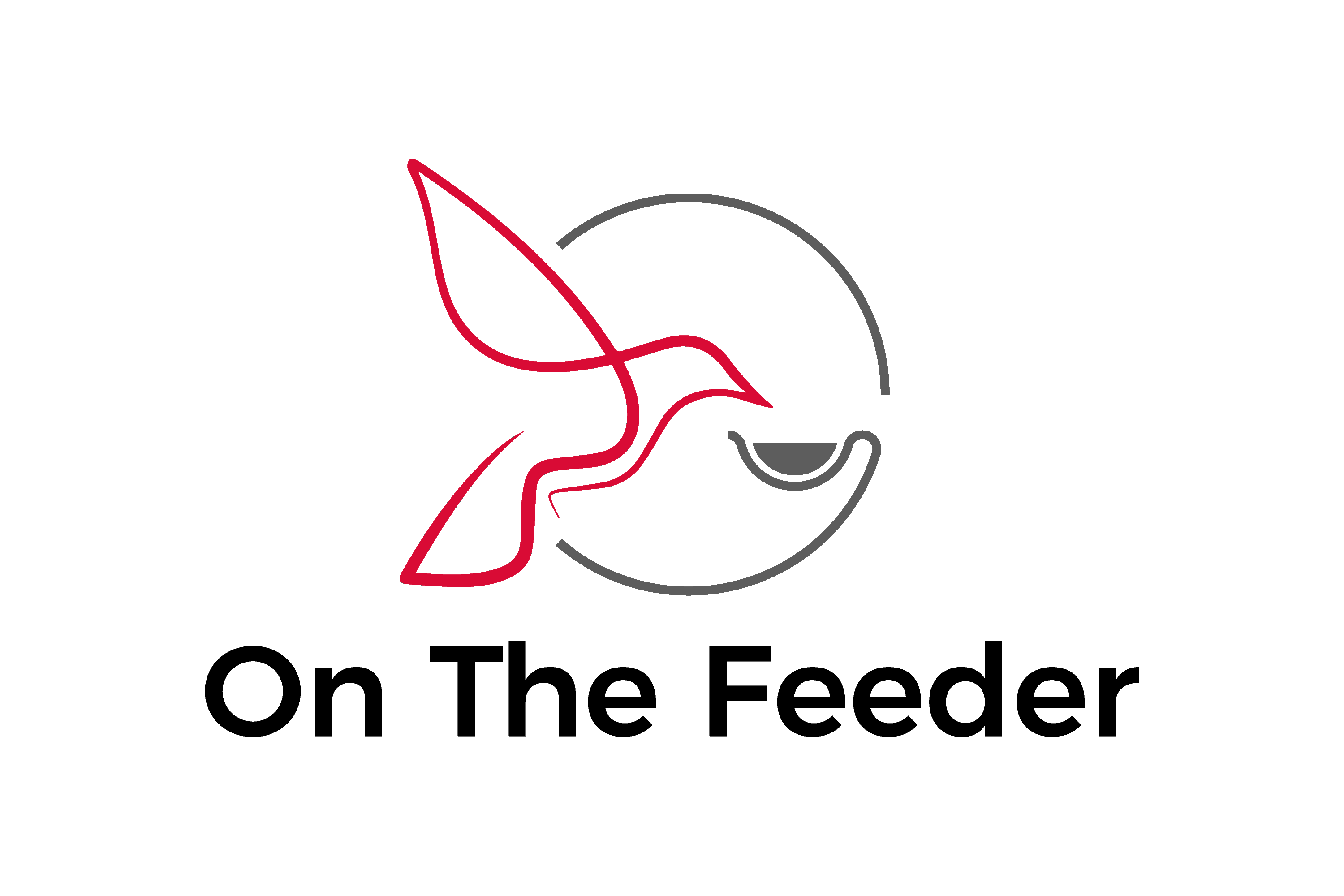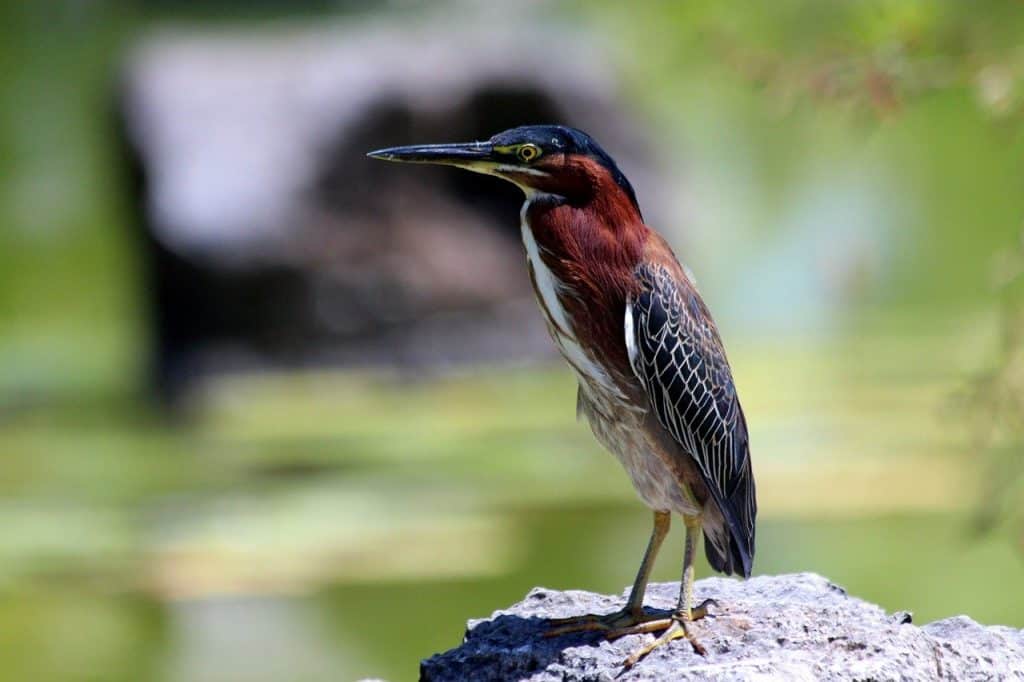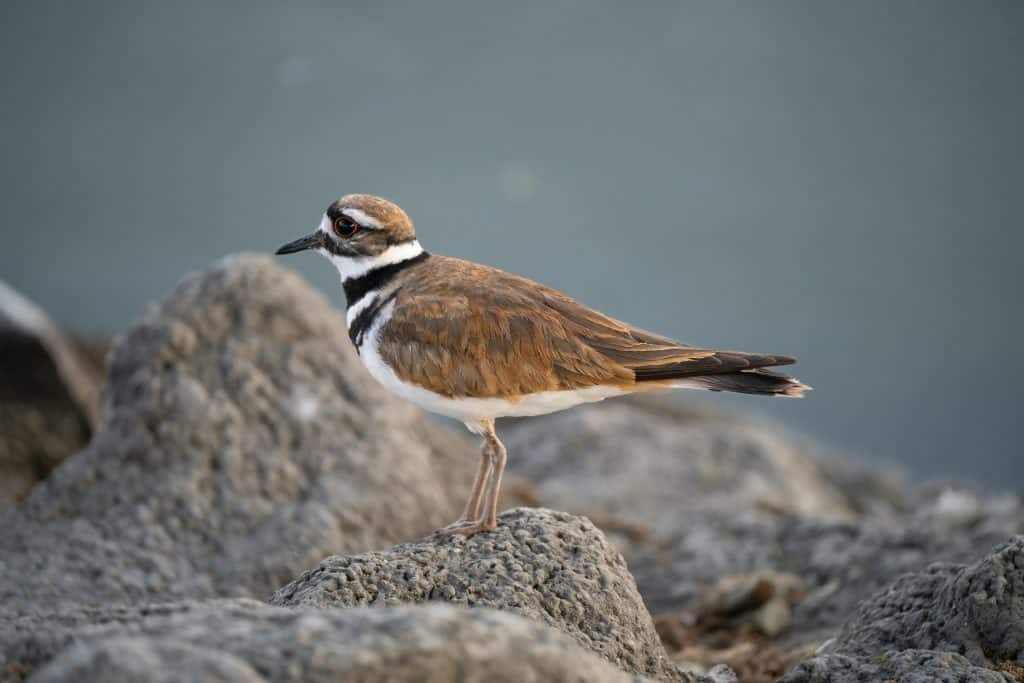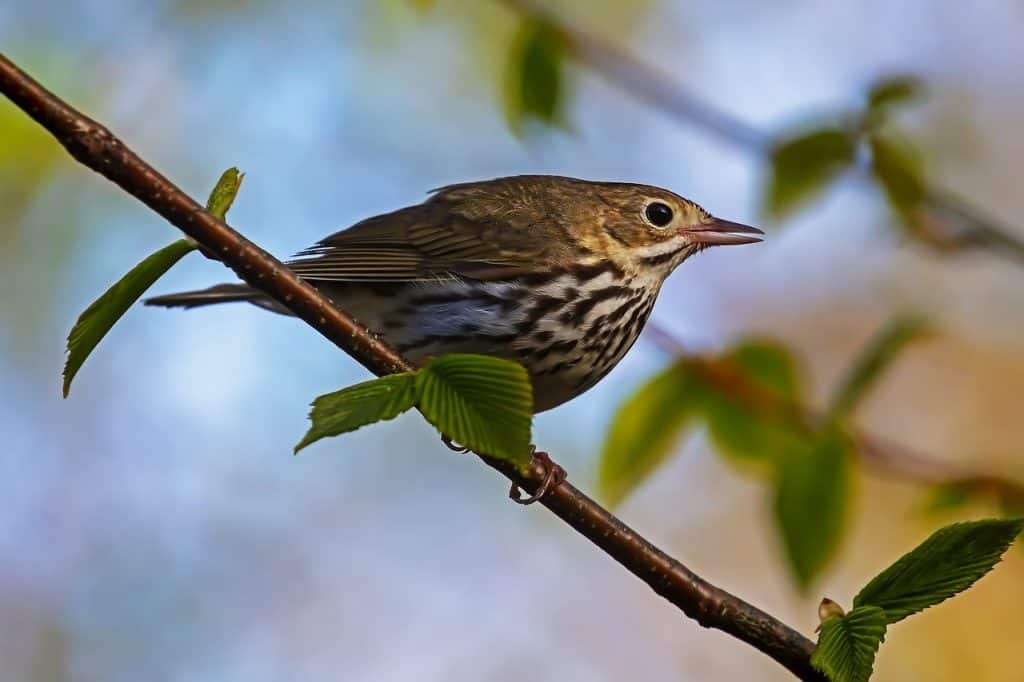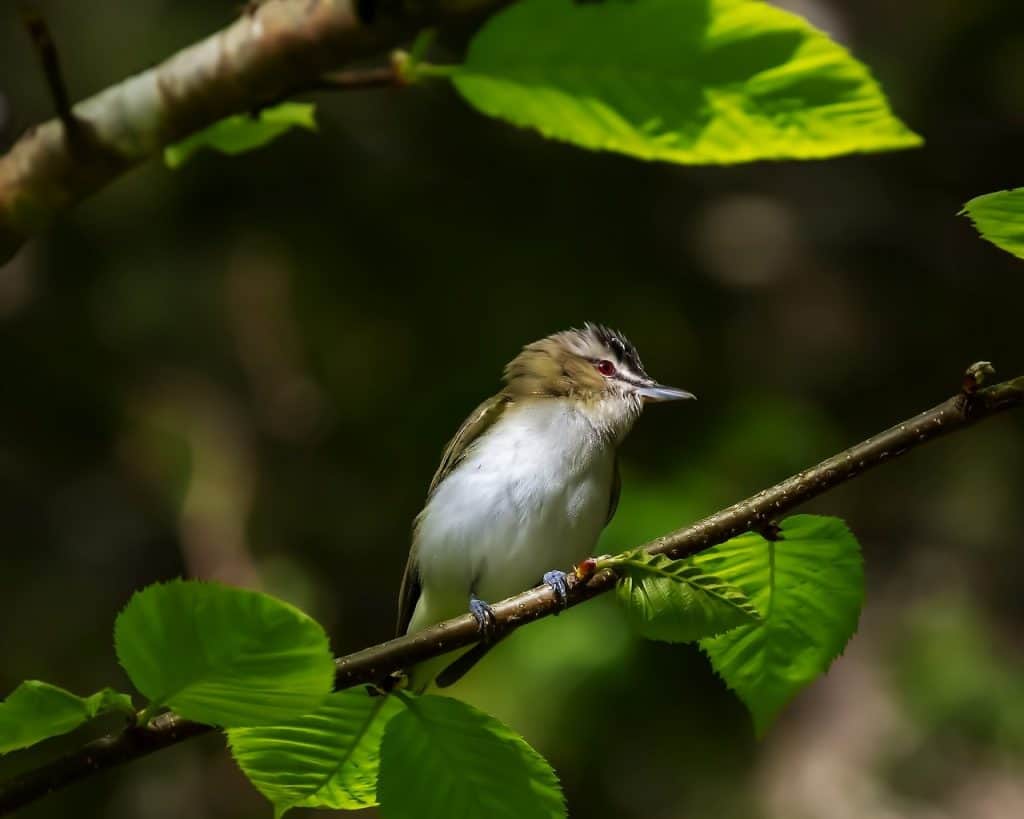Inside: A complete list of birds in Florida plus a full-color photo of each bird, details about habitat, diet, appearance, nesting habits, and a range map to show you where in the state you may see them.
You spotted a bird in Florida – but what type is it? The next step is to identify it. I got you!
With more than 20 years of experience attracting backyard birds to my yard (in Wisconsin), I’ve studied all of the birds in my area so I have the information you’re looking for. For those species that don’t live in my area, I rely on my trusty sourcebooks and friends at The Cornell Lab of Ornithology to guide me.
This article includes wild bird species in Florida. These are birds that are found in and around backyards or nearby. Some birds live in Florida year-round, others are here to breed, and others are migrating through.
The range maps are color-coded so you know if it’s a year-round bird, there to breed, migrating through, or there during a nonbreeding time.

I also included a beautiful closeup photo to help you identify these beauties along with detail such as:
- Size + appearance description
- Diet in the wild and at the feeder
- Habitat
- Nest & eggs description
- Range map
My hope is that this article will help you easily identify the bird you saw or plan to see one day. So let’s get at it, here are birds in Florida:
American Crow
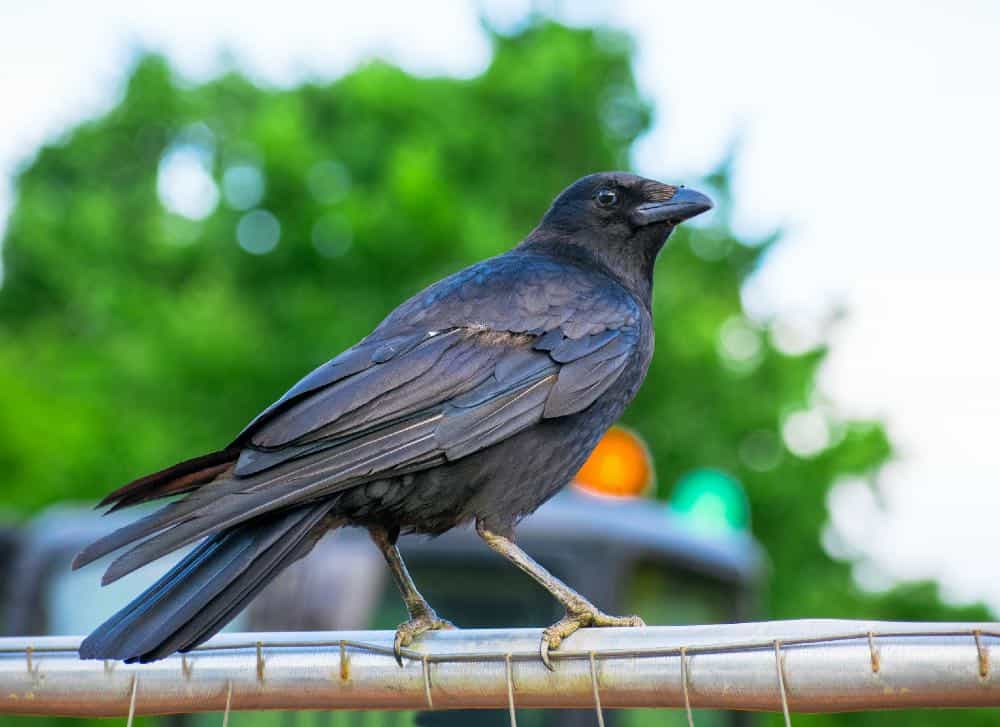
Appearance: Large all-black bird about 16-20″ long, wide neck with a long straight bill. Males and females have the same appearance.
Diet: Opportunistic scavengers eat just about anything they can find on the ground – especially garbage. Natural living fare includes insects, spiders, frogs, snakes, and other birds’ eggs & young.
Feeder food: Not likely to visit a feeder.
Habitat: American crows are common birds found in every contiguous US state and most of Canada. Types of habitat include fields, open wooded and forested areas, river edges, shores, towns, cities, parks, and more. The only place you won’t find them is in the hot desert.
Nesting:
- Nest: Builds nests in a large shrub or tree as high as 20′
- Broods: 1-2 broods/season
- Clutch: 3-9 eggs per brood
- Egg color: Ranging from brighter blue-green to a dull green or blue-gray with heavy gray and brown blotching
- Egg size: 1.4 – 1.9 inches by 1 inch
- Incubation: Both parents incubate the eggs for about 18 days.
Migration: American crows are migrators.
Year-round range: The American crow’s year-round range includes every US state except North Dakota and the pacific coast of Canada’s British Columbia.
Breeding range: While some northern flickers remain in their year-round range to breed, many others migrate north into Canada to raise their young – but only for a season.
Winter range: American crows migrate south back to their year-round range for winter while some move further south to Nevada, Utah, New Mexico, and western Texas.
Range Map
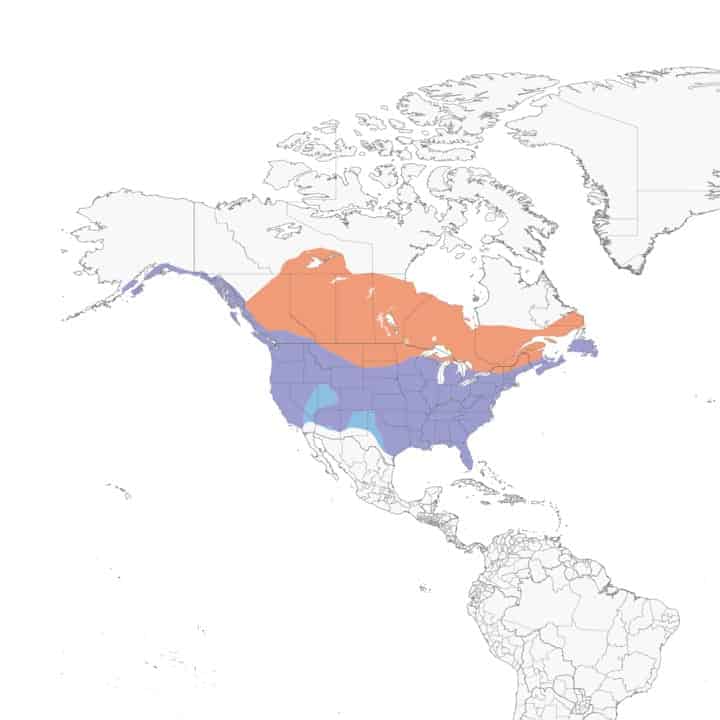
American Goldfinch
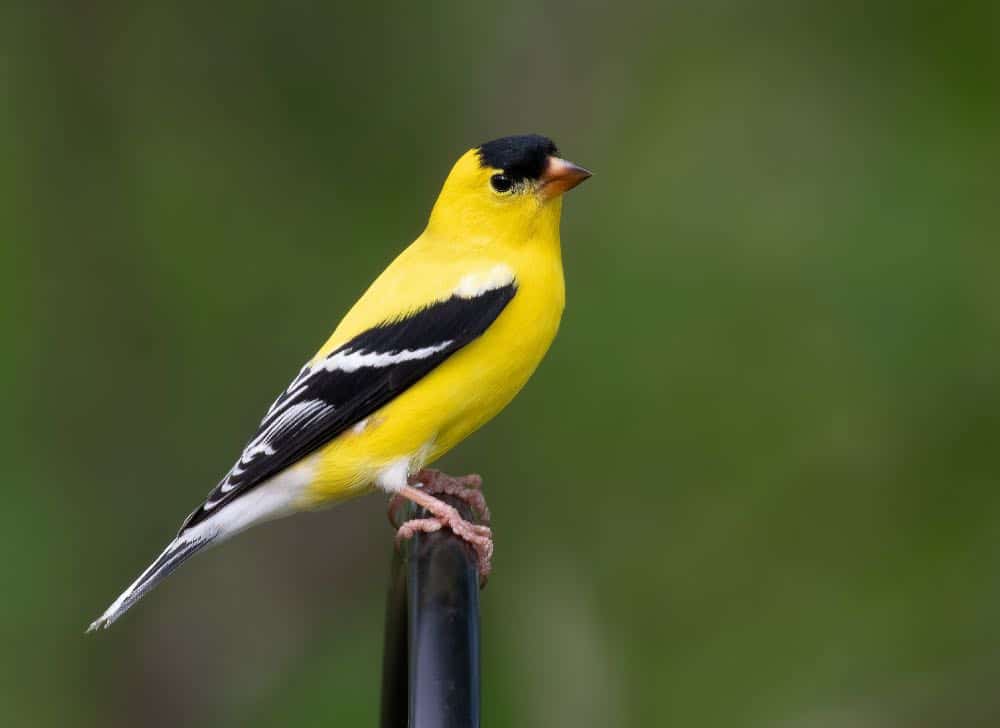
Appearance: The American goldfinch is a small bird about 4.5″ long, bright yellow body, black wings with white stripes, a black forehead, short orange beak. During winter has a dingy brown body, duller yellow head, and thicker white stripes on its wings. Breeding females are similar to males except their bodies are lemon yellow and their wings have more white tips
Diet: Seeds from flowers, weeds, grasses, and small trees. Some insects.
Feeder food: Thistle seed (Nyjer)
Habitat: American goldfinch is a common bird throughout the contiguous US and southern part of Canada. Weedy fields, roadsides, orchards, and backyards.
Nesting:
- Nest: American goldfinches build their nest in a deciduous shrub or tree, sometimes conifers, placed on a branch’s fork as high as 20′.
- Broods: 1-2 broods/season
- Clutch: 2-7 eggs per brood
- Egg color: Very pale blue to white, occasionally faint brown spots on the larger end.
- Egg size: 0.5 inches by 0.5 inches
- Incubation: The female incubates the eggs for about 12-14 days while the male brings food to the female.
Migration: American goldfinches are partial migrators. Many remain in their year-round range for all seasons of the year while others migrate north to breed in spring and then migrate south for the winter.
Year-round range: Washington, Idaho, Oregon, Montana, Wyoming, Nevada, Utah, Colorado, Kansas, Nebraska, Oklahoma, and the remaining US states to the east and south (except Florida).
Breeding range: Northwest Washington, Montana, North Dakota, South Dakota, Kansas, northern Minnesota & Michigan, as well as the southern Canada provinces.
Winter range: Western Oregon, California, southern Nevada & Utah, Colorado, Arizona, New Mexico, Texas, southern Louisiana, Mississippi, Alabama, Georgia, South Carolina, and the state of Florida.
Range Map
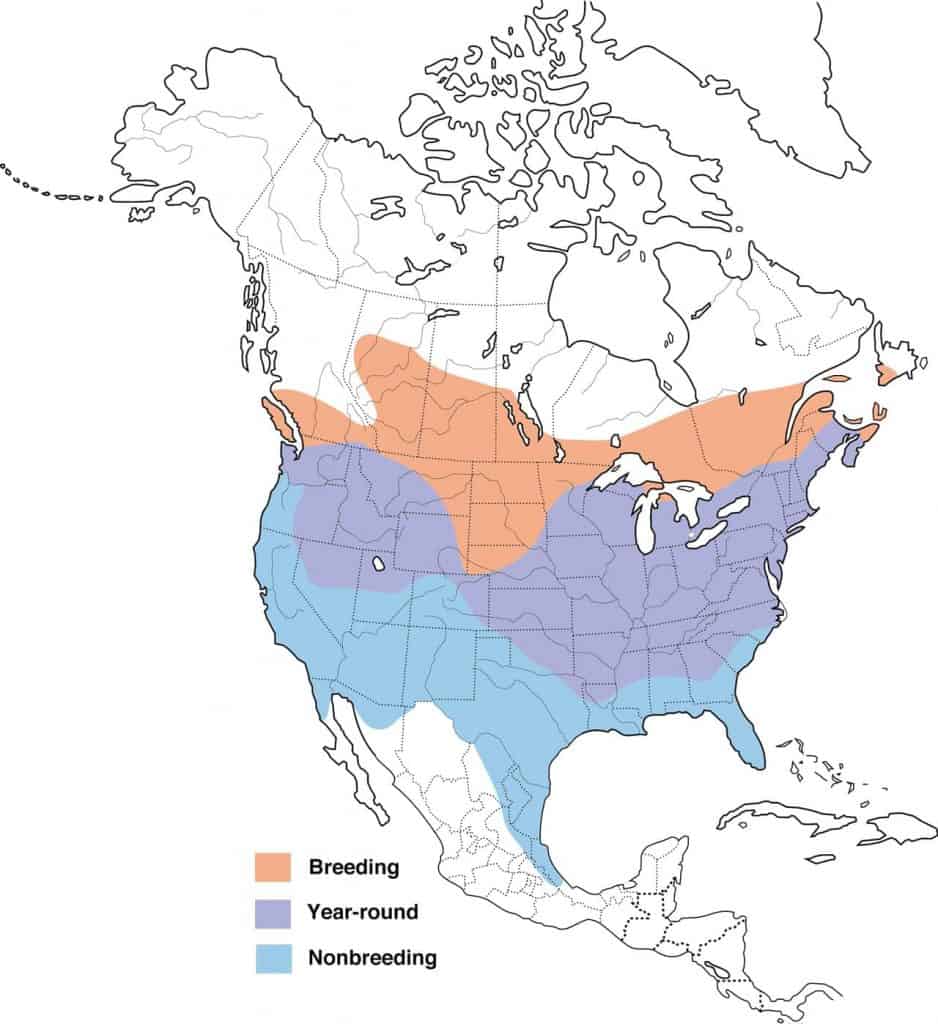
American Kestrel
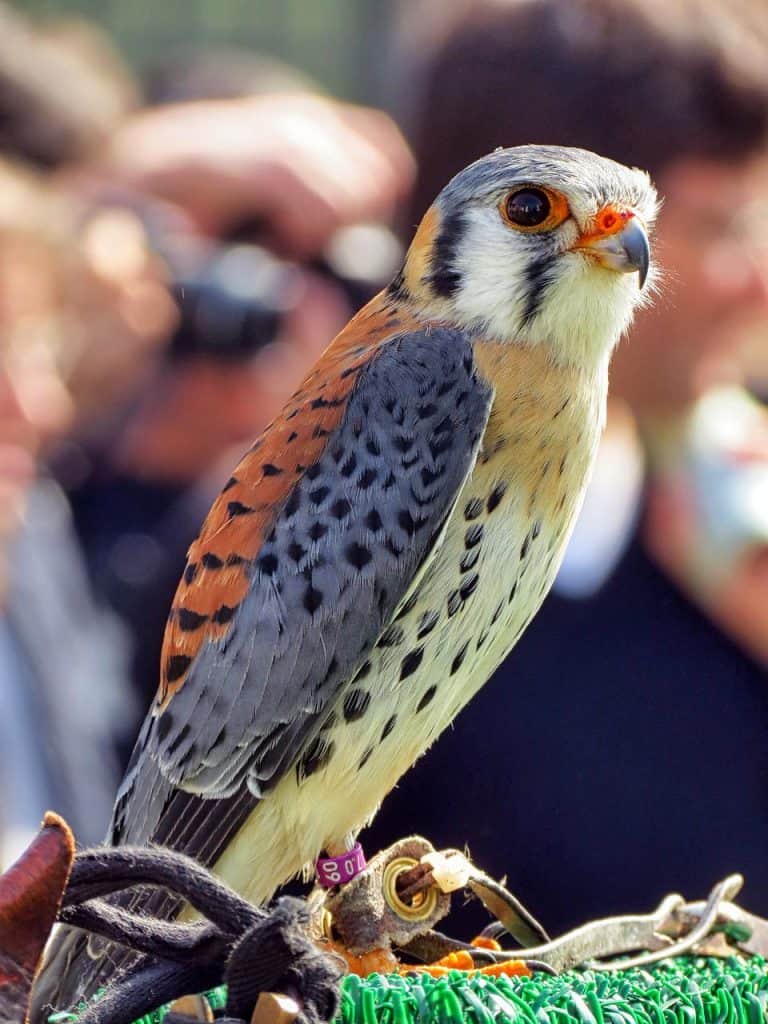
Appearance: The American kestrel is a small raptor at about 10 1/2″ in length. They have blue/gray wings, cinnamon back with black bars, cinnamon tail with a black bar near the tip, and tan underneath with dark spots. The female is the same except she has reddish-brown underparts and a tail with dark bars. And, her underparts have reddish streaks.
Diet: Large insects, lizards, rodents, and small birds.
Feeder food: They don’t visit feeders.
Habitat: Open areas especially rural and suburban fields.
Nesting: American kestrels nest in an old woodpecker hole or some other natural cavity. They have 1-2 broods/season and 4-5 eggs/brood. Eggs are white-yellow or light brown with spots. Incubation is for 29-30 days and fledglings leave the nest at 28-31 days.
Migration: American kestrels are migrators.
Year-round range: All US states except Montana, Wyoming, North Dakota, South Dakota, Minnesota, Wisconsin, Michigan, and Maine.
Breeding range: Canada and Alaska.
Winter range: While some American kestrels migrate south to southern Texas, Louisiana, and Mexico, many remain in their year-round range when the snow flies.
Range Map
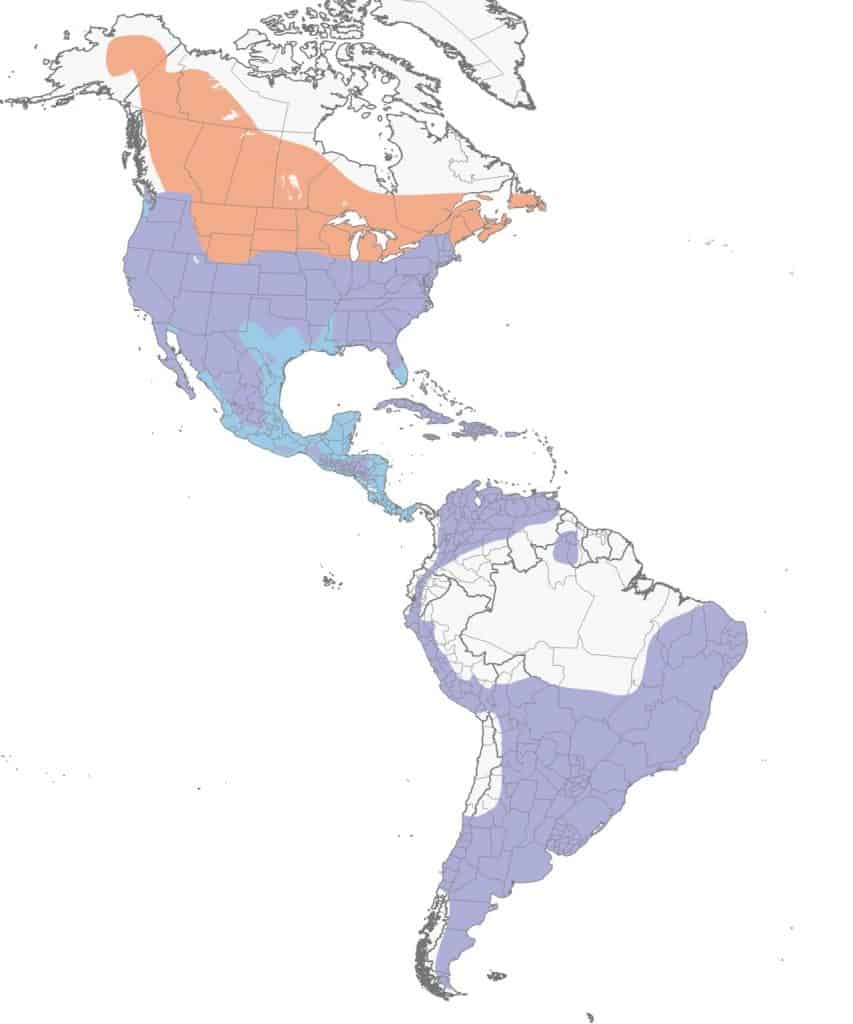
American Oystercatcher
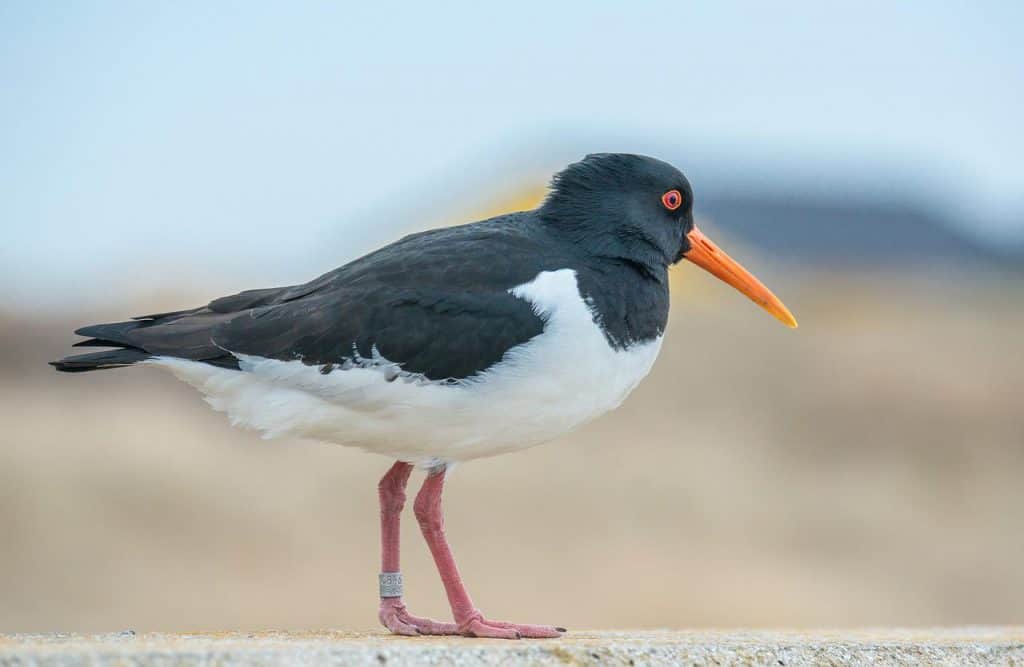
| Appearance | The American oystercatcher is a medium-sized shorebird about 16″ long. They’re black above, white below, and have a deep orange bill, yellow-orange eyes, and pink legs. |
| Diet | Mollusks, limpets, jellyfish, starfish, and other marine life. |
| Feeder Food | N/A |
| Habitat | Interditadl areas along the beach and barrier islands. Sandy, salt marshy areas are preferred. |
| Nesting | The American oystercatcher uses a simple nest laying in the sand without any lining. Broods: 1/season Clutch: 2-4 eggs/brood Egg color: light gray with brown spots Egg size: 2.25″ x 1.55″ Incubation: 24-28 days. |
Range Map
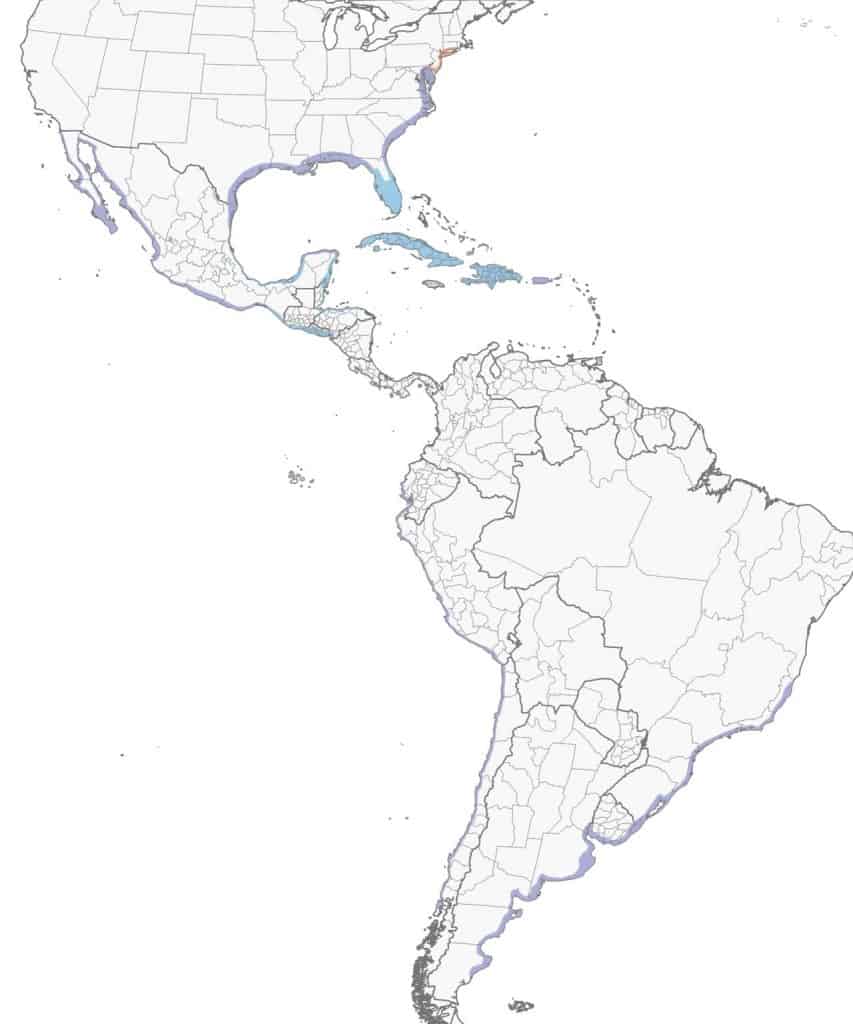
American Redstart
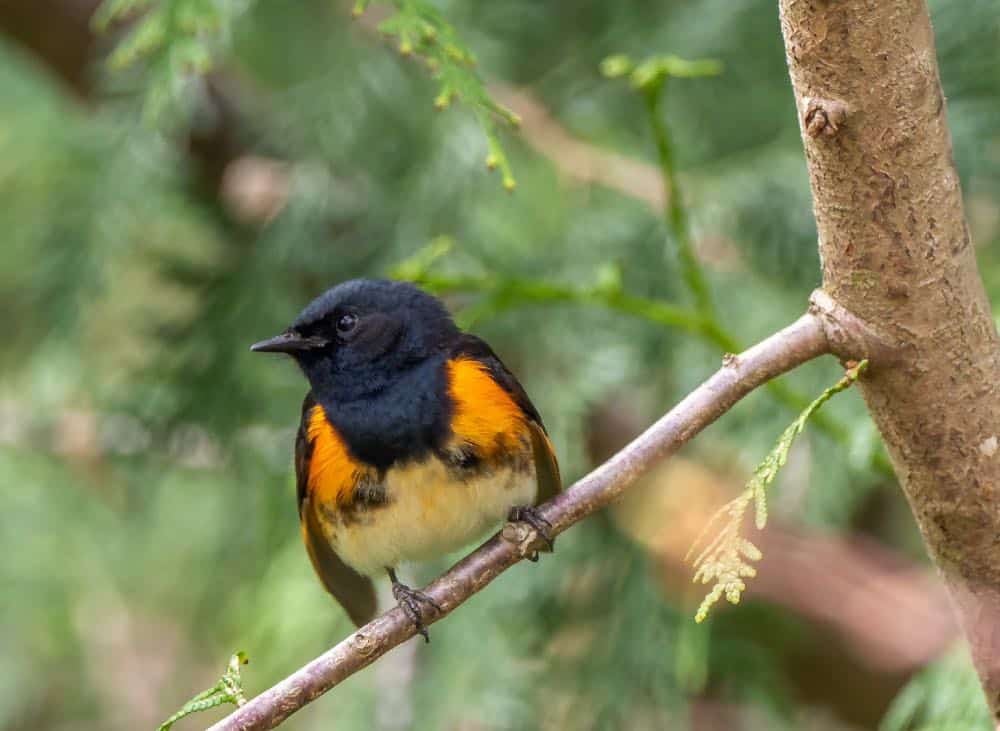
| Appearance | Medium-sized bird about 4.5-5″ long, mostly black, white belly, orange stripes and patches on the tail, wings, and side. Female have soft gray head, olive back and sings, white belly and yellow/orange stripes & patches on the tail, wings, and side. |
| Diet | Insects, small berries and fruits from shrubs. |
| Feeder Food | Unlikely to visit a feeder. |
| Habitat | Found in every contiguous US state and parts of Canada. Prefers open wooded areas especially those with deciduous trees. |
| Nesting | 1-5 eggs, eggs are white with brown or reddish spots, incubation is 10-13 days. |
Range Map
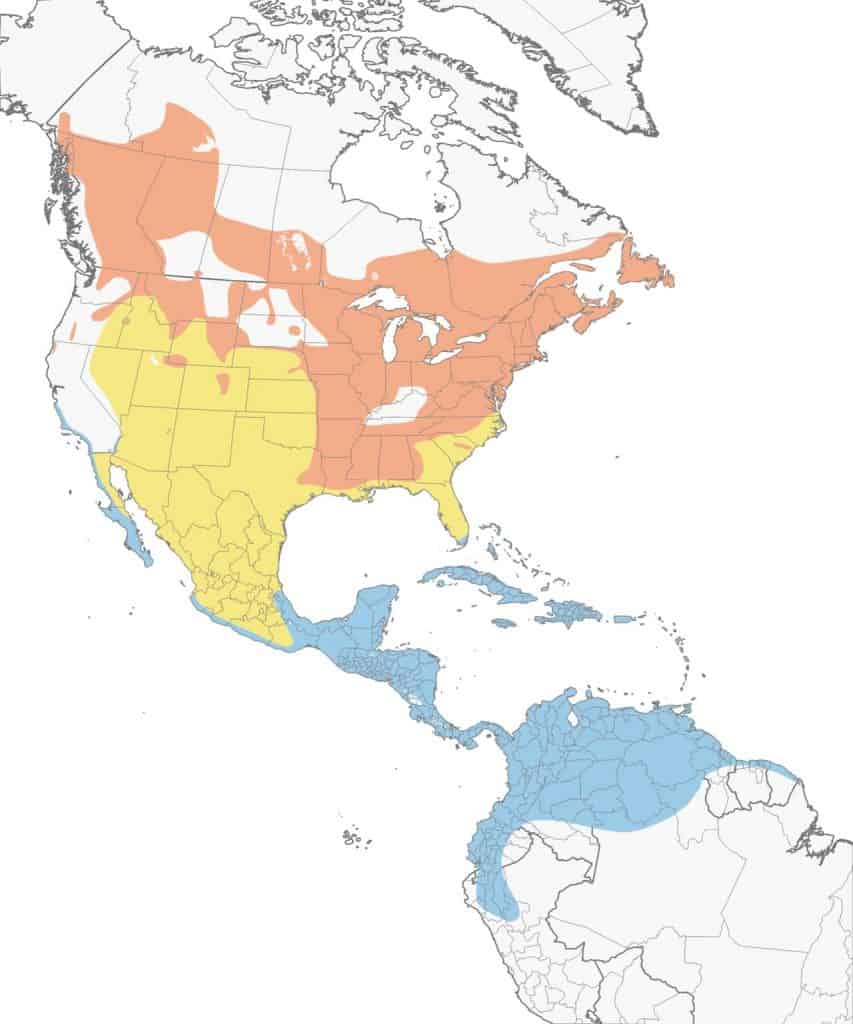
American Robin
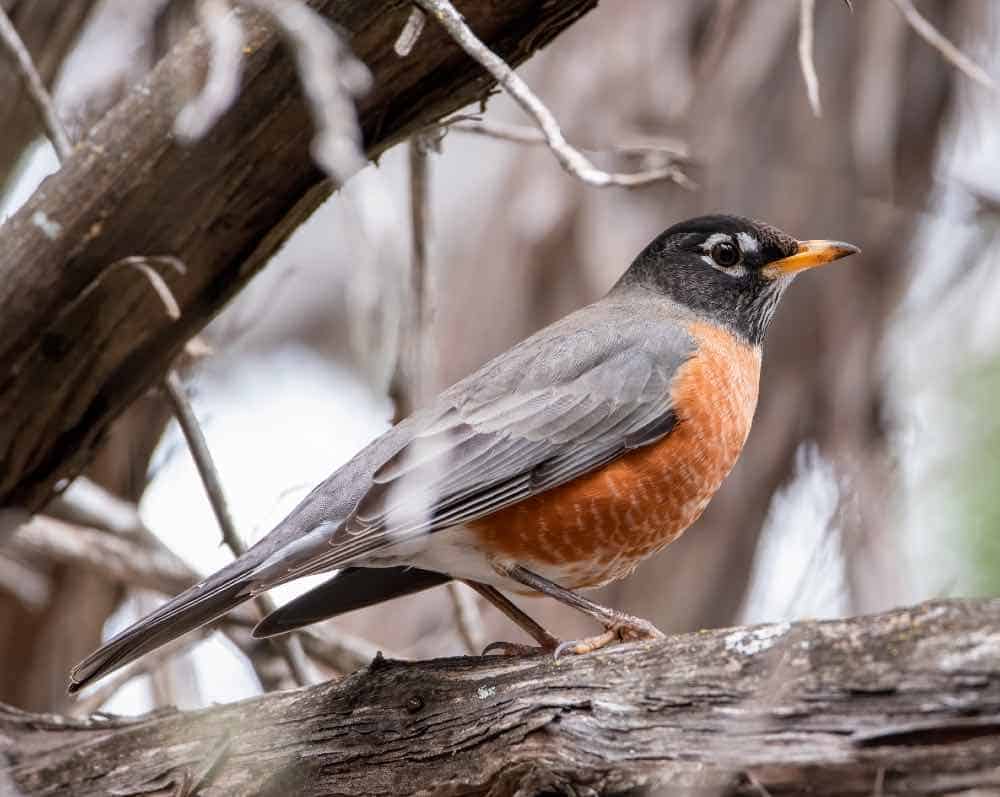
Appearance: The American robin is a medium-size bird about 10″ long, with gray/brown upper, brown/orange underparts, yellow beak, white chin, and white surrounding eyes. orange beak. The Female has a lighter head and underparts.
Diet: Earthworms, insects, and fruit.
Feeder food: Not a feeder visitor.
Habitat: Common and pervasive throughout US and Canada. Found in fields, parks, wooded and forested areas, mountains, and backyards.
Nesting:
- Nest: Nesting sites vary from the lower half of a tree to rain gutters, outdoor lights, and more.
- Broods: 1-3 broods/season,
- Clutch: 3-5 eggs/brood,
- Egg color: Bright sky blue or blue-green, without spots
- Egg size: 1.1″ long x 8″ wide
- Incubation: 12-14 days.
Migration: American robins are migrators.
Year-round range: Every US state except North Dakota, southern parts of Canada’s British Columbia, and Alberta, as well as Mexico.
Breeding range: Canada and Alaska.
Winter range: While most American robins head south back to the year-round range, others will go further into the far southern parts of Florida, California, Arizona, New Mexico, Texas, Louisiana, and Mexico.
Range Map
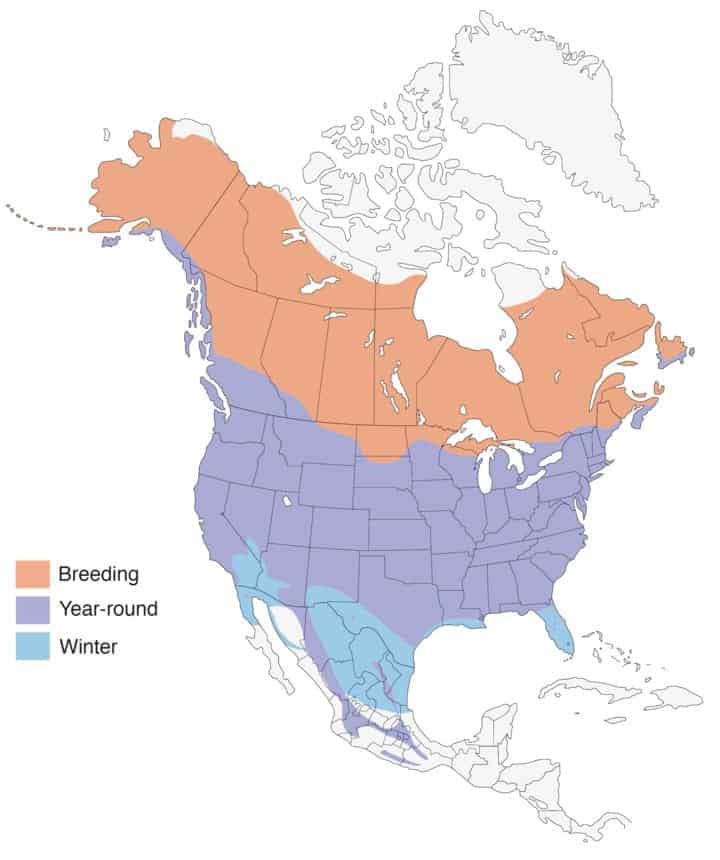
Baltimore Oriole
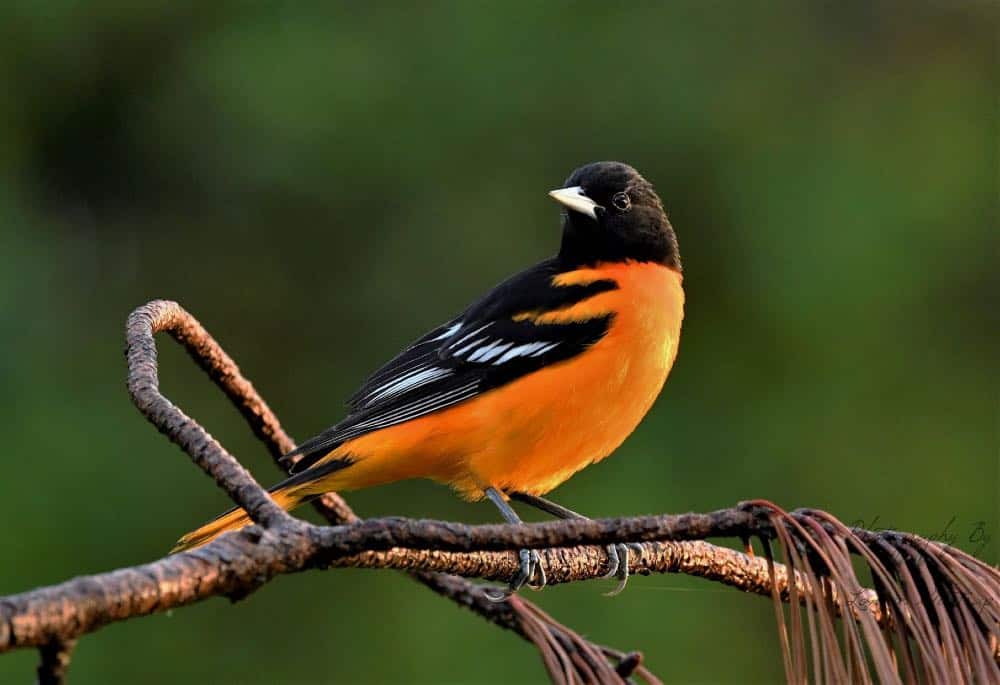
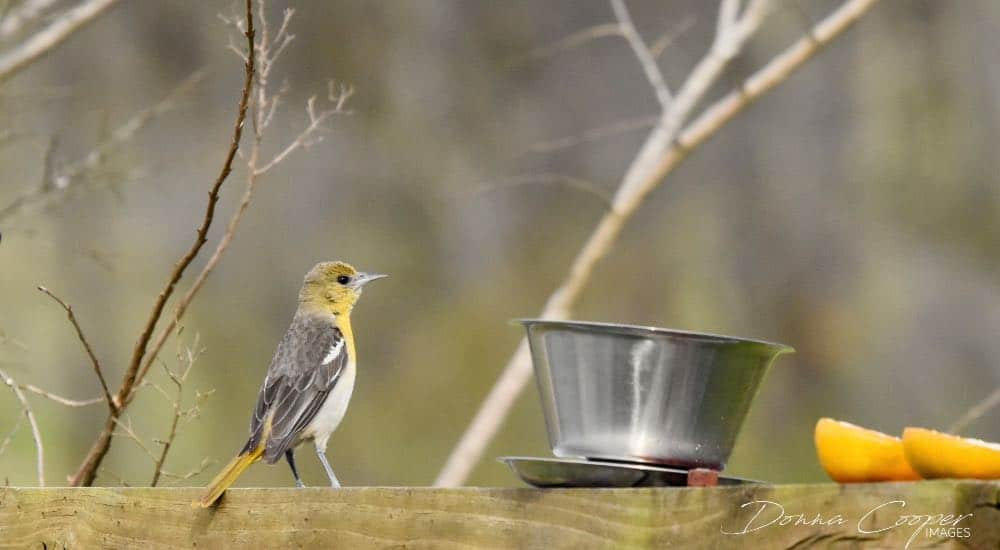
| Appearance | Medium-sized bird about 8.25″ long. Male Baltimore orioles have a flaming orange body and black head with black and white wing bars. The tail is orange with black and white streaks. The female and juvenile birds have pale yellow heads and bodies with grayish-brown wings and white wing bars. Both genders have a gray bill and dark eyes. |
| Diet | Insects, berries, and nectar from flowers. |
| Feeder Food | Baltimore Orioles will eat sweet foods such as nectar, oranges, and regular grape jelly. |
| Habitat | Baltimore orioles can be found in residential areas and wooded edges rich with high, deciduous shade trees – especially during breeding. They often nest near natural water sources such as ponds and rivers. |
| Nesting | The female builds a 4-6″ hanging long purse-style nest suspended on the end of a forked branch and only has one brood per year. About 4-5 bluish-colored eggs with brown markings are incubated for 12-14 days. |
Range Map
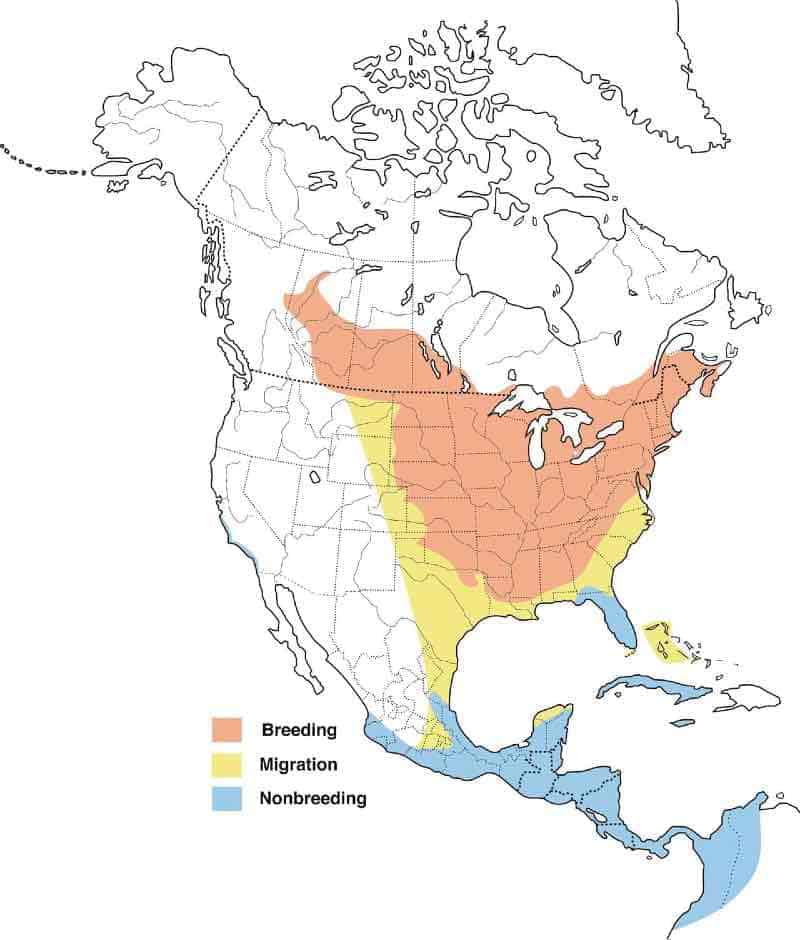
Barn Swallow
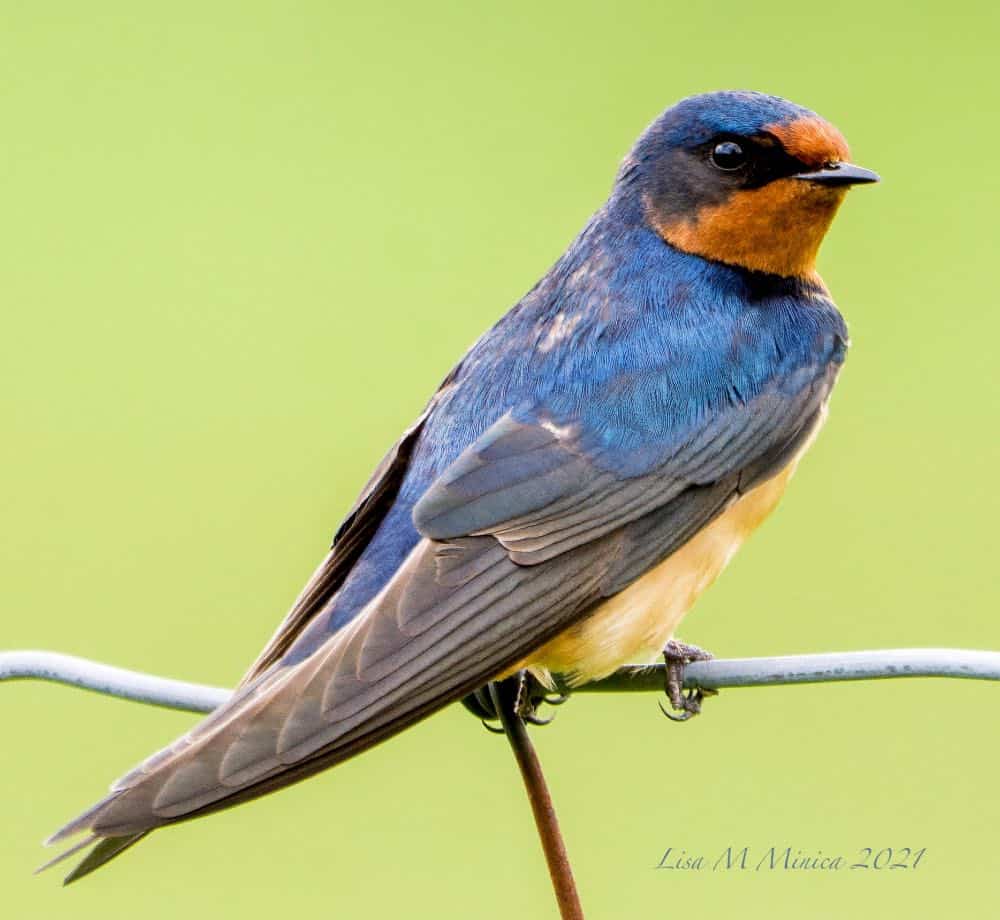
Appearance: 7″ long, steel blue glossy on top, chestnut forehead and throat, and rust-orange underparts. Long forked tail with a white base. The female’s coloring is lighter and the tail shorter.
Diet: Insects, preferably beetles, wasps, and flies. Drinks by skimming the surface of the water.
Feeder food: Not likely to visit a feeder.
Habitat: Open fields and pastures.
Nesting: A barn swallow typically nests in or on a manmade structure such as a barn. Builds nests of mud. 2 broods/season, 4-5 eggs per brood, eggs are white with brown markings, incubation from 13-17 days.
Migration: Barn swallows are migrators. In spring, they’ll migrate north into the US and Canada for breeding and to raise their young. When fall comes, they’ll head south to Mexico’s southern states. That said, they do maintain a year-round range in central Mexico where they remain for every season.
Range Map
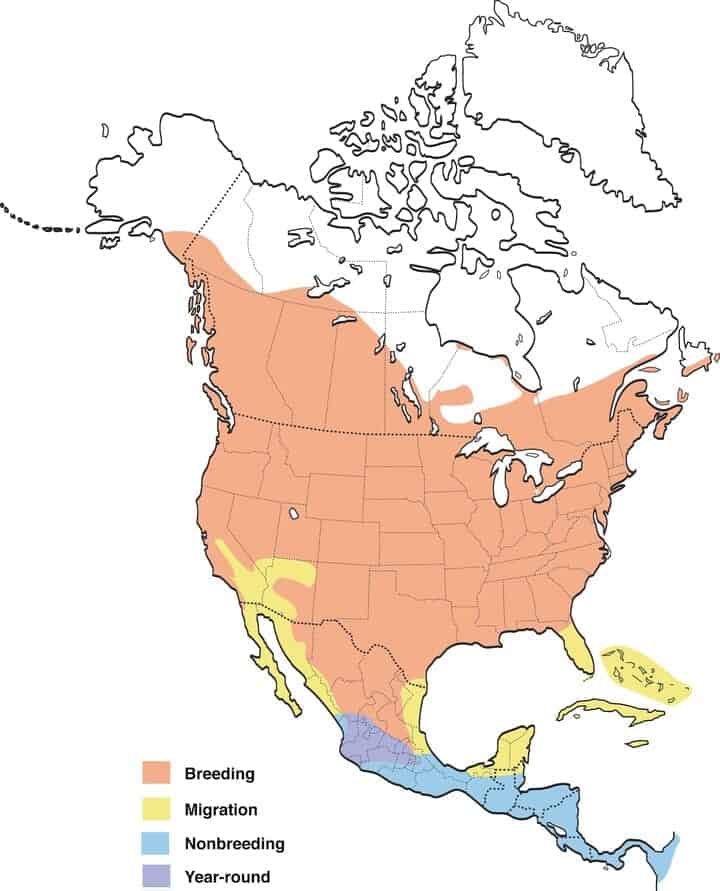
Belted Kingfisher
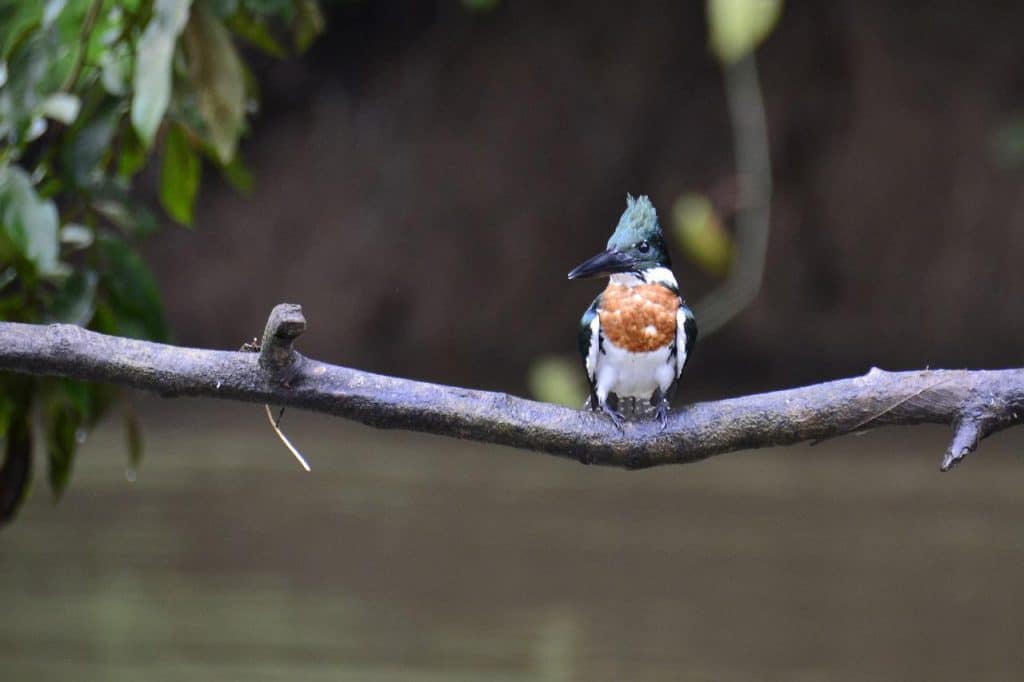
Appearance: The belted kingfisher is a large 13″ long bird with a large head, long bill, and stocky body. Blue/gray throughout with white ring around neck and white chest. The Female is the same but with an additional chestnut band on her chest.
Diet: Large 13″ long bird with a large head, long bill, and stocky body. Blue/gray throughout with white ring around neck and white chest. The Female is the same but with the additional chestnut band on the chest.
Feeder food: Unlikely to come to the feeder but often attracted to yards with streams or ponds.
Habitat: Near streams, rivers, ponds, lakes, and calm marine waters – especially unclouded water with little vegetation.
Nesting: Belted kingfishers dig burrows along the water’s edge for their nest. 1-2 broods/season, 5-8 eggs/brood – large white glossy eggs (1.5″ long), 22-24 days incubation.
Migration: Many but not all belted kingfishers are migrators. In spring, the migrators will head north into Montana, North Dakota, northern Minnesota, Canada, and Alaska to breed and raise their young. When fall comes the migrators head back south – as far south as Arizona, New Mexico, southern California, and Mexico.
Year-round range: All US states (except North Dakota and Arizona) and the pacific coast of Canada’s British Columbia.
Breeding range: While some stay in their year-round range, many others migrate north into Montana, North Dakota, northern Minnesota, Canada, and Alaska to breed and raise their young. When fall comes the migrators head back south – as far south as Arizona, New Mexico, and southern California.
Winter range: While many belted kingfishers migrate south for winter, just as many remain in their year-round range when the temperatures dip.
Range Map
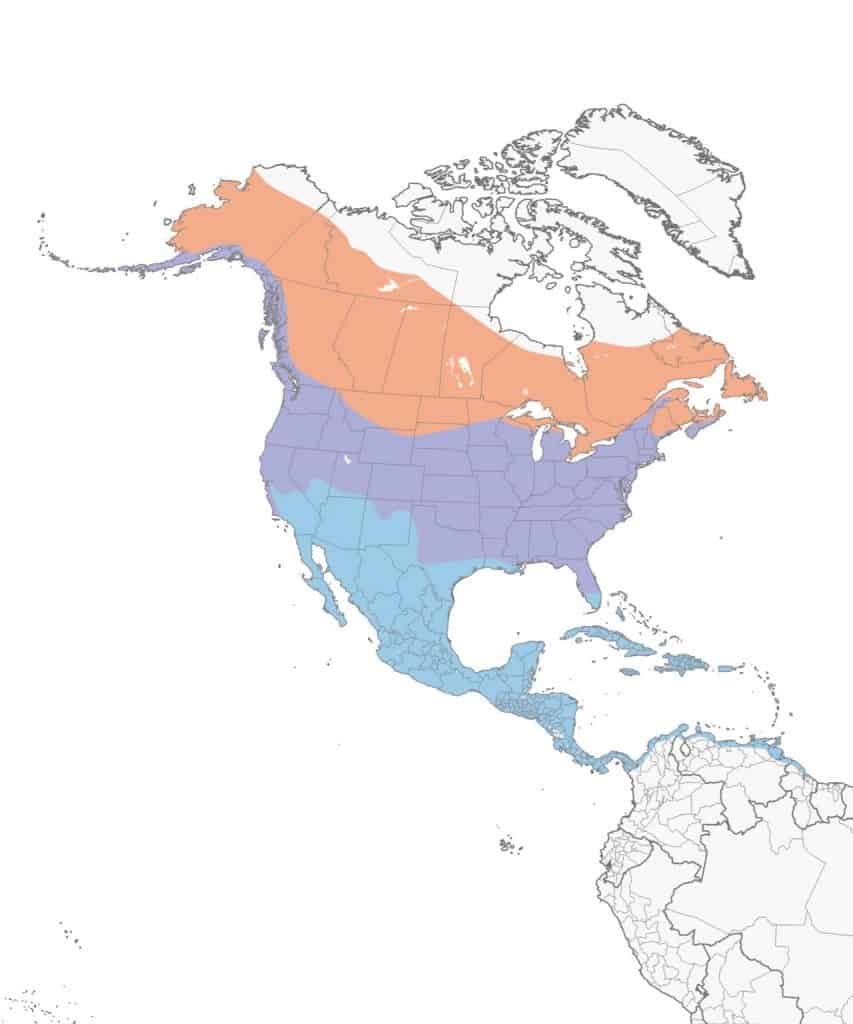
Black Throated Blue Warbler

Appearance: Black-throated blue warblers are small birds about 5″ long, midnight/steel blue back, black throat, and a white belly
Diet: Insects and fruit.
Feeder food: Suet, peanut butter, and nectar.
Habitat: Prefer mature deciduous and mixed evergreen woodlands with plenty of thick shrubs.
Nesting: They build a cup-shaped nest in a shrub made of bark and spider webs. 1-3 broods/season, 2-5 eggs/brood, eggs are small .6″-.8″, creamy white and speckled. Incubation lasts for about 12-13 days.
Migration: Black-throated blue warblers are true migrators. They head north in spring to breed and raise their young. In the fall, they migrate south to winter in southern Florida and the Caribbean.
Breeding range: Northern Wisconsin, Northern Michigan, eastern Tennessee & Kentucky, West Virginia, Pennsylvania, Pennsylvania, the New England states, and Canada’s southern provinces of Ontario and Quebec.
Winter range: Southern Florida and the Caribbean islands.
Range Map
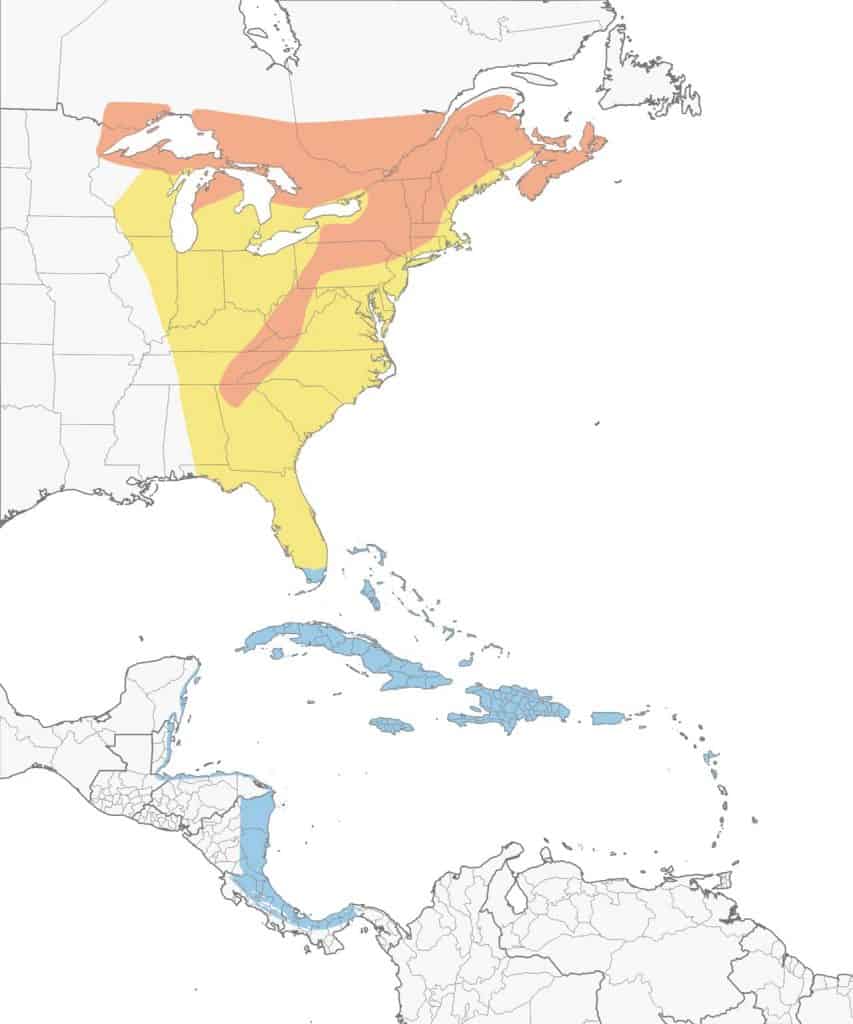
Black Vulture
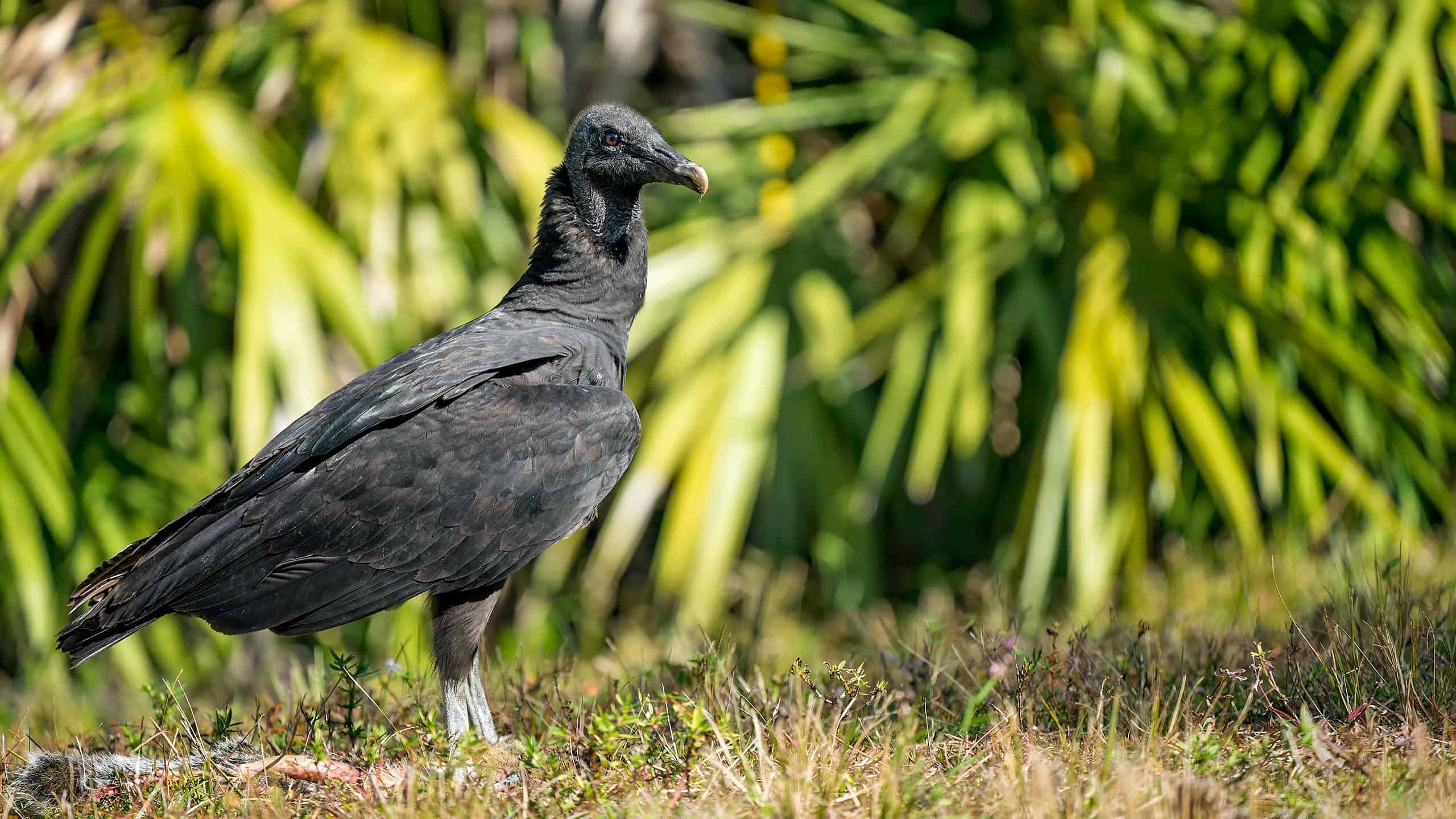
| Appearance | The black vulture is a large bird about 25″ long. They’re all black, heads are wrinkled gray & unfeathered (bare), bills are hooked and legs are white. |
| Diet | Animal carcasses. |
| Feeder Food | They don’t visit feeders. |
| Habitat | Forested and open areas. |
| Nesting | Black vultures nest on the ground in a hidden thicket or hollow log. There is no “nest” per se. They have 1 brood/season and 2 eggs/brood. Eggs are pale green to bluish/white with brown spots. Incubation lasts 37-41 days and fledglings leave the nest at 75-80 days. |
Range Map
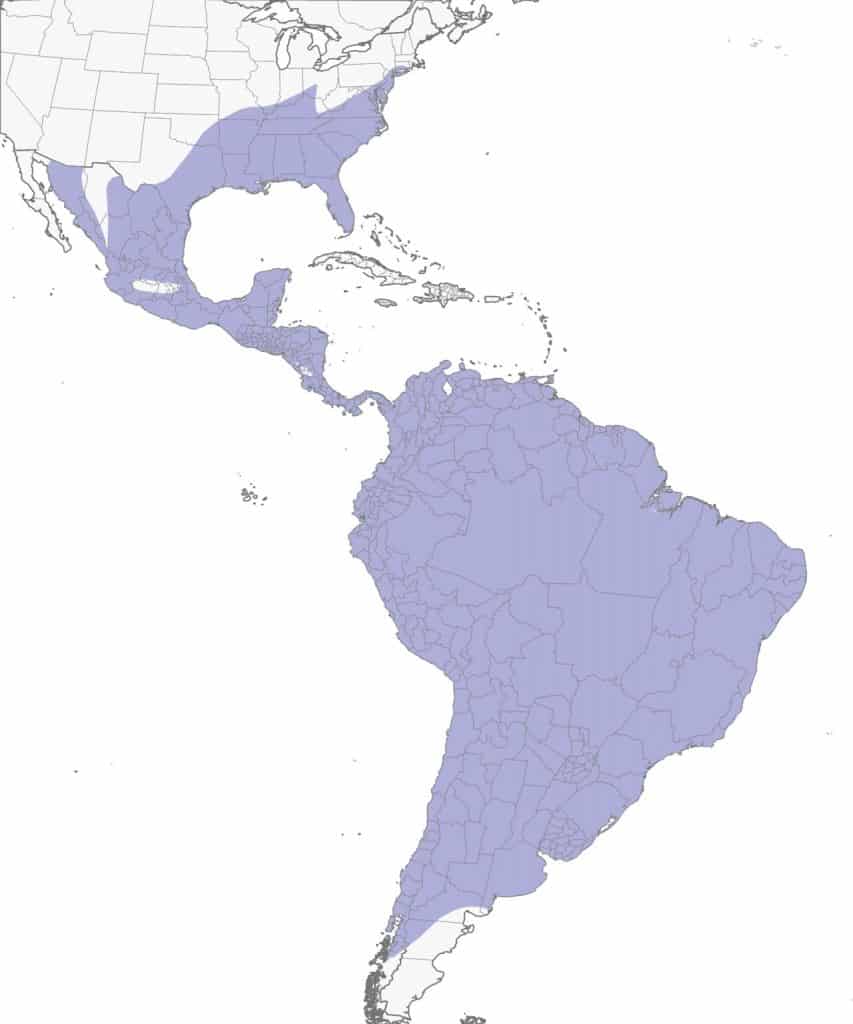
Black-and-White Warbler
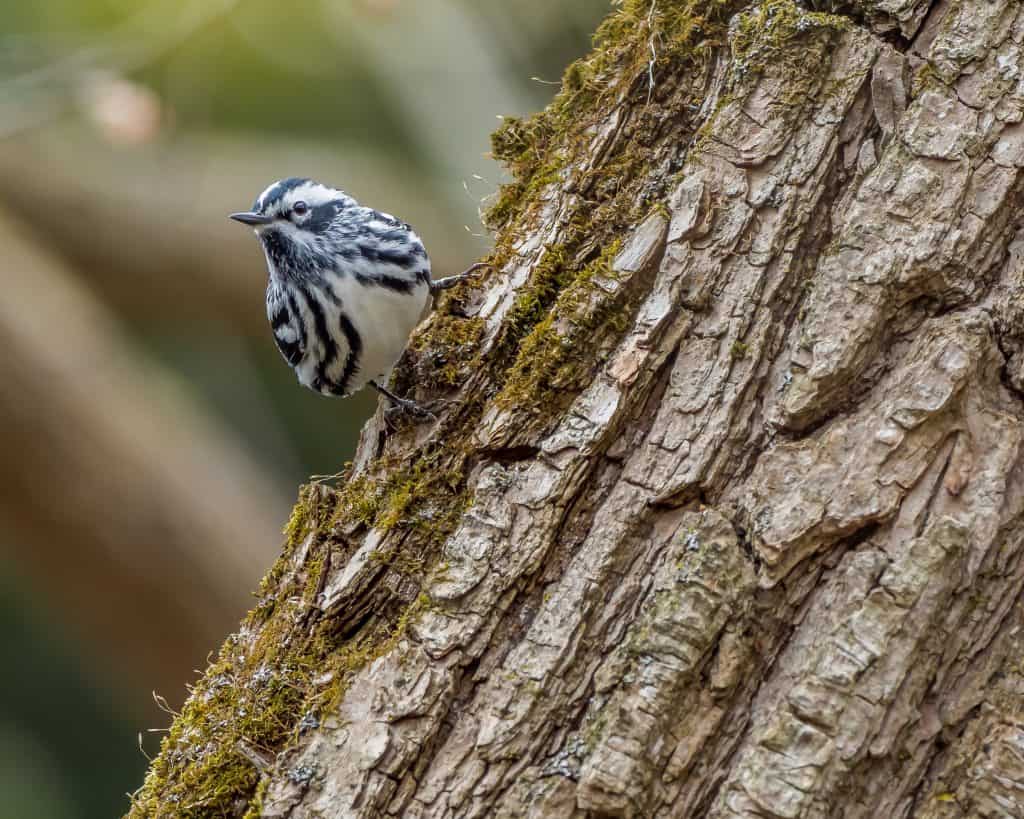
| Appearance | The black-and-white warbler is a small bird about 5″ long and has similar colorings as a zebra. They have a white belly and black chin with black-and-white stripes on the crown with a black patch on their cheek. The female is the same only duller and without the black chin and cheek patch. |
| Diet | Insects. |
| Feeder Food | Unlikely to visit a feeder. |
| Habitat | Deciduous as well as mixed forests. |
| Nesting | They build a cup-shaped nest and have 1 brood/season. There are about 4-5 eggs/brood – white with brown markings. Incubation is for 10-11 days. |
Range Map
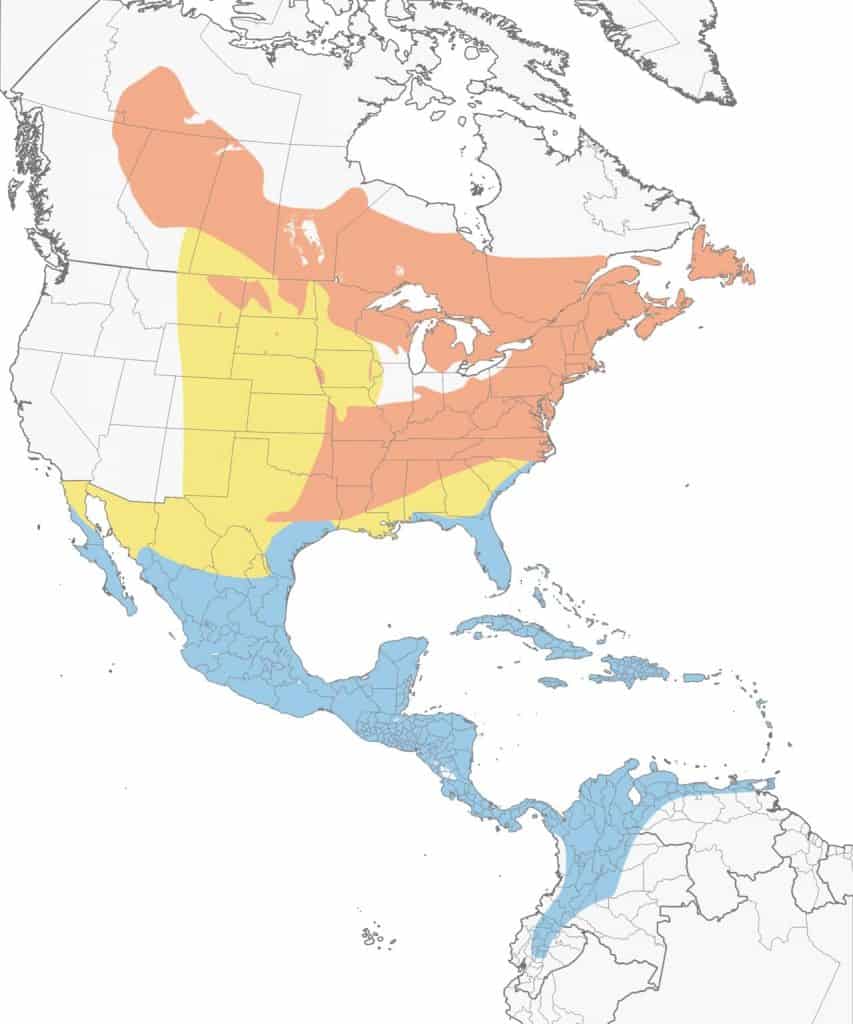
Black-Throated Green Warbler
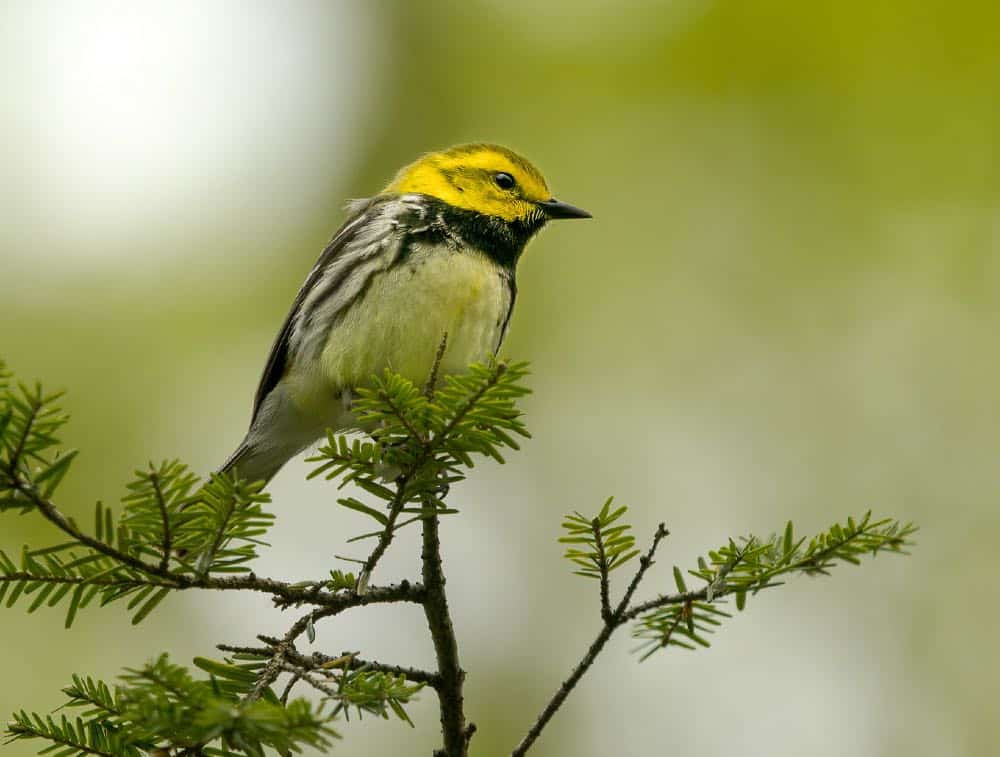
| Appearance | Small bird about 4.5″ long with a bright yellow head, black throat, and green back. Black and white streaks over the sides. The female is similar but has a white throat. |
| Diet | Primarily insects. Will dine on berries while migrating. |
| Feeder Food | Unlikely to visit a feeder. |
| Habitat | They prefer forests with a mix of coniferous and other deciduous trees. |
| Nesting | The female builds a small cup-shaped nest 3-10′ off the ground in a tree. They have one brood/year. There are about 3-5 tiny eggs, white with brown spots. Incubation is 12 days. |
Range Map
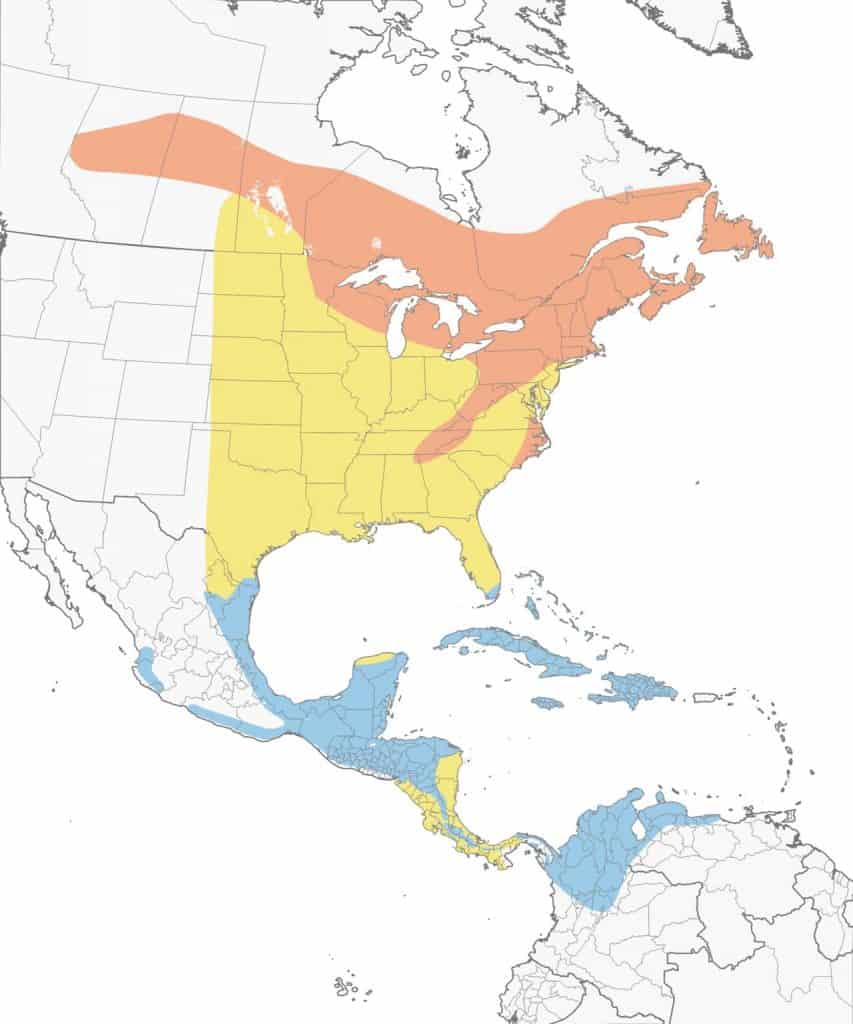
Blue Grosbeak
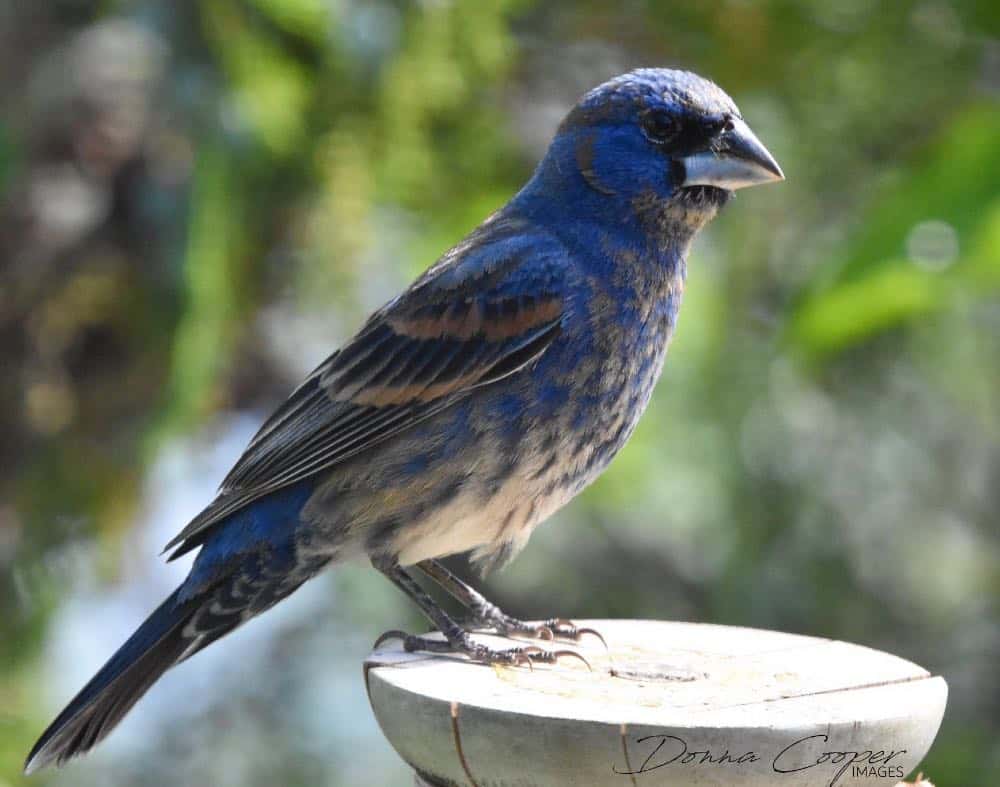
Appearance: Blue grosbeaks are medium birds about 8″ long, large, bright blue, with large silver bills, and chestnut wingbars. The female’s primary color is light cinnamon with darker-colored wings.
Diet: Insects, seeds, and grains.
Feeder food: Grain and birdseed.
Habitat: Thick shrubbery and areas with tall trees.
Nesting:
- Nest: Small cup-shaped nest of twigs and miscellaneous organic materials resting in low-lying trees, shrubs, and bushes.
- Brood: 1-2 broods/season
- Clutch: 3-5 eggs/brood
- Egg color: Pale blue to white with occasional brown spots
- Egg size: 0.8 inches by 0.7 inches
- Incubation: 12-13 days incubation.
Migration: Blue grosbeaks are migrators. In spring, they migrate north into the US to breed and raise their young. Then in the fall, they head back south for the winter. There is a small area in Mexico they call their year-round home. The birds in this area don’t typically migrate.
Year-round range: Parts of Mexico.
Breeding range: Southern half of the US as well as North Dakota, South Dakota, and Kansas.
Winter range: Mexico and the Caribbean islands.
Range Map
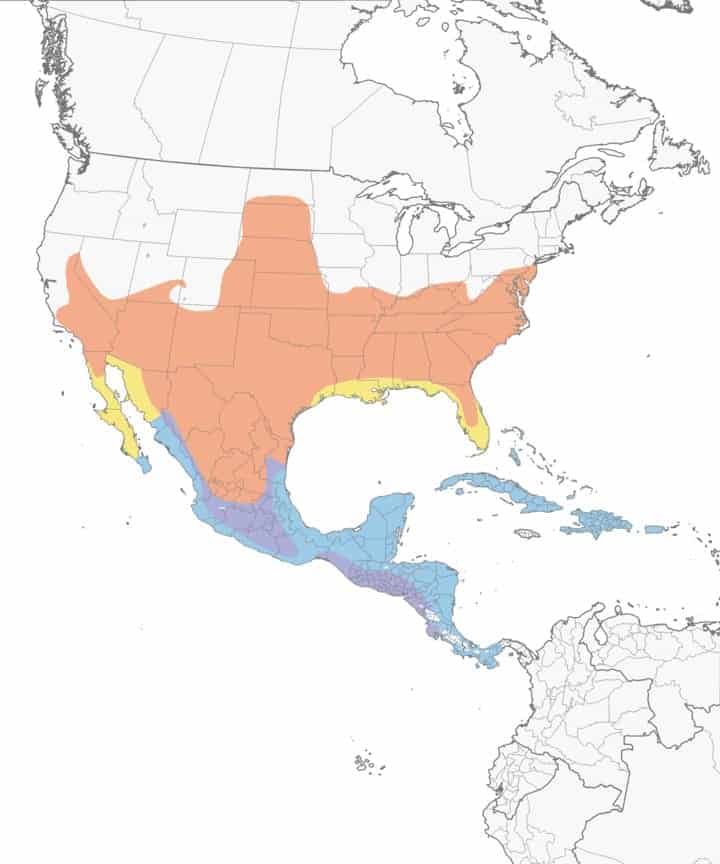
Blue Jay
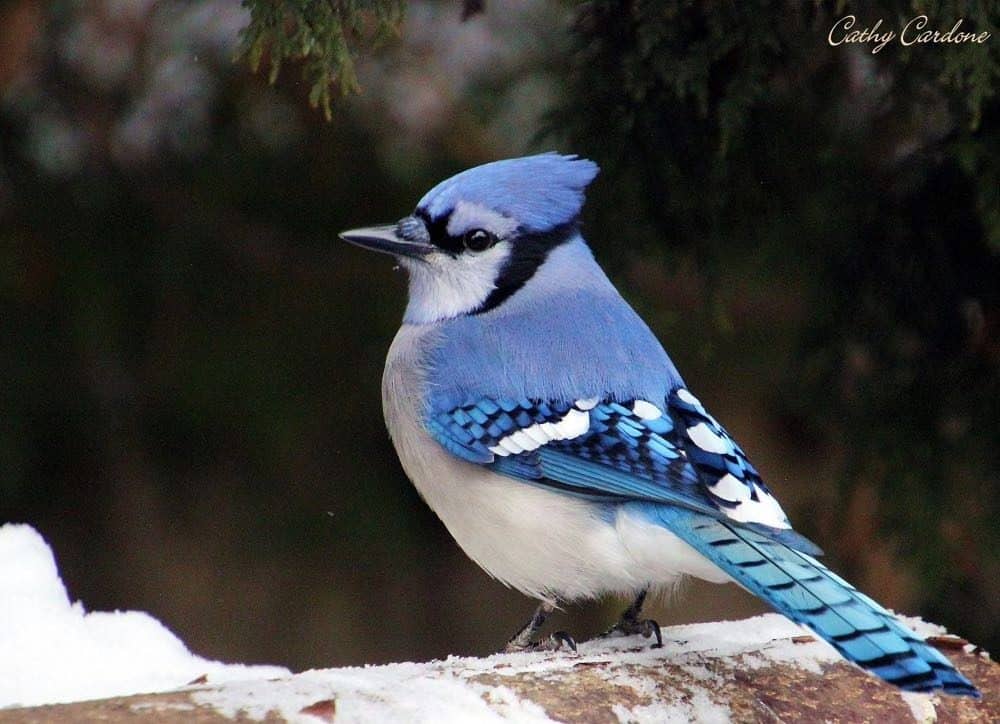
Appearance: Large bird 12″ long, medium blue & white body, blue crest (which he flattens at will), gray belly, and white face. White & blue wings with black spots. Females look the same.
Diet: Insects, fruit, seeds, nuts, other birds’ eggs, and nestlings.
Feeder food: Whole peanuts, sunflower seeds, and cracked corn.
Habitat: Forested areas with mixed tree types. Also common in suburbs and urban areas.
Nesting:
- Nest: bulky large nest made from twigs, bark, and mud resting on a tree branch about 5-50′ up.
- Broods: 1-2 broods/season,
- Clutch: 2-7 eggs/brood,
- Egg color: Pale blue to a light brown base color, and these eggs usually have brown or gray spots.
- Egg size: 1 inch by just under 1 inch
- Incubation: Both parents incubate the eggs for 17-18 days and the young fledge between 17-21 days.
Migration: In general, blue jays are not migrators. They remain in their year-round range for all 4 seasons – even during the breeding season. While they may move within their year-round range, they do not regularly head north for breeding and south for winter as some species do. That said, in rare cases, some will head west of their year-round range for the winter.
Range Map

Blue-Gray Gnatcatcher
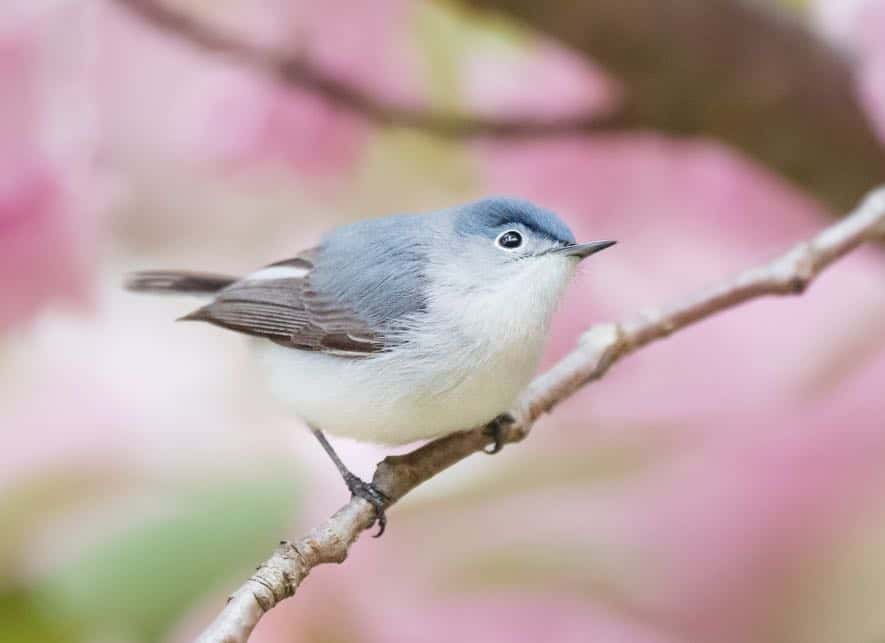
Appearance: Blue-gray gnatcatchers are tiny birds 4.25″ long, with soft blue/gray upperparts, white eye-rings, white underparts, and long black long tails with white under. The females are the same. The breeding male is accented with narrow black eyebrows.
Diet: Insects and spiders.
Feeder food: Unlikely to visit the feeder.
Habitat: Deciduous forested areas.
Nesting:
- Nest: Tidy cup-shaped nest of natural fibers, bark, and spiderweb about 3-80′ high in a tree or shrub.
- Broods: 1-2 broods/season
- Clutch: 3-5 eggs/brood
- Egg color: Pale blue with red/brown spots.
- Egg size: 0.5 – 0.6 inches by 0.4 – 0.5 inches
- Incubation: 11-15 days and the young fledge at about 10-15 days.
Migration: While many blue-gray gnatcatchers remain in their year-round range during the spring & summer, most migrate north into the US for breeding and to raise their young. The migrators then head back south in the fall and return to their year-round range or even further south along the Mexican Pacific coast, southern Florida, and the Caribbean islands to spend winter.
Year-round range: The southernmost part of these US states: California, Arizona, New Mexico, Texas, Louisiana, Georgia, Mississippi, Alabama, Florida, South Carolina, North Carolina, and Virginia.
Breeding range: Eastern half of the US as well as California, Nevada, Utah, Arizona, Colorado, New Mexico, Texas, Kansa, and Oklahoma.
Winter range: Southern California, southwest Arizona, along the Pacific coast of Mexico, the southernmost tip of Florida, and the Caribbean islands.
Range Map
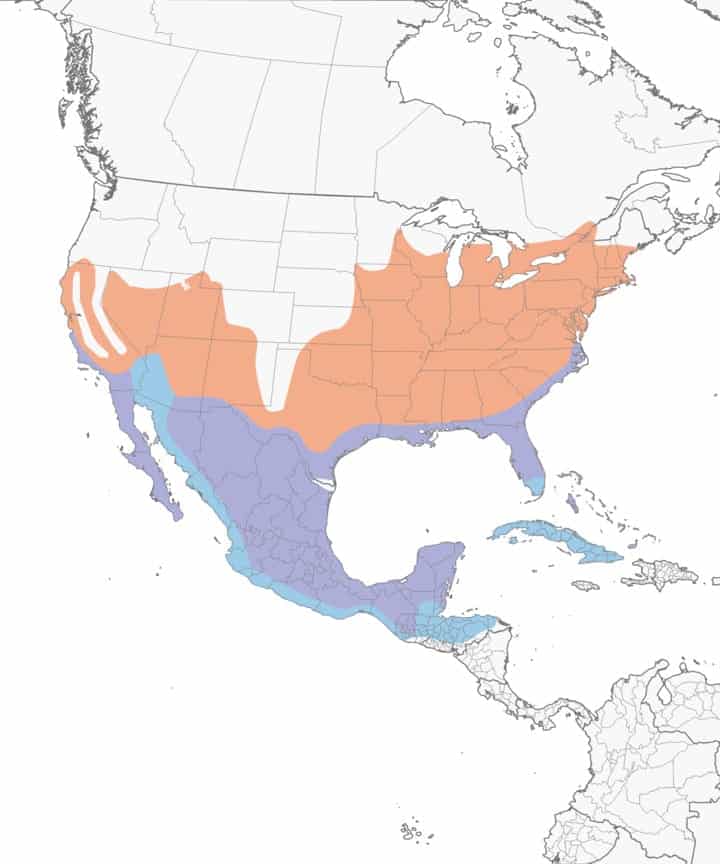
Brewer’s Blackbird
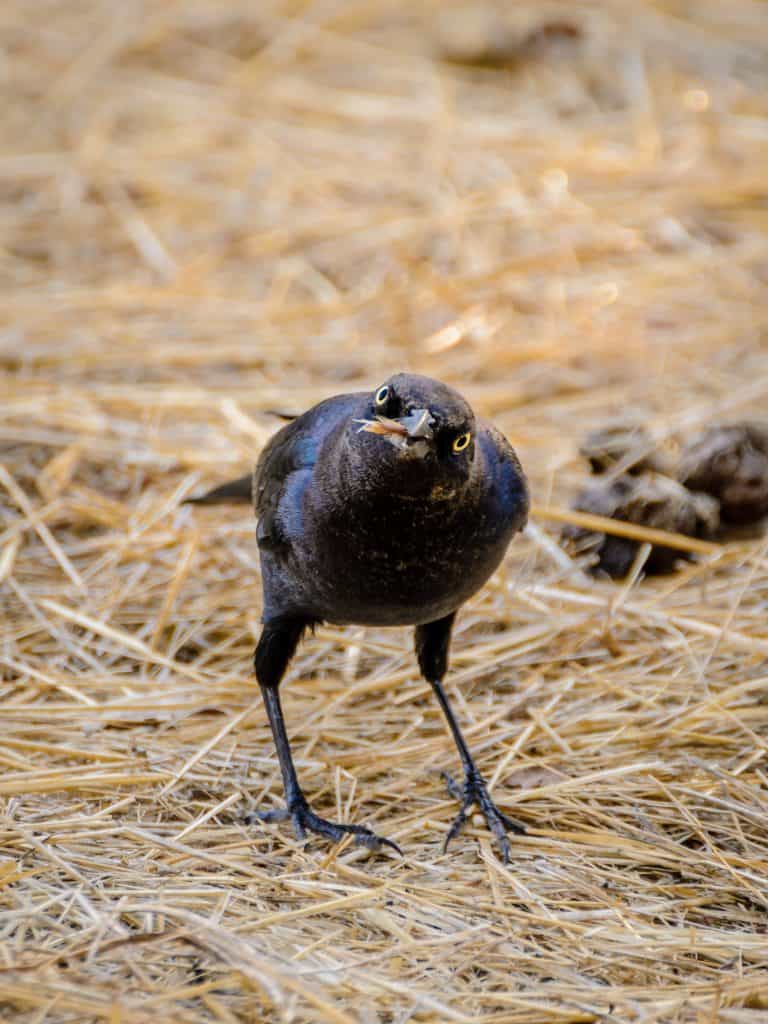
Diet: Insects, seeds, and berries.
Appearance: Brewer’s blackbird is a large bird about 9″ long. They’re all black with purple and green iridescence on the head and body. The female is dull gray/brown instead.
Feeder food: Any type of seed offered on a platform feeder or scattered on the ground.
Habitat: Inhabits a variety of habitats – open woodlands, mountain meadows, city sidewalks, and suburban backyards.
Nesting: They nest in a tree 20-40 feet up. The nest is a bulky cup shape comprised of twigs, grasses, and other plant material. They have 1-2 broods/season and 4-6 eggs/brood. The eggs are light gray to greenish/white and often spotted. Incubation is for 12-14 days and fledglings leave the nest at 13-14 days.
Migration: Brewer’s blackbirds are migrators. While some remain in their year-round range for all four seasons, many head north and east in the spring for breeding and raising their young. Then in the fall, they’ll return or head further south in the southern half of the US or Mexico.
Year-round range: Western US states and Canada’s British Columbia.
Breeding range: Montana, Wyoming, Colorado, and Canada’s British Columbia, Alberta, Saskatchewan, Manitoba, and Ontario.
Winter range: US states south of Kansas, Mexico, and the western part of Canada’s British Columbia.
Range Map
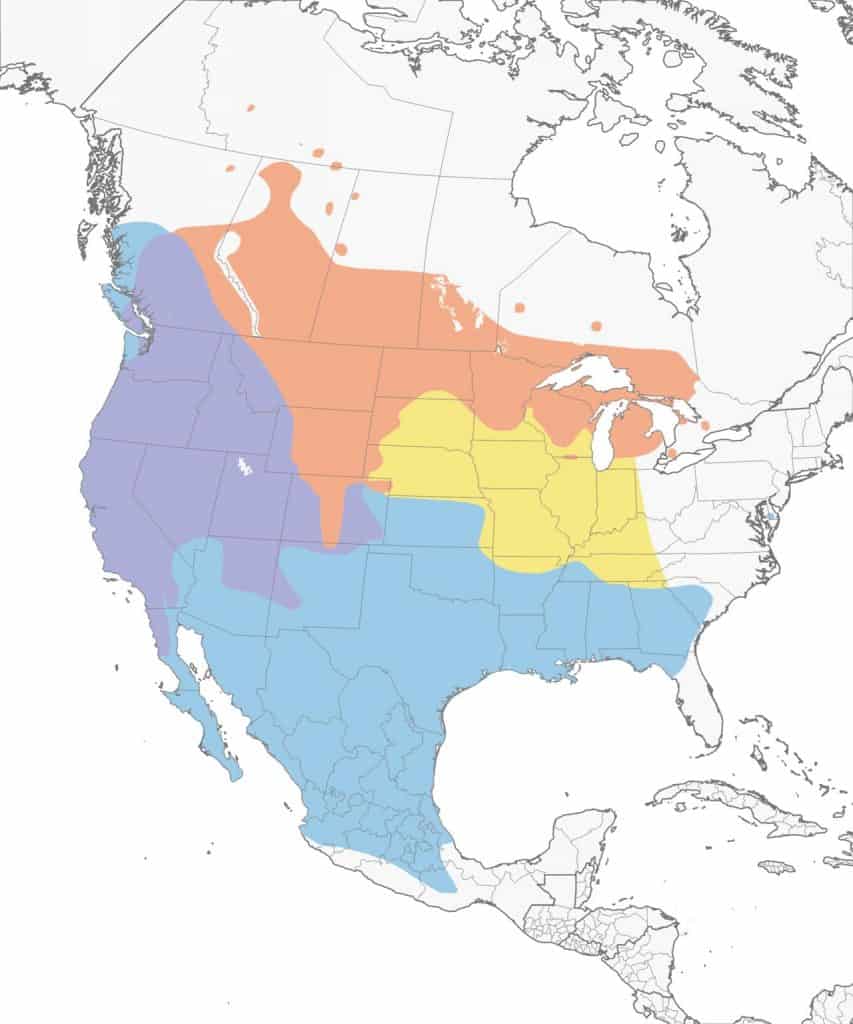
Brown Creeper

| Appearance | The brown creeper is a small bird about 5″ long. They have a brown body with a white belly, long tail, and thin curved bill. They have a white streak above each eye. The female looks the same. |
| Diet | Insects, nuts, and seeds. |
| Feeder Food | Hulled sunflower seeds, suet, and hulled peanuts. |
| Habitat | Forested areas. |
| Nesting | Cup-shaped nest They have 1 brood/season and 5-6 eggs/brood. Eggs are white with tiny brown marks. Incubation is for 14-17 days. |
Range Map
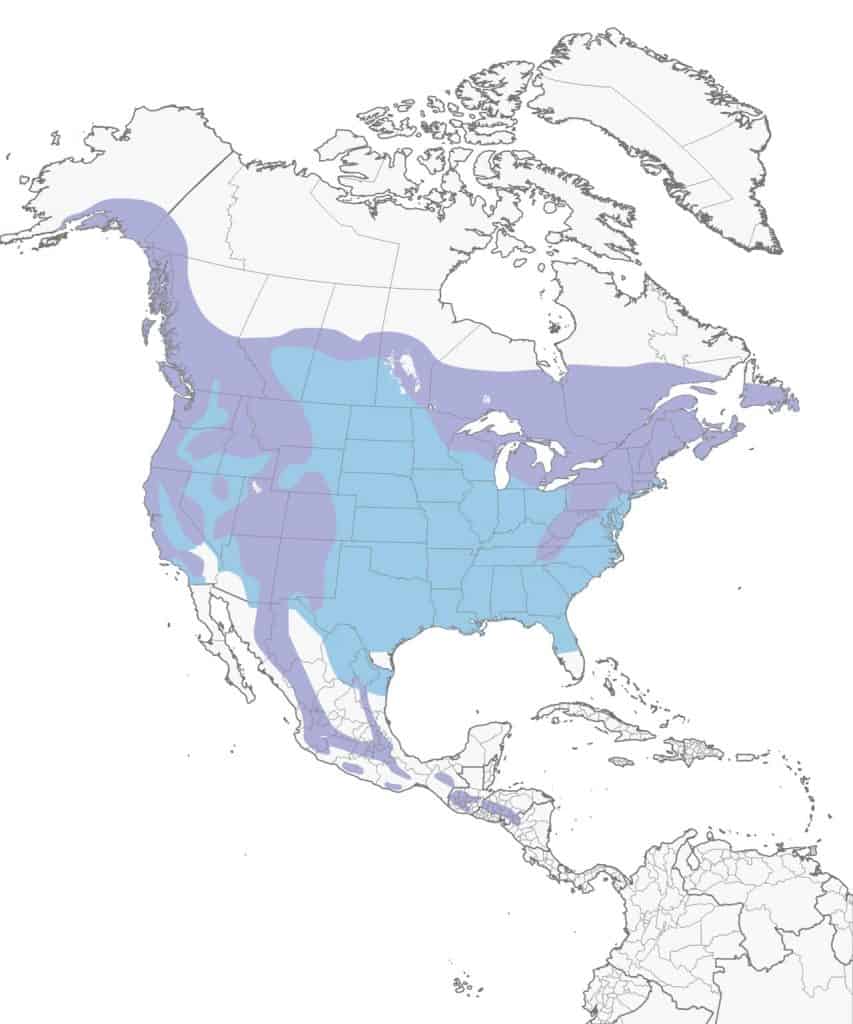
Brown Creeper in Winter

Appearance: The brown creeper is a small bird about 5″ long. They have a brown body with a white belly, long tail, and thin curved bill. They have a white streak above each eye. The female looks the same.
Winter diet: Insects hibernating beneath the bark, nuts, and seeds.
Winter feeder food: Hulled sunflower seeds, suet, and hulled peanuts.
Winter habitat: While many brown creepers remain in their year round range, some head south for the winter. As a result there are brown creepers found in every state of the US and Canada during winter. They prefer to be in forested areas.
Range Map

Brown Thrasher
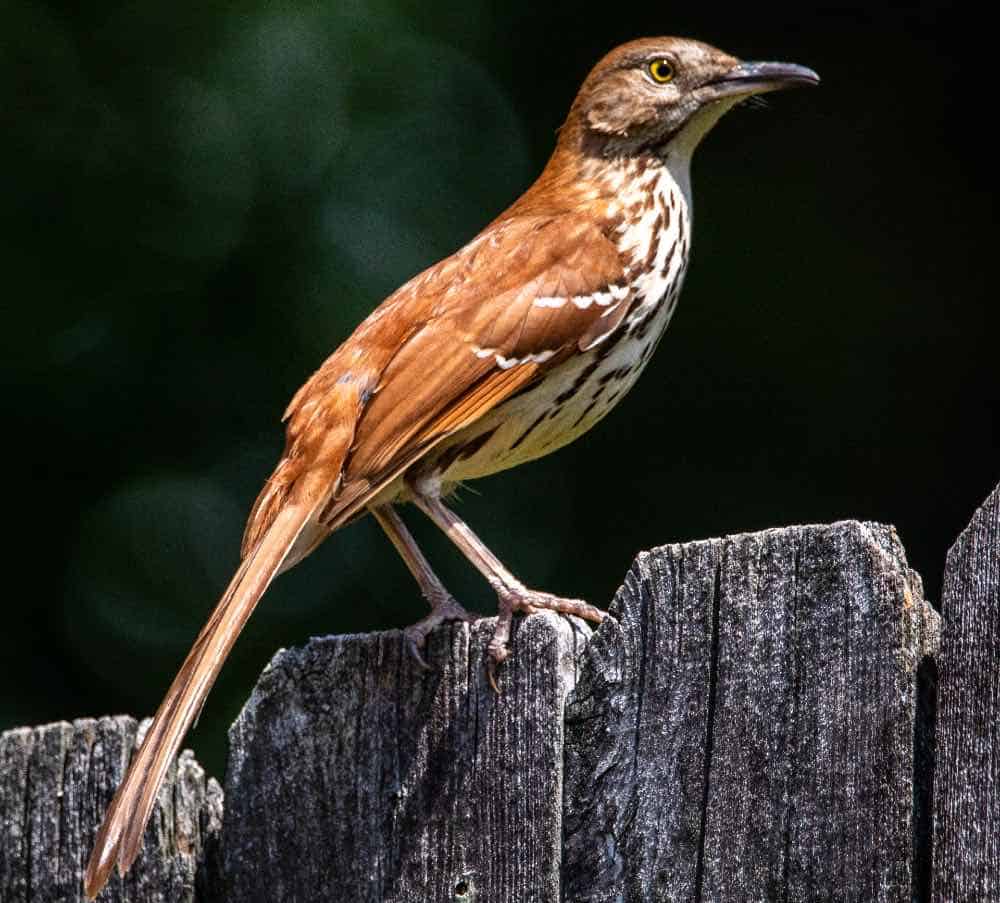
Range Map
| Appearance | Large rusty-red bird about 11″ long. Long, thin tail, heavily streaked chest and belly. Long curved bill and bright yellow eyes. Also has two white wing bars. |
| Diet | Insects and fruit. |
| Feeder Food | Not a common feeder bird but may stop to dine on fallen seeds. |
| Habitat | Thick shrubs, wooded edges, and hedgerows in the east. In the western part of the range, they can be found living in tree lines, fence rows, and woodlands. |
| Nesting | Bulky cup-shaped nest about 3.5″ in diameter located low in a thorny shrub or tree. They have about two broods per year, 4-5 pale blue 1″ eggs with brown markings. |
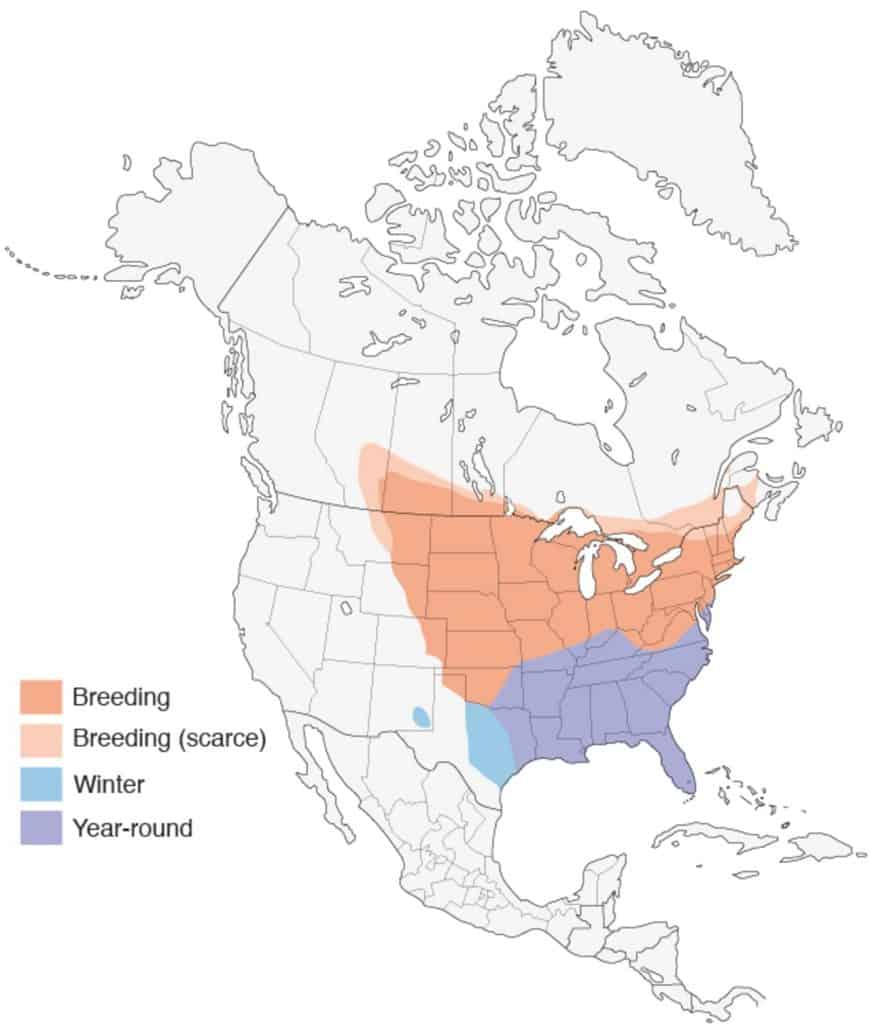
Brown-Headed Cowbird
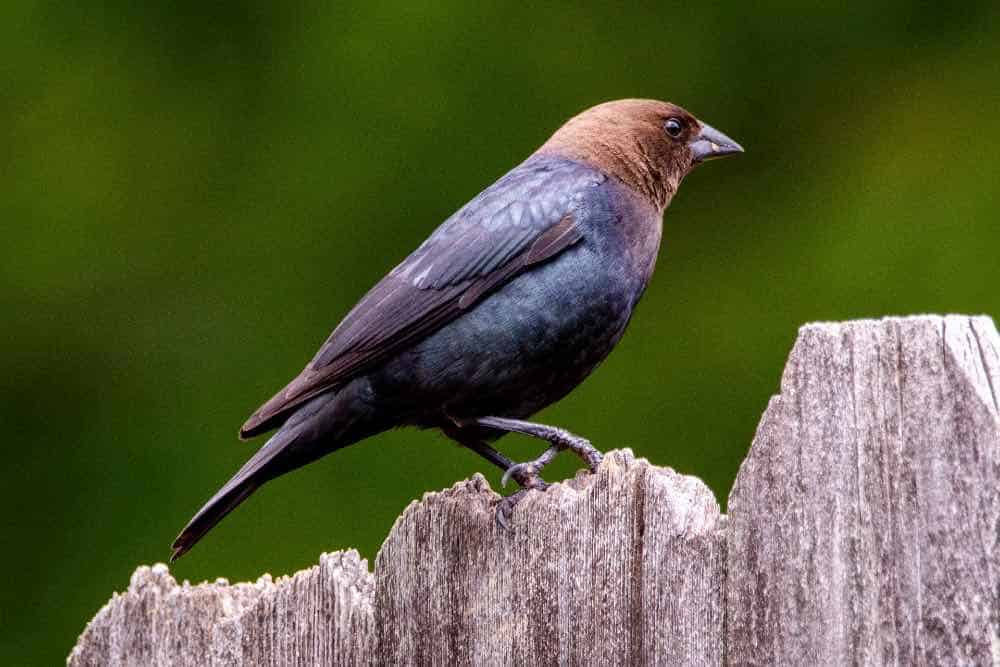
| Appearance | Medium-sized bird about 7 1/2″ long. The male is a glossy black with a chocolate brown head with a long pointed gray bill. The female is a dull brownish-gray. |
| Diet | Insects and seeds. |
| Feeder Food | Mixed birdseed. |
| Habitat | Thick shrubs, wooded edges, and hedgerows in the east. In the western part of the range, they can be found living in tree lines, fence rows, and woodlands. |
| Nesting | Brown-headed cowbirds don’t build nests. They lay about 5-7 white eggs with brown markings in other birds’ nests to incubate and raise the young. |
Range Map
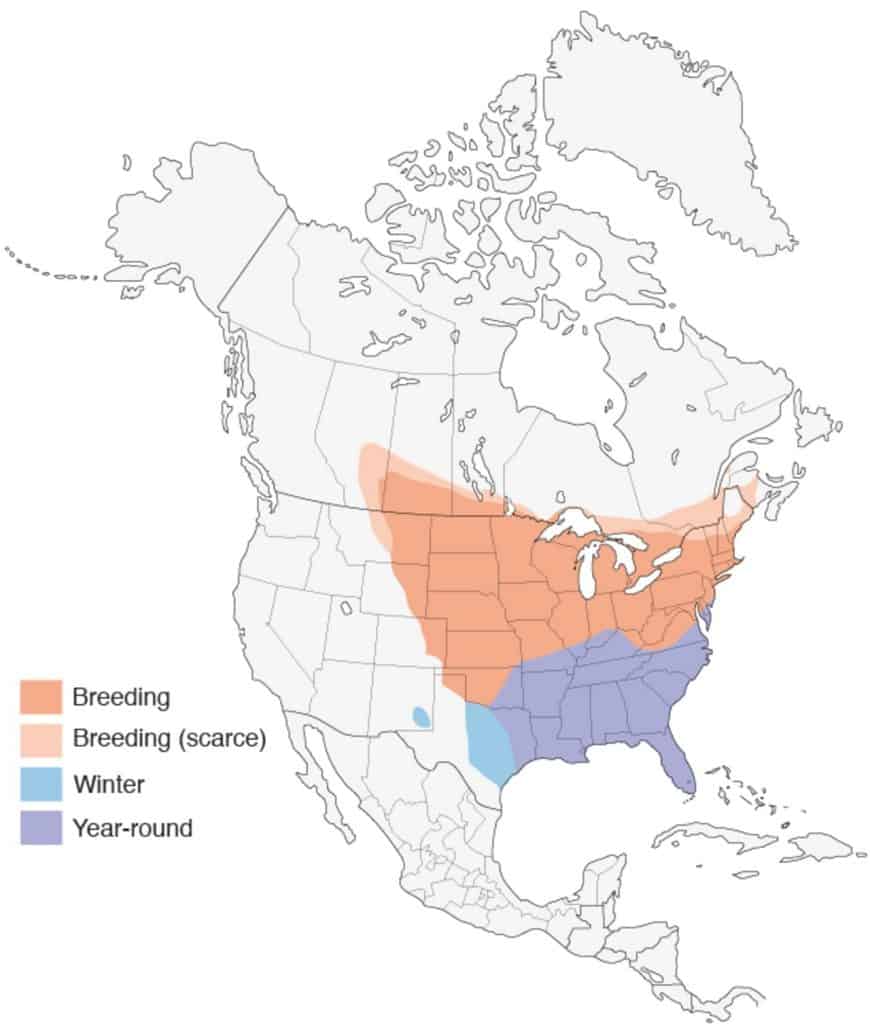
Carolina Chickadee
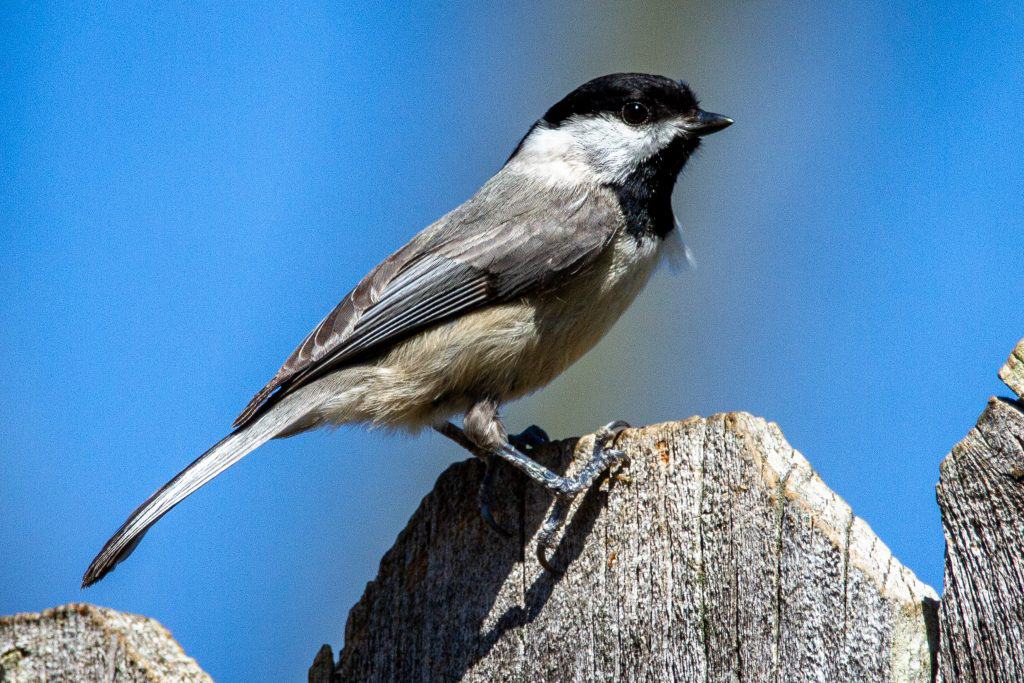
Appearance: The Carolina chickadee is a small bird about 5″ long. They’re primarily gray on top and white underneath. They have a black cap & throat, white cheeks that fade to gray in the back, and buffy tan flanks.
Diet: Insects, spiders, seeds, and small fruits.
Feeder food: Sunflower seeds, peanut chips, and suet.
Habitat: Woodlands and wooded edges, suburbs, and city parks.
Nesting: Carolina chickadees are cavity nesters – usually in an old woodpecker hole. They have 1 brood/season with 5-8 eggs/brood. Incubation lasts for 12-15 days and fledglings leave the nest at about 16-19 days post-hatch.
Migration: Carolina chickadees are not migrators. They remain in their year-round range for all 4 seasons of the year.
Year-round range: Southeastern US states.
Range Map
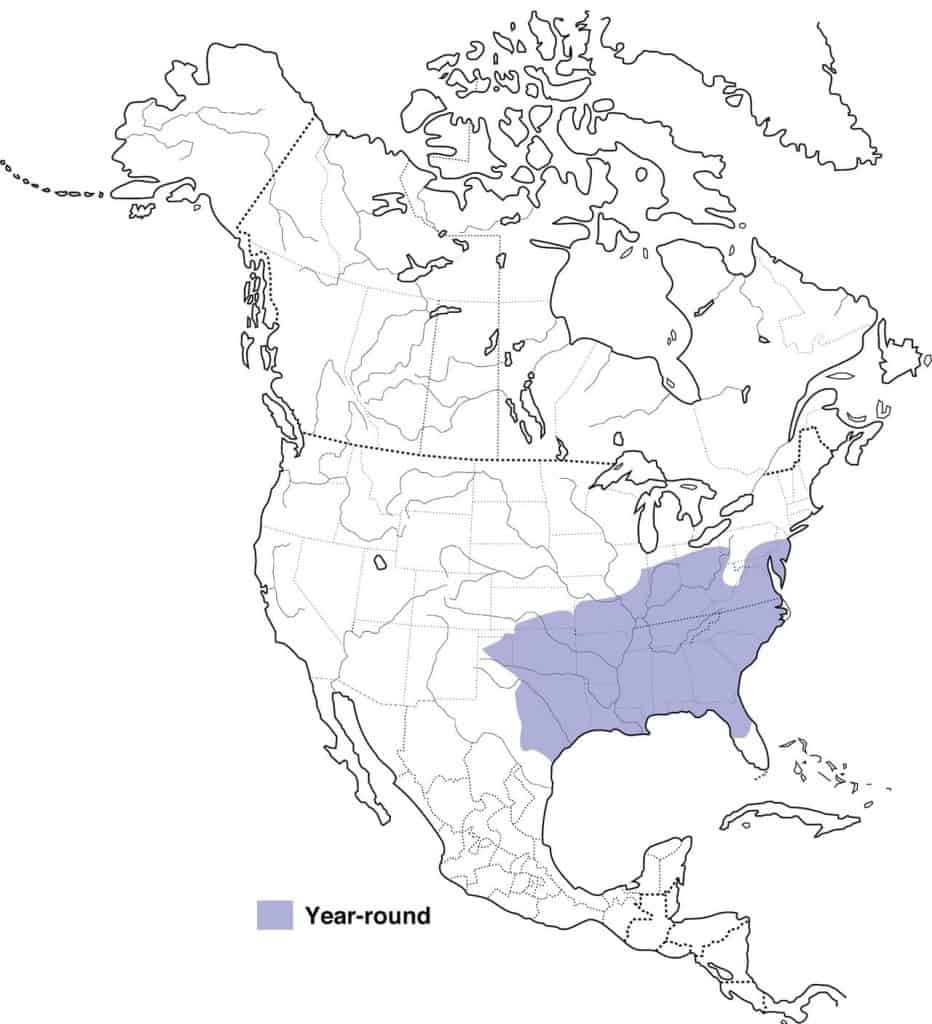
Carolina Wren
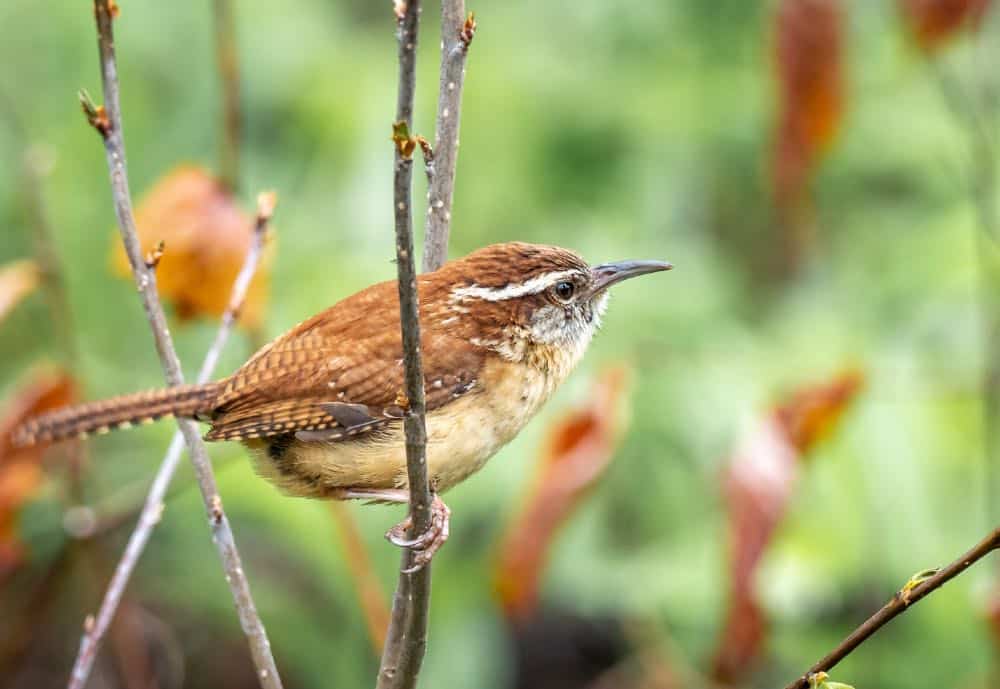
| Appearance | Small bird about 5 1/2″ long, chunky shape with deep rusty brown above and cinnamon color below. Bold white stripe above the eye and throat. Down curved bill. |
| Diet | Insects and spiders. |
| Feeder Food | Carolina wrens are common at the feeder. They enjoy hulled sunflower seeds, mealworms, peanut hearts, and suet in the winter. |
| Habitat | Brushy woods and wooded backyards. |
| Nesting | Bulky domed cup nest less than 10 up in a tree, inside an open tree cavity, in a hanging fern plant, or even in an upside-down flower pot. They have 1-3 broods/year, 4-6 eggs/brood, and incubate for 12-14 days. Eggs are a shade of white or pink/white with tiny brown spots. |
Range Map
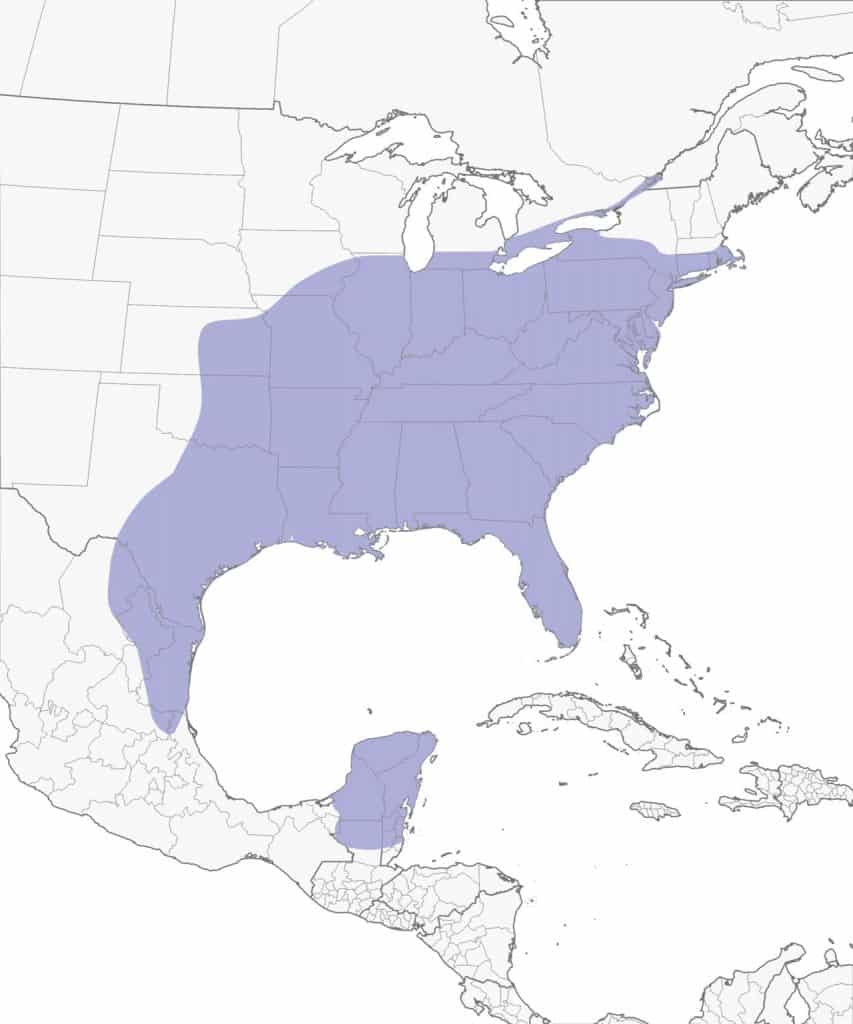
Cave Swallow
| Appearance | Small 5.5″ long bird with, narrow body, pointed wings, tail with notch, and short bill. Dark gray/brown above and pale below, black strip on head, chestnut rump, forehead, and cheeks, and the pale chestnut throat. |
| Diet | Insects. |
| Feeder Food | Unlikely to visit a feeder. |
| Habitat | Grasslands near water. |
| Nesting | Prefers to nest in cave entrances but will also use bridges and culverts. Nest made from mud and bat guano (excrements from seabirds & bats). 1-2 broods/season, 1-5 eggs/brood, eggs are .85″ long and white with dark spots, incubation is from 15-18 days. |
Cedar Waxwing
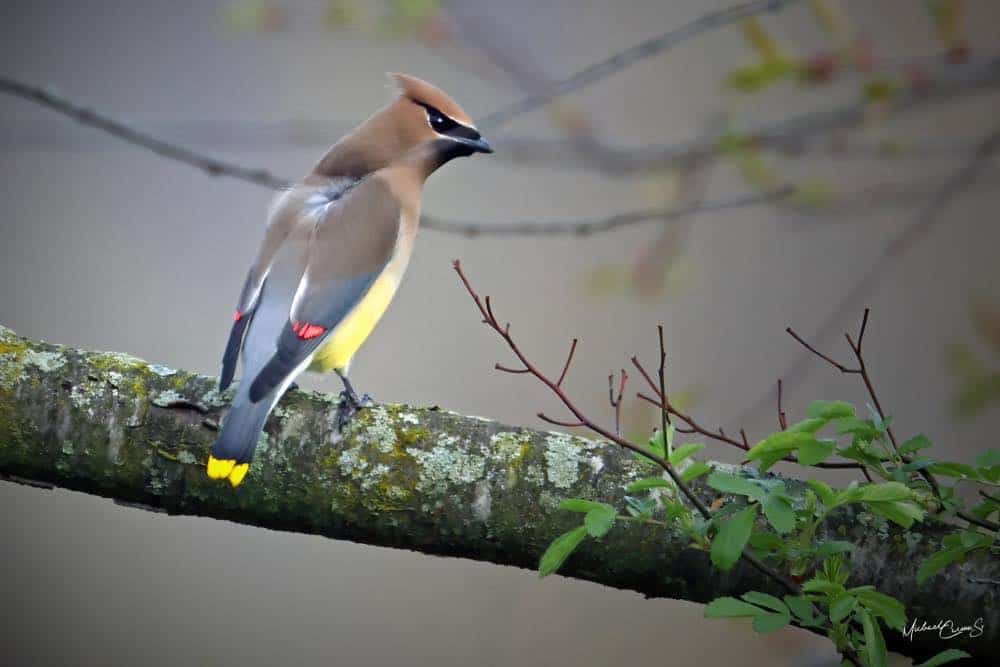
| Appearance | The cedar waxwing is about 7 1/4″ long, primarily light brown with a silky crest of the same color, yellow belly, a bright yellow tip on the tail, varying shades of brown underneath, and a touch of red at the tip of the upper wings. The beak is black, short, and pointy. Male and female adults look pretty much the same with one very subtle difference – the black on the male’s chin encompasses a slightly larger area than the female |
| Diet | Mostly fruit. Insects if no fruit is available. |
| Feeder Food | Fruit (oranges) |
| Habitat | Open forests, orchards, and wooded residential areas especially near berry bushes. |
| Nesting | The pair builds an open-cup-style nest 6-20′ high in a tree. She lays 3-5 eggs and incubates for 12-14 days. The eggs are blue-gray and often spotted with black or gray. |
Range Map
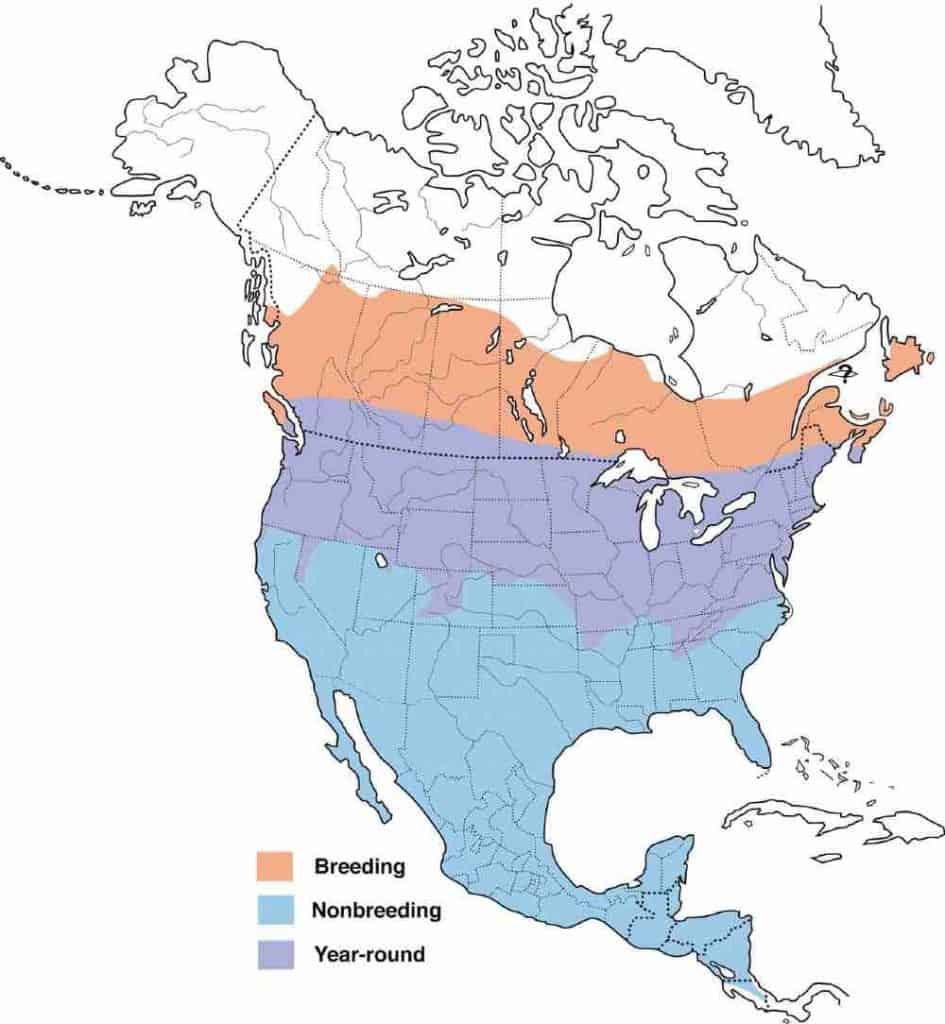
Cerulean Warbler

Appearance: Cerulean warblers are small 4.3″ long birds with sky-blue above, white wing bars, darker blue streaks on the back, white belly, steel/blue neck band & stripes on the sides. The females are light blue/green above, with soft yellow bellies, brown wings, and a bit of white under the eye.
Diet: Insects and plants.
Feeder food: Unlikely to visit the feeder.
Habitat: Deciduous forests with mature tall trees.
Nesting: Cup-shaped nests of twigs, grass, and spiderwebs placed in trees 16-115′ up. 1 brood/season, 1-5 eggs/brood, eggs are .6-.8″ long, gray/green, and speckled with brown, incubation lasts 11-12 days.
Migration: Cerulean warblers are migrators. They head north into the midwest and northeast states for spring & summer then head south to South America for the winter.
Breeding range: Eastern Minnesota, the southern half of Wisconsin & Michigan, Missouri, Illinois, Indiana, Ohio, Pennsylvania, New York, Kentucky, Tennessee, southern New York, and the far southern edge of Canada’s Ontario.
Winter range: South America.
Range Map

Chestnut-Sided Warbler
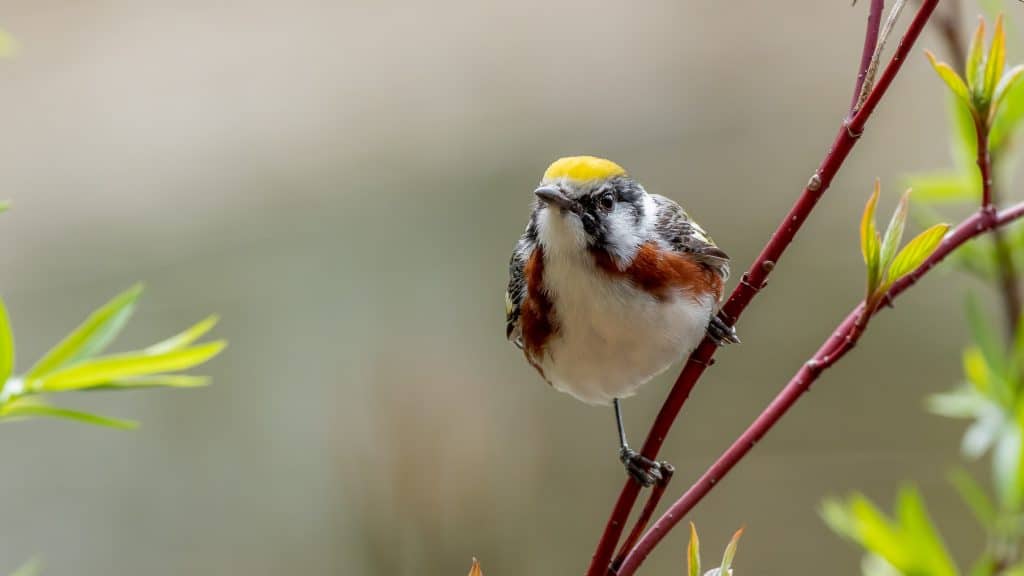
| Appearance | The chestnut-sided warbler is a small bird about 5″ long. It has an array of colors: a yellow cap, black mask, white on the face, chin, chest, and belly, yellow wing bars, and chestnut below the gray wings. The female is the same except she has brown below the wings rather than chestnut. |
| Diet | Insects and berries. |
| Feeder Food | Unlikely to visit a feeder. |
| Habitat | Thickly forested areas with young deciduous trees. |
| Nesting | A cup-shaped nest. They have 1 brood/season, and 3-5 eggs/brood that are white with brown markings. Incubation is for 12-13 days. |
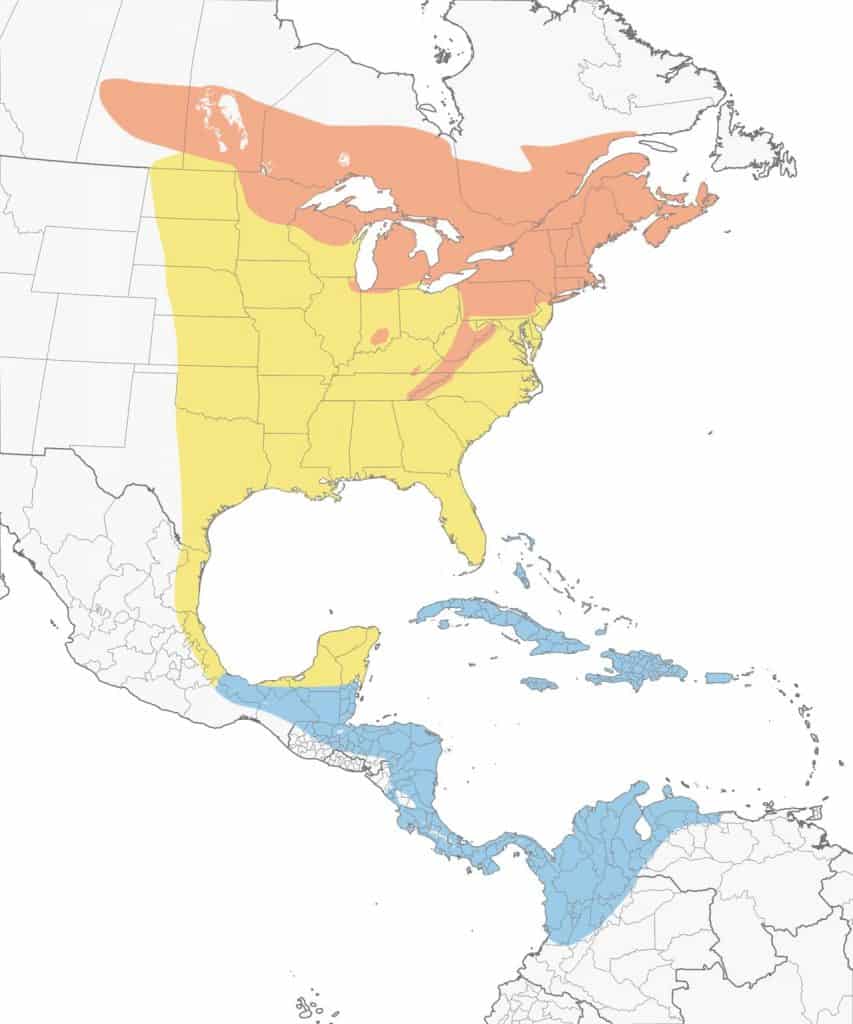
Chipping Sparrow

Appearance: The chipping sparrow is a small bird about 5″ long, gray/brown with a light gray chest and rusty crown. Eyes have white eyebrows with a black eye lining, a thin gray-black bill, and 2 wing bars. Males and females look the same.
Diet: Insects and seeds.
Feeder food: Black-oil sunflower seed, mixed seeds. Mostly a ground feeder.
Habitat: Open areas and edges of woodlands.
Nesting: The nest is placed low in dense shrubs. They have 2 broods/year and 3-5 eggs/brood that are blue/green with brown markings. Incubation lasts 11-14 days.
Migration: Chipping sparrows are migrators. In spring they migrate north into every US state and Canadian province o breed and raise their young. Then in the fall, they head back south to southern California, Arizona, Florida, Georgia, Mexico, and the Caribbean islands for winter.
Breeding range: All US states and Canadian provinces.
Winter range: Southeastern California, southwestern Arizona, the pacific coasts of Mexico, Florida, southwestern Georgia, and the Caribbean island.
Year-round range: A population of the birds remains in their year-round range in central to southern California as well as parts of Central America.
Range Map

Cliff Swallow
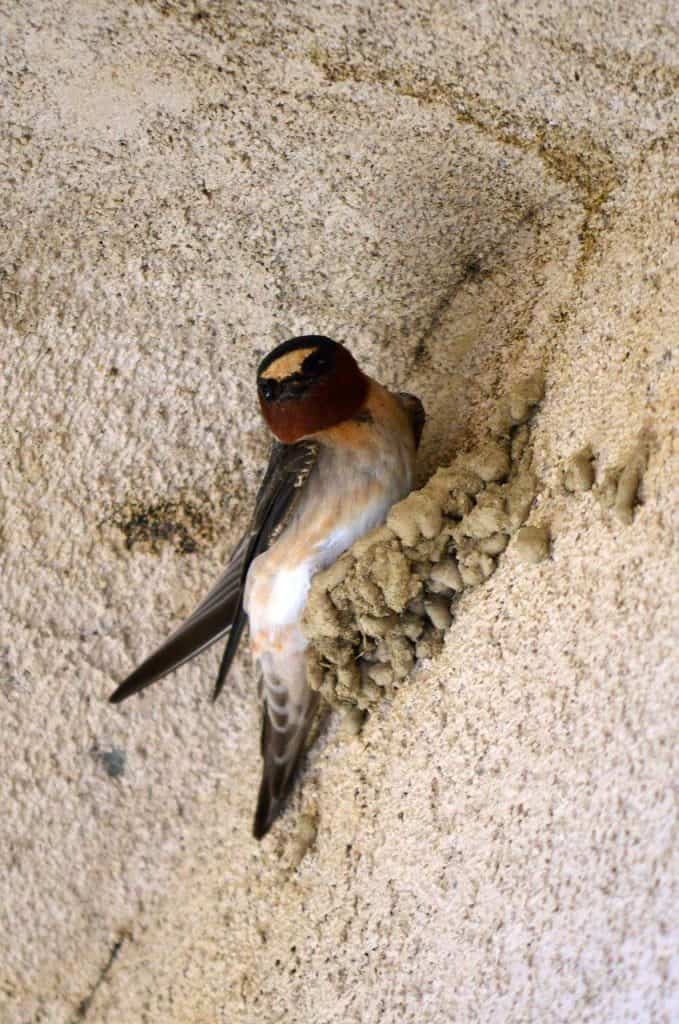
| Appearance | Cliff swallows are small birds about 5 1/2″ long with a chunky body, and short, square tail, and a short, pointy bill. They have a dark navy blue head & throat, white forehead, black wings with a navy patch, cinnamon throat, striped chest, and rump. Underparts are primarily white. |
| Diet | Flying insects. |
| Feeder Food | They don’t visit feeders. |
| Habitat | Open areas, overhanging cliffs, and man-made structures for nesting. |
| Nesting | They build their nests plastered to a sheltered rock wall of building often in large colonies with nests tightly packed in. They have 1-2 broods/season with 1-6 white, creamy or pink eggs in each brood. Incubation is for 10-19 days and nestlings fledge the nest about 20-26 days after hatching. |
Range Map
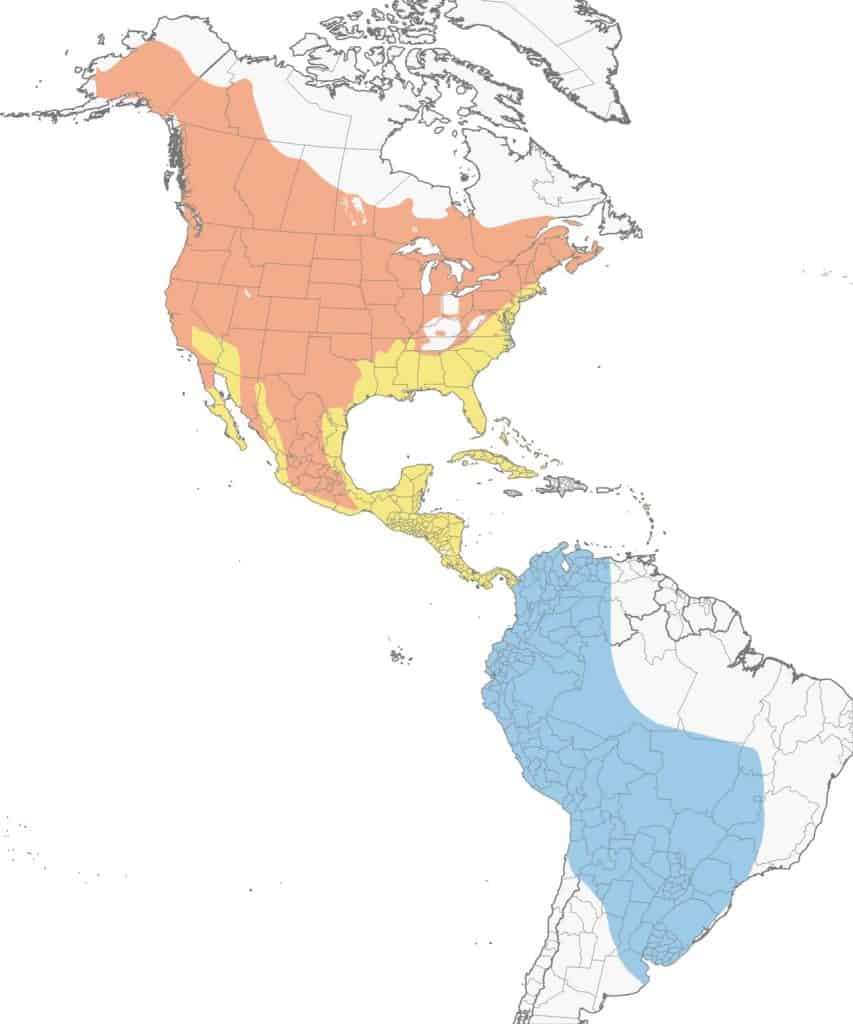
Common Grackle
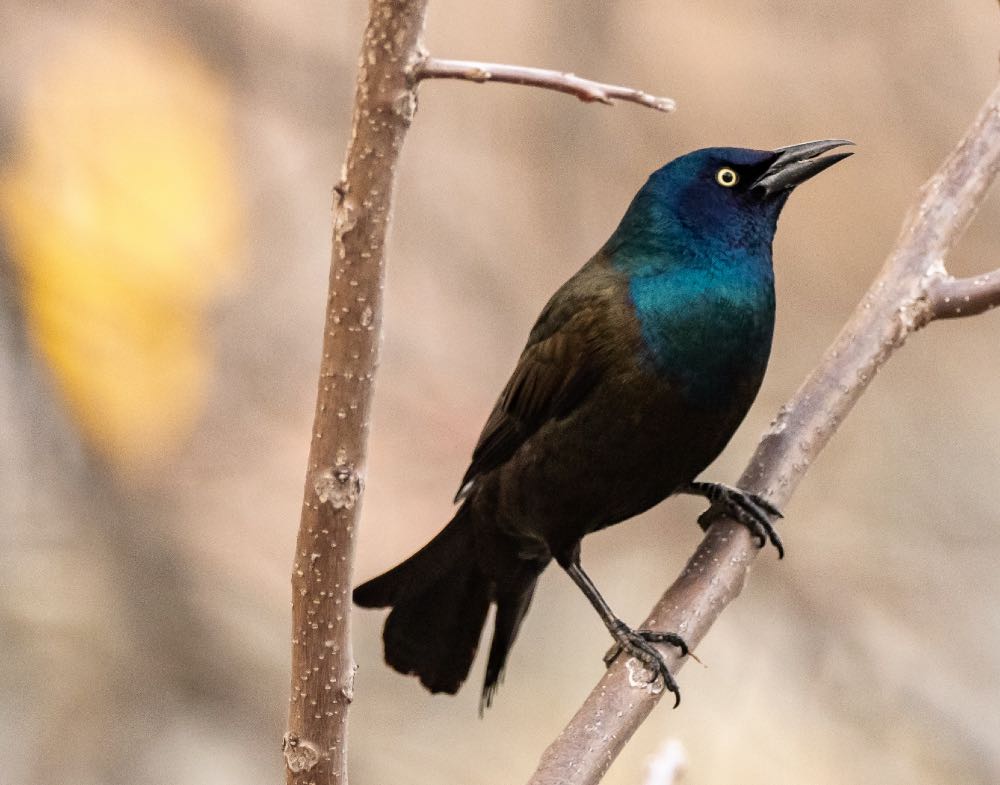
Appearance: The common grackle is a large bird about 12.5″ long bird with iridescent blue purple and bronze. Their eyes are yellow and they have long flared tails. The female is similar with less vibrant coloring (browner) and a shorter tail.
Diet: Insects, grains, seeds, fruit, scavenged garbage.
Feeder food: Sunflower seeds, black-oil sunflower seeds.
Habitat: Fields with scattered trees, open woodlands, farmlands, and marshes. Common in suburban yards.
Nesting: Bulky cup-shaped nest of twigs placed 3-20′ high in a conifer tree. 3-5 eggs incubated for 12-15 days. Young fledge at about 12-15 days.
Migration: Common grackles are migrators. While many remain in their year-round range all four seasons, many head north in spring (as far north as Canada’s Northwest Territories) to breed and raise their young. Then in the fall, they head back south into their year-round range. A small part of the population pushes further southwest of Texas.
Year-round range: Nebraska and the US states south and east of it. US states
Breeding range: Montana, Idaho, Wyoming, Colorado, New Mexico, North Dakota, South Dakota, Kansas, western Kansas, Minnesota, Wisconsin, Michigan, the New England states, and all Canadian provinces (except for Nunavut and barely British Columbia).
Winter range: Southwest edge of their Texas year-round range.
Range Map

Common Yellowthroat
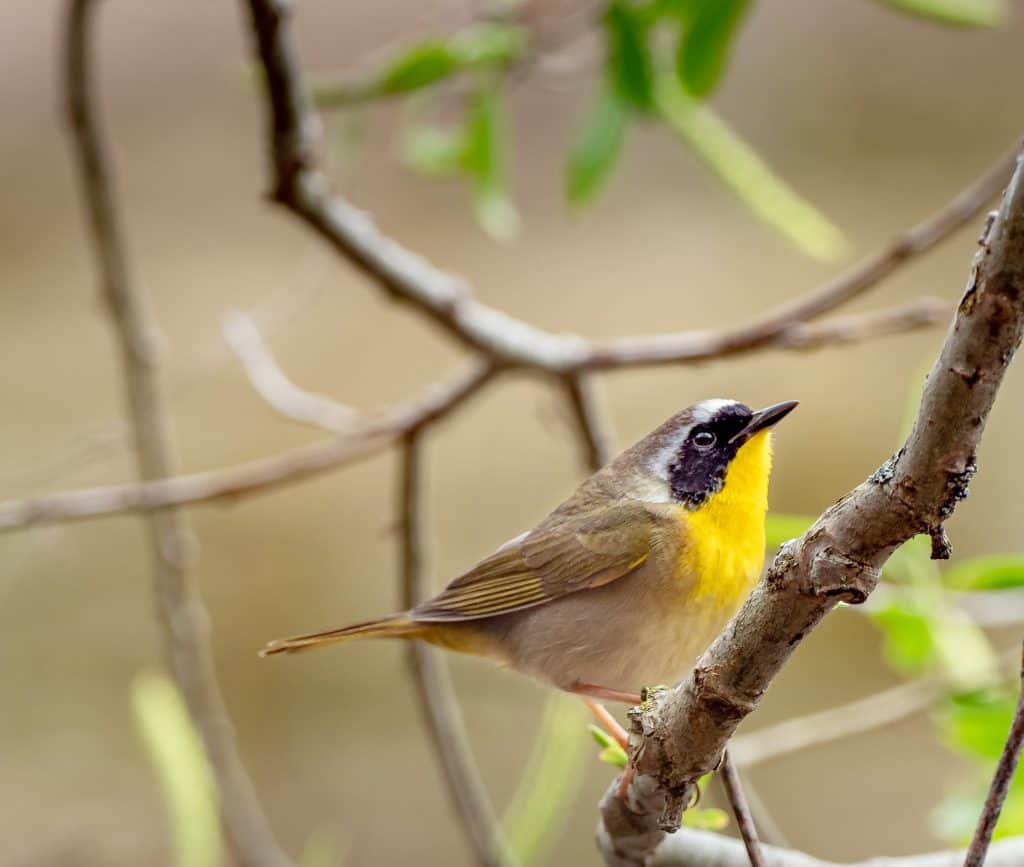
| Appearance | Small bird about 5″ long, olive-brown color with bright yellow throat and breast, and white belly. Black mask outlined in white. Long, thin, and pointy black bill. The Female is the same except with no black mask. |
| Diet | Insects. |
| Feeder Food | Unlikely to visit a feeder. |
| Habitat | Common in thick brush, open fields, and marshes. |
| Nesting | Cup-shaped nest located near the ground, often in a thick shrub. They have 2 broods/year, 1-6 eggs/brood, eggs are white with brown markings, and incubation lasts 11-12 days. |
Range Map
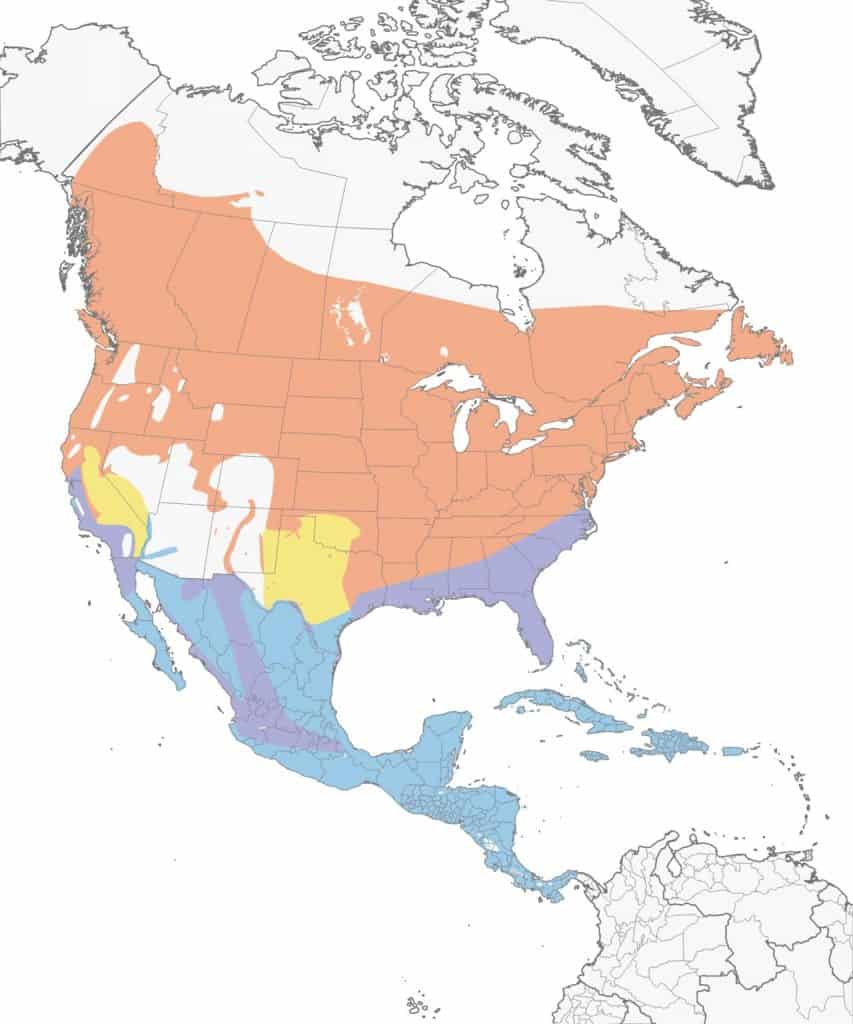
Connecticut Warbler
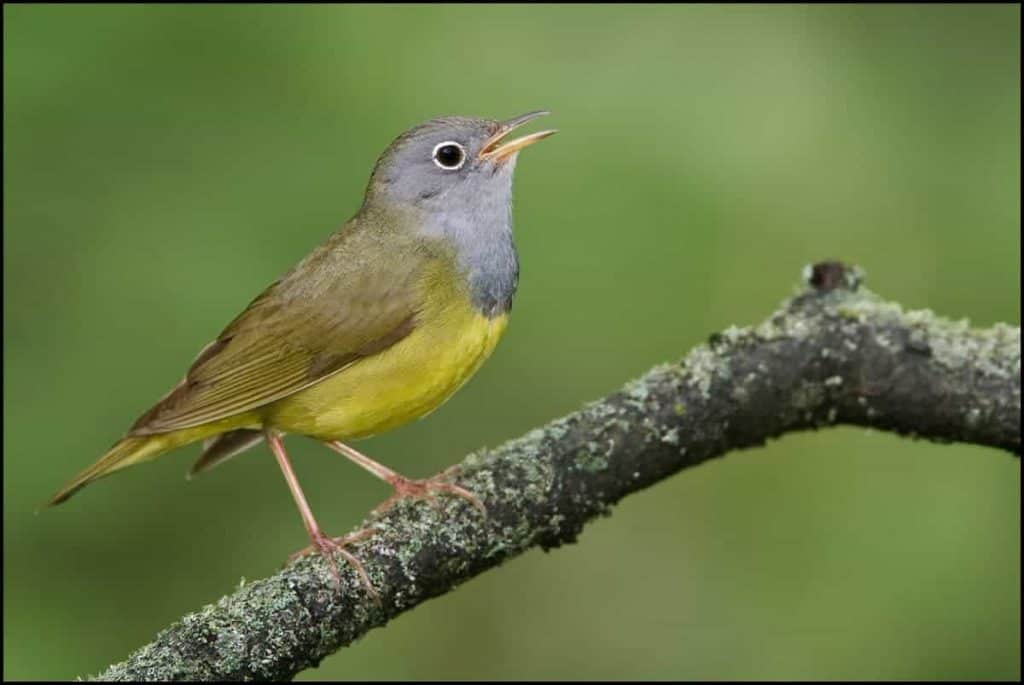
| Appearance | Small bird about 5 1/2″ long with a gray head, white eyering, yellow belly, and brownish wings. Females are a duller version of the male and tend to be more brown than gray. |
| Diet | Insects and spiders. |
| Feeder Food | Unlikely to visit a feeder. |
| Habitat | Open woodland areas, often in wet, marshy areas as well. |
| Nesting | Their cup-shaped nest is located near the ground. They have 1 brood/year with 3-5 eggs/brood. Eggs are ivory with dark spots. |
Range Map
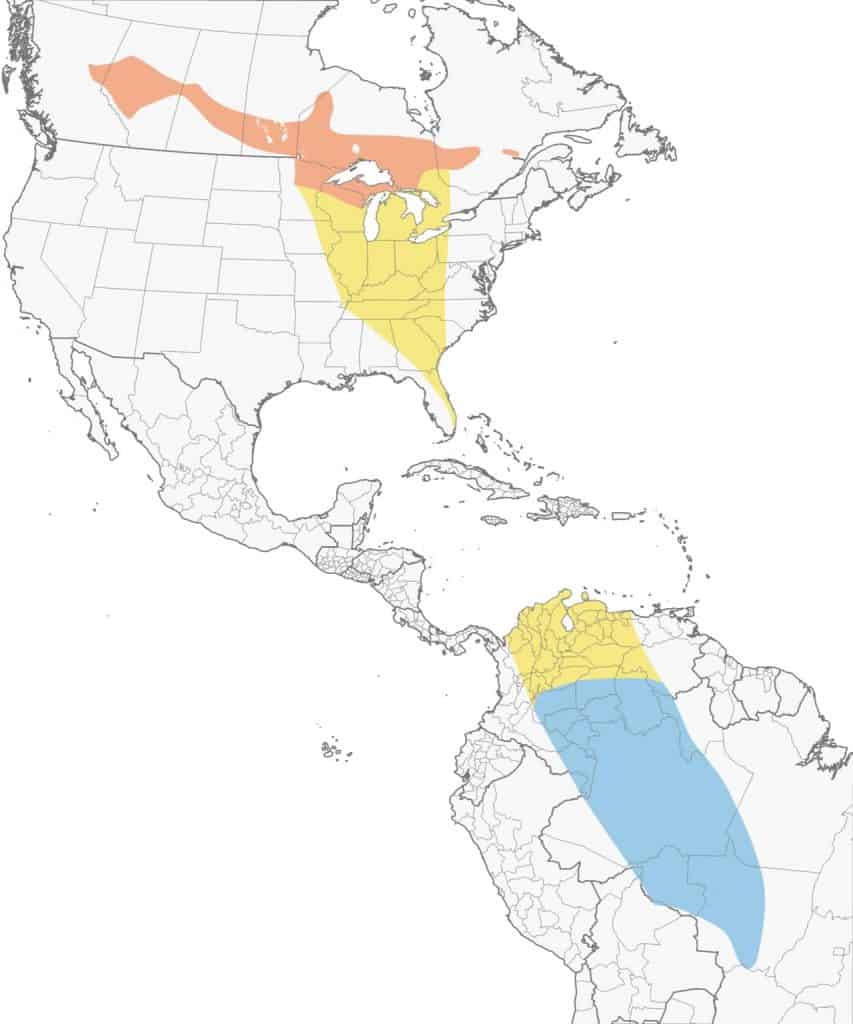
Dark-Eyed Junco
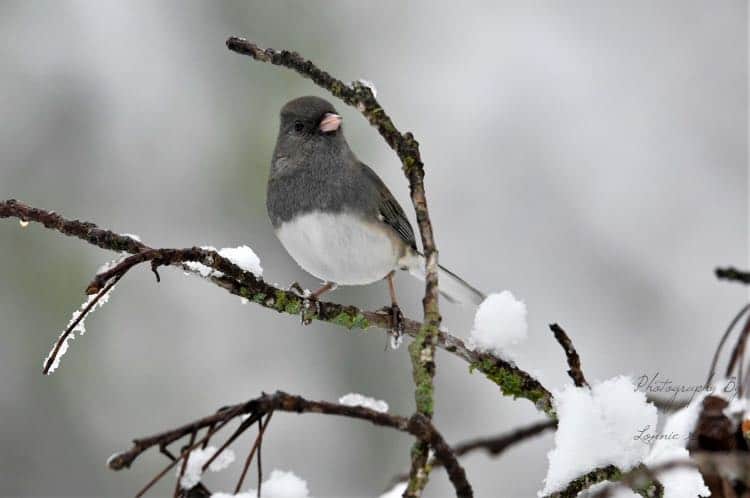
Appearance: Dark-eyed juncos are tiny birds about 5.5″ – 6.5″ long. Males are dark gray with a white underside and pink bill. Females are the same except brownish gray.
Diet: Insects, spiders, seeds.
Feeder food: Nyjer, black-oil sunflower seeds, hulled sunflower seeds, safflower seeds, cracked corn, hulled peanuts, and suet.
Habitat: Juncos are found across the US and Canada so can be found in a variety of habitats including forested areas (both coniferous and deciduous), wide-open spaces, partially wooded edges, parks, and backyards.
Nesting: Nests are located in a variety of locations from ground-level surrounded by vegetation to in a hanging basket. They have 1-3 broods/season, 3-6 eggs per brood that can be any of these colors: White, gray, pale bluish-white, or pale-greenish white speckled with brown, gray, and green. Occasionally unmarked. Incubation lasts 9-13 days.
Migration: Dark-eyed juncos are partial migrators. Some remain in their year-round range all seasons of the year while others migrate north in spring and south for the winter.
Year-round range: Southern Alaska, Washington, Oregon, Idaho, Montana, Wyoming, Utah, California, Nevada, Colorado, Arizona, New Mexico, northern Minnesota, Wisconsin & Michigan, Pennsylvania, New York, New England, and British Columbia & Alberta in Canada.
Breeding range: Alaska and Canada.
Winter range: The remaining US states (outside the year-round range above), southeast Alberta, southern Saskatchewan, far southeast Ontario, and Mexico.
Range Map
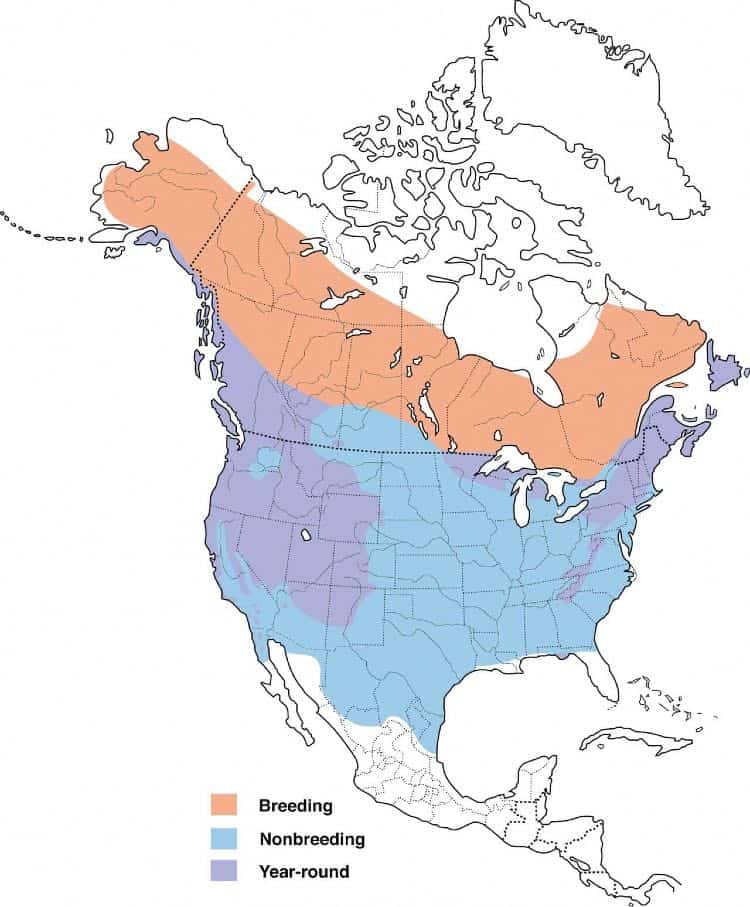
Want to see dark-eyed juncos in your yard? Check out my article: 7 Proven Ways to Attract Dark-Eyed Juncos.
Downy Woodpecker

Appearance: Downy woodpeckers are small birds 6″ – 7″ long. Males are tuxedo-black with a white stripe on the back, white belly, white outer tail feathers, some spotted areas of white on the wings, a yellow/tan spot above the beak, and the infamous red patch on his head at the back of the crown. Females are nearly identical without red coloring.
Diet: Insects, and fruit from trees/shrubs.
Feeder food: Suet, peanut butter spread, Sunflower seeds, Safflower seeds, hulled peanuts, corn, fruits, nectar (sugar water).
Habitat: Anywhere there are trees.
Nesting: Downy woodpeckers nest in cavities – either a hole in a tree trunk or a nesting box. Usually only one brood per season, 3-6 all-white eggs. Incubation is about 11-12 days.
Migration: Downy woodpeckers are not migrators. They remain in their year-round range all four seasons.
Year-round range: Every US state and Canadian province (except Nunavut).
Range Map
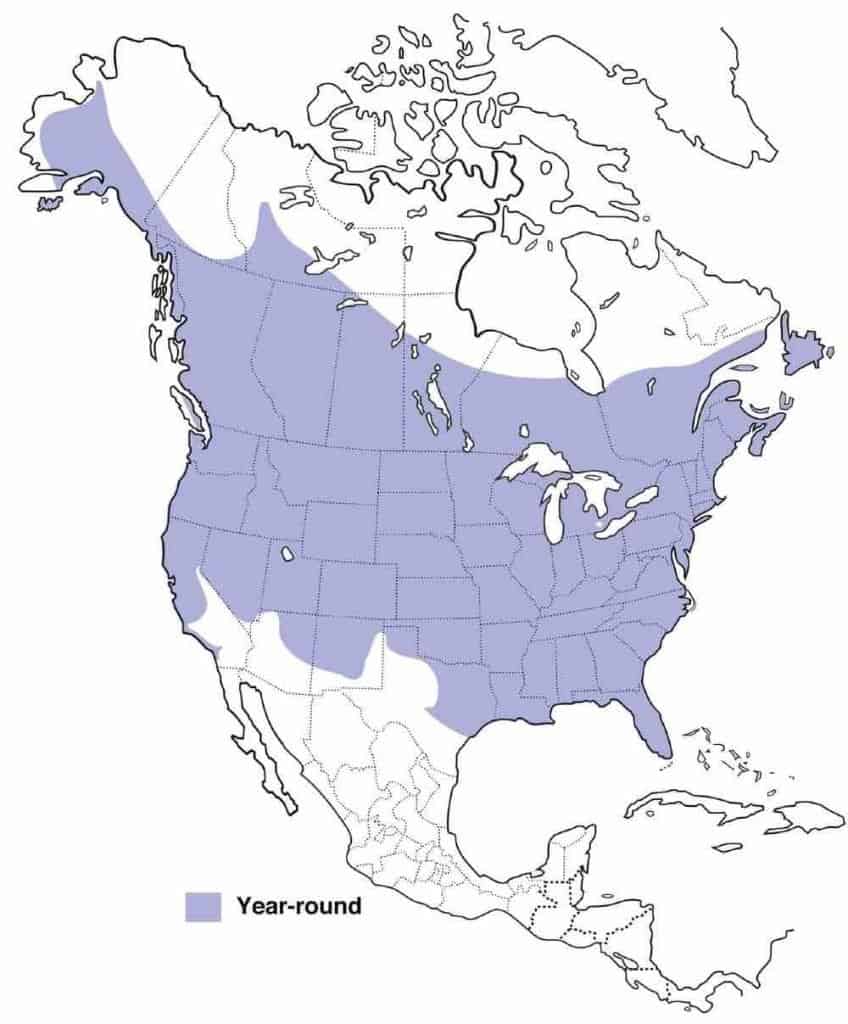
Eastern Bluebird
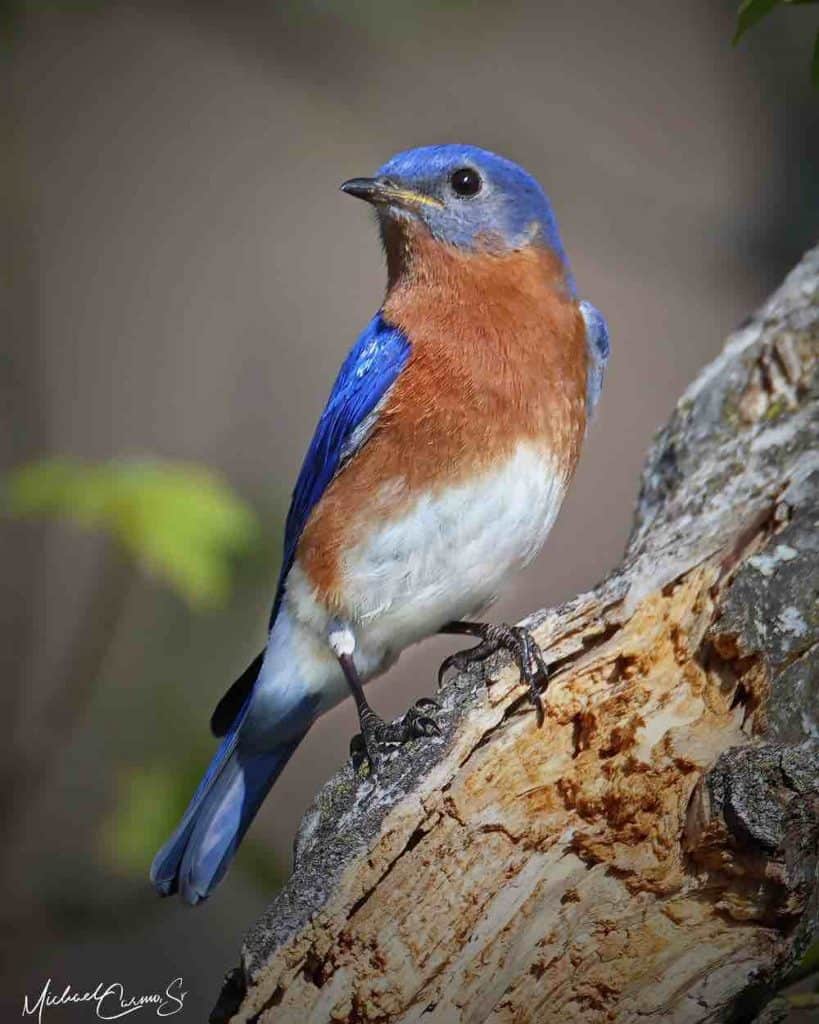
Appearance: Eastern bluebirds are small birds about 7″ long, royal blue, orange throat & breast, white belly & undertail. Female is similar but with more muted colors
Diet: Insects & spiders in spring/summer. Small fruit in Fall/Winter.
Feeder food: Suet, sunflower seeds, dried fruit, jelly.
Habitat: Wide-open spaces, fields, meadows.
Nesting:
- Nest: Cavity nesters. The male bluebird determines the nest site (an old woodpecker hole in a tree or manmade nestbox), but the female is the one who builds the nest. She keeps the nest for multiple broods.
- Brood: 2-7 broods/season
- Clutch: 4-5 eggs/brood
- Egg color: Pale blue eggs (sometimes white) with no blemishes or discoloration.
- Egg size: 0.9 inches by 0.8 inches
- Incubation: 11-19 days
Migration: Some eastern bluebirds are migrators. While many remain in their year-round range all year long, some migrate north for breeding and raising their young then head south in winter back into the year-round range or further west into Colorado, New Mexico, and western Texas.
Year-round range: The US states south and east of Nebraska, Mexico, and Central America.
Breeding range: Northwest Nebraska, South Dakota, North Dakota, Minnesota, the northern half of Wisconsin & Michigan, New Hampshire, Maine, and the southern part of these Canadian provinces: Saskatchewan, Manitoba, Ontario, and Quebec.
Winter range: Eastern Colorado, New Mexico, western Texas, and northeast Mexico.
Range Map
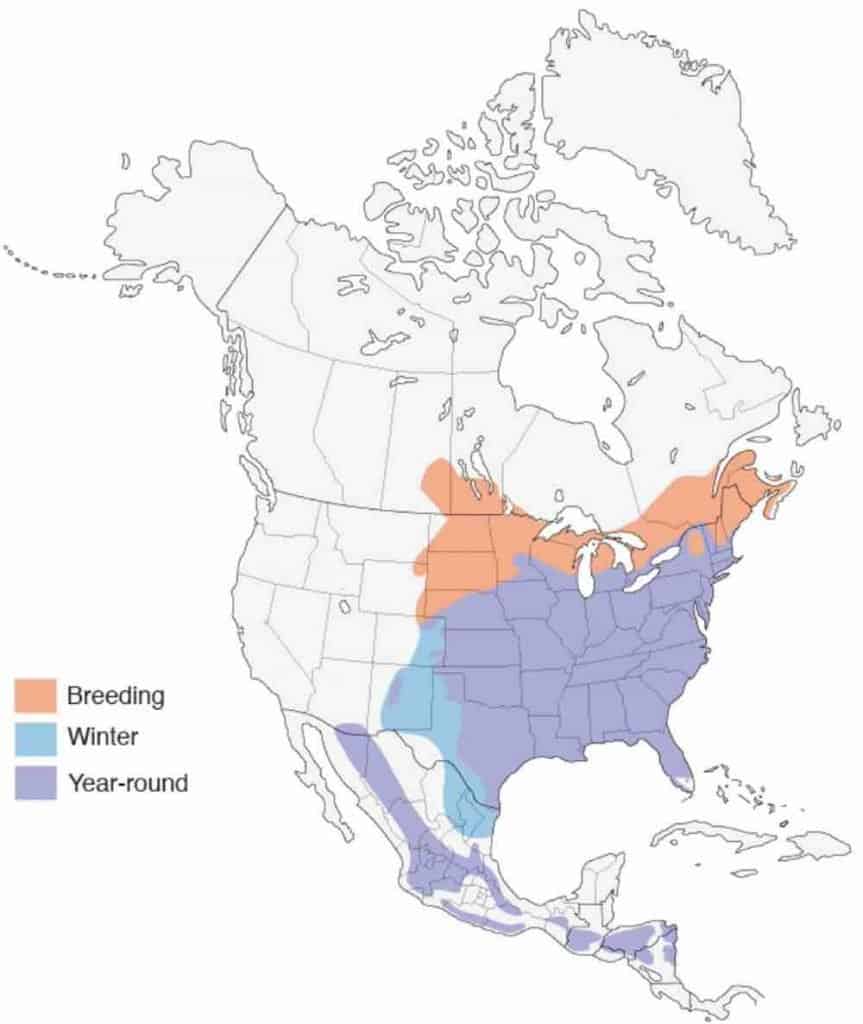
Eastern Kingbird
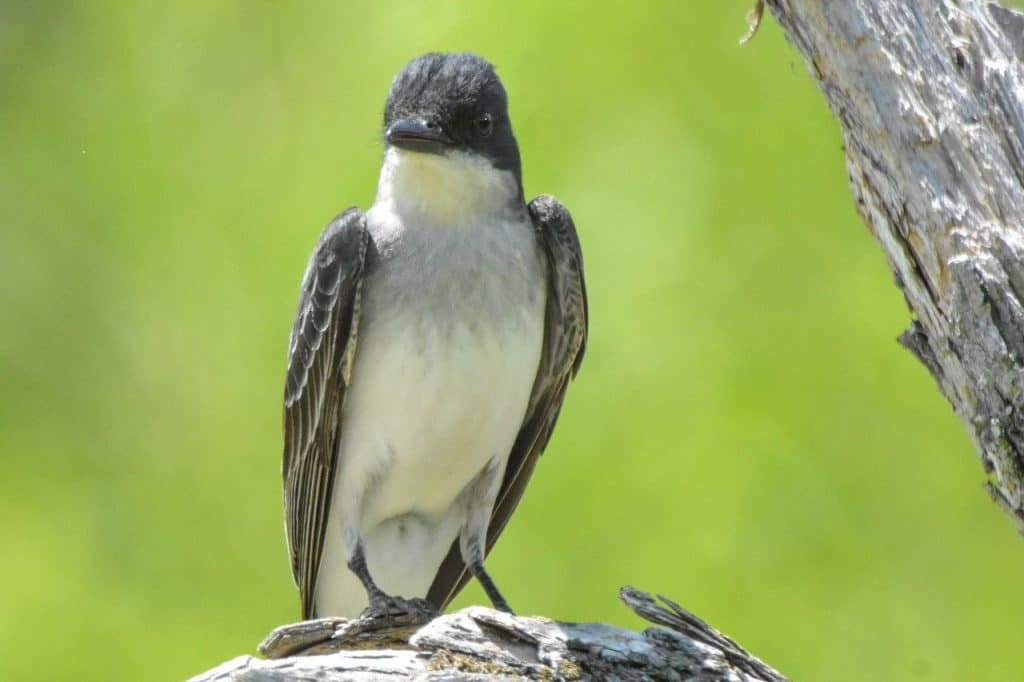
| Appearance | Medium0sized bird about 8″ long. They’re mostly charcoal gray with a black head, white belly, and white chin. A white band goes across the end of their tail and they have a red crown that is mostly concealed. |
| Diet | Insects and fruit. |
| Feeder Food | Unlikely to visit a feeder. |
| Habitat | Open fields and prairies. |
| Nesting | Cup-shaped nest. They have 1 brood/year with 33-4 eggs/brood. Eggs are white with brown markings and incubation lasts 16-18 days. |
Range Map
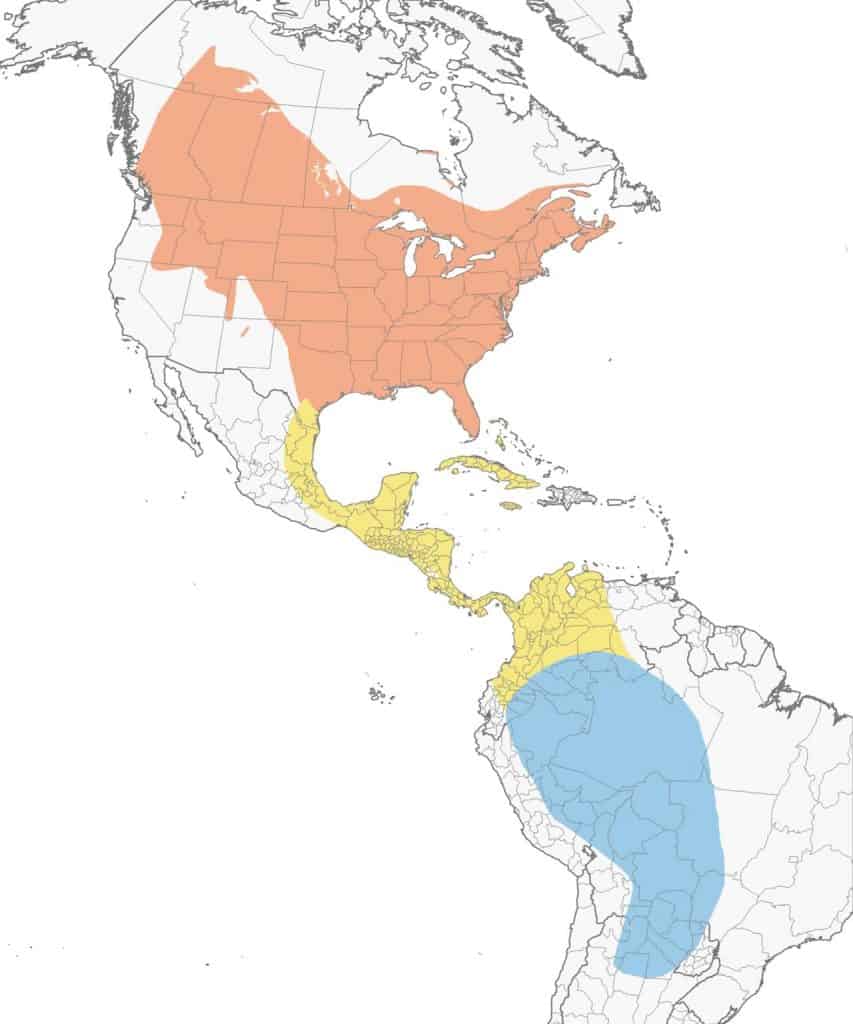
Eastern Meadowlark
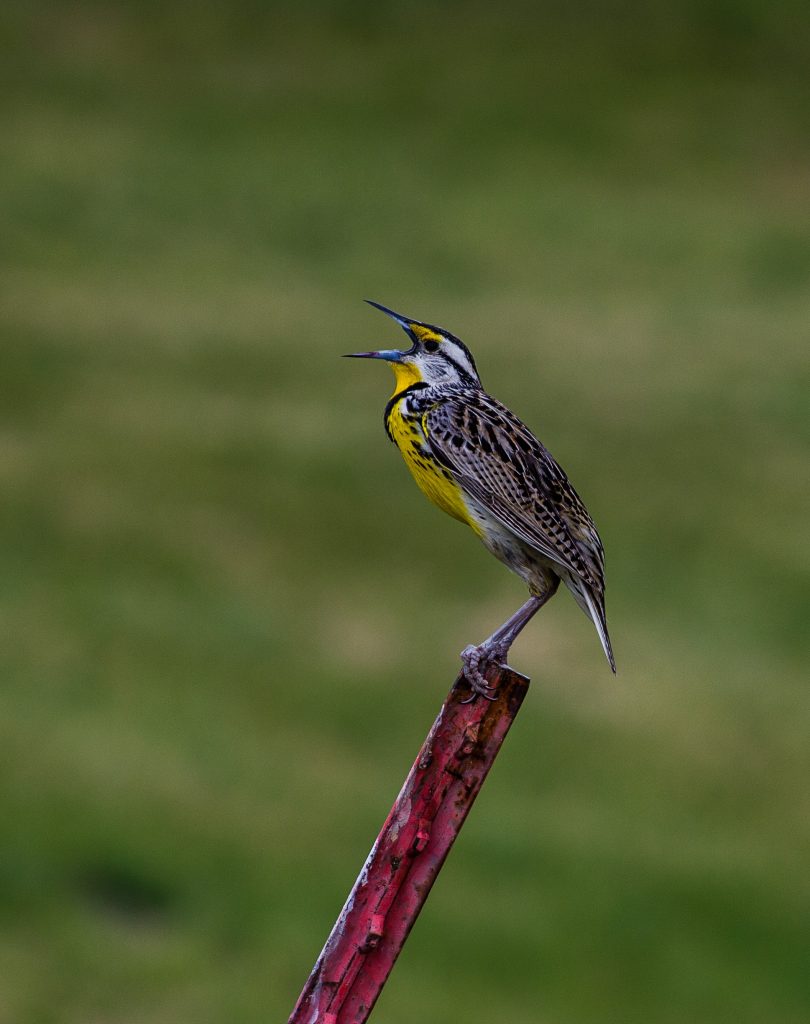
| Appearance | Large bird about 9″ long with brown back, lemon yellow-colored chest, and black v-shape around the neck. White outer tail feathers. Female and male look the same. |
| Diet | Insects and seeds. |
| Feeder Food | Hulled sunflower seeds and cracked corn. |
| Habitat | Open grassy areas. |
| Nesting | Cup-shaped nest on the ground within a dense cover. They have 2 broods/year and 3-5 eggs/brood. Eggs are white with brown markings and incubation lasts 13-15 days. |
Range Map
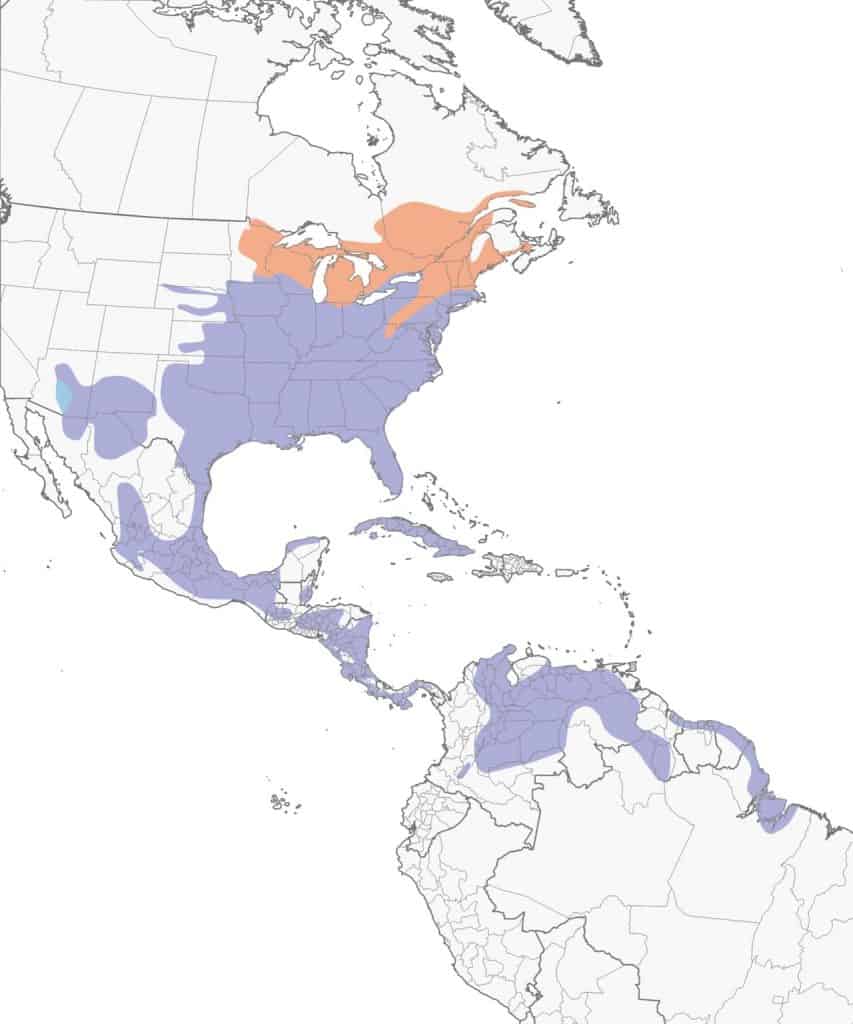
Eastern Towhee
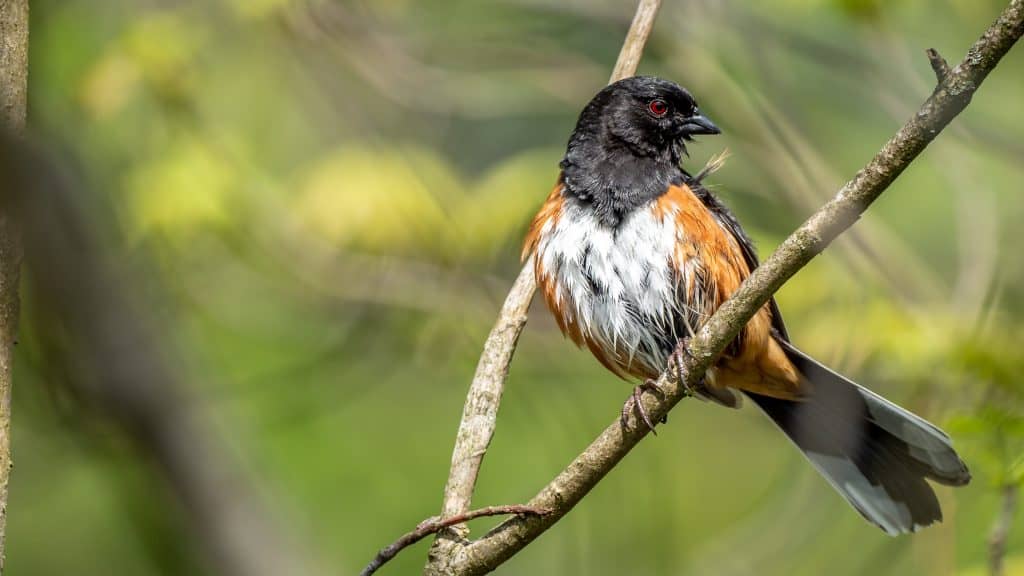
| Appearance | Small-medium-sized bird about 7-8″, mostly charcoal black with rusty-orange on the sides and a white belly. They have a long black tail with a white tip. The bill is short and pointy. They have ruby red eyes. The Female is the same but brown not black. |
| Diet | Insects, seeds, and fruit. |
| Feeder Food | Ground feeder and will eat black-oil sunflower seeds, cracked corn, millet, milo, and peanut hearts. |
| Habitat | Scrubby areas along wooded edges, thick fields, and backyards. |
| Nesting | The cup-shaped nest is typically located on the ground. They have 2 broods/year, and 3-4 eggs/brood. Eggs are ivory with brown spots and incubation lasts 12-13 days. |
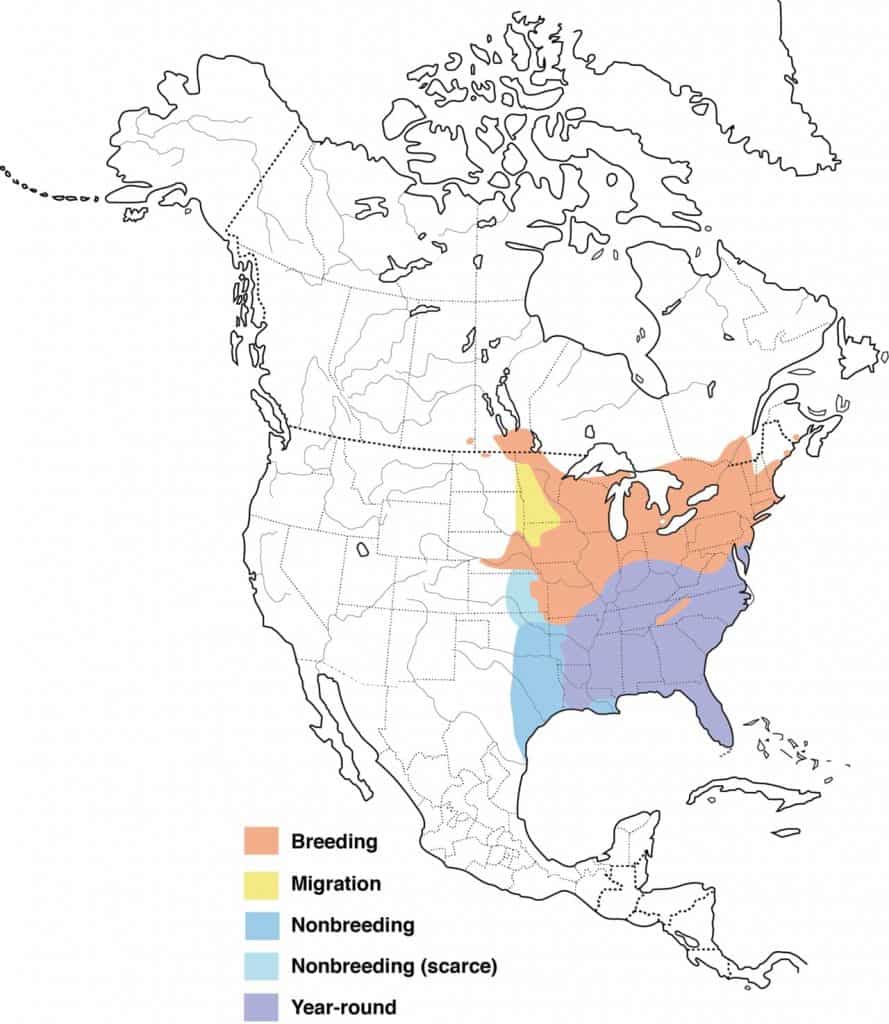
Eurasian Collared-Dove
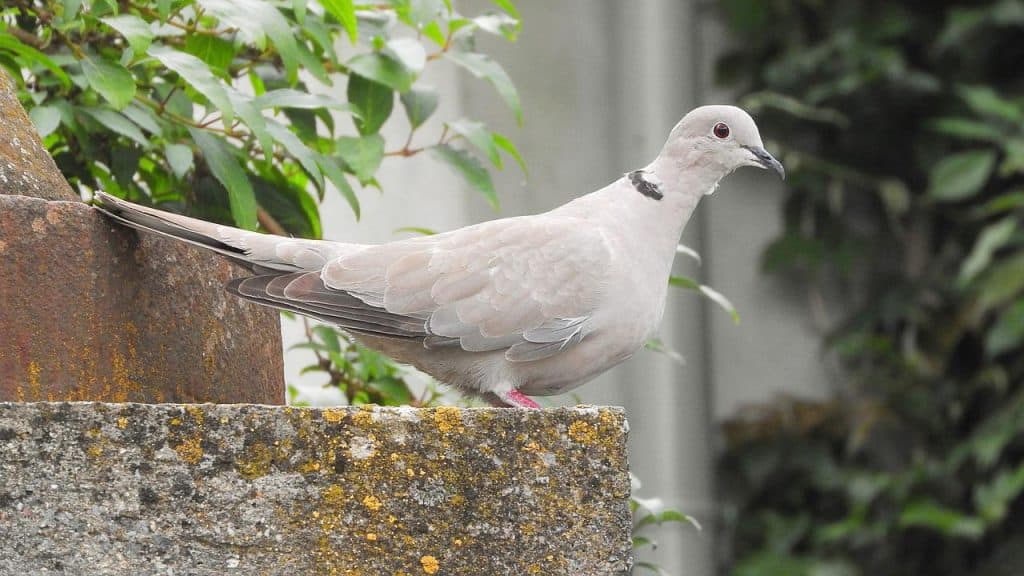
Appearance: The Eurasian collared dove is a large bird about 12 1/2″ long, gray/tan with a black collar on the back of its neck. Eyes are large and black, bill long and slightly curved down. They have a long, squared-off tail with a white tip best seen from underneath.
Diet: Seeds, grain, berries, and insects.
Feeder food: Millet on the ground or platform feeder.
Habitat: They live in towns, suburbs, and farms.
Nesting: They build their flimsy platform nest of twigs and stick then place them in a tree or shrub about 1/2 way up. They have 3-6 broods/season with 1-2 eggs/brood. Eggs are white and slightly glossy. Incubation is for 14-19 days and fledglings leave the nest about 16-20 days after hatching.
Migration: Eurasian-collared doves do not migrate. They remain in their year-round range for all seasons of the year.
Year-round range: The western half of the US, states east and south of Illinois, southern British Columbia, Alberta, and Saskatchewan, as well as Mexico.
Range Map
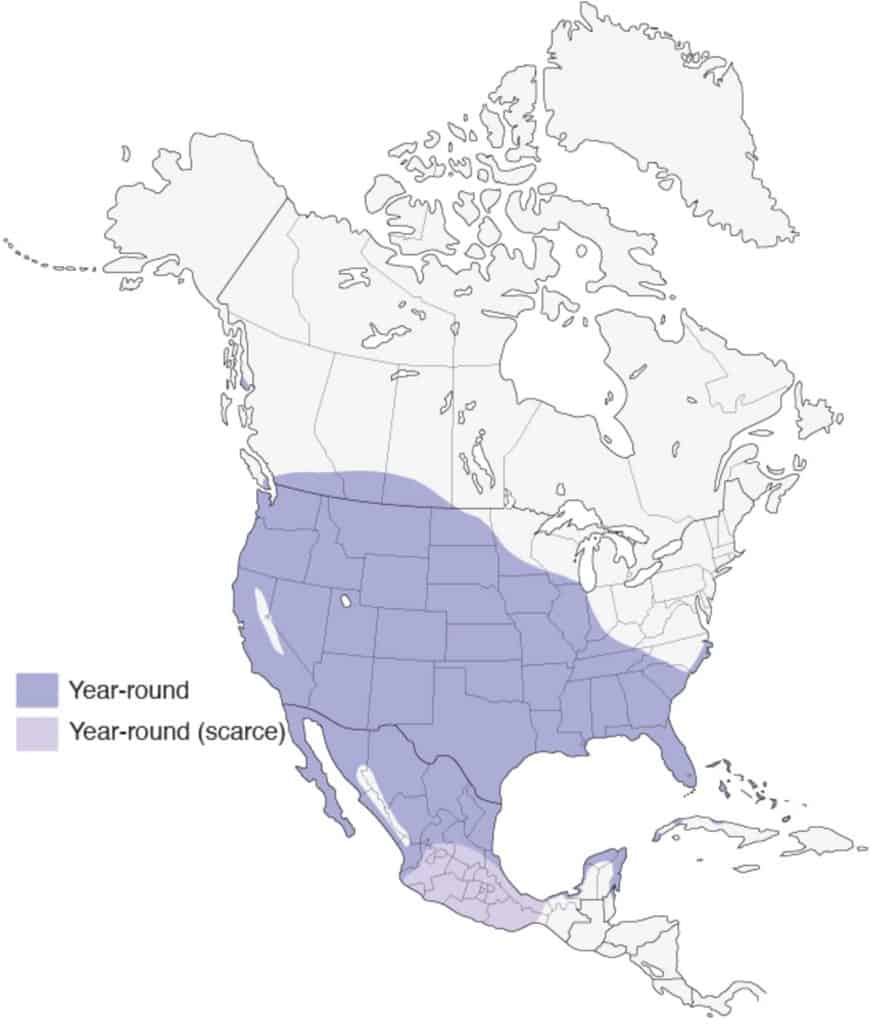
European Starling
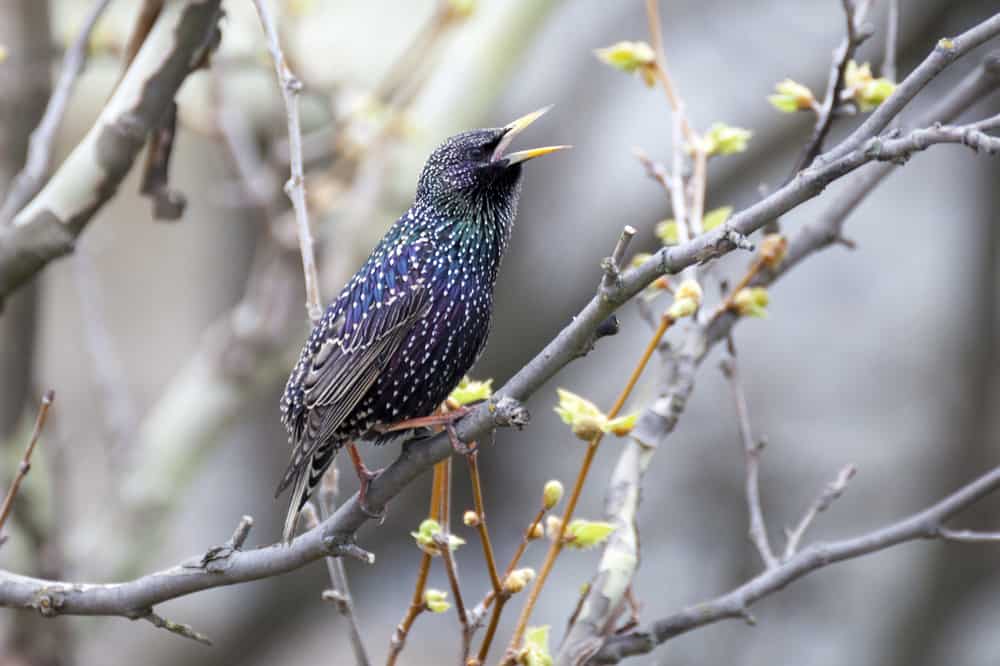
| Appearance | Medium-sized bird about 7 1/2″ long with iridescent shades of purple and black with white speckles throughout. They have a long pointed gray bill in fall and yellow in spring. The tail is short. The Female looks the same. |
| Diet | Insects, seeds, fruit. |
| Feeder Food | Everything and anything you could offer at the feeder. |
| Habitat | Urban and residential areas throughout the US and Canada including backyard lawns, parks, and fields. |
| Nesting | Nest: They are cavity nesters Brood: 2 broods/year. Clutch: 4-6 eggs/brood Egg color: Glossy bluish or a pale green Egg size: 1.1 – 1.3 inches by 0.8 – 0.9 inches Incubation: 12-14 days. |
| Migration | North American European starlings are not migrators. They remain in their year-round range all seasons of the year. That said, some may head further south into Mexico for winter. Year-round range: Every US state and Canadian province, and Mexico. |
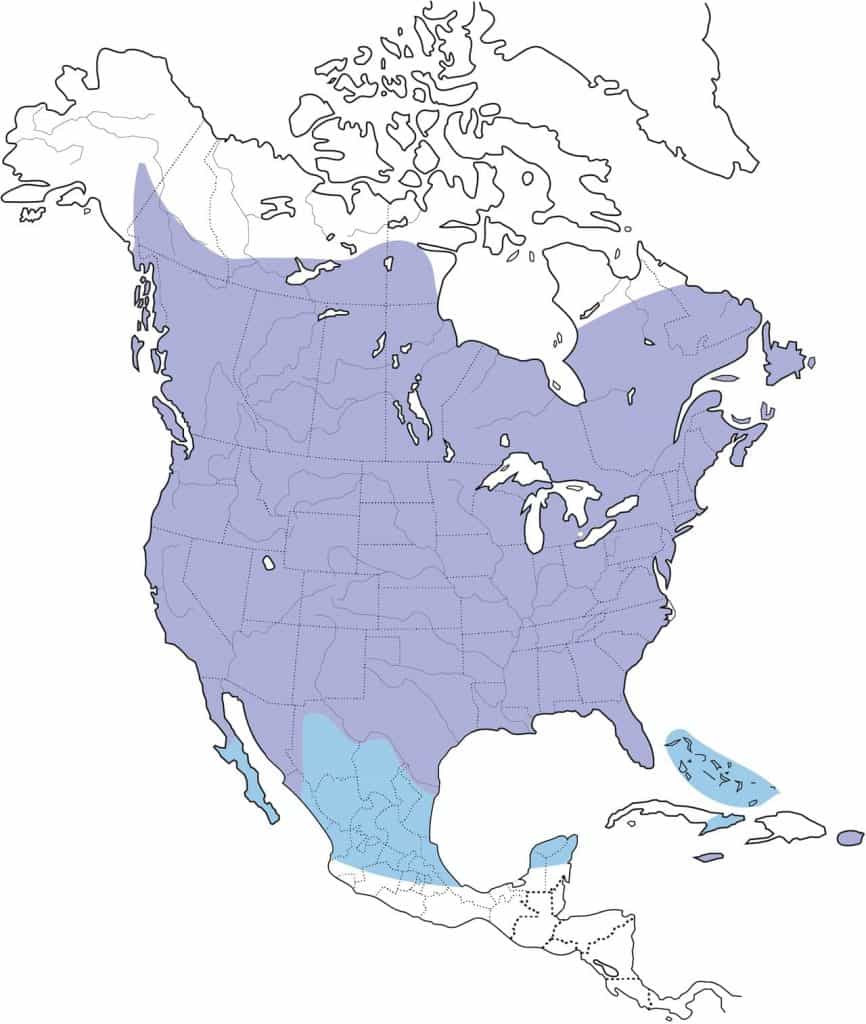
Field Sparrow
| Appearance | Small bird about 5 1/4″ long with muted coloring throughout. Gray face with a bright white eye ring, a rusty patch behind the eye, and a rusty crown. Underparts are gray with tan on the breast and sides. The short but stout bill is pink. The Female is similar but does not have a patch behind the eye, the crown is more muted, and the belly has light brown streaks. |
| Diet | Insects and small seeds. |
| Feeder Food | Hulled sunflower seeds, millet, and cracked corn when scattered under the feeder. |
| Habitat | Brushy woodlands with clearings and fields of tall grasses. |
| Nesting | Cup-shaped nest low in a shrub or on the ground. 3-5 eggs incubated for about 10-12 days. |
Range Map
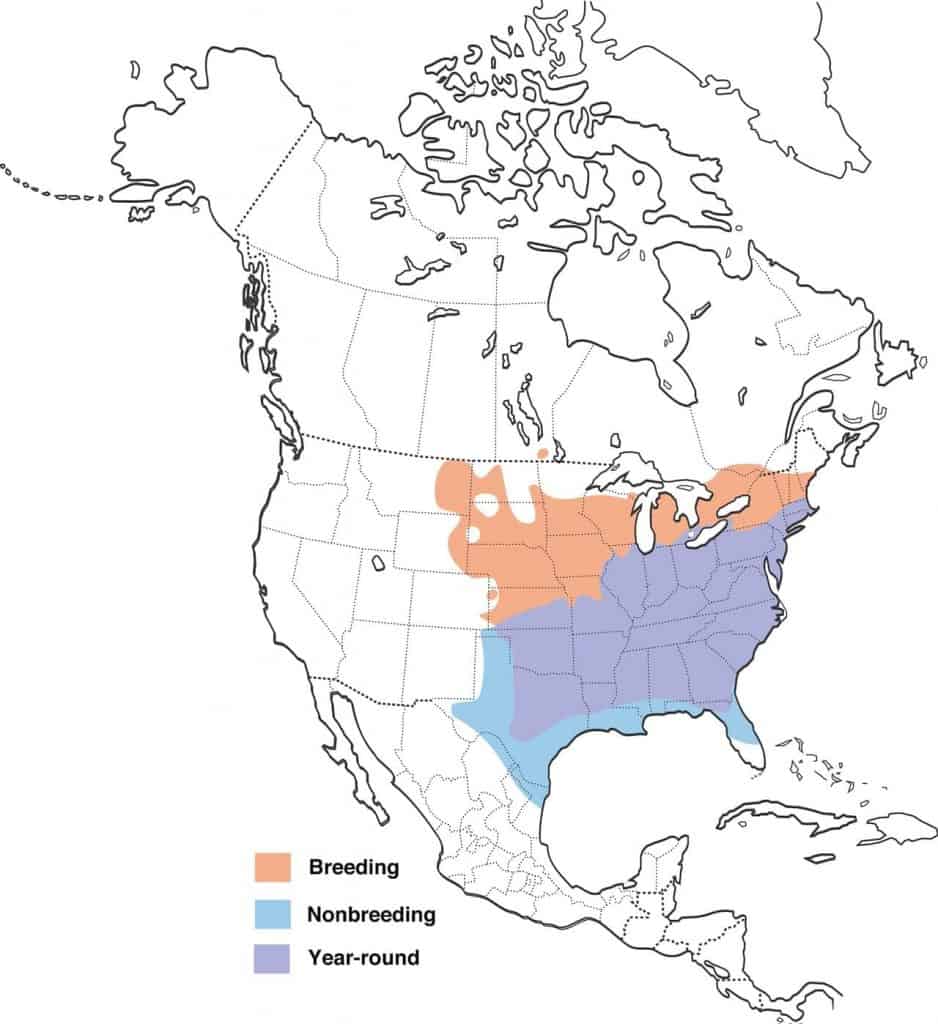
Fish Crow
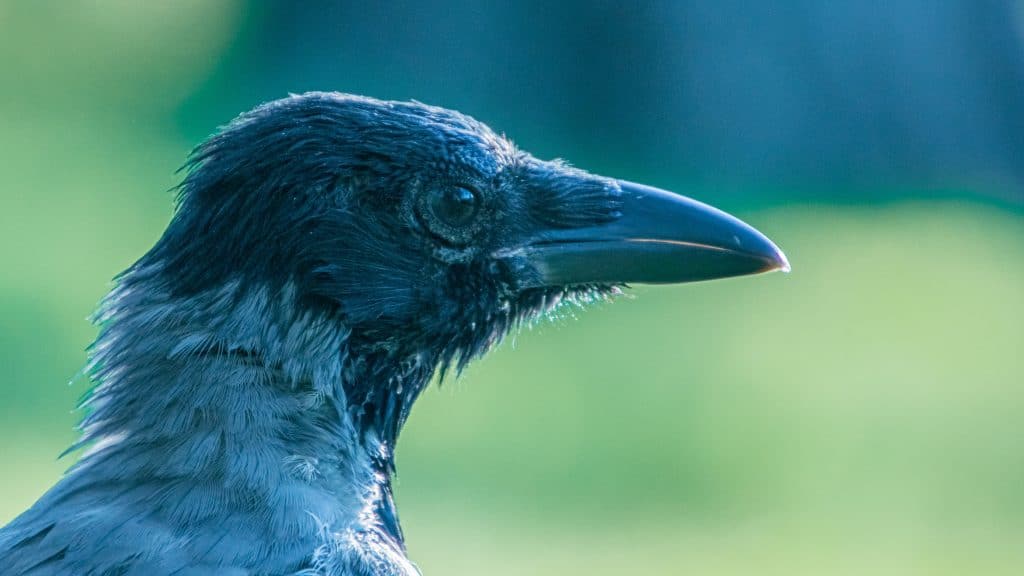
| Appearance | The fish crow is a large bird about 15″ long. They’re all black with stocky legs and thick bills. |
| Diet | This bird is not a picky eater. They’ll dine on insects, shrimp, crayfish, crabs, bird eggs, nestling birds, carrion, garbage, grain, seeds, and fruit. |
| Feeder Food | Unlikely to visit a feeder. |
| Habitat | Coastal and inland water areas. Also, live in cities and suburbs. |
| Nesting | Fish crows build a bulky basket of sticks, twigs, and grass and place high in a tree – as high as 80′ up. They have 1 brood/season and 4-5 eggs/brood. The eggs are light blue/green with spots. Incubation is for 16-19 days and fledglings leave the nest at 32-40 days after hatching. |
Range Map
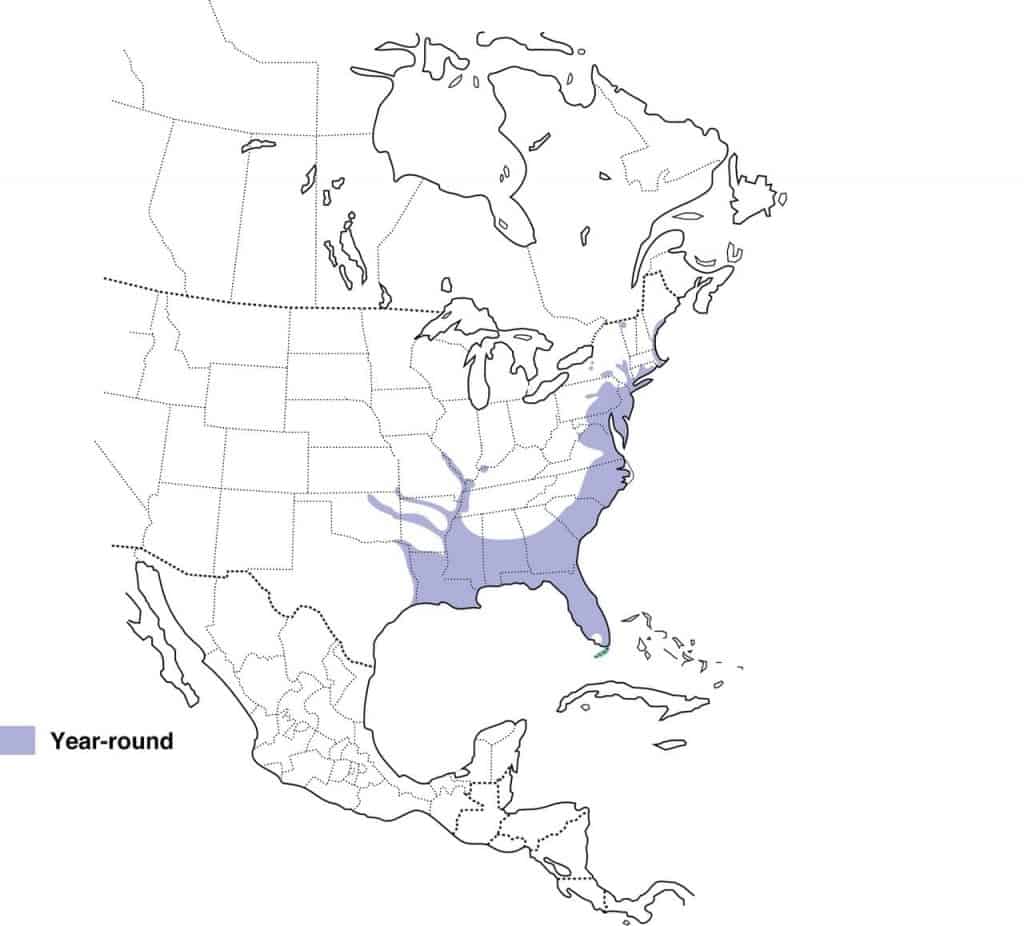
Florida Scrub-Jay
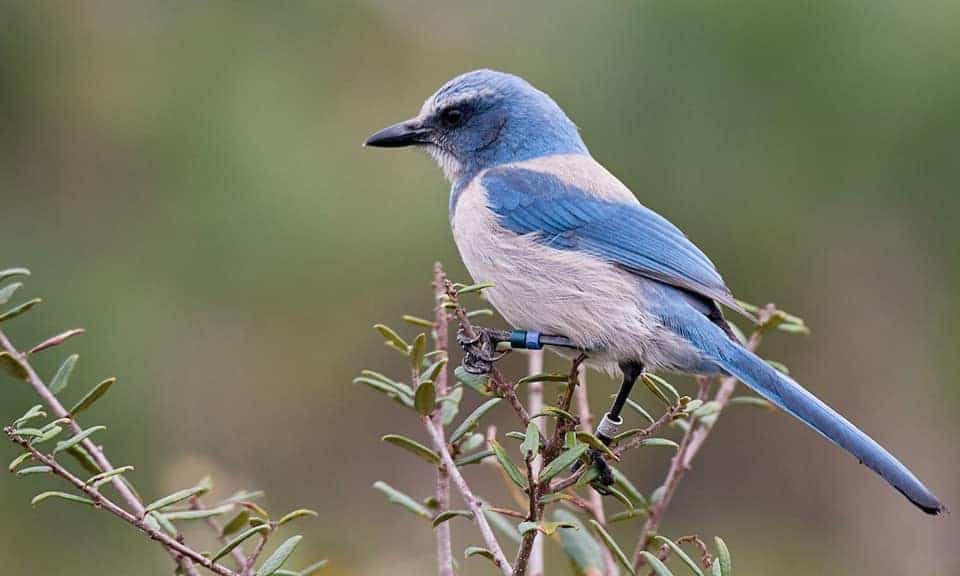
| Appearance | About 10″ long, large blue bird, light gray back and belly, swipes of white through forehead, and very long tail. Female is similar. |
| Diet | Varied diet of insects, nuts (especially acorns), berries, small snakes, mice, and lizards. |
| Feeder Food | Whole peanuts. |
| Habitat | Low-growing scrub oak exclusively in Florida. |
| Nesting | Cup-shaped nest of twigs and fibers located at the edges of scrubbed areas. 1-2 broods/season, 1-6 eggs/brood, eggs are about 1″ long, green with brown spots, 16-21 day incubation and young fledge at about 12-25 days. |
Range Map
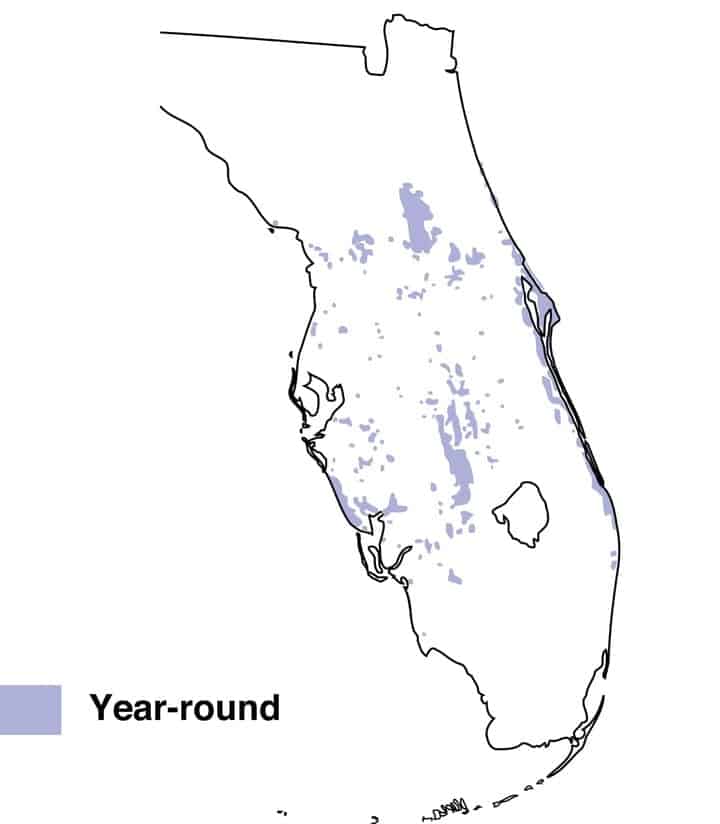
Fox Sparrow
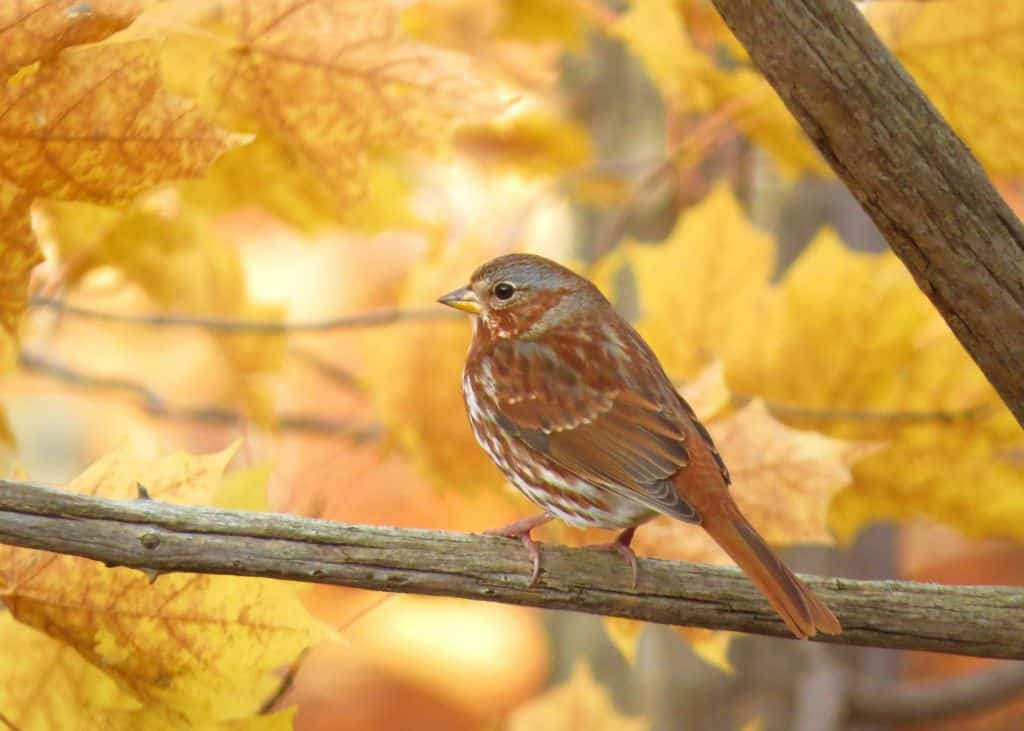
| Appearance | The fox sparrow is a medium-sized bird about 7 1/2″ long with rusty-red color. It has a heavy streaking of rust color on its breast and tail. The head and back are shades of gray. The female looks like the male. |
| Diet | Insects and seeds. |
| Feeder Food | Black-oil sunflower seed, hulled sunflower seed, nyjer, cracked corn, millet, and milo. |
| Habitat | Scrubby areas with thick vegetation. |
| Nesting | A cup-shaped nest. They have 2 broods/season with 2-4 pale green eggs with reddish spots, per brood. Incubation is for 12-14 days. |
Range Map

Golden-Crowned Kinglet
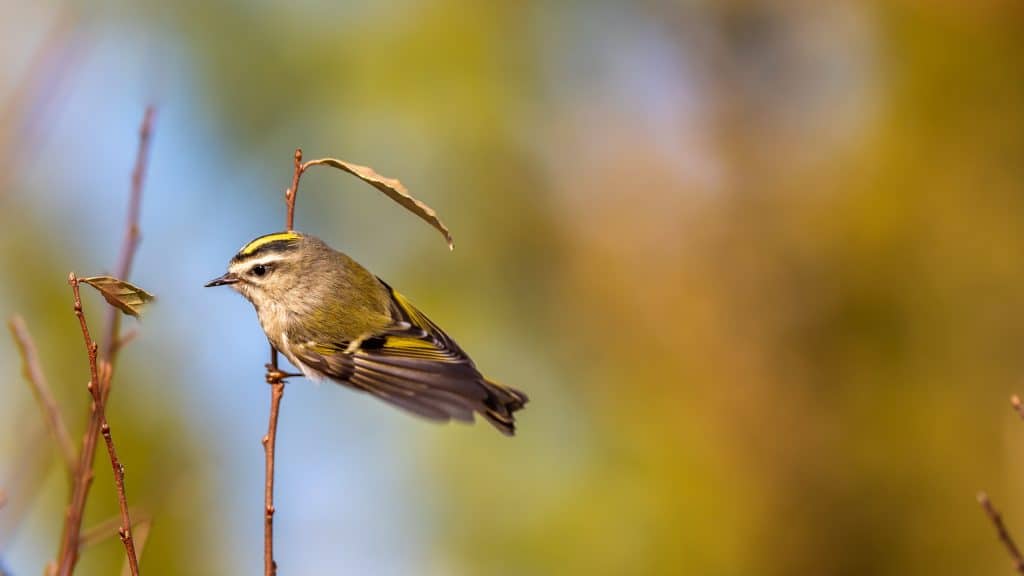
Appearance: Golden-crowned kinglets are small birds about 4″ long, olive-green in color with crowns striped with reddish/orange and white stripes above & below the eyes. Females are the same except for their crowns are yellow instead
Diet: Insects and spiders.
Feeder food: Suet.
Habitat: In their year-round area, they generally inhabit mountainous regions with abundant coniferous trees. They nest in mixed forested areas and within small groups of trees with minimal or no undergrowth.
Nesting: The golden-crowned kinglet builds a 3″x3″ cup-shaped, deep nest and places it at the intersection of several branches. They have 1-2 broods/season and 7-8 eggs/brood that are white/cream colored with specks of brown or lavender. Incubation lasts 15 days.
Migration: Golden-crowned kinglets are migrators. While many remain in their year-round range every season of the year, others migrate. The migrators head north into Canada, northern Minnesota, Michigan & Wisconsin for breeding in springtime then head south to the rest of the US for winter months.
Year-round range: Pacific coast of Alaska, British Columbia, Washington, Oregon, California, Idaho, eastern Oregon, western Montana, Utah, Colorado, Arizona, New Mexico, New England, and Mexico.
Breeding range: Canada (except Nunavut), southeast Alaska, northern Minnesota, Michigan & Wisconsin.
Winter range: All US states, southern Alberta, Saskatchewan, Manitoba, and the northern part of Mexico.
Range Map
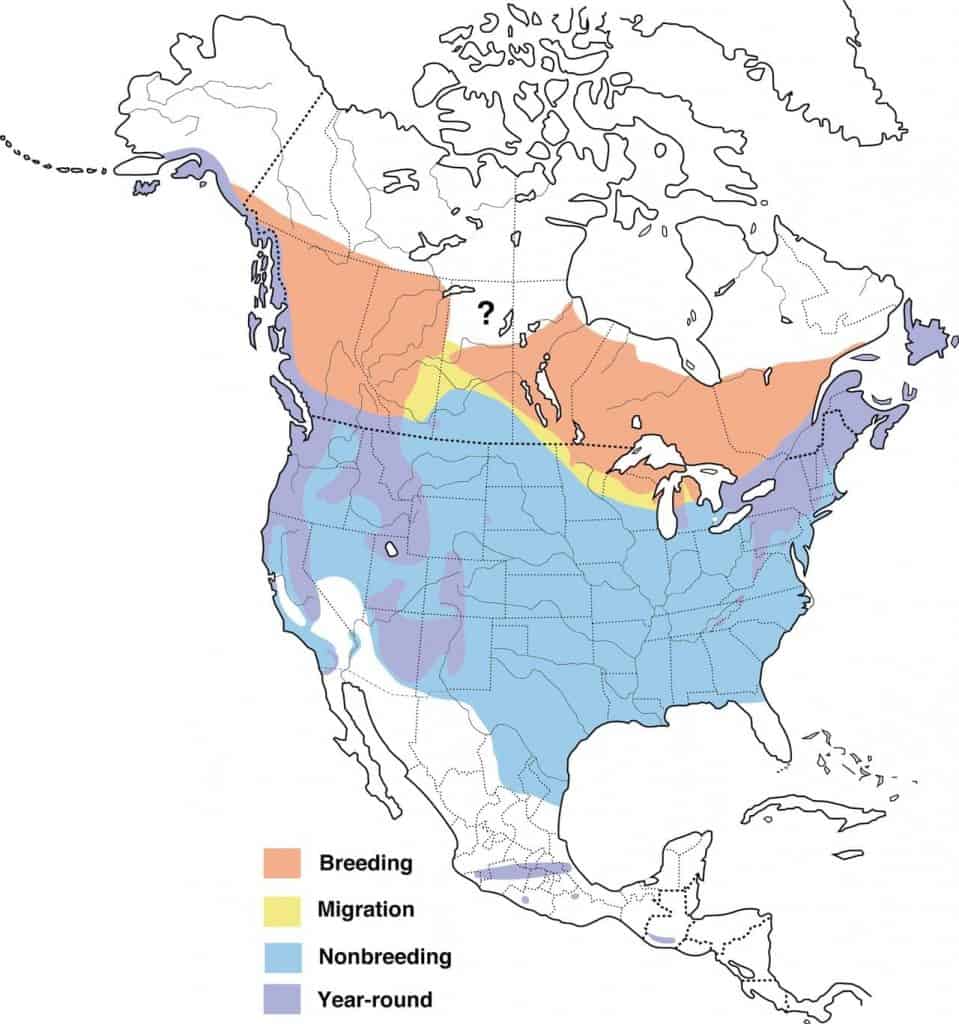
Golden-Winged Warbler
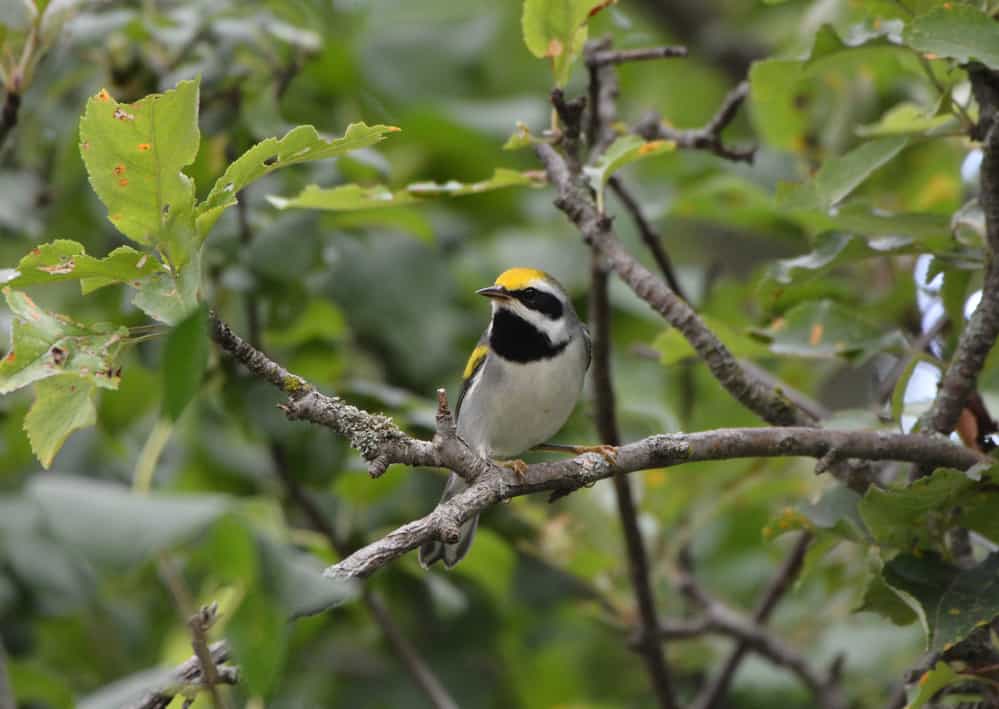
| Appearance | A small bird about 5″ long with a short tail and thin & pointy bill. They are silvery gray with a black mask and throat. A bright yellow crown and stripe of yellow on the upper wings. The female is similar with a green-yellow crown and dark gray throat & mask instead |
| Diet | Insects |
| Feeder Food | Unlikely to visit a feeder. |
| Habitat | During breeding, they can be found in shrubby open areas. Otherwise, the forest is their primary habitat. |
| Nesting | The nesting site is on the ground. They have 1 brood/year, 3-6 eggs/brood, eggs are ivory or pale pink with tiny spots. Incubation is from 10-12 days. |
Range Map
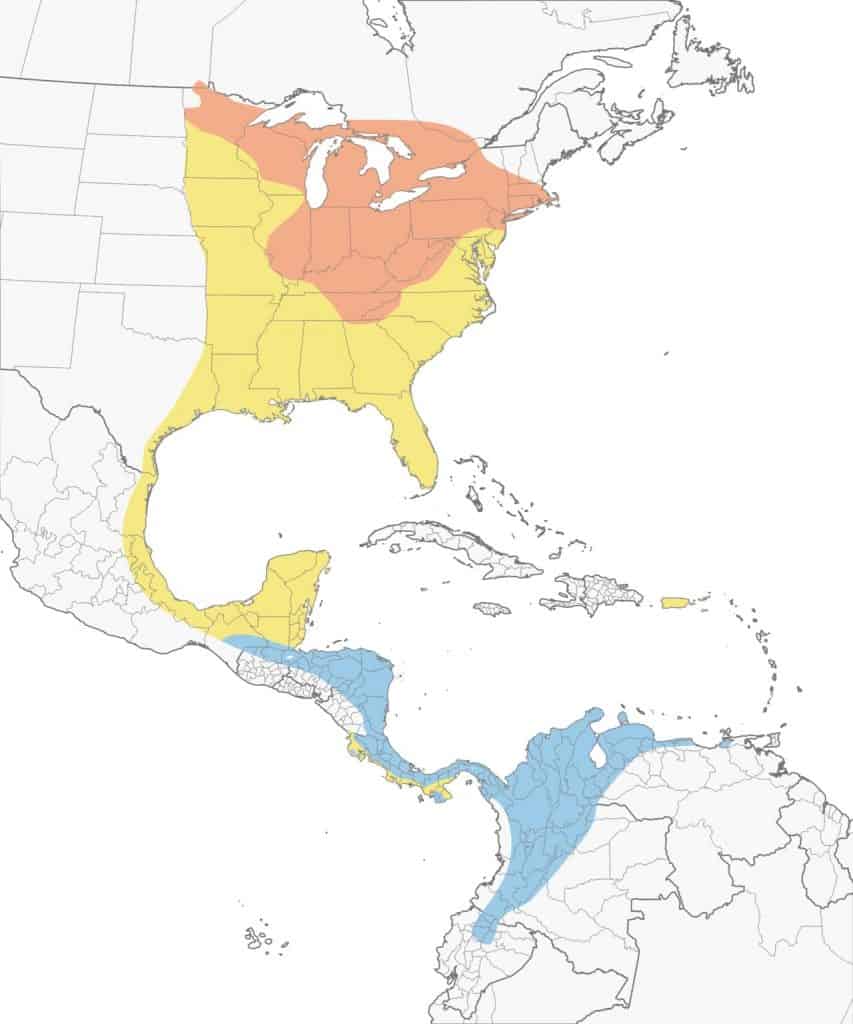
Gray Catbird
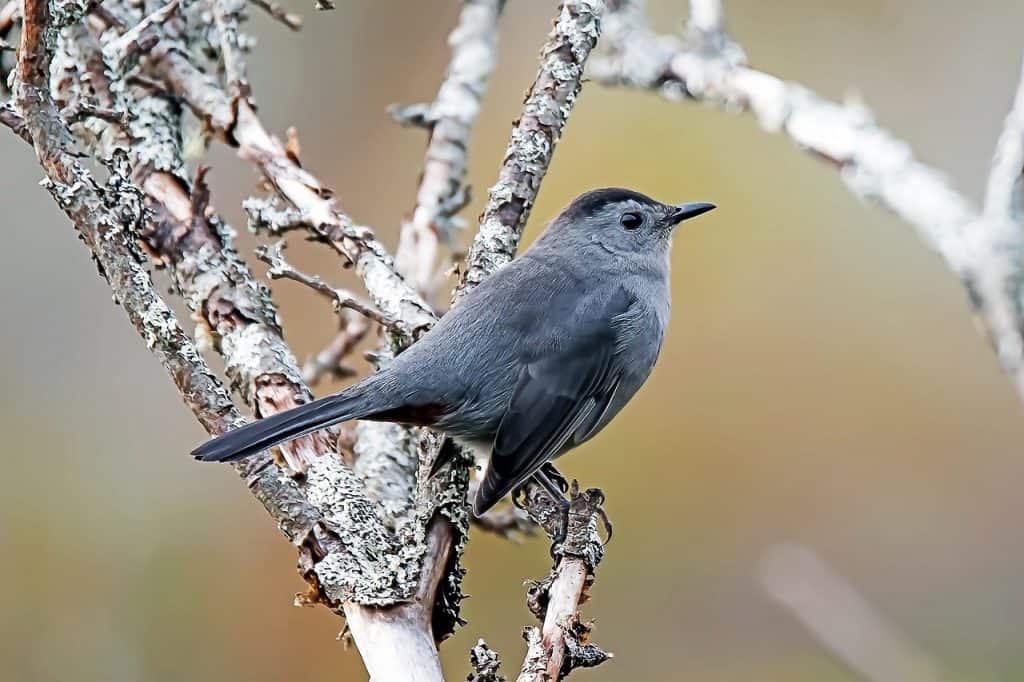
| Appearance | Medium-sized bird about 9″ long. Slate gray with a black crown and dark eyes. Bill is long, thin, and black. Usually concealed, a chestnut patch is under the tail. The female is the same. |
| Diet | Insects and fruit. |
| Feeder Food | Unlikely to visit a feeder. |
| Habitat | Open woodlands. |
| Nesting | Nest: The nest is cup-sized. Broods: 2 broods/year, Clutch: 4-6 eggs/brood Egg color: Bright, turquoise-green sometimes with fine, red spots or no markings. Egg size: 1 inch by 0.5 inches Incubation:12-13 days |
Range Map
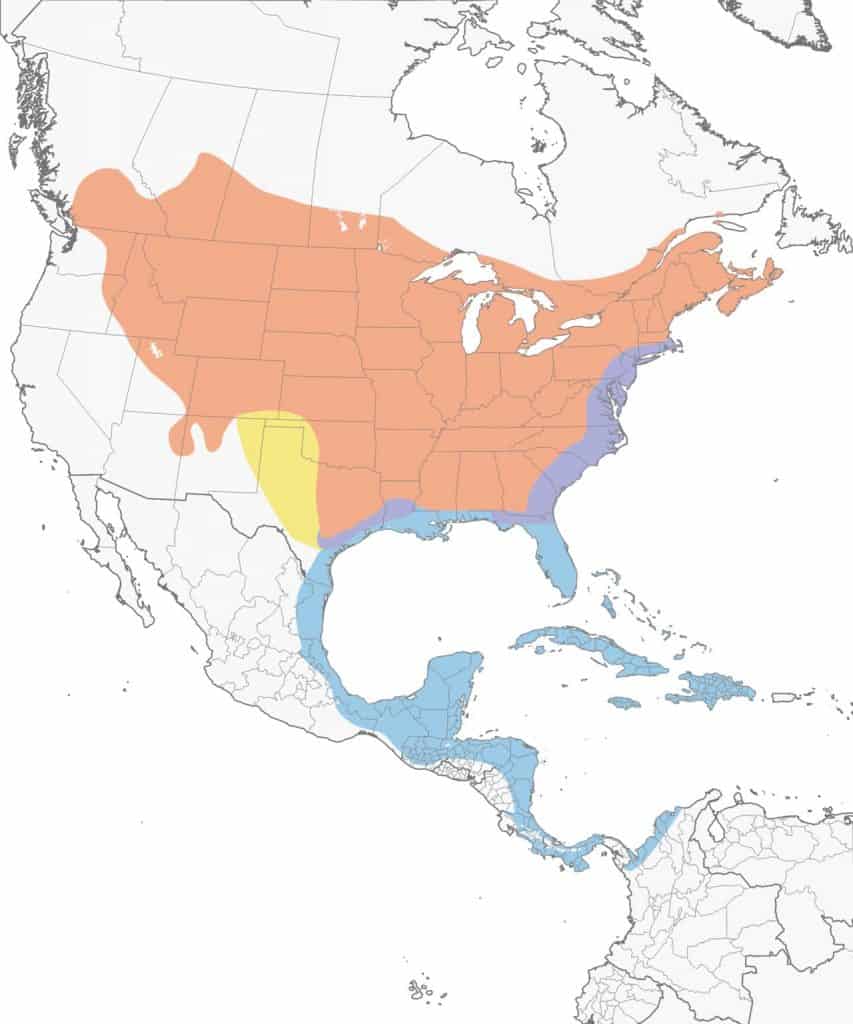
Great Black-Backed Gull
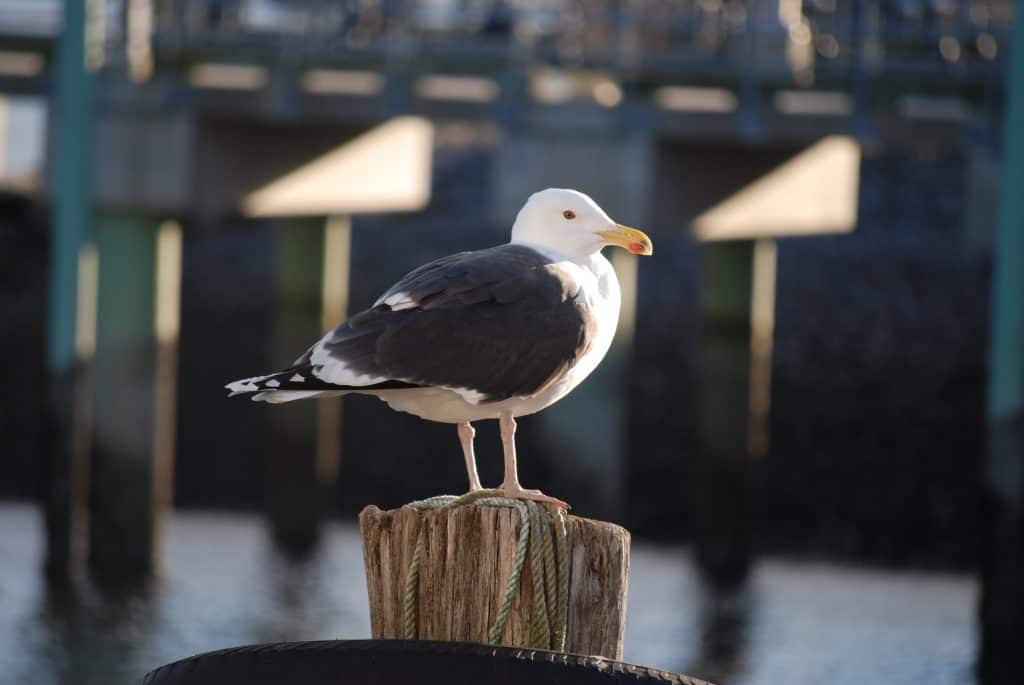
Appearance: The Great black-backed gull is the largest gull in the world at about 28-32″ long. They’re white with black upper wings and backs. The bill is yellow with a small red spot at the tip. Eyes are dark, legs pink, and white under the wings. The female looks the same.
Diet: They eat water prey such as fish, crabs, mussels, marine invertebrates, and other birds. They’re also scavengers so have no problem dining on dead fish, carrion, and human garbage.
Feeder food: They don’t visit feeders.
Habitat: Great black-backed gulls live along the Atlantic coast from Canada to Florida as well as inland surrounding the Great Lake.
Nesting: They have 1 brood/season and 2-3 light yellow/green eggs – often with spots. Incubation lasts 30-32 days and nestlings are ready to fledge after 1 day.
Range Map
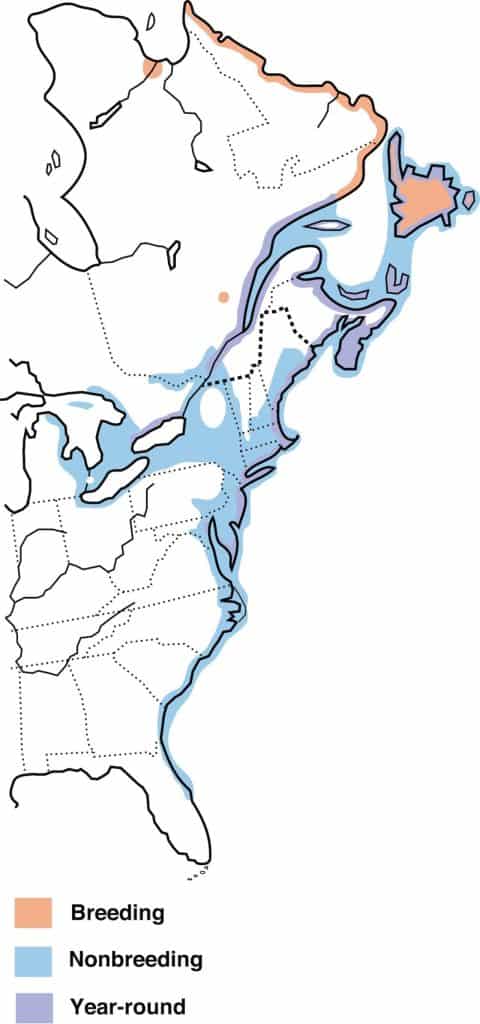
Great Blue Heron
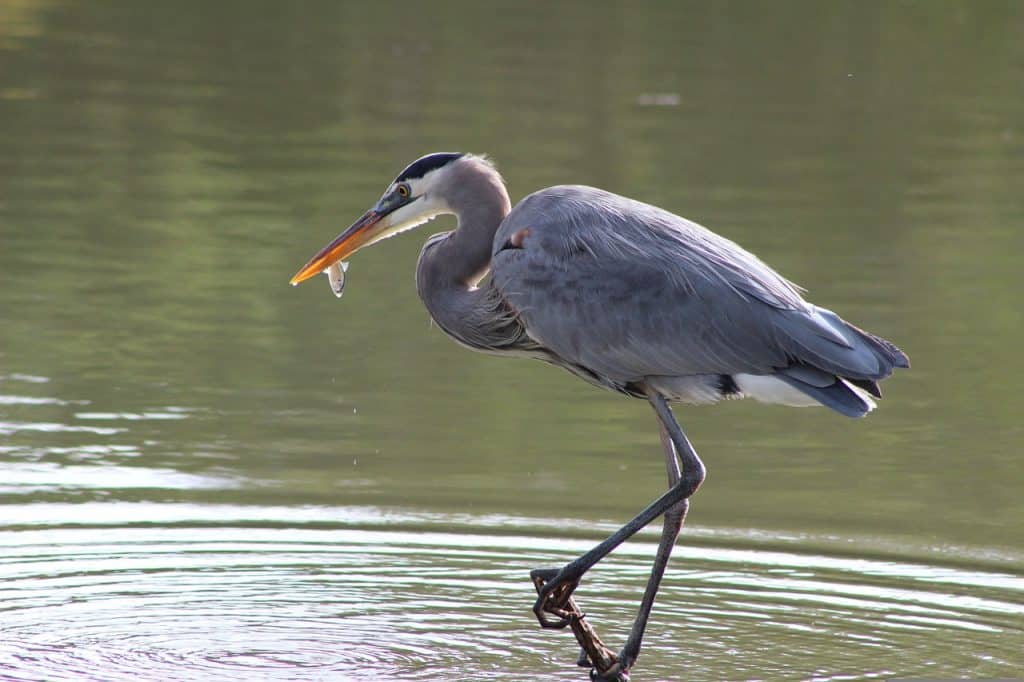
| Appearance | Great blue herons are enormous waterbirds about 45-55″ long. They have a large body with blue/gray feathers, long legs, a white face with a black streak on the cheek and crown, a long pointy orange bill, and a curvy neck which they often curl into the shape of an “S”. |
| Diet | Fish, frogs, salamanders, turtles, snakes, insects, small mammals, and birds. |
| Feeder Food | They don’t visit feeders. |
| Habitat | The Great Blue Heron is a highly adaptable bird evidenced in its wide year-round range that spans much of the US and British Columbia coast. They prefer calm freshwaters, rivers, and shallow coastal areas. |
| Nesting | Nest: A large, round platform-style nest is weaved by the female from sticks collected by the male and lined with pine needles, moss, grass, and other soft materials and placed on the ground. Brood: 1 – 2 broods/year Clutch: 2 – 6 eggs/brood Egg color: They lay large eggs ranging from pale blue to white. The lighter the color, the older the egg is. If you see near white eggs, they are close to hatching. Egg size: 2.4 – 3 inches by 2 inches Incubation: Both parents incubate the eggs for about 25-30 days. |
Range Map
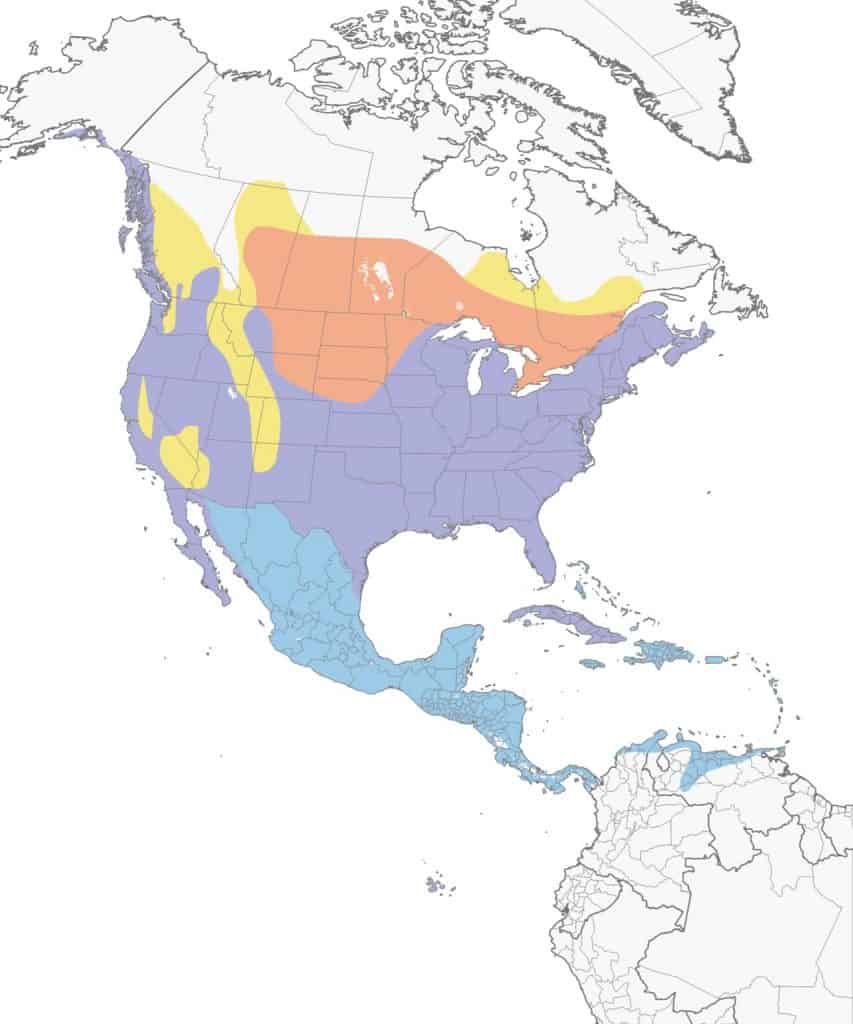
Great Crested Flycatcher
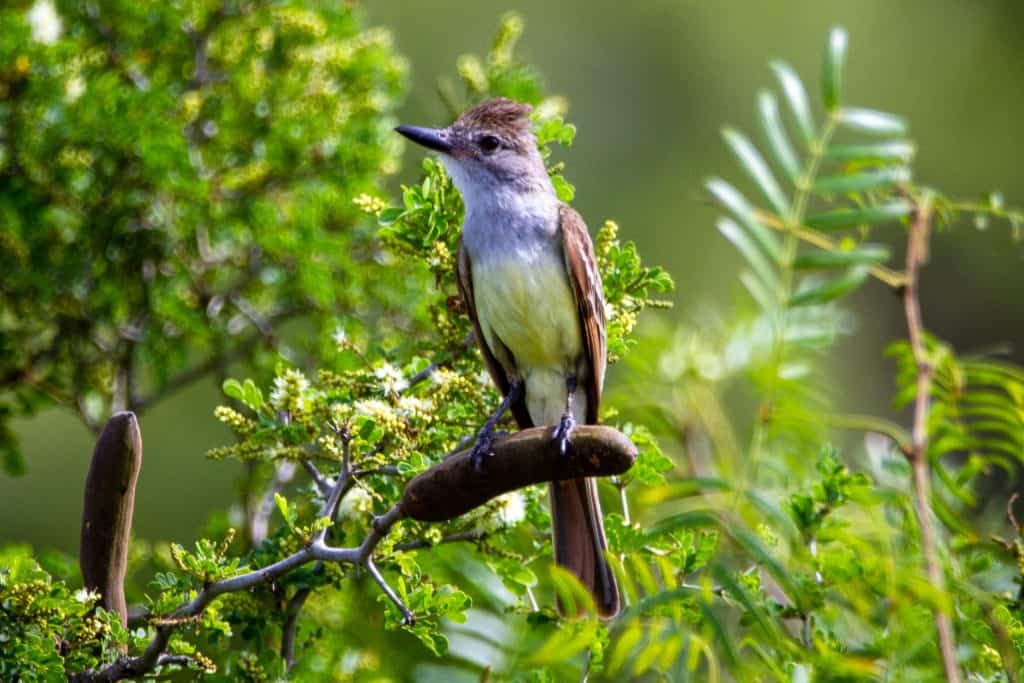
| Appearance | A medium-sized bird about 8 1/2″ long with dark olive-brown underparts, gray throat & breast, and lemon yellow belly. It has a small crest and long pointy bill. |
| Diet | Insects and small wild fruits. |
| Feeder Food | They do not visit feeders. |
| Habitat | Open deciduous forested areas. |
| Nesting | They build a bulky nest inside an old woodpecker hole or natural cavity. They have 4-8 eggs/brood that are ivory to light pink with brownish-purple spots. Incubation is 13-15 days. |
Range Map
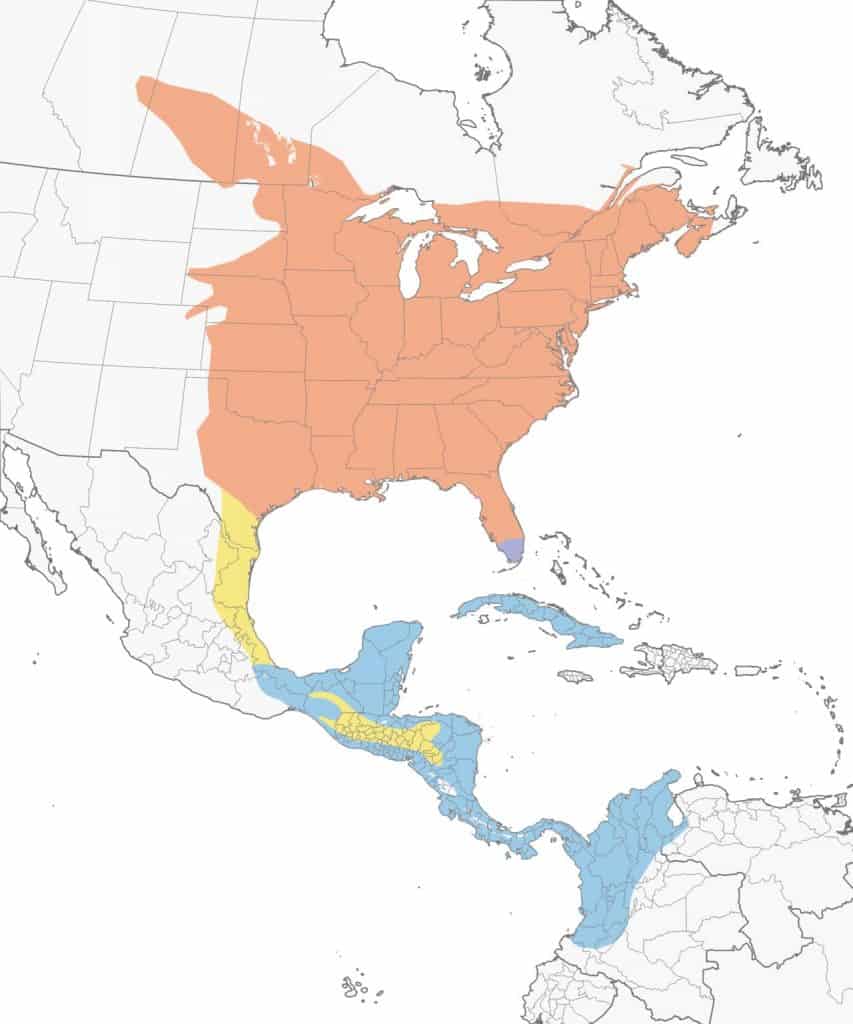
Green Heron
| Appearance | Large bird about 16-22″ long. They have a blue-green back, rusty red neck, and chest. The crest is dark green. Legs are normally yellow but turn bright orange during the breeding season. Female appearance is the same as the male. |
| Diet | Fish, insects, aquatic plants. |
| Feeder Food | They do not visit feeders. |
| Habitat | Wetlands include swamps, marshes, lakes, rivers, ponds, along the coast, etc. |
| Nesting | They build a platform-style nest and have 2 broods/year. 2-4 eggs/brood that are light green with no markings. Incubation is 21-25 days. |
Range Map
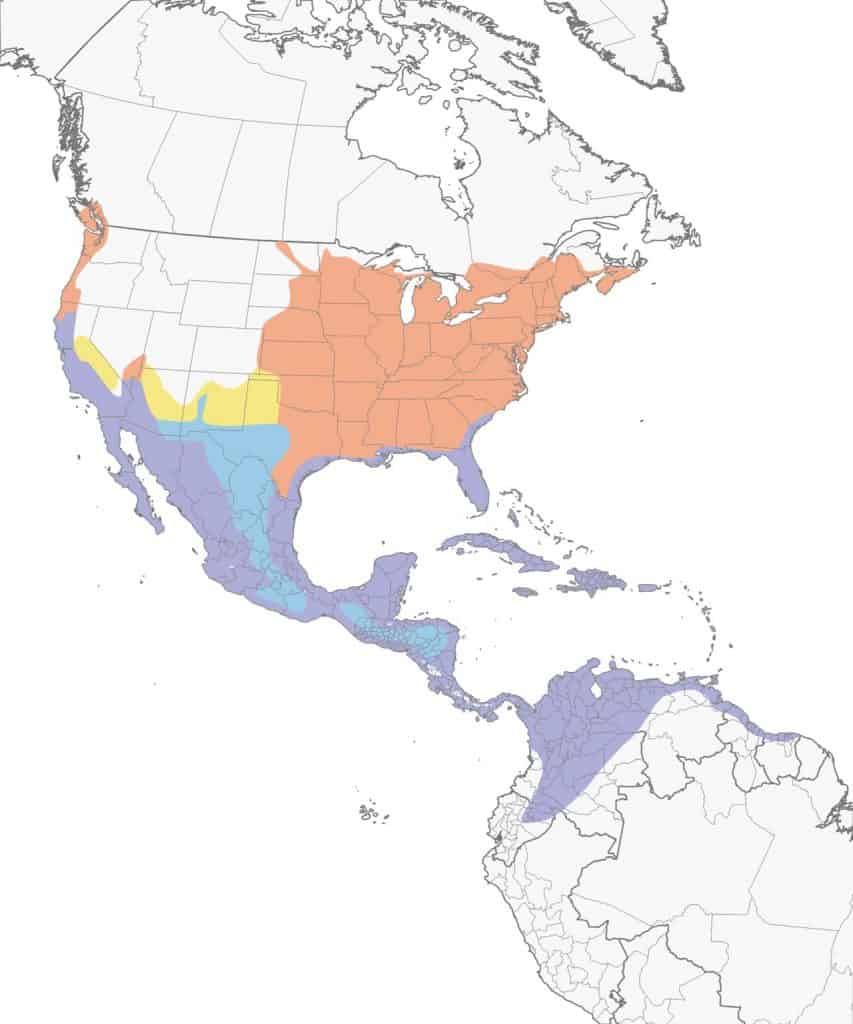
Hairy Woodpecker
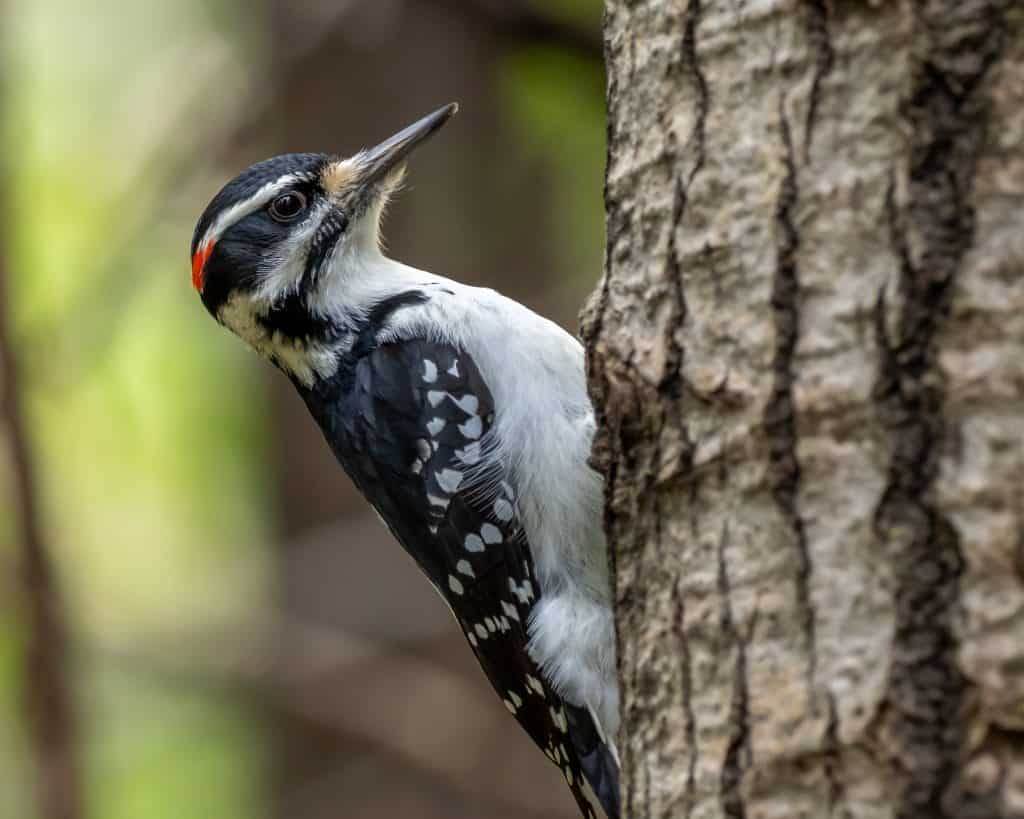
Appearance: A medium-sized black-and-white bird about 9″ long with a white belly, and black wings with white spots. A white stripe runs down the back. They have a red mark on the back of the head and a long black bill. The Female is the same except with no red mar
Diet: Insects, seeds, nuts.
Feeder food: Suet, hulled peanuts.
Habitat: Mature forested areas, urban and suburban areas where dense trees are found.
Nesting: They are cavity nesters generally excavating their own holes. They have 1 brood/year, and 3-6 white eggs per brood. Incubation is 11-15 days.
Migration: Hairy woodpeckers are not migrators. They remain in their year-round range all seasons of the year.
Year-round range: All US states, every Canadian province except Nunavut, Mexico, and Central America.
Range Map
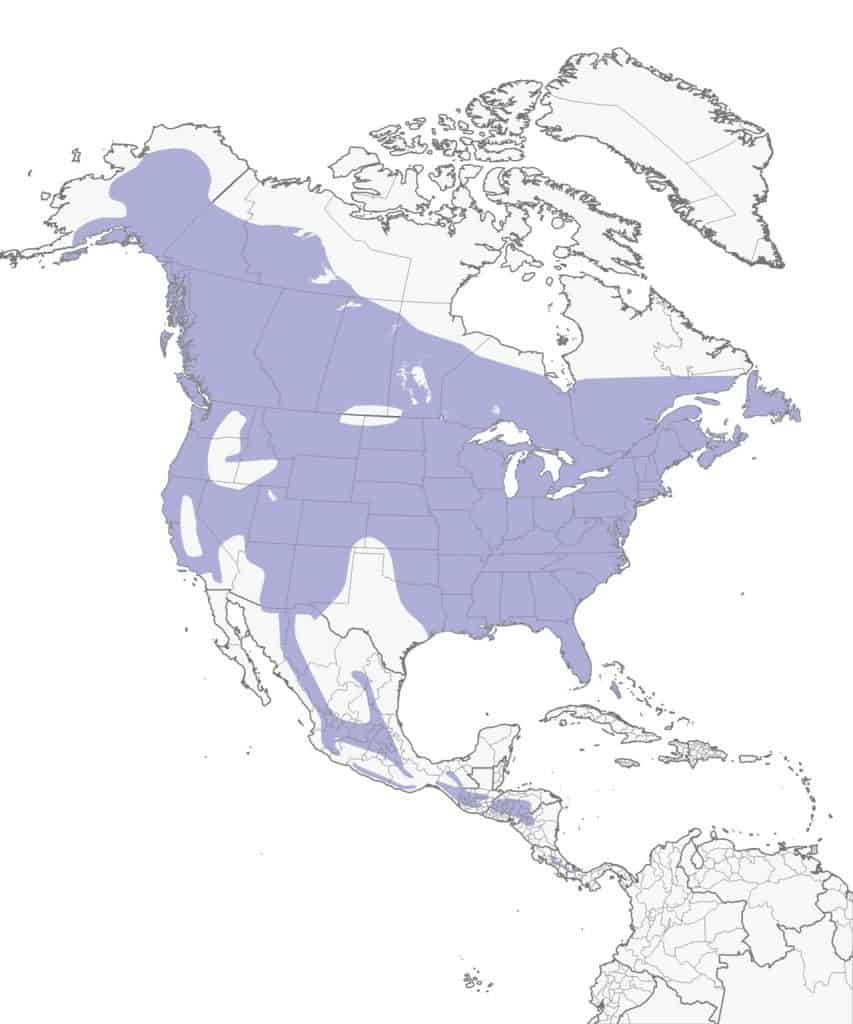
Hermit Thrush
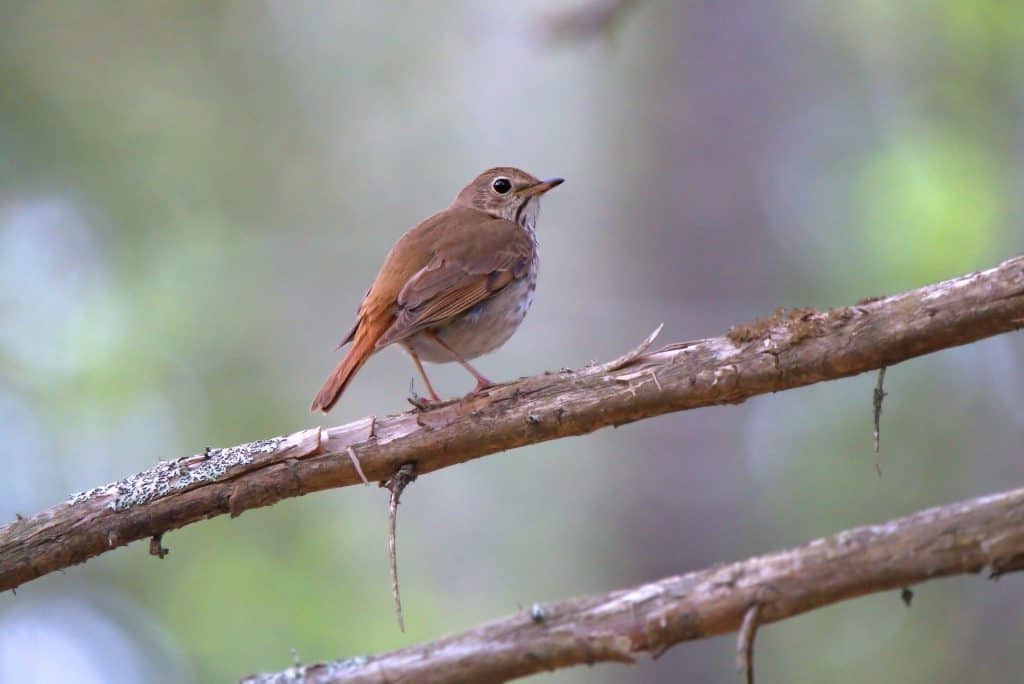
Appearance: The Hermit thrush is about 7″ long. In the east, they’re rich brown with brown flanks (belly area below the wing). In the west, they’re gray/brown with gray flanks. They have a cinnamon-colored tail, dark round eyes with a white eye-ring, and tan breasts with dark spots.
Diet: Insects and fruit.
Feeder food: Unlikely to visit a feeder.
Habitat: Forested areas that are rich with coniferous and hardwood trees.
Nesting: They build a cup-shaped nest made of grass and placed it on the ground. They have 1-2 broods/season, usually, 4 eggs/brood, and the eggs are light blue – sometimes with brown spots. Incubation is for 12-13 days and fledglings leave the nest about 12-13 days after hatching.
Migration: Hermit thrushes are migrators. In spring they head north to the western US states as well as Canada to breed and raise their young. Then in the fall, they migrate south to the southern part of the US, along the pacific coast, and Mexico for the winter. There are a few small patches throughout the US where populations of Hermit thrushes remain year-round.
Year-round range: Northern and central east California, western Nevada, southern Arizona, southern New Mexico, Virginia, and Pennsylvania.
Breeding range: Northern Washington, Idaho, western Montana, Wyoming, eastern California, Nevada, Utah, Colorado, New Mexico, New England, Alaska, and the Canadian provinces (except Nunavut),
Winter range: Pacific coast, southern Arizona, southeastern New Mexico, Texas, Oklahoma and states east of there.
Range Map
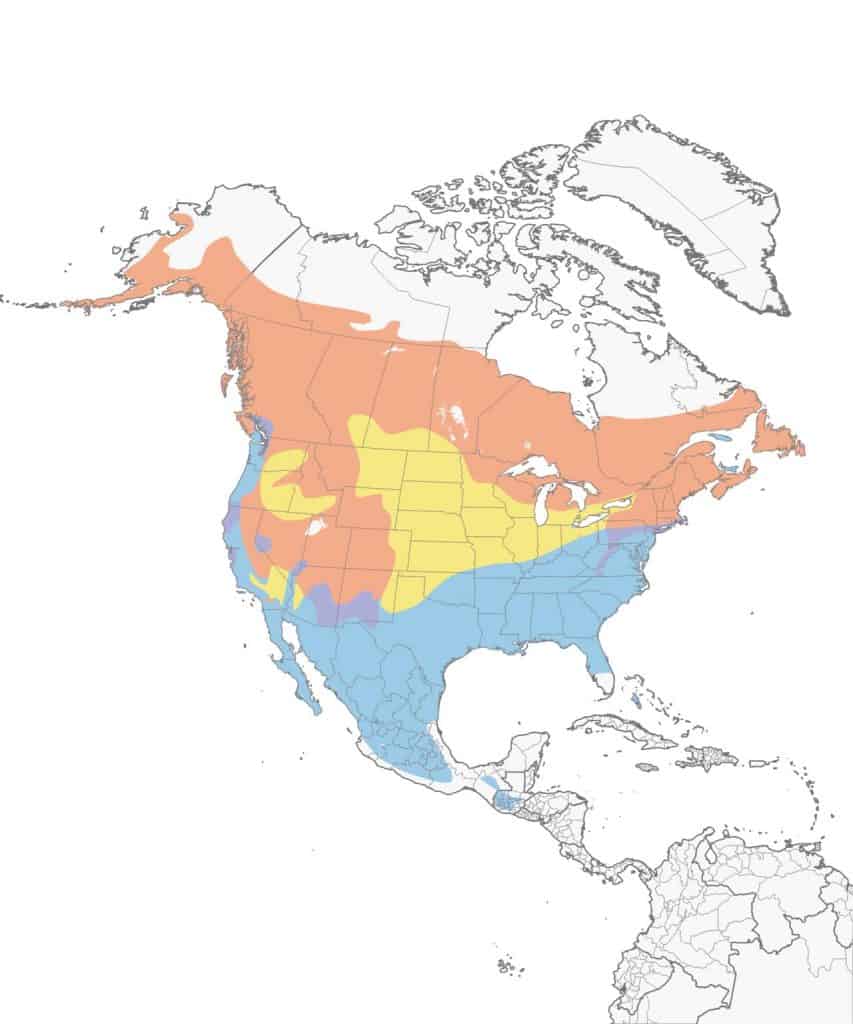
Herring Gull
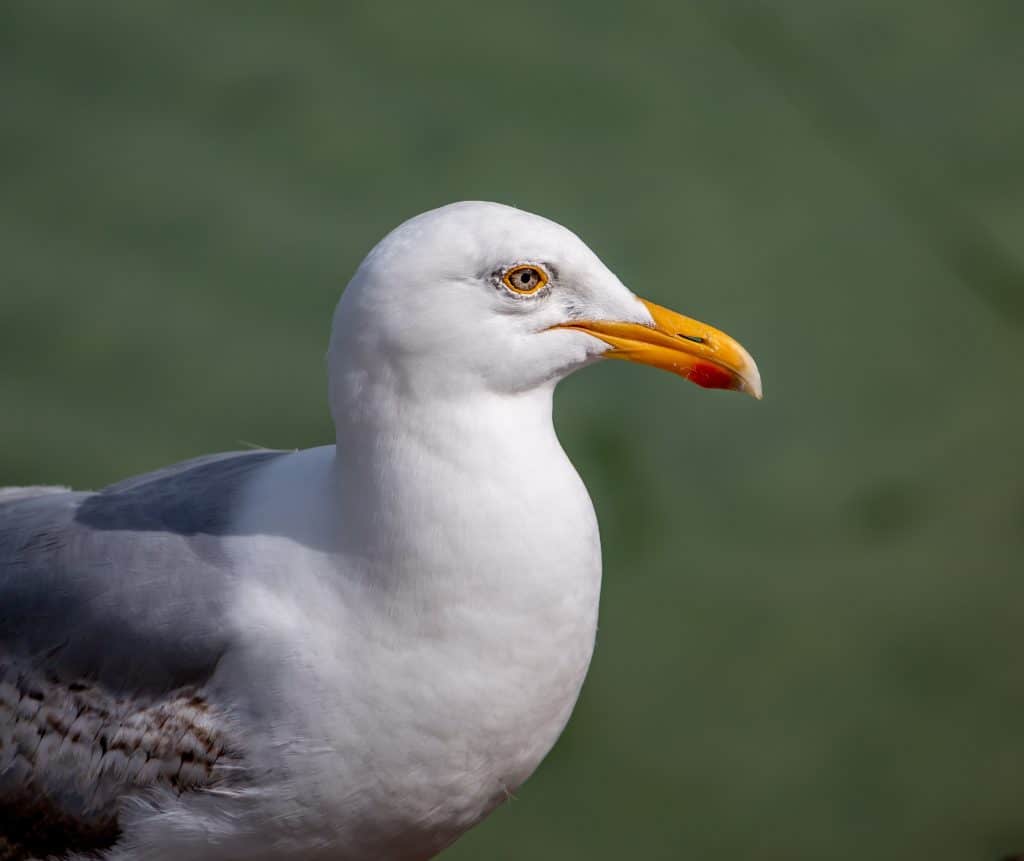
| Appearance | The herring gull is a large bird about 25″ long. They’re pal gray above with a white head and underparts. The head has brown specks except for the summertime when it’s pure white. They have yellow eyes and bills, and pink legs. |
| Diet | fish, marine life (shellfish, sea urchins, crabs…), insects, other bird eggs, and bird nestlings. |
| Feeder Food | They don’t visit feeders. |
| Habitat | Open water areas both coastal and inland. |
| Nesting | Herring gulls nest on the ground. They have 1 brood/season and 3 eggs/brood. The eggs are light green/tan with spots. Incubation is for 27-30 days and fledglings leave the nest after a few days. |
Migration: Herring gulls are migrators. While a population of them remain along the east coast year-round, others migrate north to Canada and Alaska in the spring to breed and raise young. In the fall, they migrate south for winter.
Year-round range: Southern Alaska, northern Wisconsin, Michigan, New York, and the east coast south to South Carolina as well as a narrow string in southern Quebec.
Breeding range: Alaska, northern Vermont, New Hampshire, and Maine, as well as all of Canada.
Winter range: Washington, west coasts of Oregon & California, Colorado, New Mexico, Kansas, Oklahoma, Texas, southwest Wisconsin, Illinois, Iowa, Arkansas, Missouri, Alabama, Mississippi, Georgia, Florida, and Mexico’s coasts.
Range Map
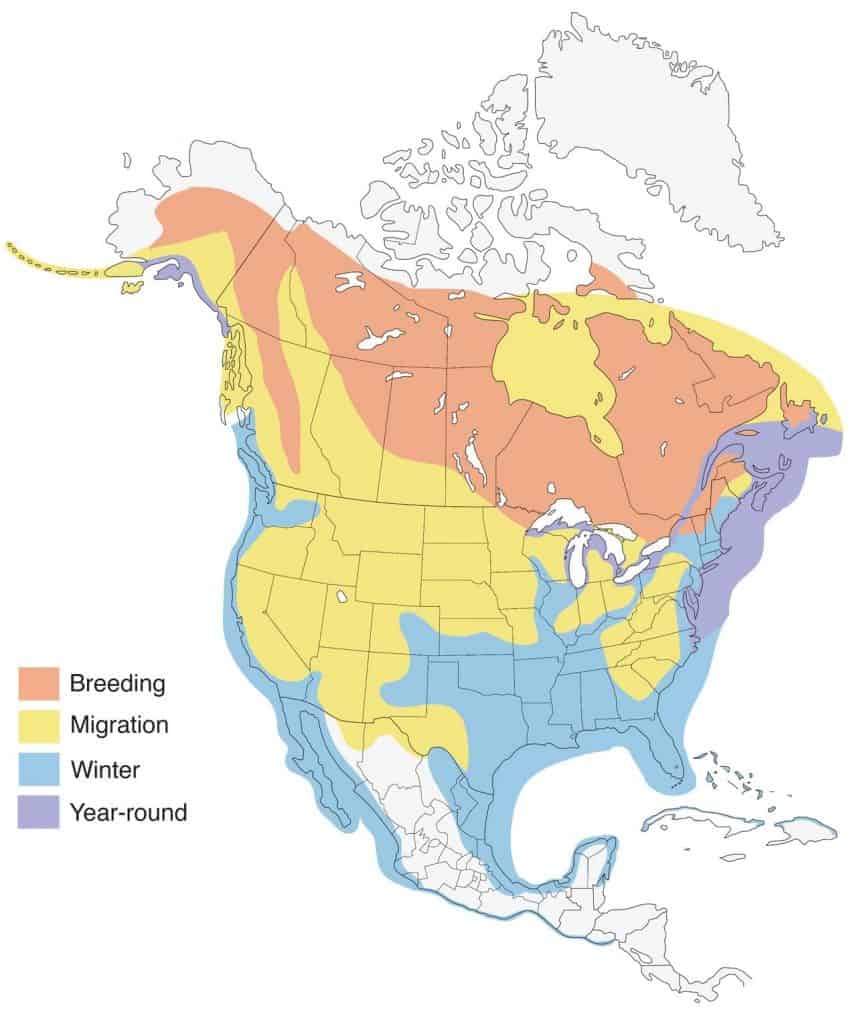
Horned Lark
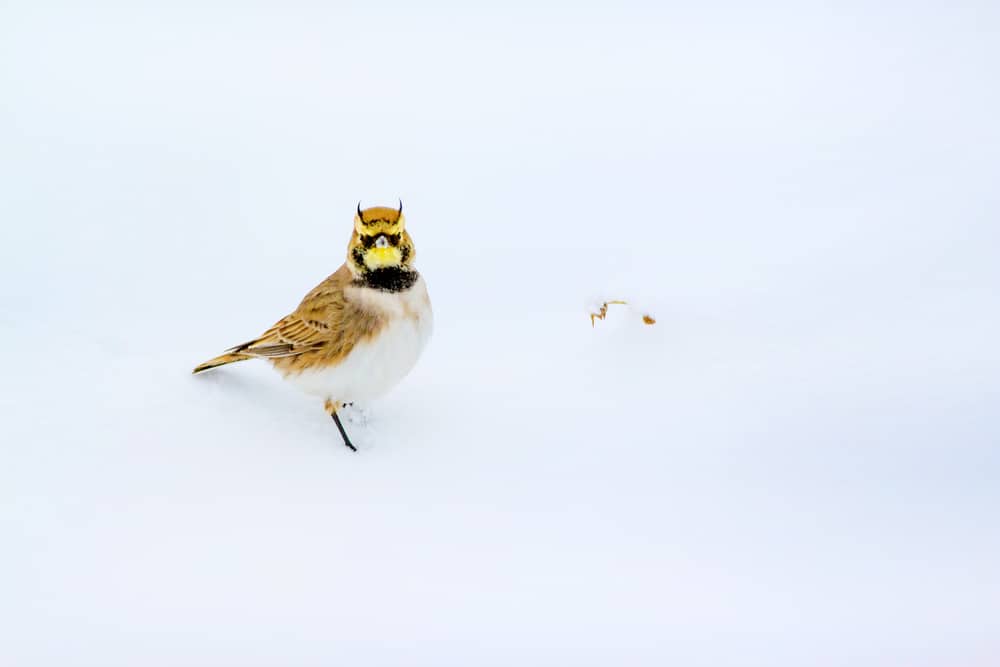
| Appearance | Medium-sized bird about 8″ long. Tan to brown with a black necklace and yellow chin. Bill is black. They have two tiny “horns” on the top of their head. The tail is black with white outer feathers. |
| Diet | Seeds and insects. |
| Feeder Food | They do not visit feeders. |
| Habitat | Short grassy areas such as prairies, deserts, beach dunes and farmers’ fields. |
| Nesting | They have 2 broods/year, 3-4 eggs/brood that are gray with brown markings. The nest is located on the ground. Incubation from 11-12 days. |
Range Map

House Finch
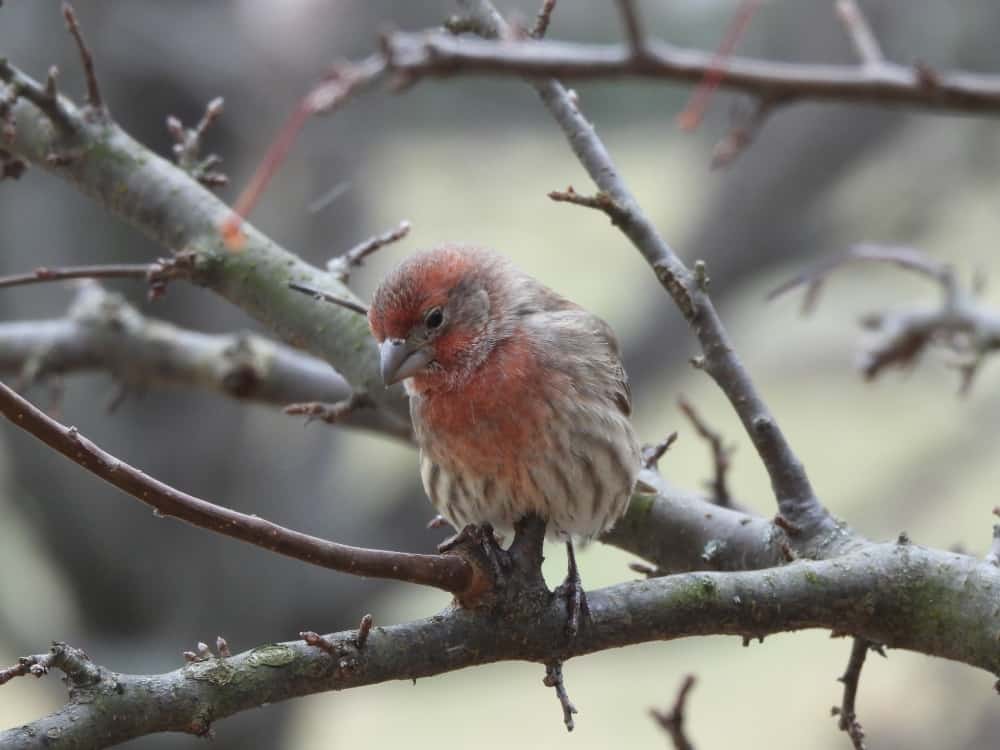
| Appearance | Small bird about 5″ long, orange/red face chest, and rump. Brown wings streaked with white. White belly with brown streaks. The Female and juvenile are brown with streaks of white. |
| Diet | Seeds, fruit, tree buds. |
| Feeder Food | Black oil sunflower seed is their favorite. |
| Habitat | House finches are found in the western and eastern parts of the US. They prefer to live around human dwellings (buildings, backyard trees, shrubs, barns. Also are found in parks and other urban areas. |
| Nesting | Nest: Small cup about 3-7″ wide, constructed from stems, leaves and plant roots, and feathers. The nests are built in coniferous or deciduous trees or even any place that holds a nest (ledges, vents, hanging plants). Broods: 1-6 broods/season Clutch: 2-6 eggs/brood (typical is 4-5) Egg color: Eggs are pale blue and speckled with black and purple dots. Egg size: 0.6 – 0.8 inches by 0.5 inches Incubation: 13-14 days and the young fledge between 12-19 days. |
| Migration | House finches are not migrators They remain in their year-round range for all seasons. Year-round range: Every US state except North & South Dakota, southern Ontario & British Columbia, and Mexico. |
Range Map
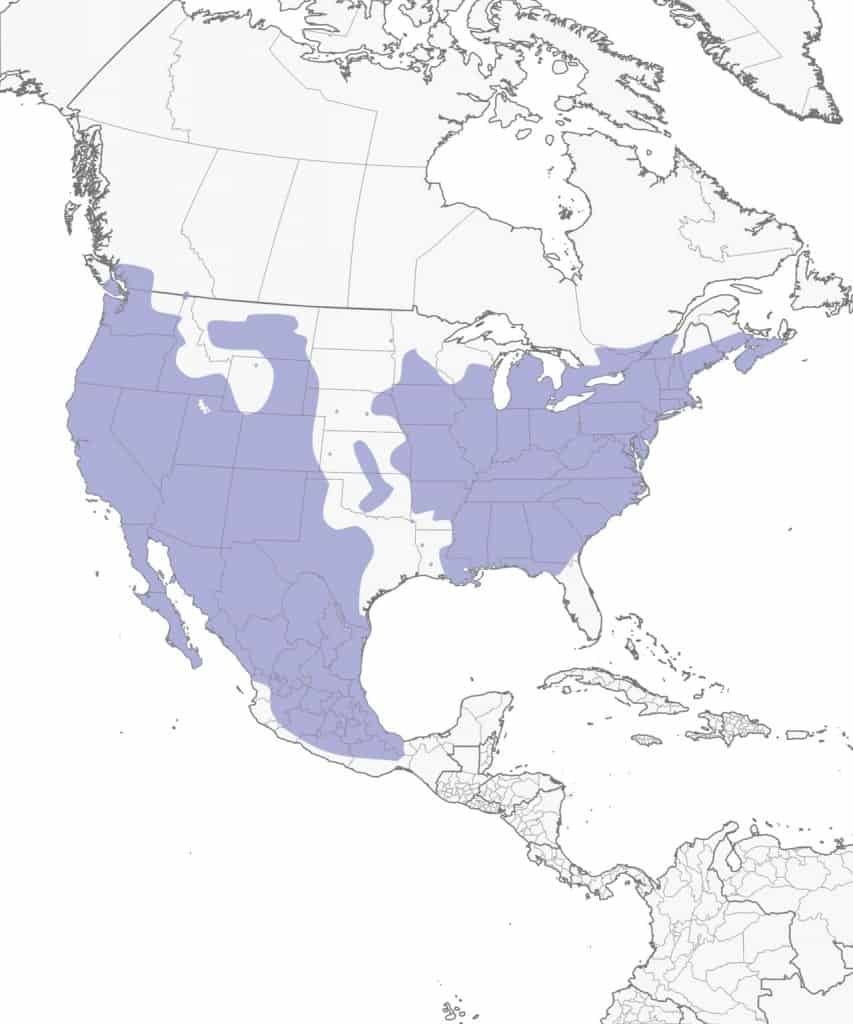
House Sparrow
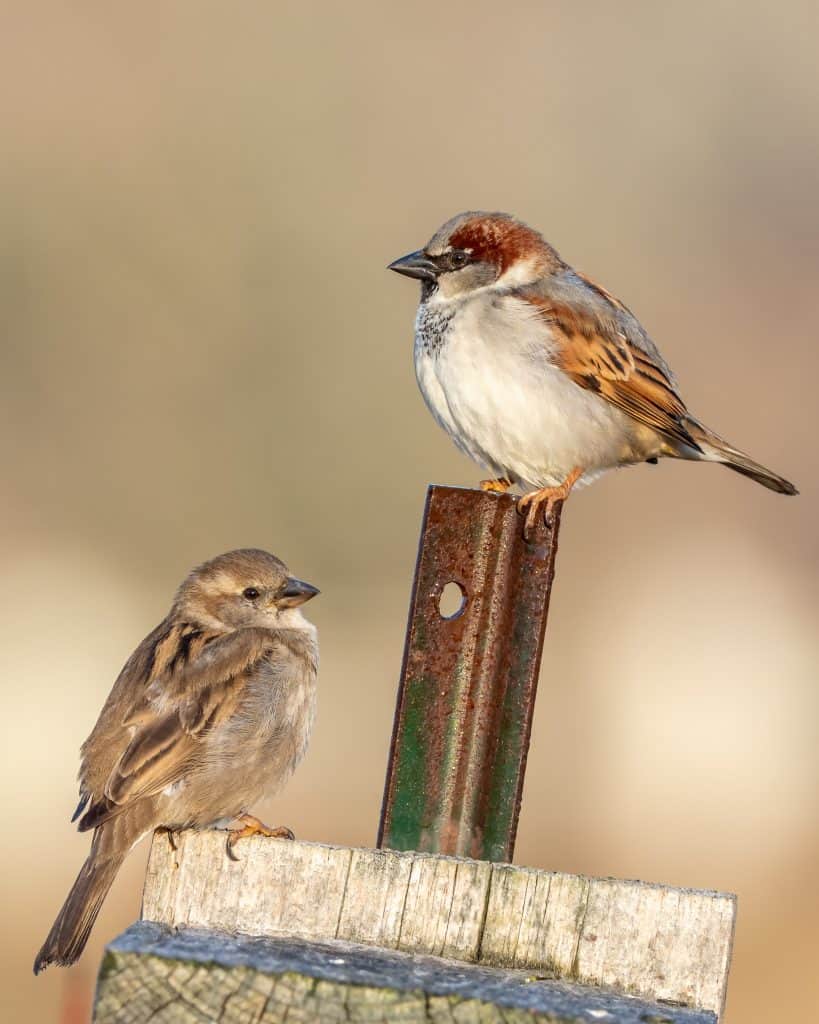
Appearance: The house sparrow is a small bird about 6″ long. They’re brown with a large black spot on the chin down to the chest. They have white wing bars, a gray belly & crown. The female is a bit smaller, all light brown and not black.
Diet: Seeds, insects, fruit.
Feeder food: Black oil sunflower seed, cracked corn, peanut hearts, millet, and milo.
Habitat: Around people and buildings in the city, towns, villages, suburbs, and farms.
Nesting: Dome-shaped nest within a cavity. They have 2-3 broods/year, and 4-6 white eggs with brown markings. Incubation is 10-12 days.
Migration: House sparrows are not migrators. They remain in their year-round range every season of the year. Their year-round range is massive encompassing nearly every part of North America (except Alaska and far northern Canada), Mexico, and Central America.
Range Map
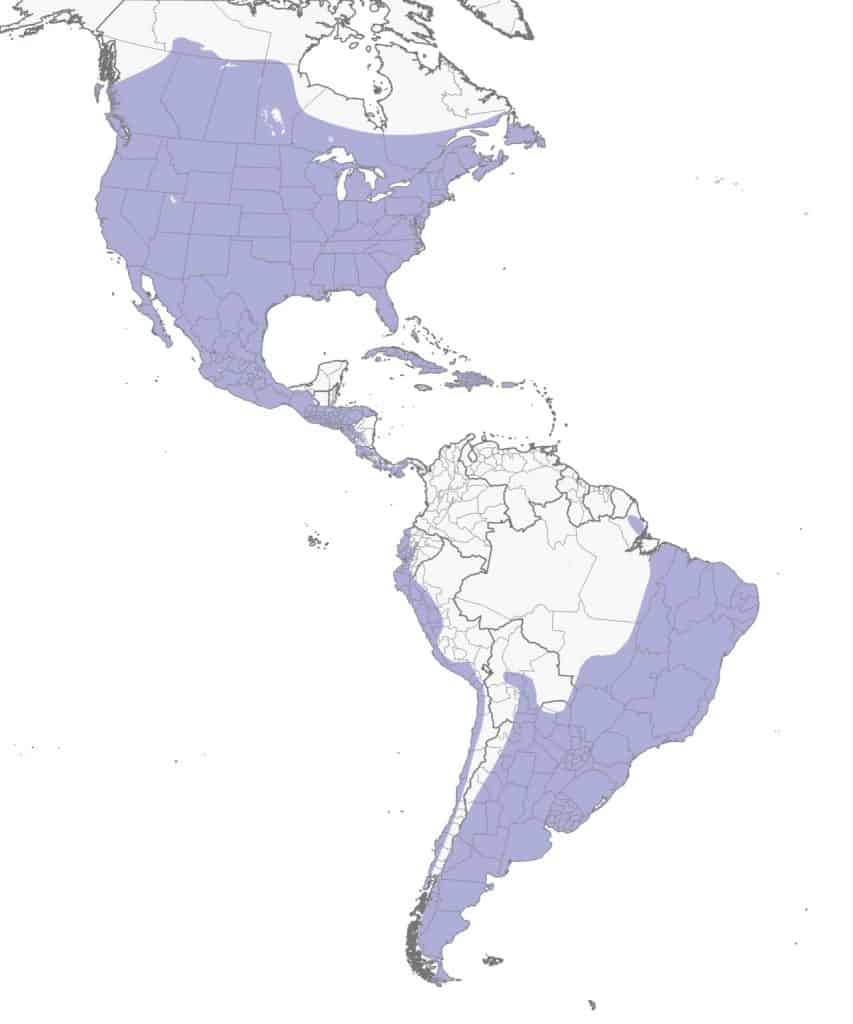
House Wren
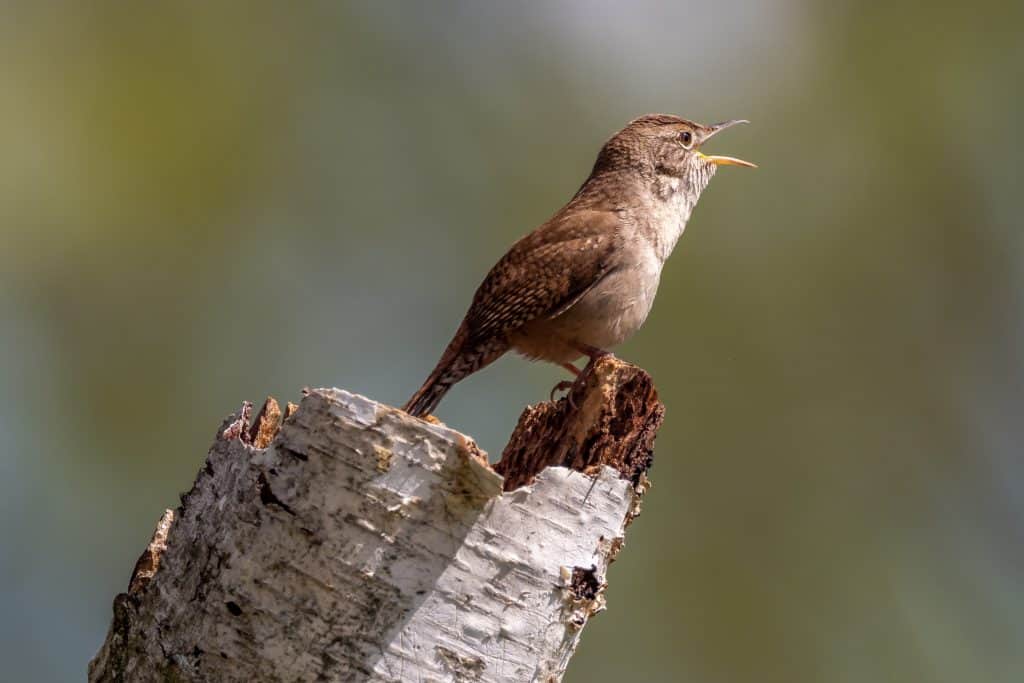
| Appearance | Small bird about 5″ long. Brown bird with faint patterns throughout and a muted throat and belly. Long pointy bill and dark eyes. |
| Diet | Insects. |
| Feeder Food | Unlikely to visit a feeder. |
| Habitat | Shrubby edges of woods, towns, and suburbs. |
| Nesting | They are cavity nesters so will use an old woodpecker hole or manmade nesting box. They have 1-2 broods/year, 3-10 eggs/brood incubated for 14 days. Eggs are white, light pink, or light gray with brown blotches. |
Range Map
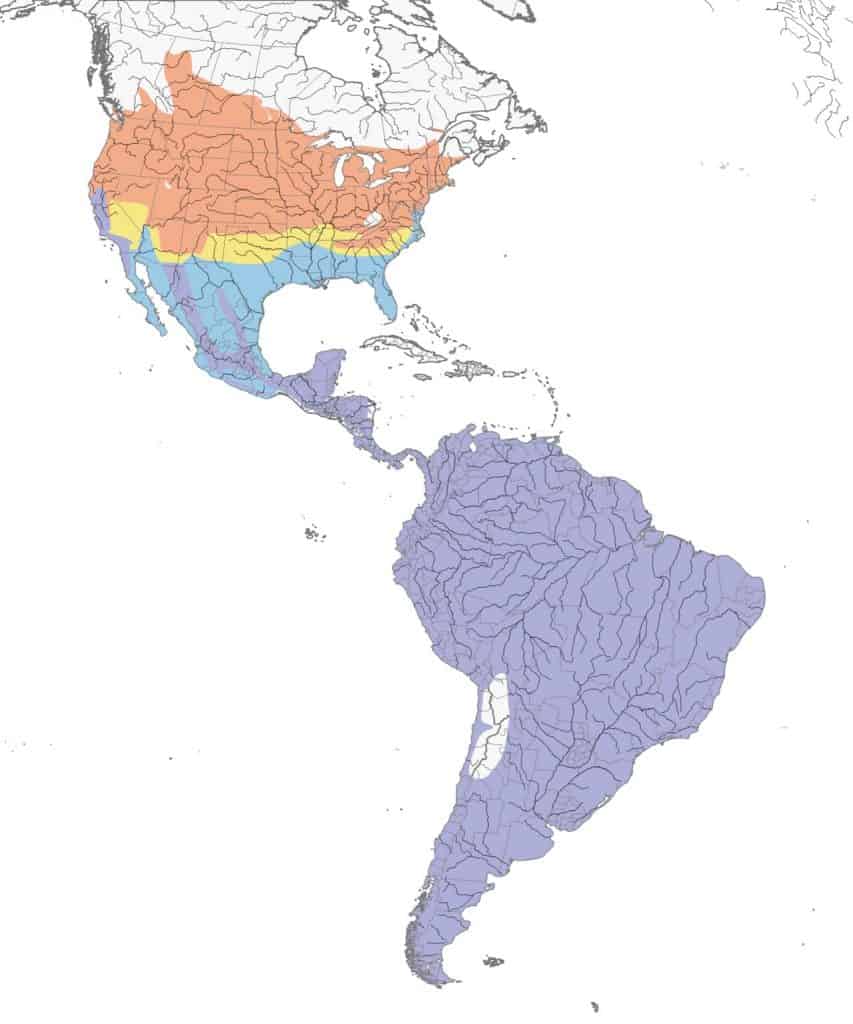
Indigo Bunting
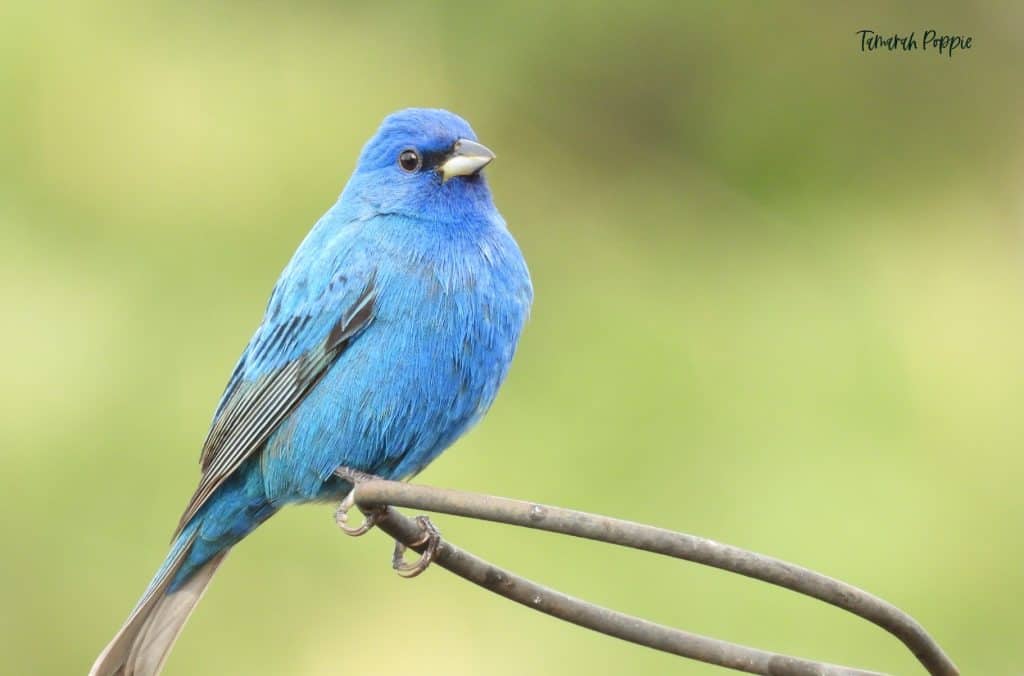
Appearance: Brushy fields, on weedy plants, scrub, and along the edges of the woods. Also in clearings within deciduous woods and edges of swamps.
Diet: Small seeds, insects, and fruits.
Feeder Food: Although not a regular at the feeder you may entice them with nyjer/thistle and white millet seeds.
Habitat: Brushy fields, on weedy plants, scrub, and along the edges of the woods. Also in clearings within deciduous woods, and edges of swamps.
Nesting: Cup-shaped nest in shrubs or trees 3′ high. Shrubs or trees 3′ high. 1-3 broods/season, 3-4 eggs/brood, eggs are white with few brown spots.
Range Map
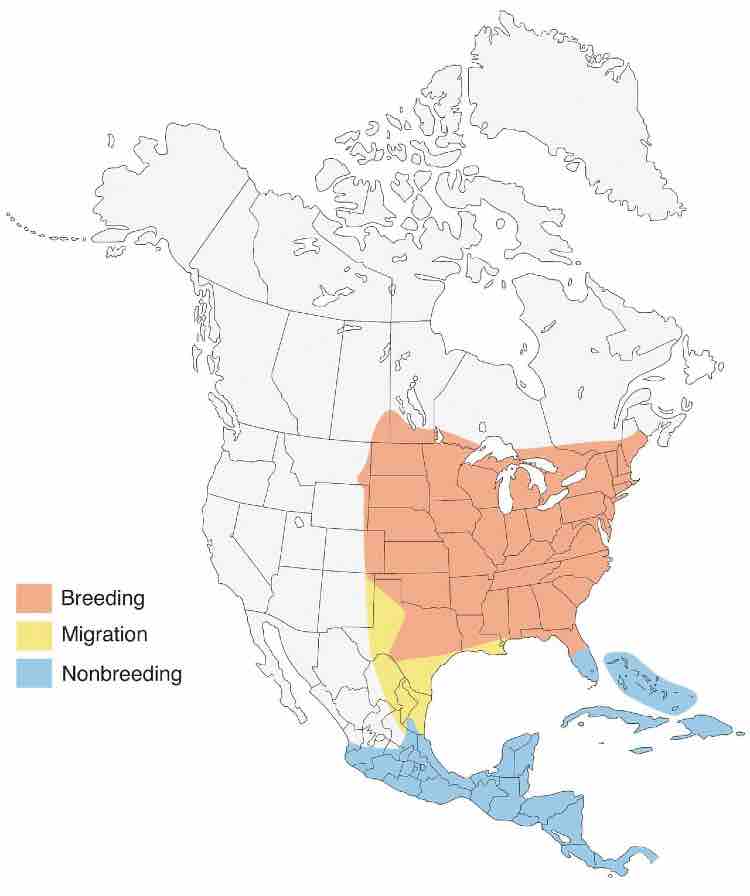
For more detail about the Indigo Bunting such as its mating & nesting, how to attract them to your yard, and more: check out Proven Ways to Attract Indigo Buntings.
Killdeer
| Appearance | Medium-large sized bird about 11″ long. Brown with black two bands around the neck, a white belly, red-orange rump, large orange eyes, long beaks, and long legs. Female looks like the male. |
| Diet | Insects. |
| Feeder Food | They don’t visit feeders. |
| Habitat | Open grasslands. |
| Nesting | They nest on the ground. They have 2 broods/year, 3-5 tan eggs/brood, and incubation is 24-28 days. |
Range Map
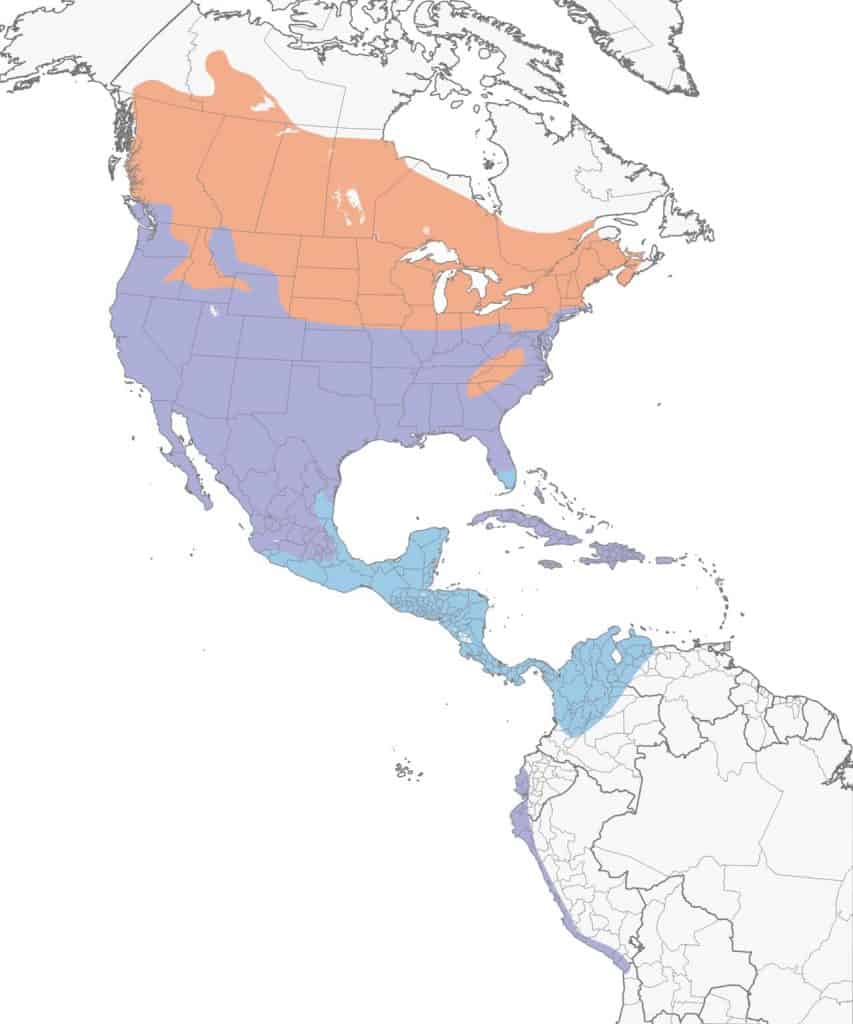
Magnolia Warbler

| Appearance | Small bird about 5″ long with slate gray top and bright yellow under with black stripes. A black mask surrounds the eyes with a white strip above that. Short pointy bill and long, narrow tail. The female is lighter gray with a yellow belly but only a faint black stripe. She has no black mask, her eyes have white eye rings and splotches of yellow on her back. |
| Diet | Insects and sometimes fruit in fall. |
| Feeder Food | Unlike to visit feeders. |
| Habitat | Thickly forested areas with conifer trees. |
| Nesting | They nest deep in coniferous trees. They have 1-2 broods/year, 3-5 eggs/brood that are white some speckled. Incubation lasts 11-13 days. |
Range Map
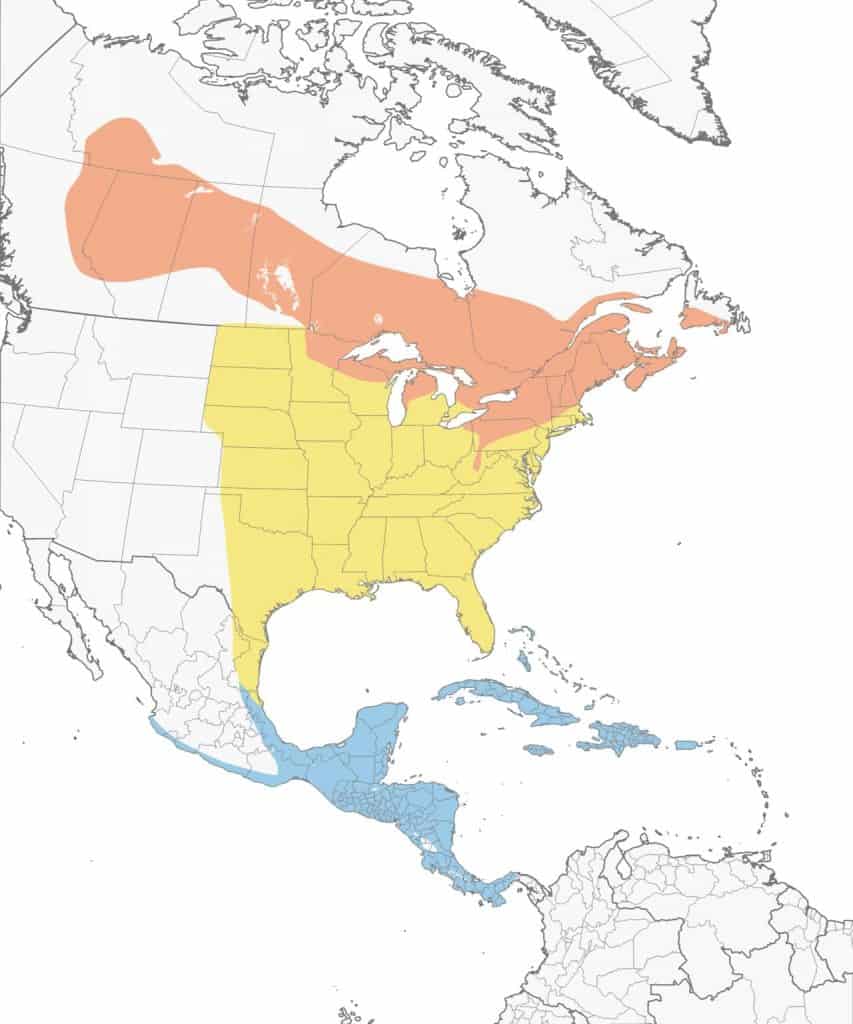
Mallard
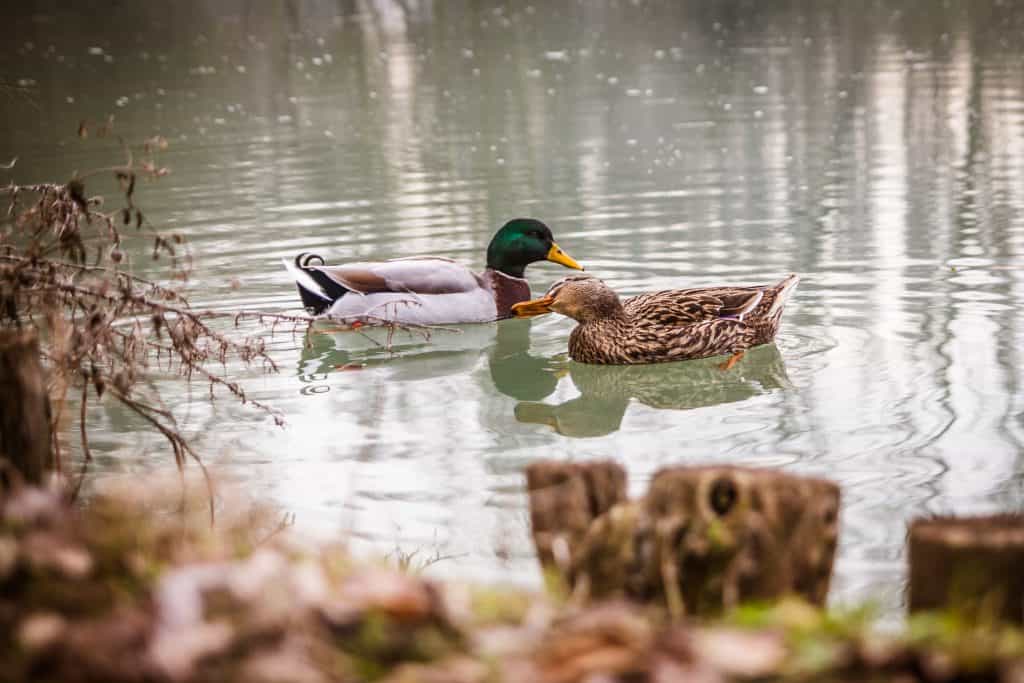
| Appearance | Mallards are large ducks about 23″ long. The male has a metallic green head, chestnut breast, and yellow bill. The female is a mottled brown with an orange bill and heavily streaked dark brown. |
| Diet | Insect larvae, snails, seeds. |
| Feeder Food | They’re not feeder visitors. |
| Habitat | Around freshwater habitats. |
| Nesting | Mallards nest on the ground near water. The nest is typically made from plant materials and lined with feathers and down. They have 1-2 broods/season and 10-12 eggs/brood. Incubation lasts for 28 days and fledglings leave their mom at about 7-8 weeks. |
Range Map
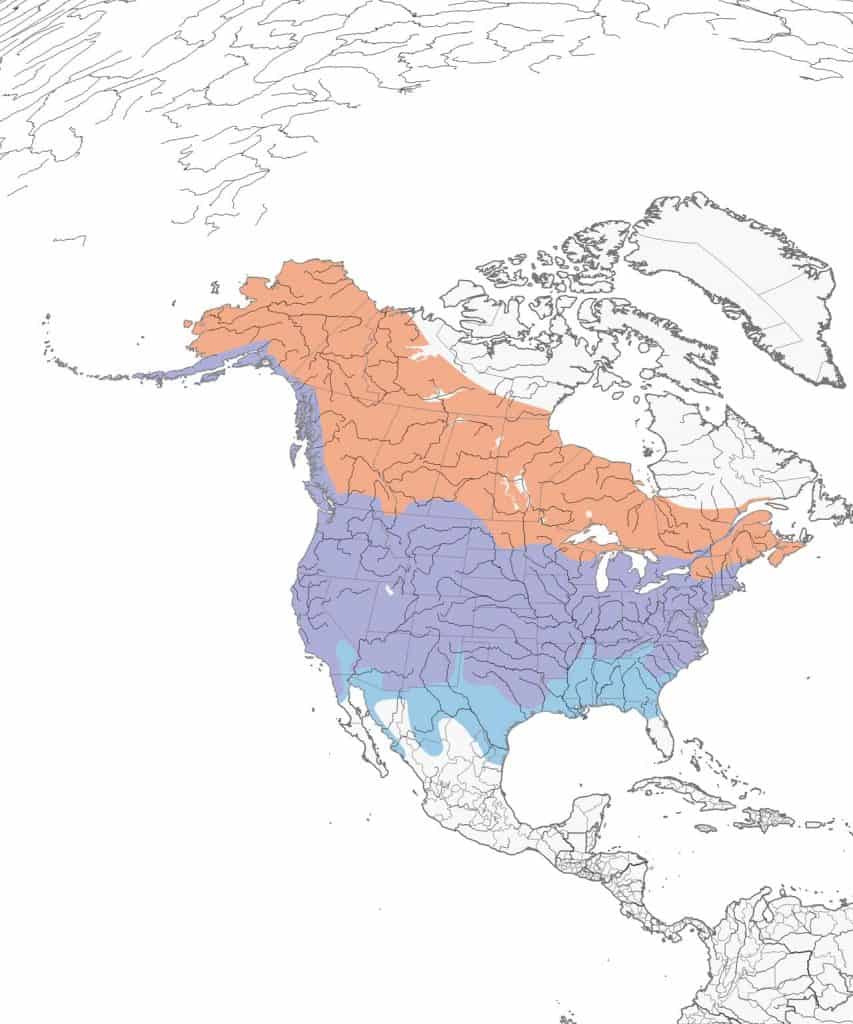
Mississippi Kite
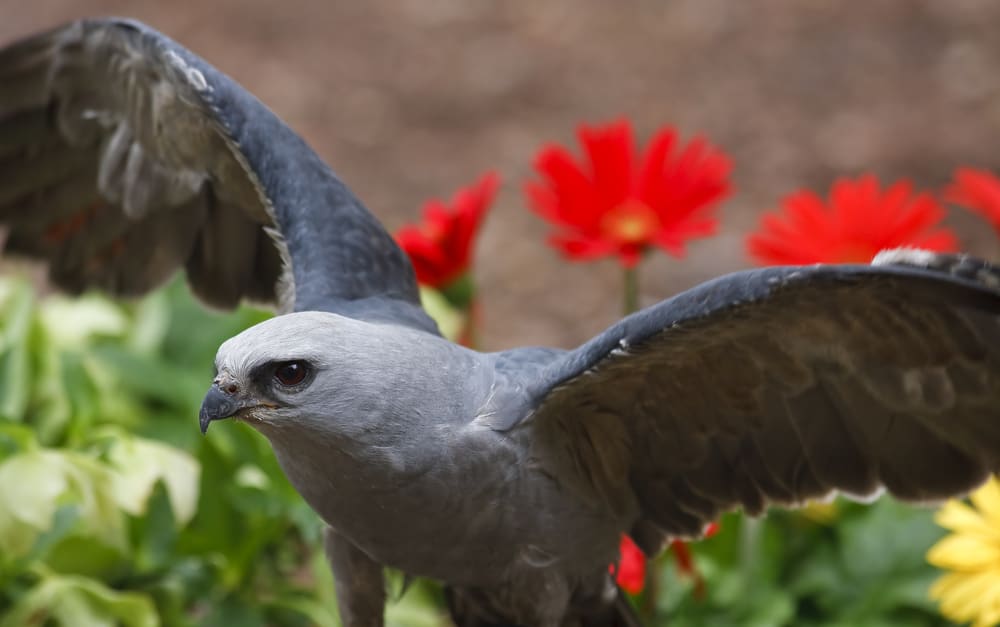
| Appearance | Mississippi kites are slim birds about 14″ long. They’re dark gray with a light gray to white head, red eyes, and light gray on the tips of the wings. |
| Diet | Large flying insects, frogs, lizards, snakes, and small birds & mammals. |
| Feeder Food | They don’t visit feeders. |
| Habitat | Generally found within shelterbelts (linear plantings of multiple rows of trees or shrubs established for environmental purposes such as protecting farmsteads and livestock areas), towns, and backyards within their range. |
| Nesting | Mississippi kites nest in trees, often at the edge of a woodlot. They have 1 brood/season and 2 eggs/brood. Incubation is for 29-32 days and fledglings leave the nest at about 25-30 days. |
Range Map

Mourning Dove
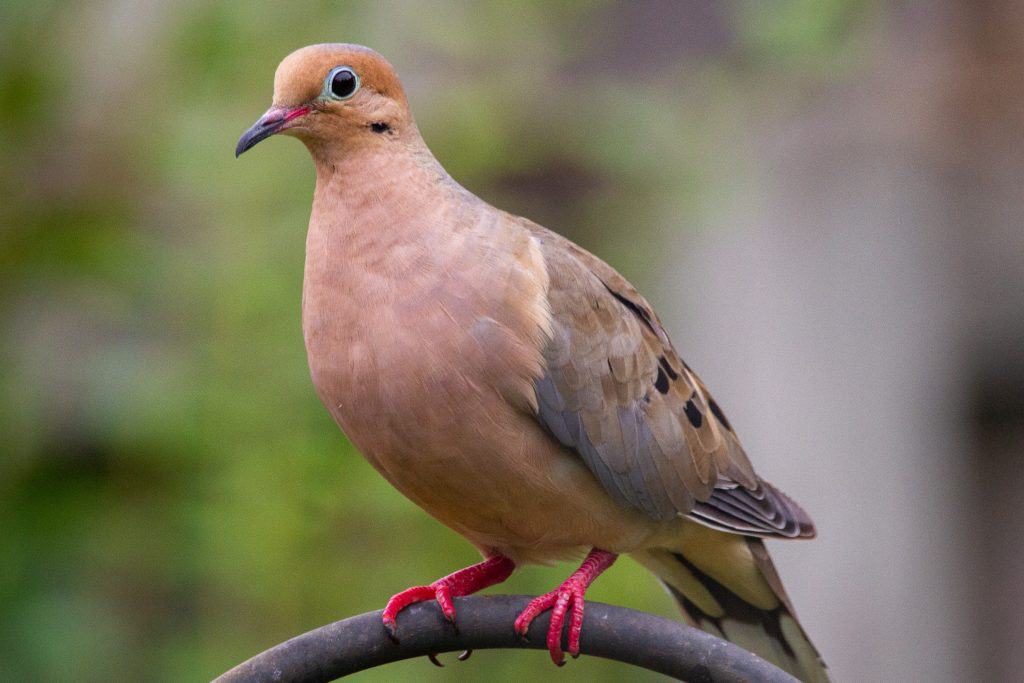
| Appearance | The mourning dove is a large bird about 12″ long and smooth with fawn colors. Black spots on the wings and tail. A single black spot below and behind the eyes. Wide brown tail with white edges. Red-orange legs. Gray patch between the head and back and iridescent colors around the neck. Large black eyes with light blue around the eyes. Pointy bill. |
| Diet | Seeds. |
| Feeder Food | Will come to eat seeds that drop below the feeder. |
| Habitat | Open areas. |
| Nesting | They build a platform-style nest that’s located on a tree branch. Sometimes will nest on the ground. They have 2 broods/year and 2 eggs/broods that are white. Incubation is 13-14 days. |
Range Map
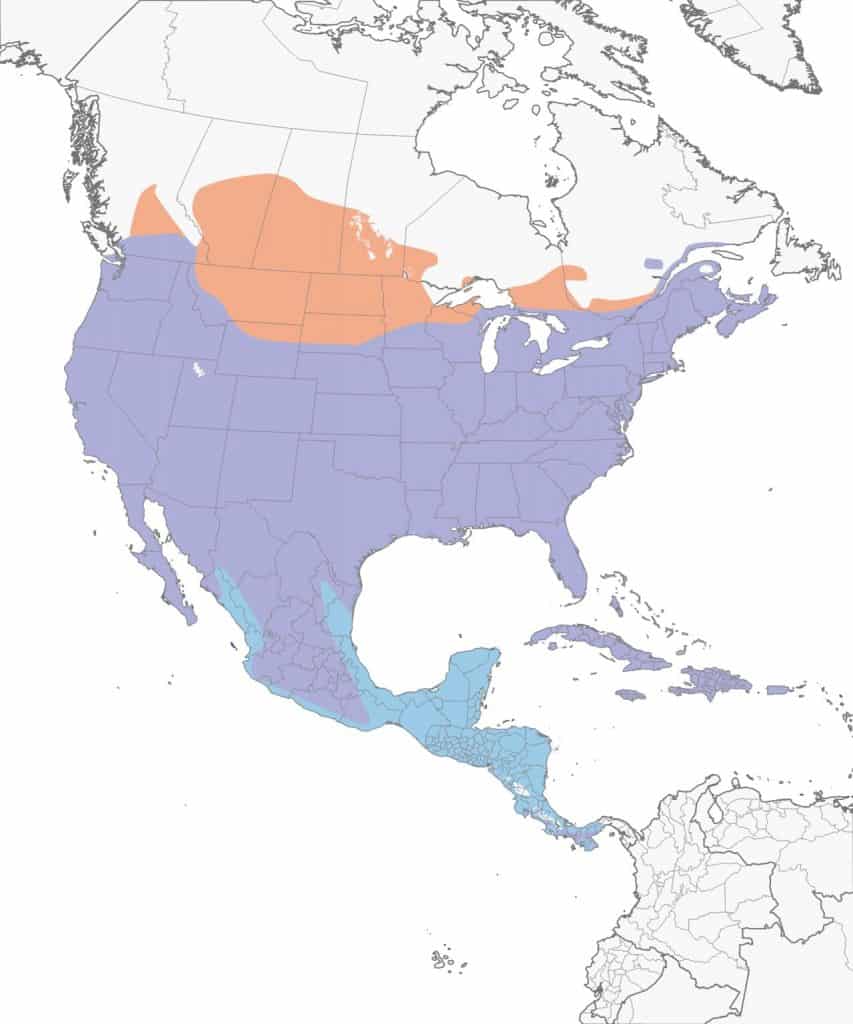
Northern Bobwhite
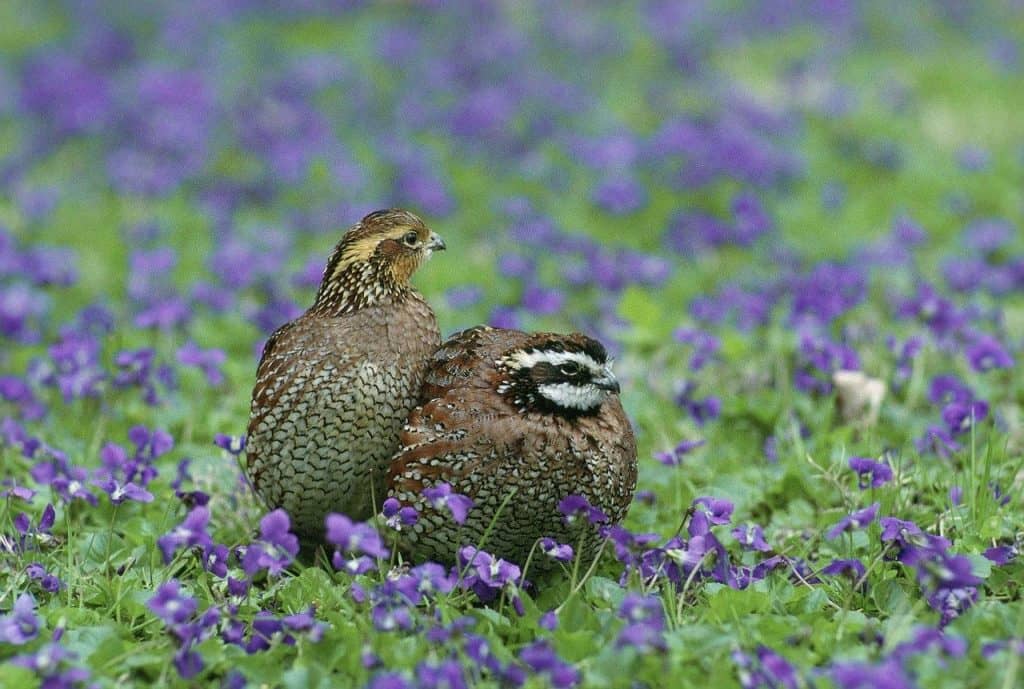
Appearance: Northern bobwhites are a type of quail and are about 10″ long. They’re reddish-brown with streaking and spotting throughout. They have a whisp of a crown (hardly noticeable), and a white stripe starts at the bill and goes over the eye all the way to the back. Their throat is also white. Females are the same except the head is brown and tan.
Diet: Seeds, berries, and insects.
Feeder food: They will indulge in seed or crack corn scattered beneath the feeder.
Habitat: Found in rural and farm areas.
Nesting: Northern bobwhites nest on the ground in a sheltered location. They have 1-3 broods/season and 12-14 eggs/brood. Incubation is for 23 days and fledglings leave the nest about 7-10 days after hatching.
Migration: Northern bobwhites are not migrators. They remain in their year-round range every season of the year.
Year-round range: Eastern half of the US, Washington, Oregon, Idaho, and Mexico. ,
Range Map
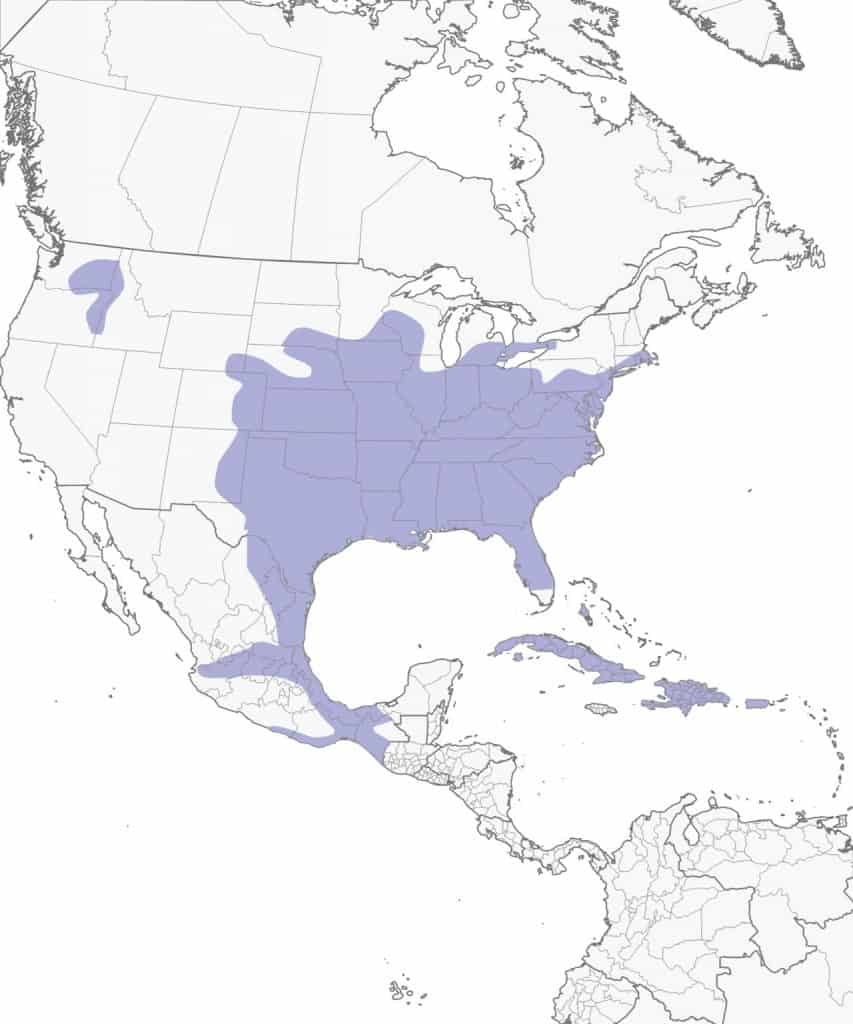
Northern Cardinal
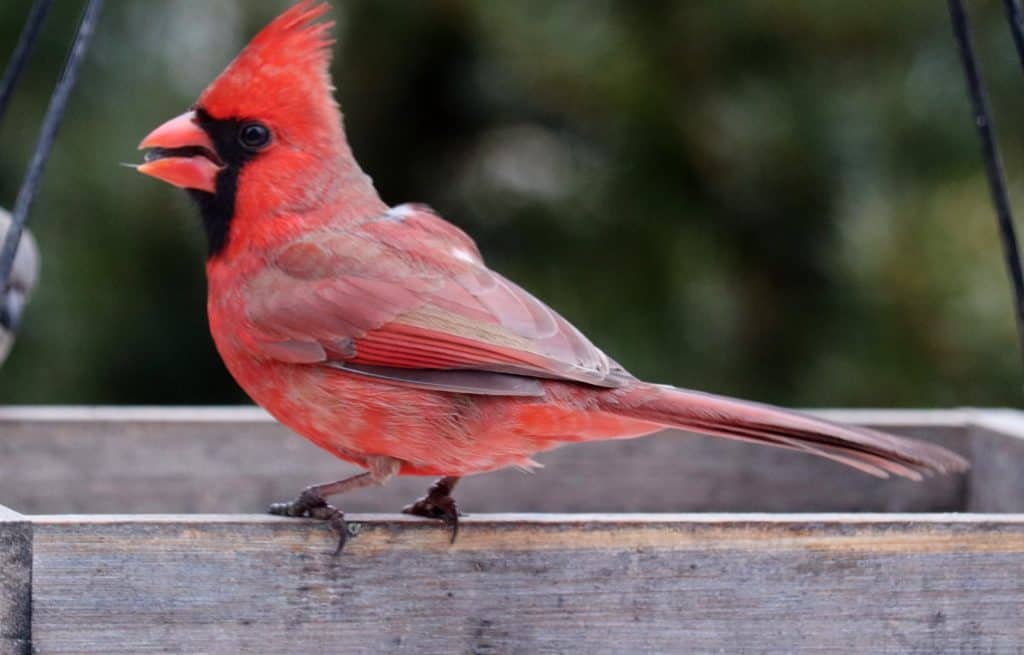
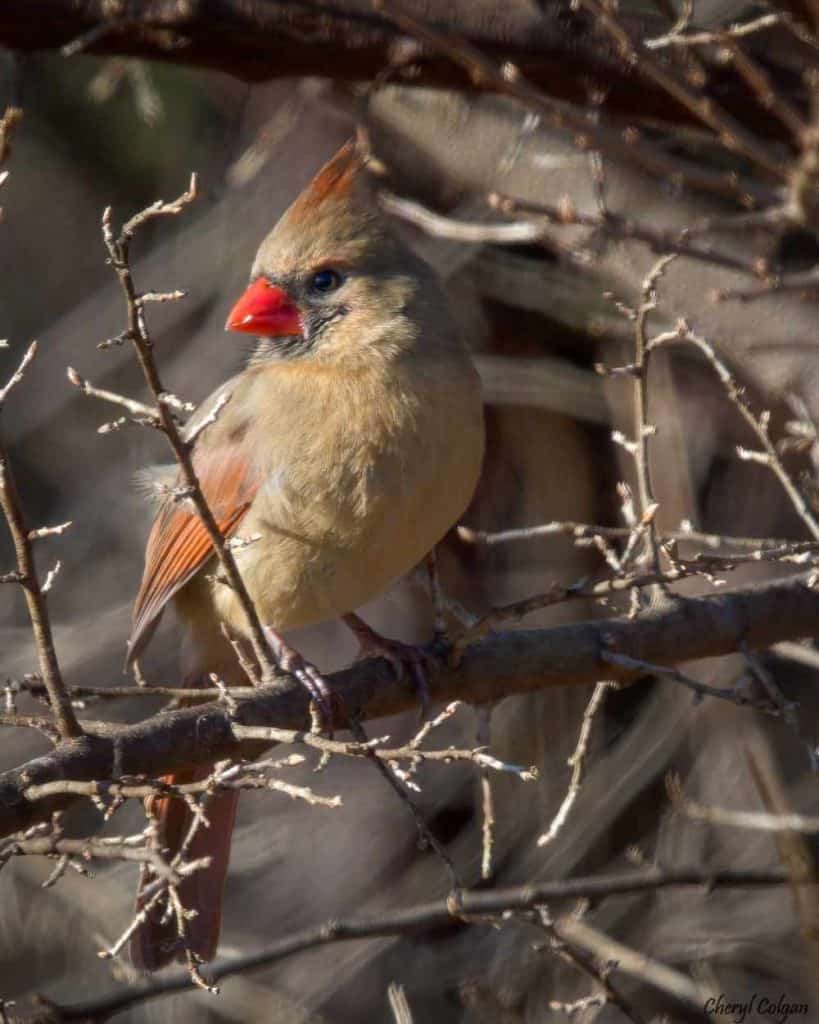
Appearance: Northern cardinals are medium-sized bright red birds about 8 1/2″ long with a black mask, red crown, orange beak, and black areas on wings and tail. The female also has an orange beak but her body is buffy brown with tinges of red on her wings, tails, and crest. The mask around her fact is charcoal.
Diet: Insects, spiders, centipedes, snails, and slugs. Fruit and seeds from plants.
Feeder food: Black-oil sunflower seed, safflower seed, mealworms, striped Sunflower seed, hulled peanuts, and cracked corn.
Habitat: Edges of wooded areas to thickets, tangled vines, city parks, and our backyard gardens.
In the southwest live around desert washes, areas thick with mesquite, and along the riverbanks of wooded areas.
Nesting: Open-cup nest in a dense shrub about 3-10′ up. They have 2-3 broods/year, and 1-5 eggs/brood that are beige with brown spots. Incubation is 12-13 days.
Migration: Northern cardinals are not migrators. They remain in their year-round range every season of the year.
Year-round range: Eastern half of the US, Arizona, New Mexico, and Mexico.
Range Map
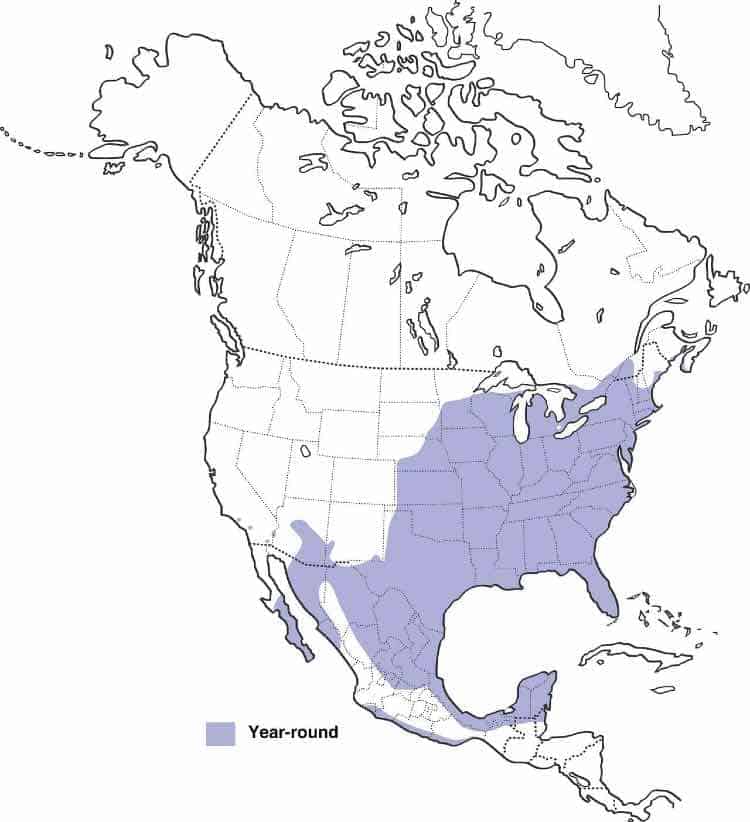
Northern Flicker
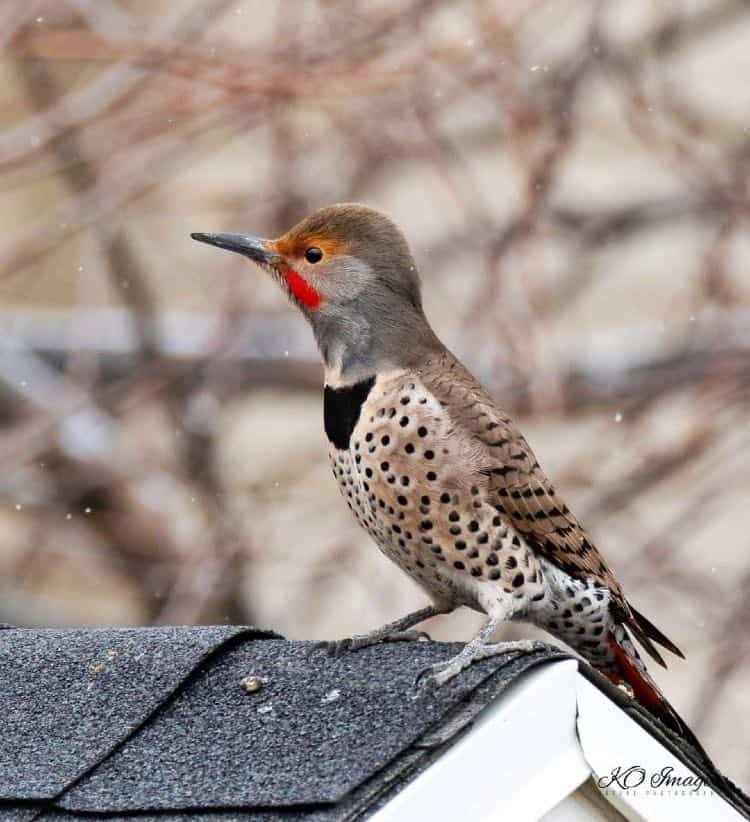
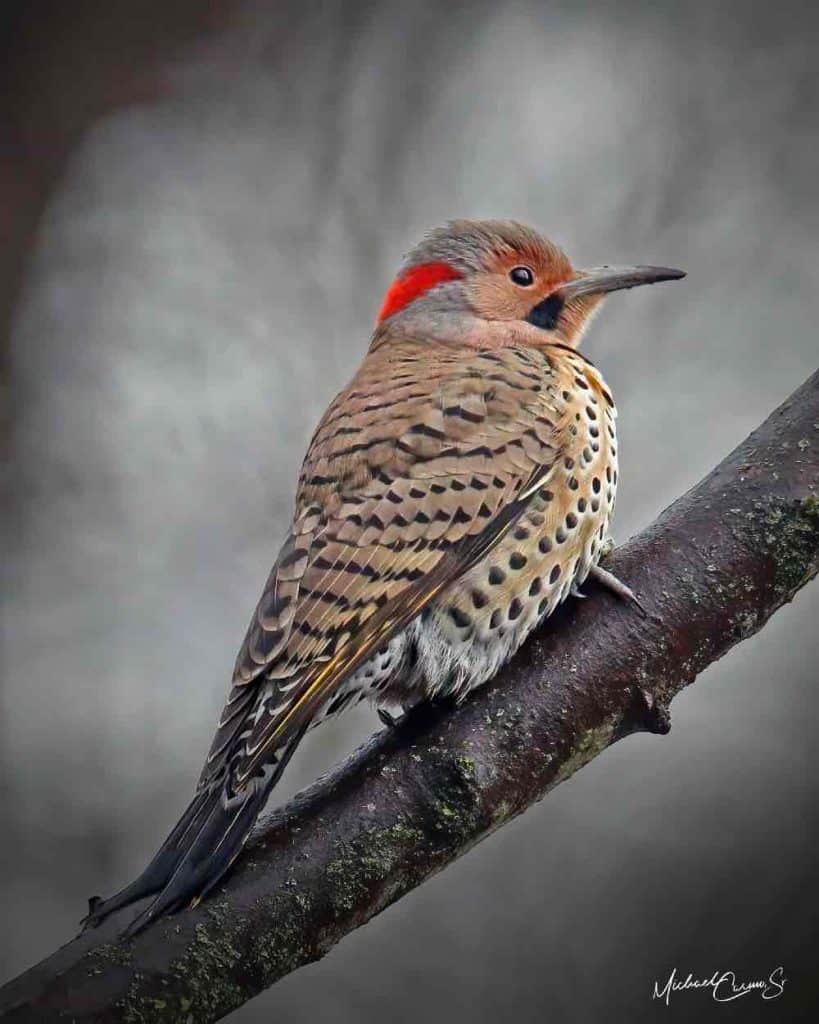
Appearance: A large bird about 12.5″ long. They have brown backs with black bars, a black crescent on the upper chest, and white with black spots on the belly and underparts.
• In the eastern part of their range, they are referred to as “yellow-shafted northern flickers” and have bright yellow underwings and undertail. They have a gray crown, tan face, and a red patch on the nape. The male has a black swipe on his cheek, the female does not.
• In the western part of their range, they are referred to as “red-shafted northern flickers” and have pink underwings and undertail, brown crown, gray face, and crown & nape are brown. The male has a red swipe on his cheek, the female does not
Diet: Insects, especially ants.
Feeder food: Hulled peanuts and suet.
Habitat: Open areas near trees.
Nesting: They are cavity nesters and have 1 brood/year. 5-8 white unmarked eggs per brood. Incubation is 11-14 days.
Migration: Northern flickers are migrators. Scientists believe the timing and duration of their migration from the breeding range to their winter range are dependent on weather. They generally migrate at night and travel in large but loose flocks of up to 100 or so birds.
Year-round range: Each US state as well as parts of British Columbia,
Breeding range: Alaska, Canada, and inland parts of their year-round range in Washington, Oregon, and California.
Winter range: Many will winter in the year-round range while others head further south into southeast California, southwest Arizona, Texas, and Mexico.
Range Map

Northern Mockingbird
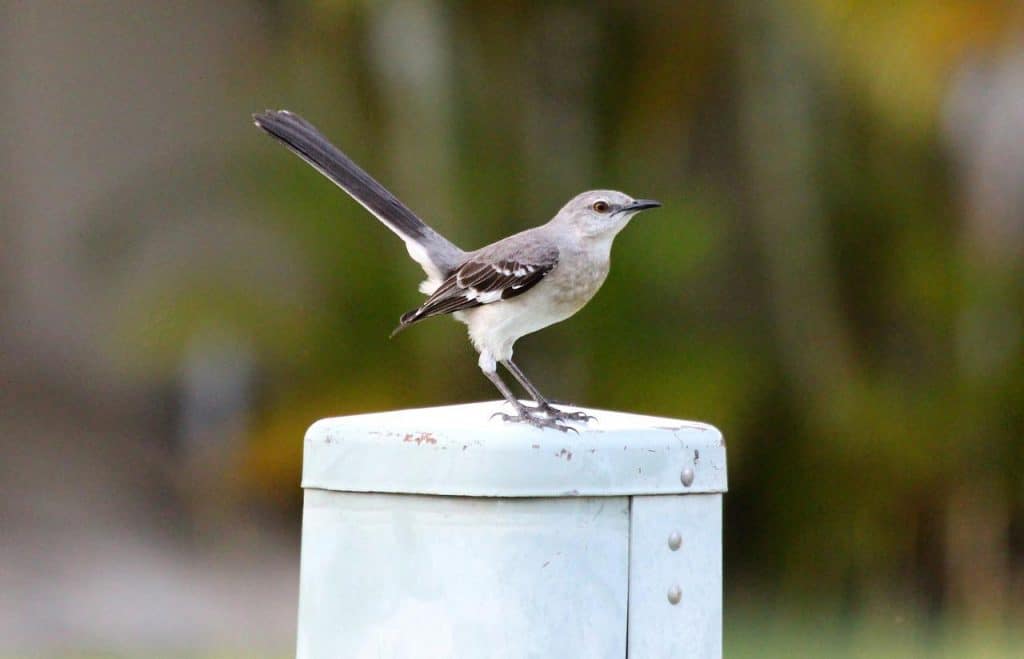
Appearance: Northern mockingbirds are about 10″ long. They have gray above and white below. Wings are dark gray with patches of white. They have long beaks and yellow eyes.
Diet: Insects and berries.
Feeder food: Suet
Habitat: Northern mockingbirds prefer thickets and brushy areas with open areas nearby.
Nesting:
- Nest: They nest in a thick shrub or tree between 1-10′ up. Northern mockingbird males select several nesting sites and begin building nests in each. The female will pick her favorite and finish the nest. They won’t abandon these nests but move to another with each brood
- Brood: 2-3 broods/season
- Clutch: 2-6 eggs/brood
- Egg color: Light blue to greenish-white sporting brown or red spots.
- Egg size: 1.1 inches by 0.8 inches
- Incubation: 12-14 days and fledglings leave the nest at 11-15 days.
Migration: Northern mockingbirds do not migrate. They remain in their year-round range all seasons of the year.
Year-round range: Every US state, the southern edges of Canada’s British Columbia, Alberta, Saskatchewan, Manitoba, Ontario, Quebec, and Mexico.
Range Map
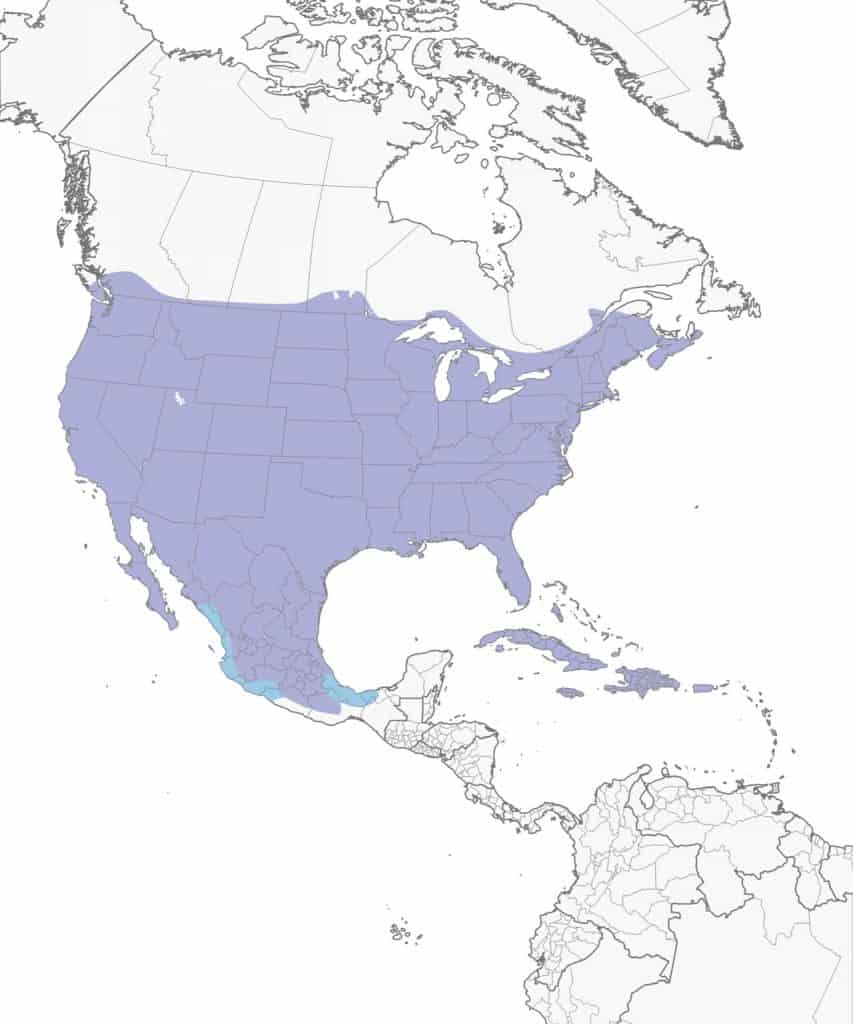
Northern Parula
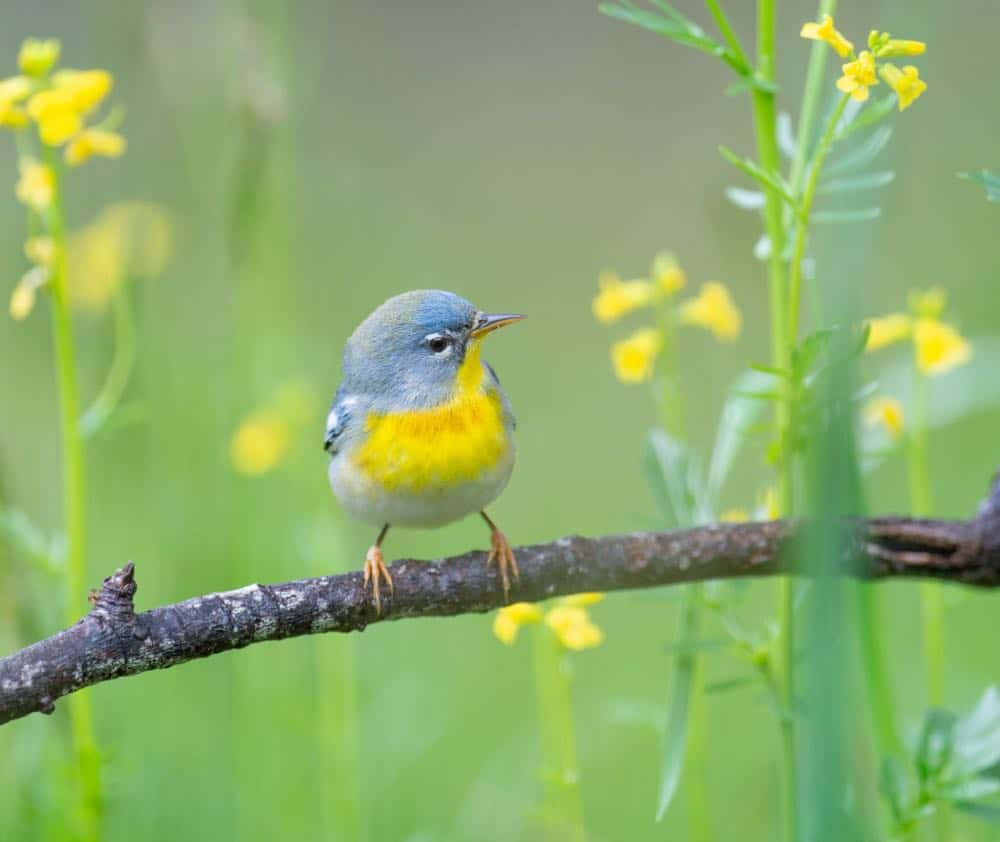
Appearance: Northern parula is a small bird about 4.5″ long, blue/gray with a yellow throat and back patch, bluish-gray overall with a yellow-green patch on the back, a brown band on the lower, and white strips above and below each eye. Females are similar but more muted colors. neck, and 2 white wing bars.
Diet: Spiders, insects, berries, seeds, nectar.
Feeder food: Unlikely to visit a feeder.
Habitat: Prefer forested areas especially when water is present (streams, marshes) and in the lowland where moss is present.
Nesting: Nests are built in mossy vegetation as high up as 100′ at the end of a branch. 1-2 broods/season, 2-7 eggs/brood, eggs are about .65″ long, white with red/brown/purple speckles, and incubation lasts about 12-14 days.
Migration: Northern parulas are migrators. In the spring, they migrate north to breed and raise their young. Then in the fall, they migrate south for the winter.
Breeding range: The US states south and east of Kansas, northern Minnesota, Wisconsin, & Michigan, Pennsylvania, New York, New England, and the southern parts of Canadian provinces Manitoba, Ontario, and Quebec.
Winter range: Southern tip of Florida, the Caribbean islands, Mexico, and Central America.
Range Map
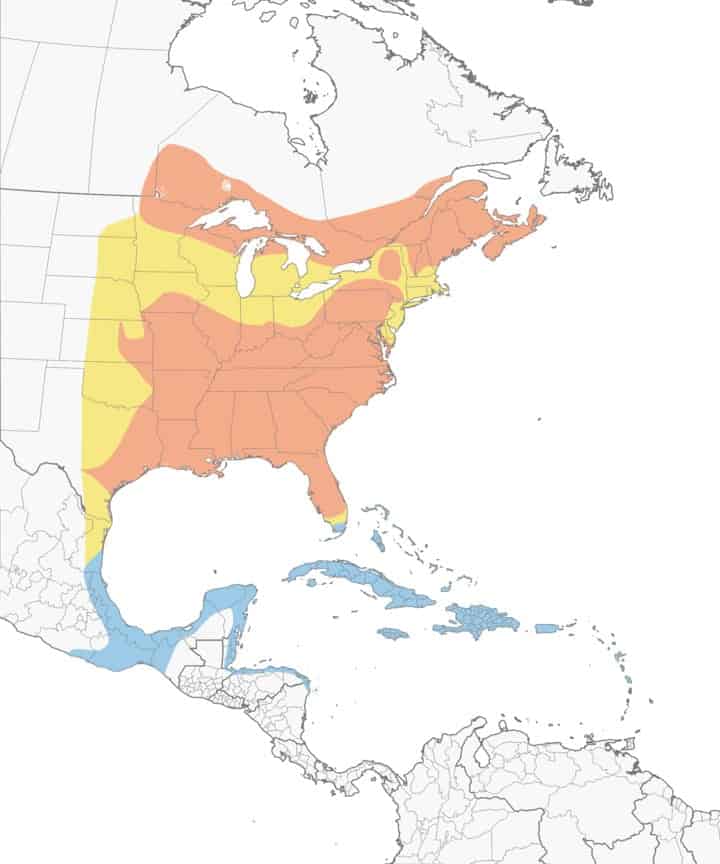
Northern Shoveler

| Appearance | Northern shovelers are medium-sized waterbirds at about 17-20″ in length. They have shovel-shaped heads. The male has a dark green head, black back and feathers, white neck, and brown chest. The female has an orange bill & eggs with brown and white markings throughout her body. |
| Diet | Mollusks, insects, crustaceans, sometimes small fish, aquatic plants, and seeds. |
| Feeder Food | N/A |
| Habitat | Northern shovelers can be found in shallow wetland areas with plenty of vegetation. They’ll also be found in salt marshes, lakes, flooded fields, and other overflow areas that collect water. |
| Nesting | Northern shovelers are grounds nesters. The female generally Broods: 1 broods/season Clutch: 8-12 eggs/brood Egg color: pale olive Egg size: About 2″ x 1.4″ Incubation: Incubation lasts 21-27 days. The young follow their mom out of the nest within a few hours of hatching. They’re able to fly about 52-60 days after hatching. |
Range Map
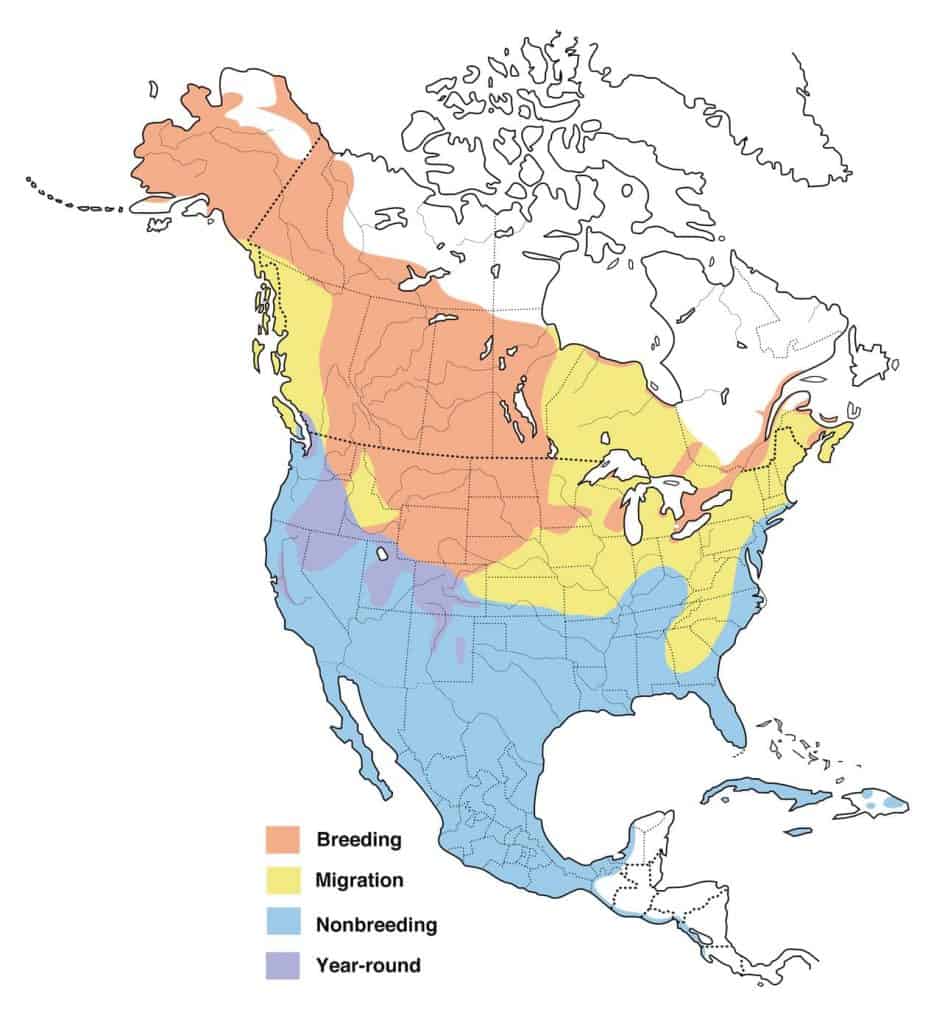
Oak Titmouse
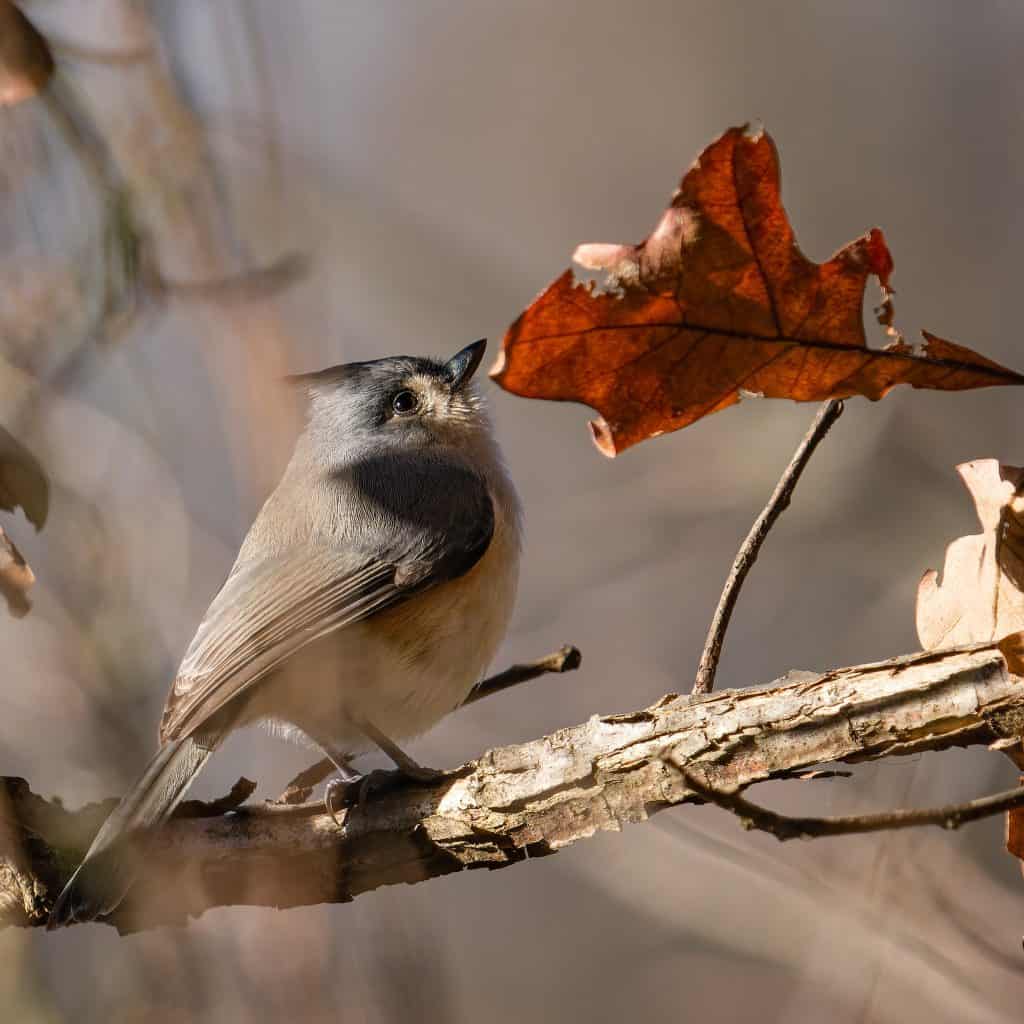
Description: The oak titmouse is a small bird about 5″ long. They have a short crest that they raise/lower depending on level of agitation. They’re primarily grayish brown with paler colored underparts. The females look the same.
Diet: Insects, seeds (especially acorns), buds, berries, and fruits.
Feeder food: Hulled sunflower seed, black-oil sunflower seed, safflower seed, whole peanuts, suet, and mealworms.
Habitat: Wooded areas.
Nesting: Oak titmice are cavity nesters. They prefer an old woodpecker hole or other natural cavity but will also use a manmade nest box. They have 1-2 broods/season, 6-7 white (sometimes speckled) eggs/brood, incubate for 14-16 days, and fledglings leave the nest at about 16-21 days.
Migration: Oak titmice are not migrators. They remain in their year-round range all seasons of the year. Year-round range includes the eastern 1/2 of the U.S.
Range Map
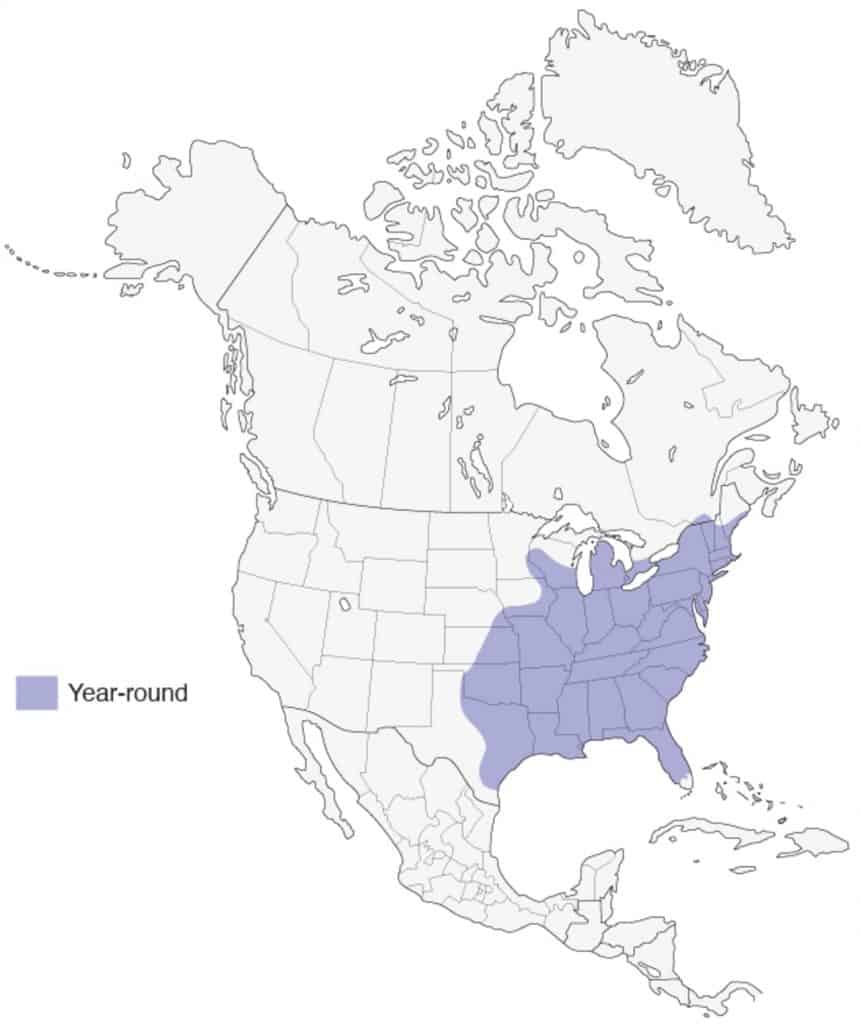
Orange-Crowned Warbler
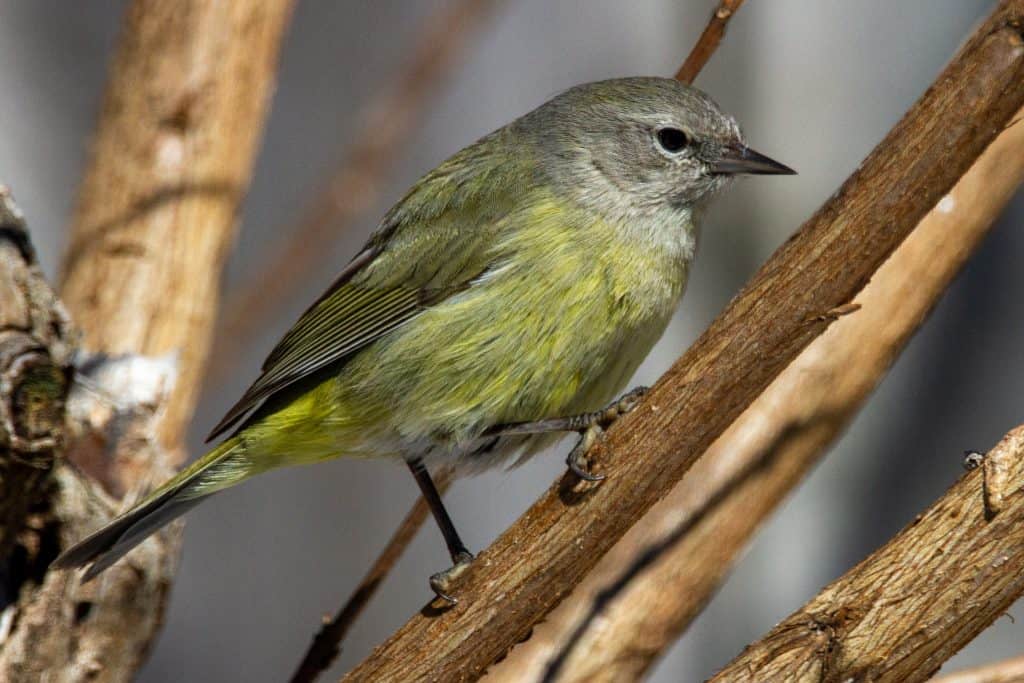
Appearance: The orange-crowned warbler is a small bird about 5″ long. They are olive-green and yellow throughout with an orange crown that is barely visible. There’s a subtle dark line that runs through the eyes. They have yellow underneath that’s smudged with olive green.
Diet: Insects, small berries, and nectar.
Feeder food: Suet and peanut butter spread.
Habitat: The orange-crowned warbler is found in a variety of habitats within its range from low-growing shrubs and thickets to coastal canyons and backyard gardens.
Nesting: They build a cup-shaped nest of twigs and other plant material placed on or near the ground. They have 1 brood/season and 3-6 eggs/brood. The eggs are white/creamy with spots. Incubation is for 11-13 days and fledglings leave the nest at 10-13 days.
Migration: Orange-crowned warblers are migrators. In the spring they migrate north and west to breed and raise young. Then in the fall, they migrate south for winter. That said, they have a small year-round range along the pacific coast (Washington, Oregon, and California) where they remain year-round.
Year-round range: Along the pacific coast of Washington, Oregon, and California.
Breeding range: Alaska, Washington, Idaho, western Montana, Wyoming, Oregon, northern California, Nevada, Utah, Colorado, New Mexico, and all Canadian provinces except Nunavut.
Winter range: Southwest California, southwest Nevada, Mexico, the southern parts of Texas, Mississippi, Alabama & Georgia, South Carolina, southern Texas, Louisiana, Florida, and Mexico.
Range Map
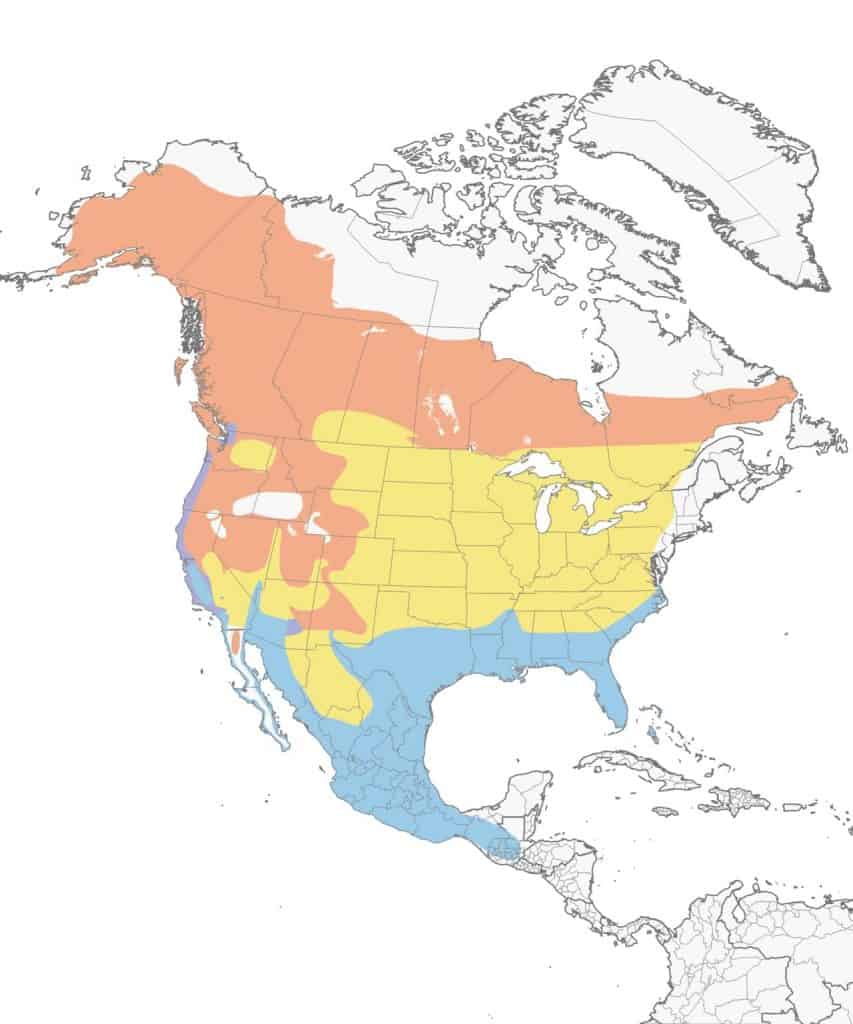
Ovenbird
| Appearance | Small bird about 5″ long. Olive-green with dark brown stripes on chest and belly, black and orange stripes on crown. Black eyes surrounded by a white eyering. Pink legs and short pointy tan bill. The female is the same. |
| Diet | Insects, sometimes seeds. |
| Feeder Food | Unlikely to visit a feeder. |
| Habitat | Forested areas with deciduous and coniferous trees that offer a canopy. |
| Nesting | They nest on the forest floor deep inside the thick trees. They have 1-2 broods/year, 3-6 eggs/brood that are white with brown specks. Incubation is 11-14 days. |
Range Map
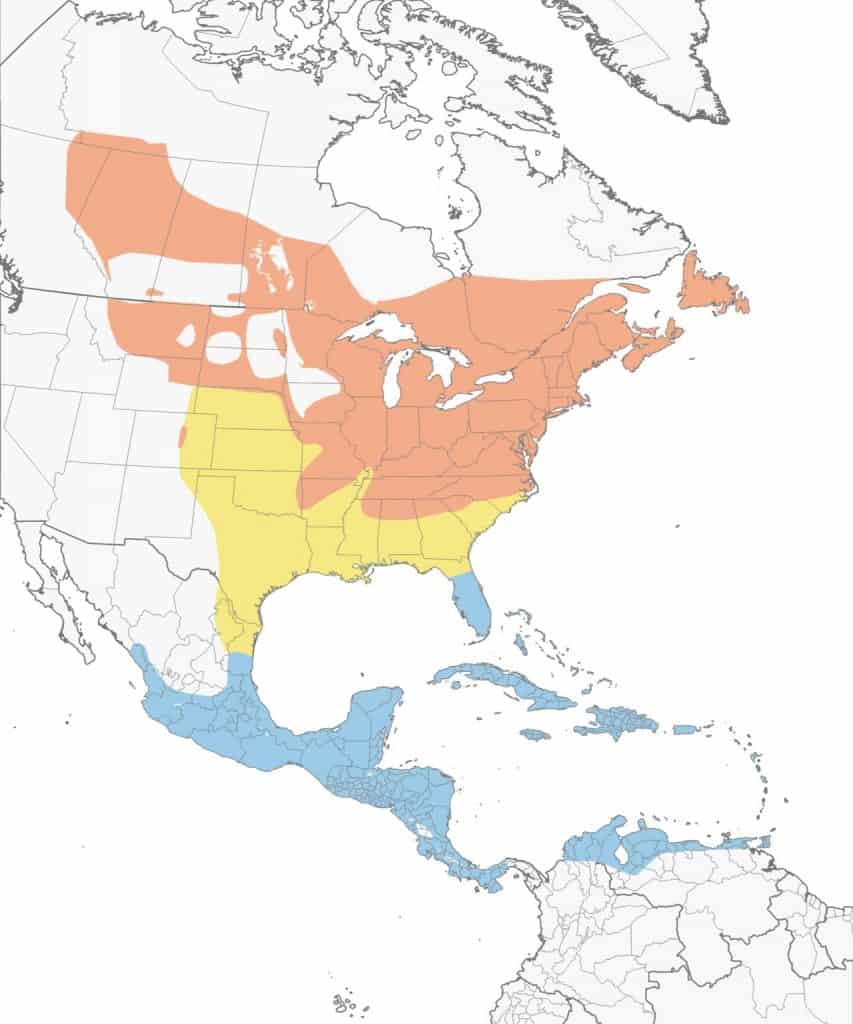
Pileated Woodpecker
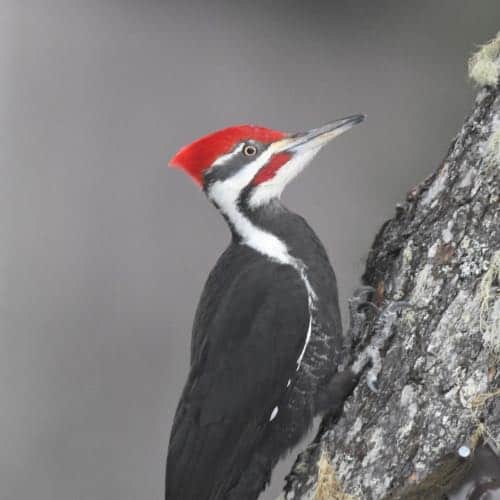
Appearance: A large bird about 19″ in length. They’re mostly black with white stripes on their face and neck with white underwings. The flaming red triangle-shaped crest is unmistakable and the male also has a red stripe on his cheek. The female is the same except her crest does not go all the way to her bill. And, she does not have a red stripe on her cheek.
Diet: Insects, especially carpenter ants.
Feeder food: Suet, shelled peanuts, safflower seed, sunflower seed, and
songbird fruit & nut seed mix.
Habitat: Forests and wooded areas that offer tall deciduous (leafy trees like maple & beech), coniferous trees (like evergreen & pine), and lower fruit & nut-bearing trees & shrubs.
Nesting: They excavate their own cavity in a tree. They have 3-6 white eggs per brood and incubate them for 15-18 days.
Migration: Pileated woodpeckers are not migrators. They remain in their year-round range every season of the year.
Year-round range: Canada’s southern provinces, the west coast of Washington, Oregon & California, and the eastern half of the US.
Range Map
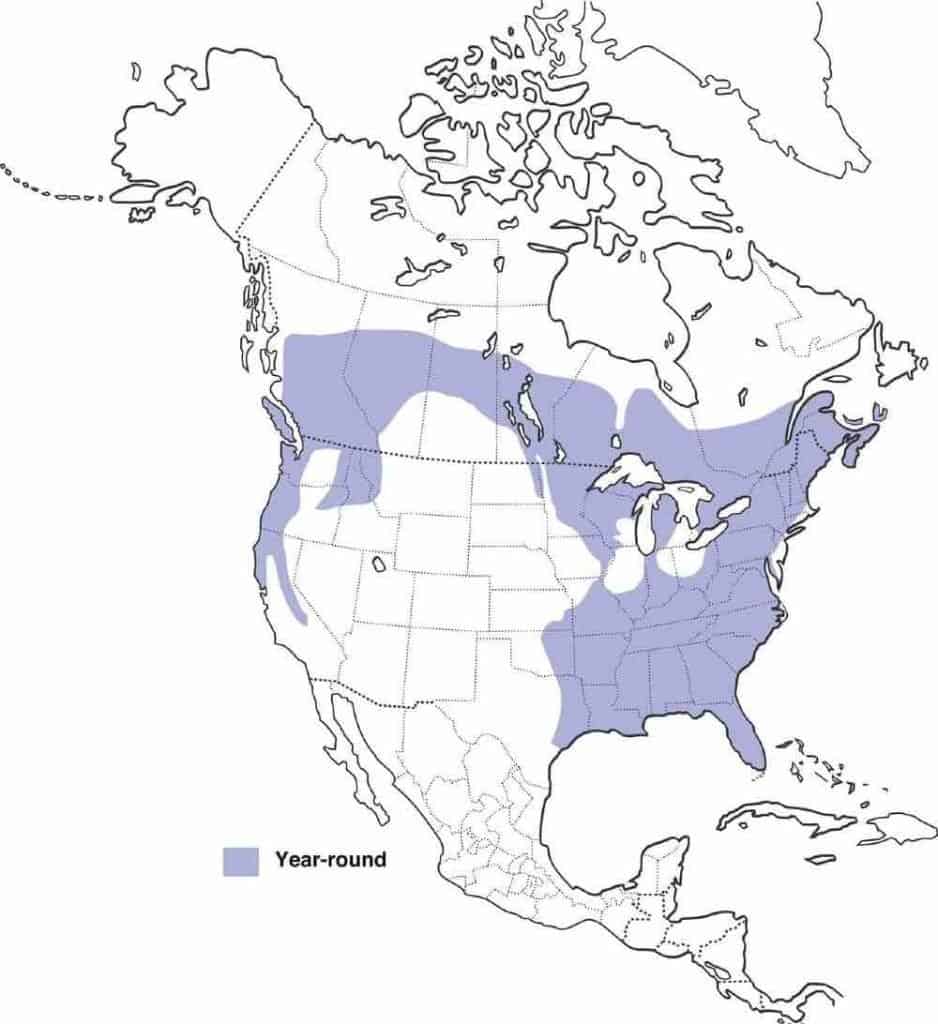
Pine Siskin

Appearance: Small brown bird about 5″ long with streaks on the back, breast, and belly. They have some yellow in the wing bars at end of the tail. The Female is the same.
Diet: Seeds, insects.
Feeder food: Black-oil sunflower seeds, hulled sunflower seeds, suet & fruit.
Habitat: Open areas, wooded edges.
Nesting: Cup-shaped nest for 2 broods/year. 3-4 eggs/brood that is green/blue with brown spots. Incubation is 12-13 days.
Migration: While some pine siskins remain in their year-round range, most are migrators. In spring, the migrators head south to Canada to breed and raise their young. Then in the fall, they migrate south for the winter.
Year-round range: The northern edge of the US, the Pacific Northwest states, the southern edge of the Canadian provinces, and the central strip of Mexico.
Breeding range: Alaska’s southeastern corner, the southern part of Canada’s Northwest Territories, the northern part of British Columbia, Alberta, Saskatchewan, Manitoba, Ontario, and Quebec.
Winter range: The entire US (outside of the year-round range).
Range Map
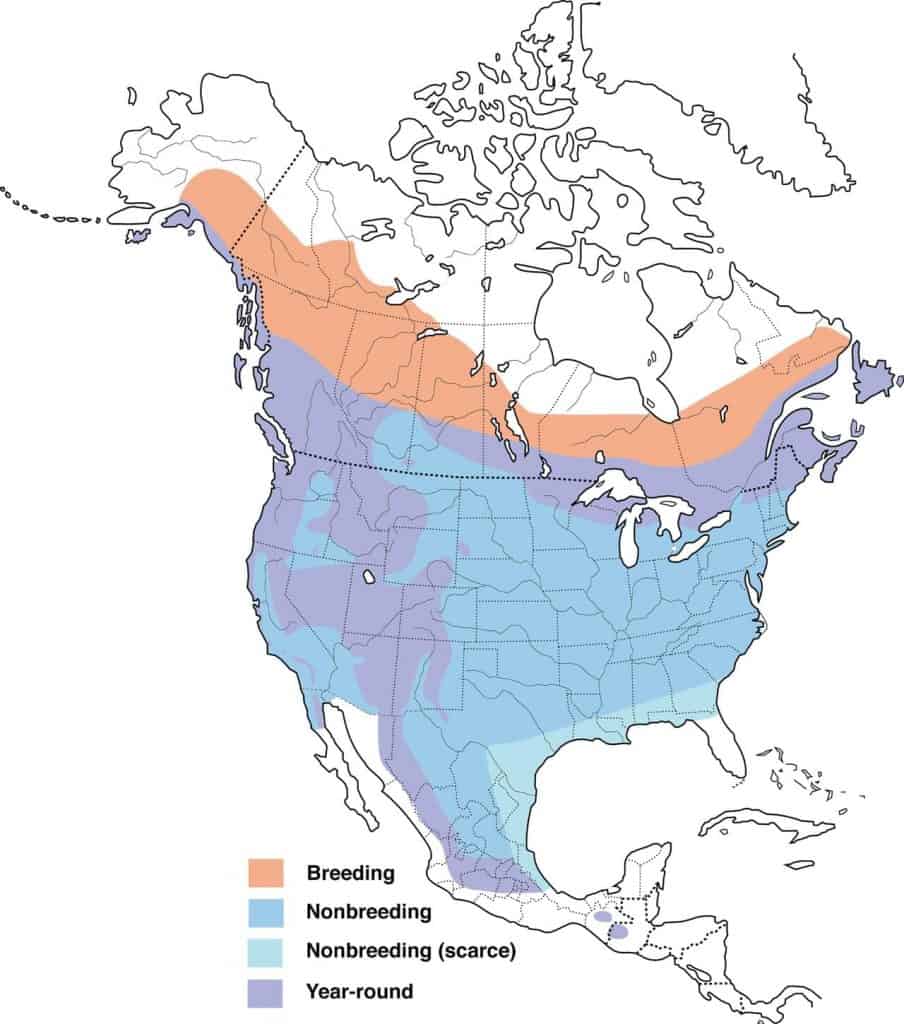
Pine Warbler
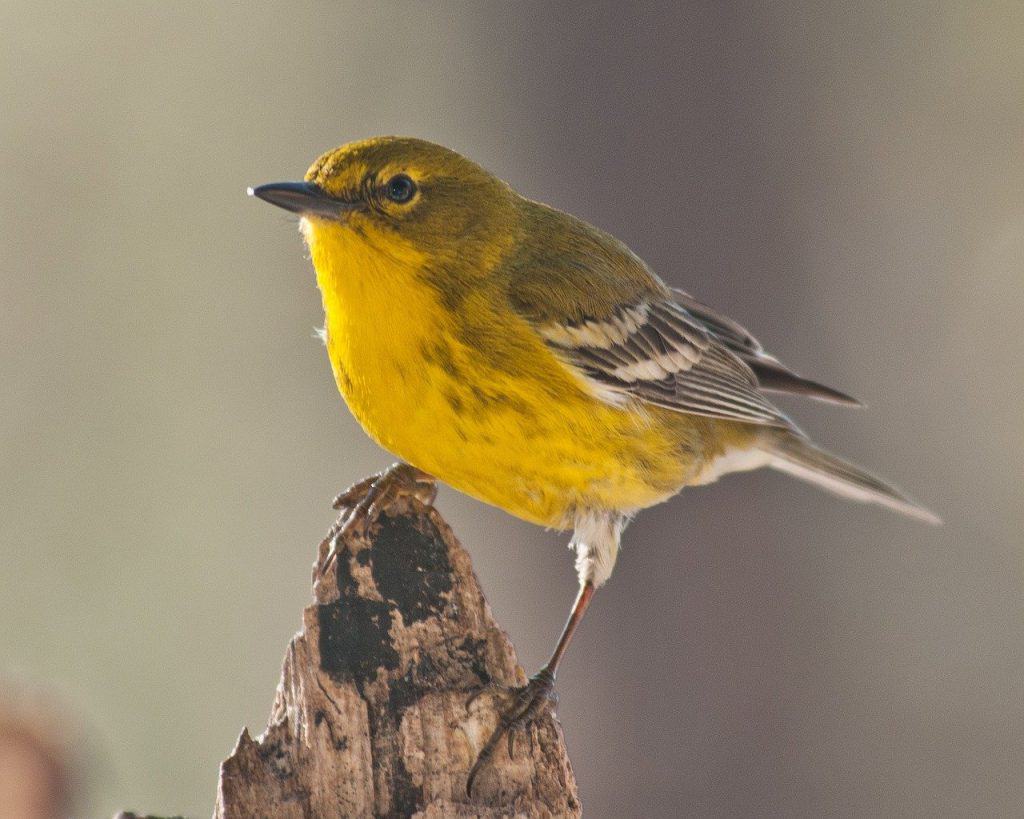
Appearance: The pine warbler is a yellow bird about 5 1/2″ long. The wings are brown with white and rump tan. They have short stubby bills, a subtle dark streak behind the eye, and bright yellow eyering. The female is duller and has a white belly.
Diet: Insects, berries, and seeds.
Feeder food: Millet, sunflower seed, cracked corn, peanuts, and suet.
Habitat: Mixed forested areas.
Nesting: Pine warblers build their open-cup nest high in a pine tree – as high as 50′ up. They have 1-2 broods/season and 4 eggs/brood. Incubation is for 10 days and fledglings leave the nest after 10 days.
Migration: Many pine warblers are migrators. While a population of this species remains in their year-round range all seasons of the year, many migrate north and east to in spring to breed and raise their young. Then in the fall, the migrators return south to the year-round range of further southwest to the winter expanded range.
Year-round range: Texas, Oklahoma, Arkansas, Mississippi, Alabama, Georgia, Florida, South Carolina, North Carolina, and Virginia.
Breeding range: northern Minnesota & Wisconsin, Michigan, southern Illinois & Indiana, eastern Ohio, Kentucky, Tennessee, and New England.
Winter range: Southeast Texas, southern Arkansas, and Louisiana.
Range Map
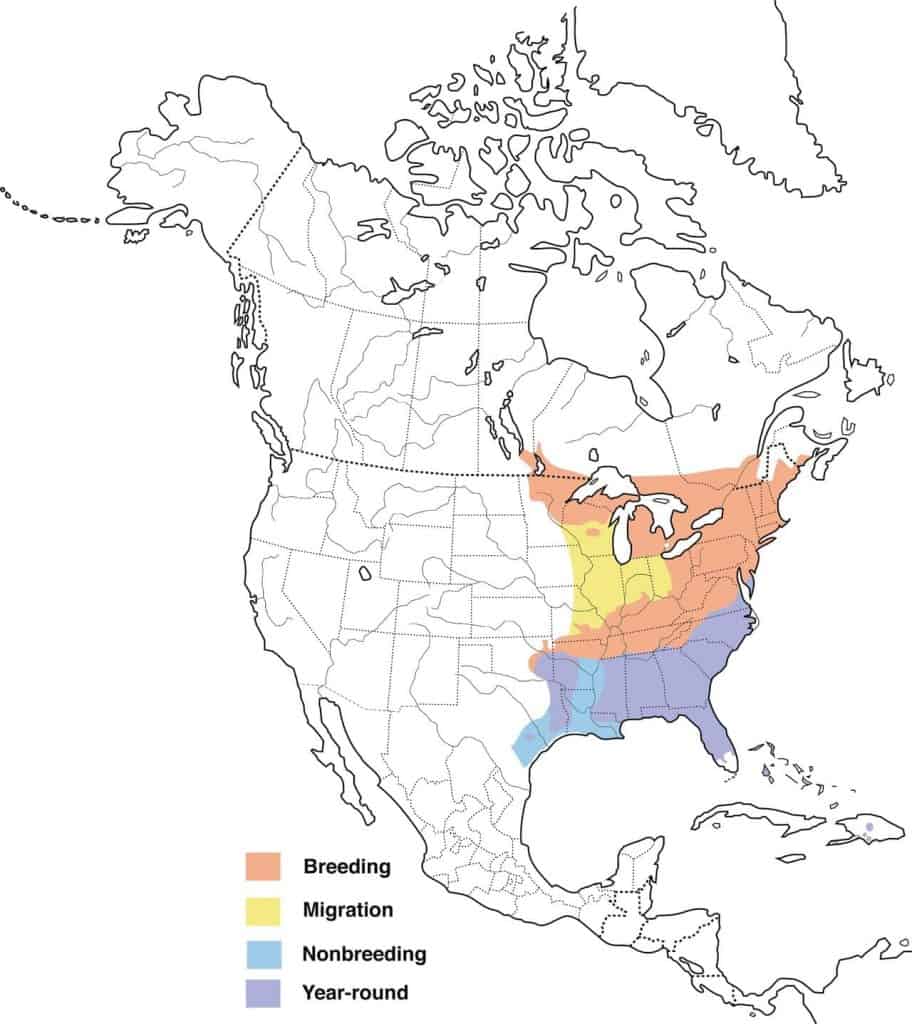
Prairie Warbler
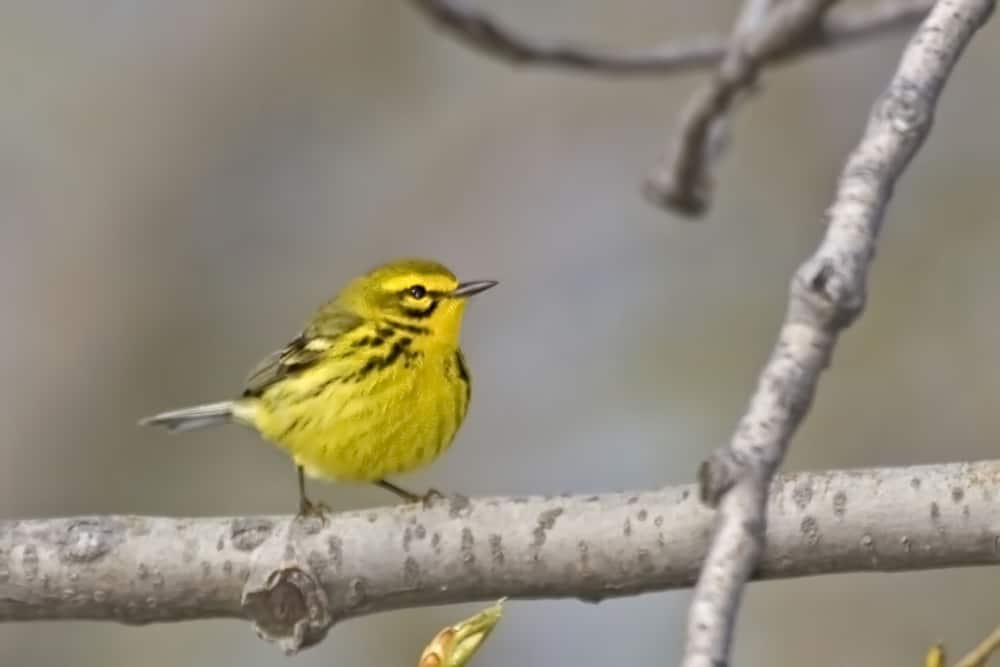
| Appearance | A small yellow bird about 4 1/2″ long with black streaks on the belly, black eyeline,r and swipe under the eye. A chestnut patch shows on the back. Females are the same but more muted with a gray head and white eyering. |
| Diet | Insects and snails. Fruit and other plants on occasion. |
| Feeder Food | Unlikely to visit a feeder. |
| Habitat | Low woody vegetation with plenty of open canopies, edges of wooded areas. |
| Nesting | Nests are cup-shaped and located in thick tangles of shrubs less than 7 feet high. They have 1-2 broods/year, 3-5 eggs/brood that are brown/gray with scattered spots. Incubation is 10-15 days. |
Range Map
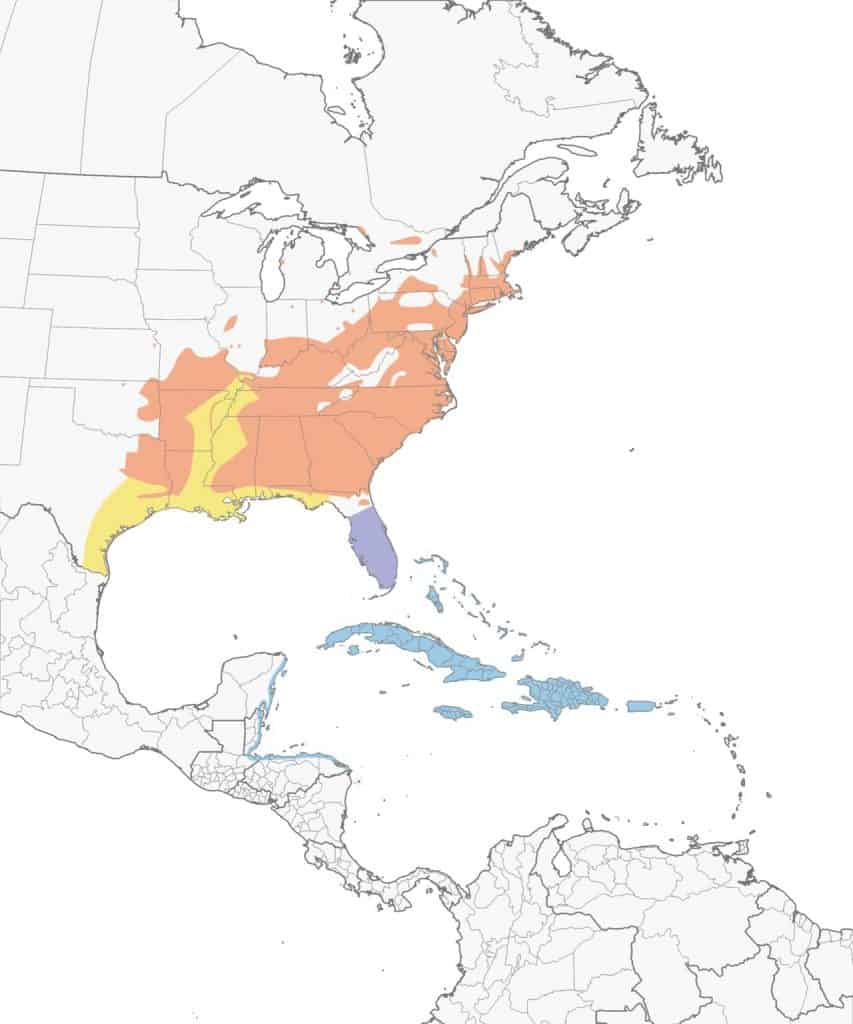
Purple Finch

Appearance: Small bird about 6″ long with a raspberry-red head with lighter shades on the breast, back, and rump. The wings and tail are brown. Females are brown with brown striped breasts and white streaks across their eyes.
Diet: Seeds, insects, and fruit.
Feeder food: Black oil sunflower seeds are their favorite.
Habitat: Prefer coniferous forests in summer along with mixed forests near streams and tree-lined backyards.
Nesting: Purple finches’ nests are found anywhere from 2-60′ off the ground on a tree branch and constructed from twigs, sticks, and plant roots. Lined with grass and hair.
Migration: Purple finches are migrators. While many of them remain in their year-round range, others migrate north in the spring to breed and raise young. Then in the fall, the migrators head south for the winter.
Year-round range: The Pacific coast of Washington, Oregon, and California, and Canada’s British Columbia.
Breeding range: Just east of the year-round range along the Pacific northwest states and Canada’s provinces except for Nunavut.
Winter range: The eastern half of the US (except New England) and southern Arizona.
Range Map
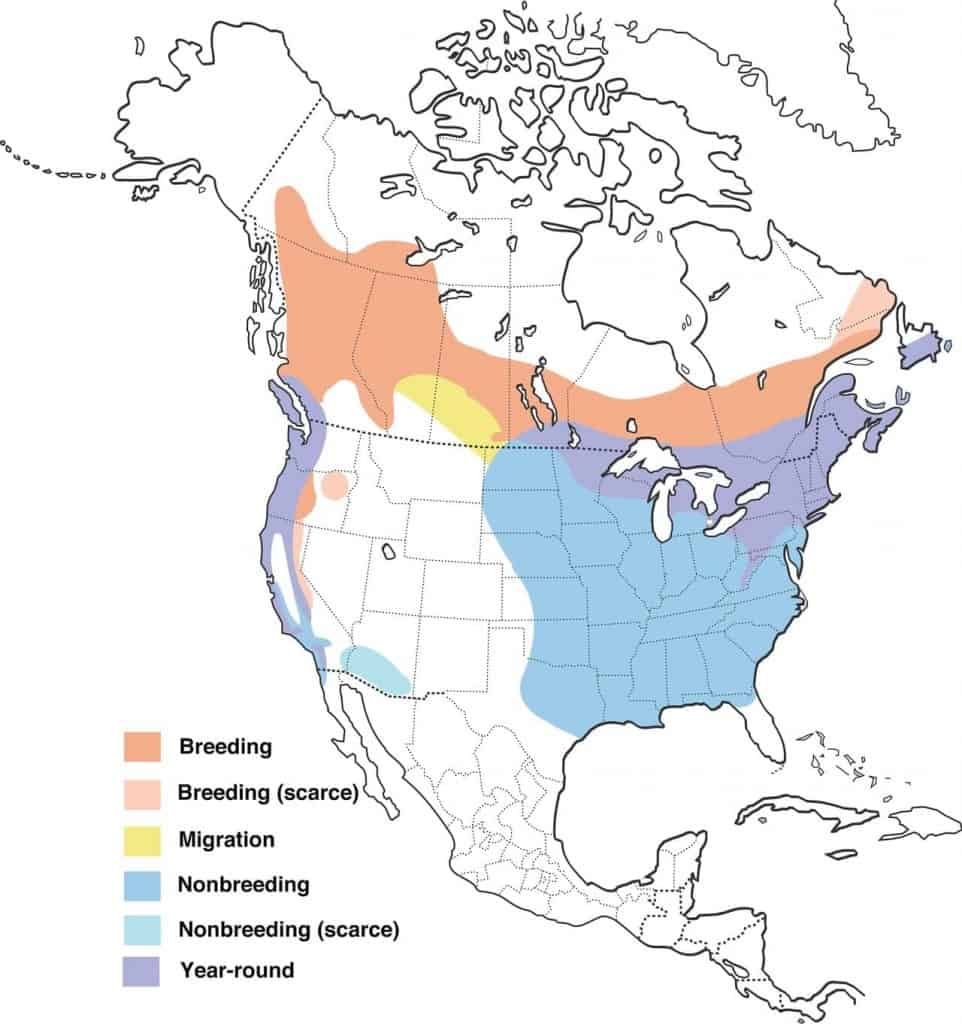
Purple Martin
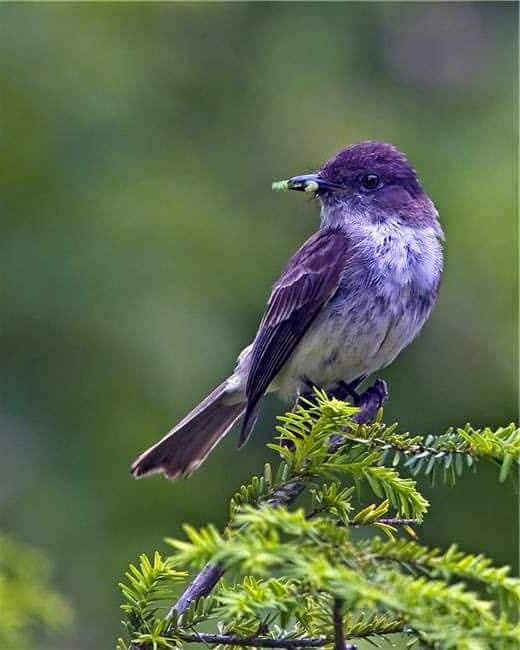
Appearance: The purple martin is a medium bird about 8.5″ long with a blue/purple head, back, and belly with black wings and tail.
Diet: Insects especially dragonflies.
Feeder food: Unlikely to visit a feeder.
Habitat: Usually within 100′ of human dwelling. Purple Martins exist in large colonies.
Nesting: Purple martins are cavity nesters. They primarily use manmade nest boxes which accommodate a colony of birds. They have 1 brood/season, 4-5 white eggs/brood, 15-18 days incubation, and fledge after 26-30 days.
Migration: Purple martins are migrators. They spend the winters in South America and migrate north to breed and raise young.
Breeding range: Pacific northwest coast of Washington, Oregon, and California, parts of Arizona, Utah, and Colorado, the eastern half of the US, and the southern parts of Canada’s Alberta, Manitoba, Saskatchewan, and Ontario.
Winter range: South America
Range Map

Red-Bellied Woodpecker
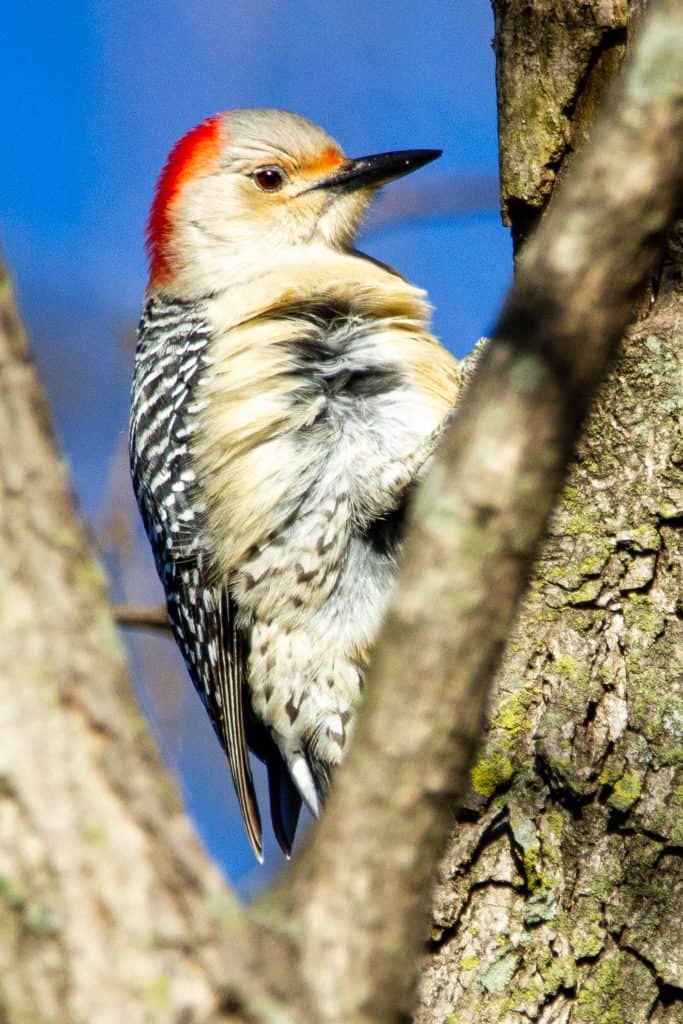
Appearance: The red-bellied woodpecker is a medium-sized bird about 9 1/4″ long. They have a zebra-like striped back with a white rump. The red crown extends down the nape of the neck. The chest is tan with just a tinge of red on the belly. The females are the same except they don’t have a red crown.
Diet: Insects, nuts, fruit.
Feeder food: Suet, hulled peanuts.
Habitat: In or near forests and woodlands.
Nesting: Red-bellied woodpeckers are cavity nesters and prefer dead trees or fence posts. They have 1-3 broods/year and 2-6 eggs/brood. Eggs are white without markings. Incubation is 12-14 days.
Migration: Red-bellied woodpeckers are not migrators. They remain in their year-round range all seasons of the year.
Year-round range: Eastern half of the US but not New England.
Range Map
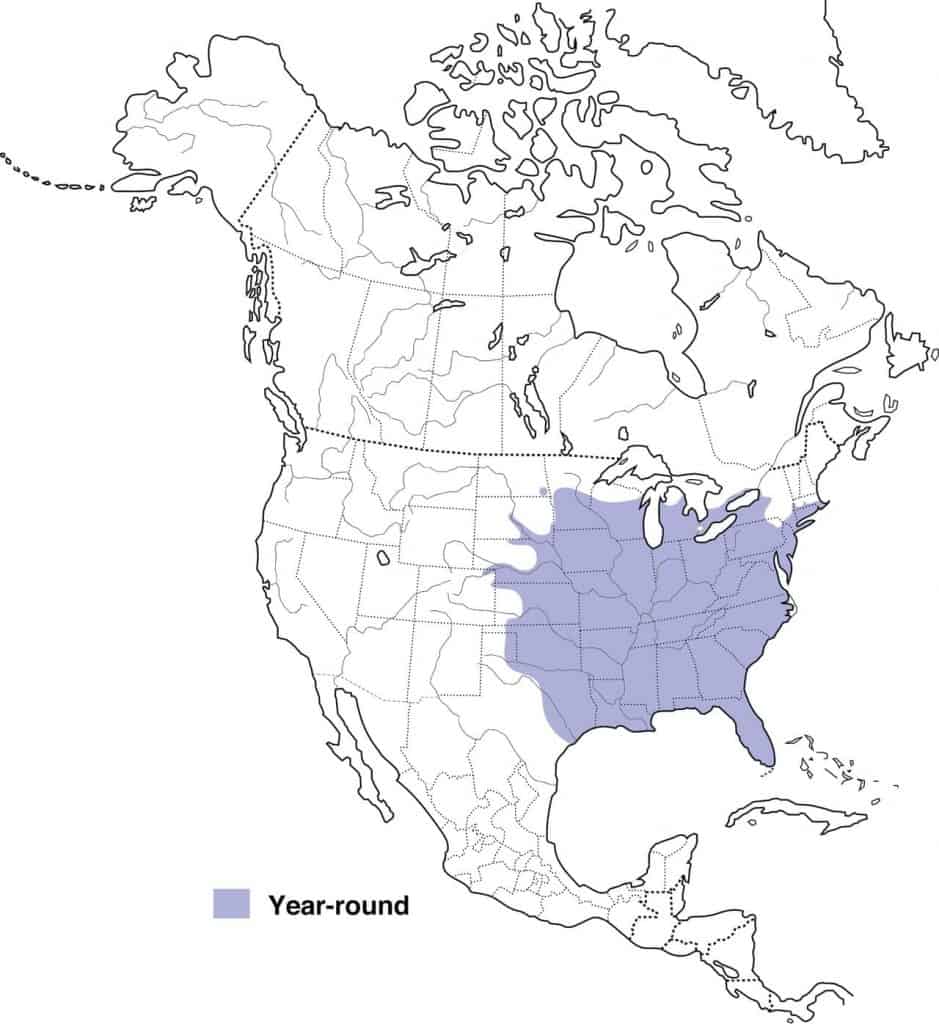
Red-Breasted Nuthatch
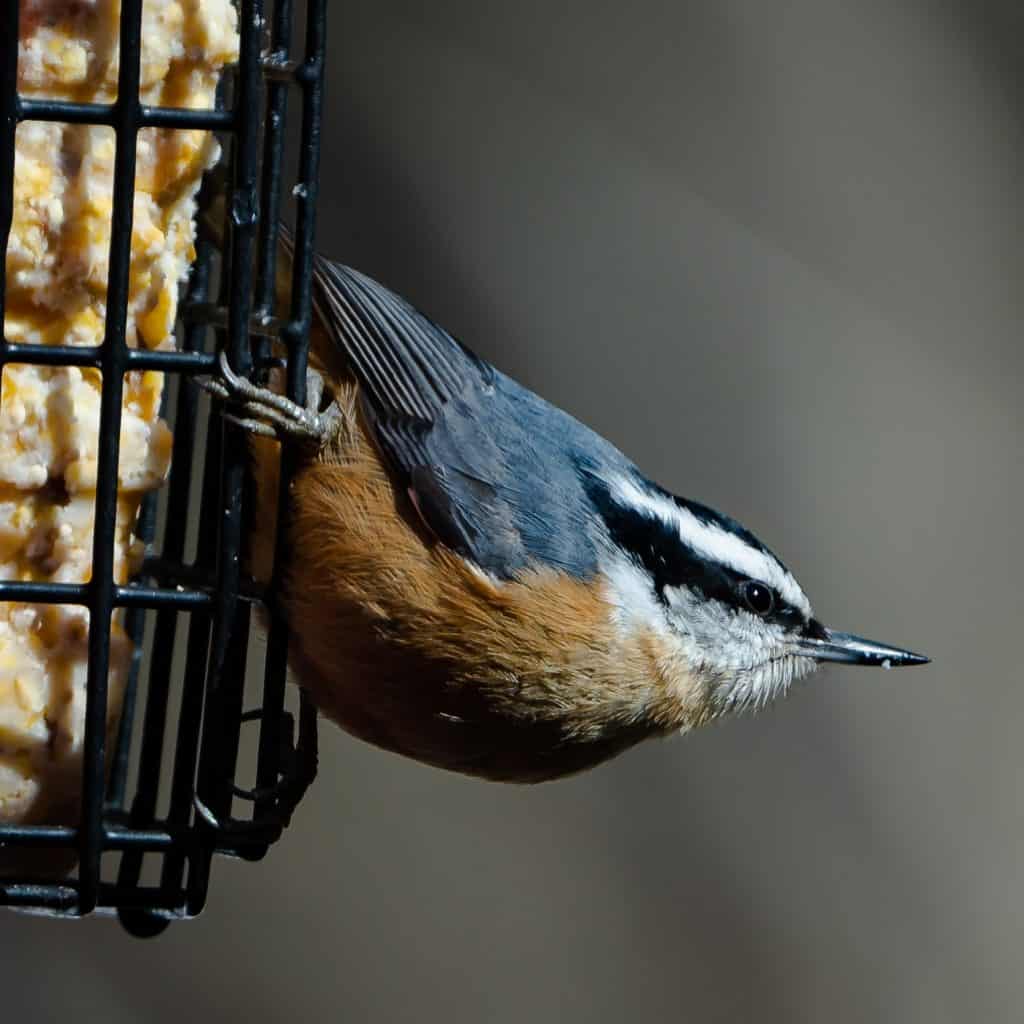
Appearance: The red-breasted nuthatch is a small bird about 4.5″ long, with gray/blue backs, a white head with black stripes running over either eye, orange-cinnamon-colored breast, and a pointy pick-like beak. The females look the same except their underside is a more faded color. Usually spotted climbing upside-down on a deciduous tree foraging for insects beneath the bark.
Diet: Insects, spiders, and other bugs.
Feeder food: Suet, sunflower seeds, shelled peanuts, fruit.
Habitat: Forested areas primarily comprised of coniferous trees (i.e. pines). Woodsy areas of deciduous trees in the east. Southern birds prefer mountainous regions until winter comes in which case they head to lower land.
Nesting: Red-breasted nuthatches are cavity nesters and they prefer to excavate their own holes. They have 1 brood/season, and 6 eggs/brood, eggs are white & speckled with red-brown.
Migration: Red-breasted nuthatches are partial migrators. While many remain in their year-round range, others migrate south for winter.
Year-round range: Southern Alaska, states in the western third of the US, northern Minnesota & Wisconsin, Michigan, Pennsylvania, and New England as well as all Canadian provinces except Nunavut.
Winter range: US states that are not part of the year-round range.
Range Map

Red-Eyed Vireo
| Appearance | Small bird about 6″ long. Olive-green bird with a black stripe above and across eye, gray crown, white underparts, and red eyes. Short pointed bill. Females are the same. |
| Diet | Insects and small fruits. |
| Feeder Food | Unlikely to visit a feeder. |
| Habitat | Mature deciduous forests and mixed pin forests as well as residential areas and parks. |
| Nesting | Nests in a low tree or shrub between 5-10′ up. They have 1-2 broods/year, 3-5 eggs/brood, and are incubated for 11-14 days. |
Range Map
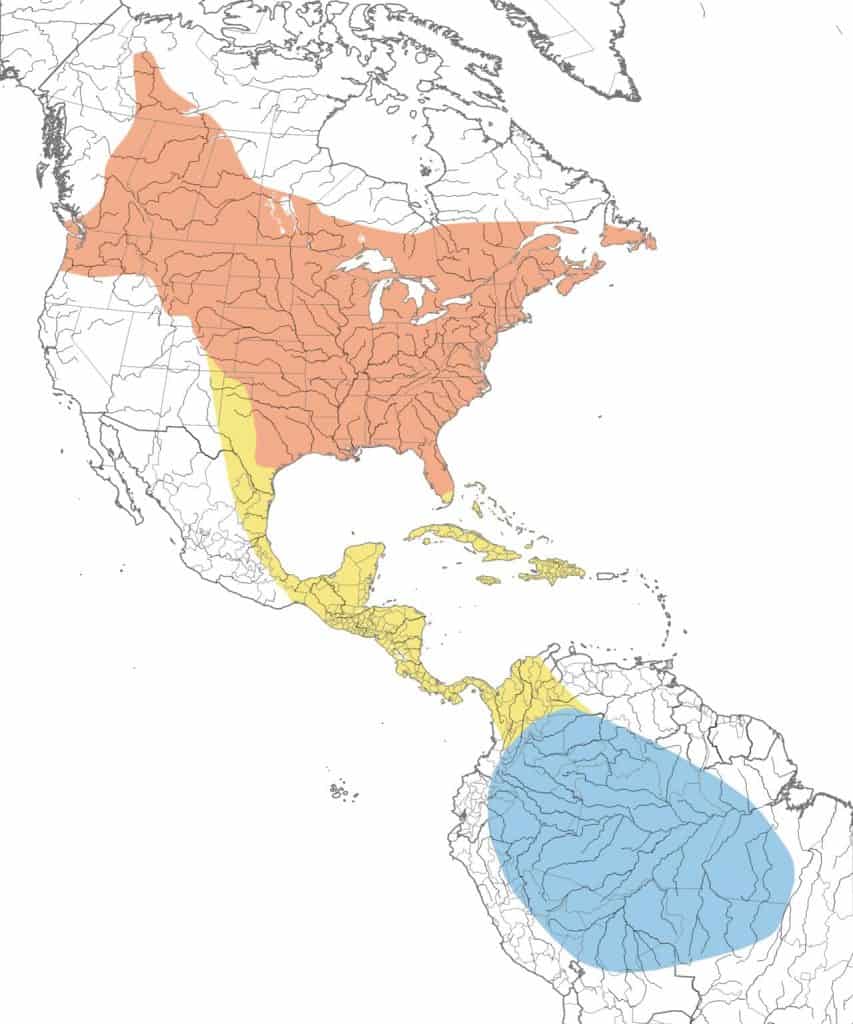
Red-Headed Woodpecker
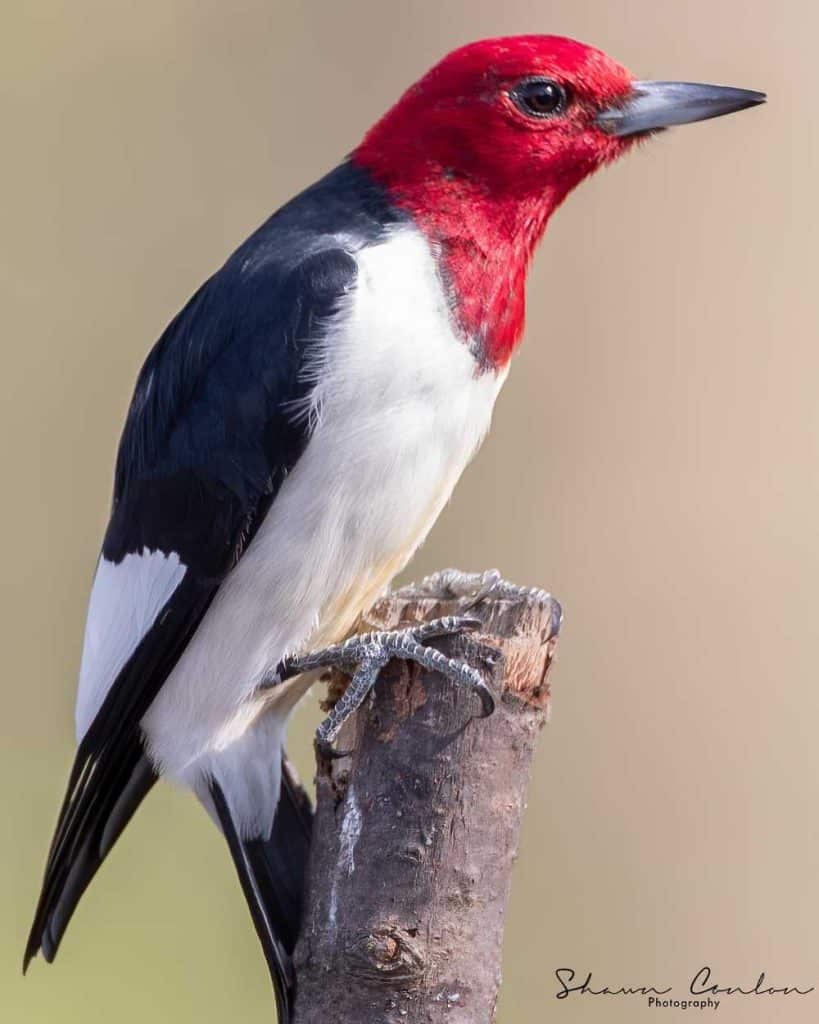
Appearance: Red-headed woodpeckers are medium-sized birds about 9″ long with a red head, black back, white rump, chest, and belly. Also has white patches on its wings, black tail, and gray legs and bill. The female is the same as the male.
Diet: Insects, fruit, nuts, and seeds.
Feeder food: Suet and hulled peanuts.
Habitat: During the breeding season, they prefer open woodlands especially when ample deciduous trees are present, as well as short-grass meadows, pastures, or even golf courses. In the winter they can be found in tall grass prairies with plenty of oak trees and anywhere a mass of acorn crops are present.
Nesting: Red-headed woodpeckers are cavity nesters and will choose a tree hole or manmade nesting box. They have 1 brood/year, 4-5 white eggs/brood, and incubate for 12-13 days.
Migration: Some, but not all, red-headed woodpeckers are migrators. In spring they’ll remain in their year-round range for breeding or head west and north into Canada to reproduce. In fall, especially when the supply of acorns wains, they’ll migrate south back to their year-round range and if crops are really poor, southwest into Texas.
Year-round range: From Oklahoma and eastern Kansas east to Pennsylvania and Maryland, and south throughout the southeast United States.
Breeding range: Some red-headed woodpeckers breed in the year-round range (see above) while others head west and north – as far north as southern portions of Saskatchewan and Manitoba, Canada, and as far west as central Montana. Few reach the southeastern portion of Quebec.
Winter range: Most red-headed woodpeckers winter in their year-round range while a few heads further southwest into central Texas and southern Louisiana. The winter movement is highly dependent on acorn supplies. When in abundance, red-headed woodpeckers may not migrate from their year-round range at all.
Range Map
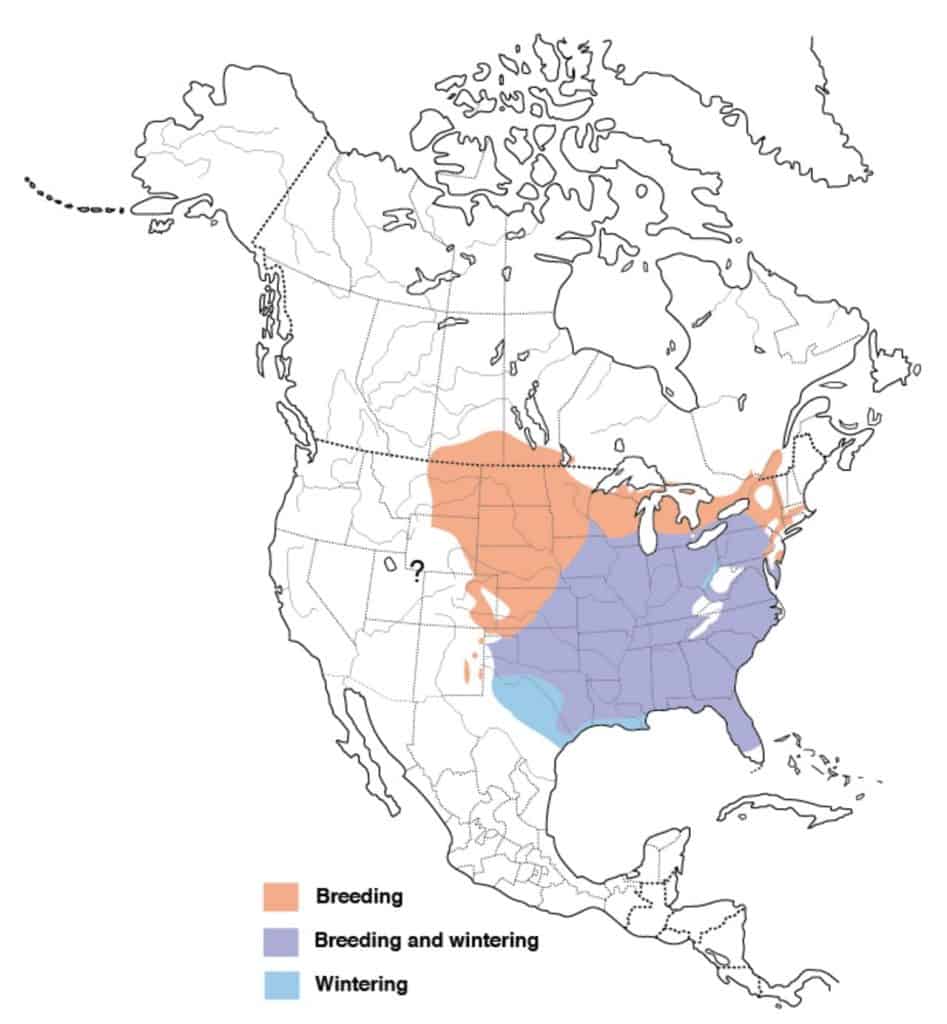
Red-Winged Blackbird
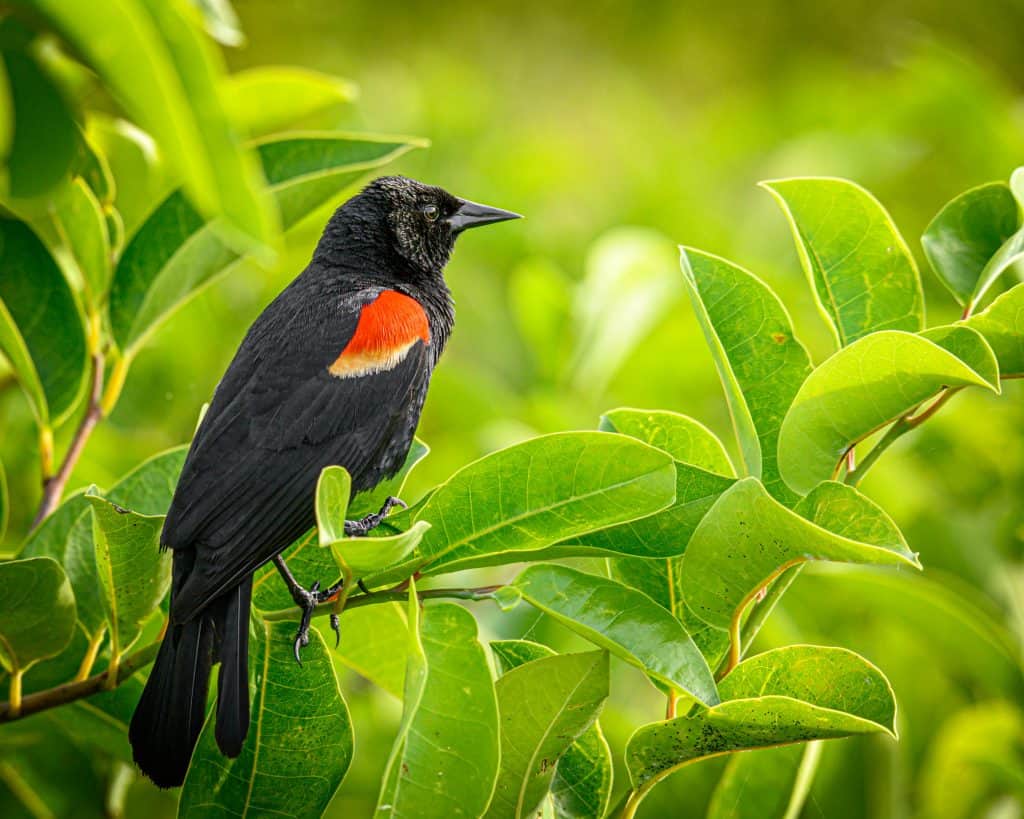
| Appearance | A medium-sized jet-black bird about 8 1/2″ long with a red and yellow patch on the shoulder of the upper wing. Pointy black bill. The females are brown and heavily streaked. She has white eyebrows and a brown bill. |
| Diet | Insects, seeds. |
| Feeder Food | Black-oil sunflower seed, hulled sunflower seeds, cracked corn, peanut hearts, millet. |
| Habitat | Wet areas like marshes but also found in meadows, fields, and even wooded edges. |
| Nesting | Nest: Cup-shaped nest located low in shrubs or trees. Broods: 1-2 broods/year Clutch: 2-4 eggs/brood Egg color: Bluish-green to gray with brown or black markings Egg size: 1″ by about .6 – .8″ Incubation: 10-12 days. |
Range Map
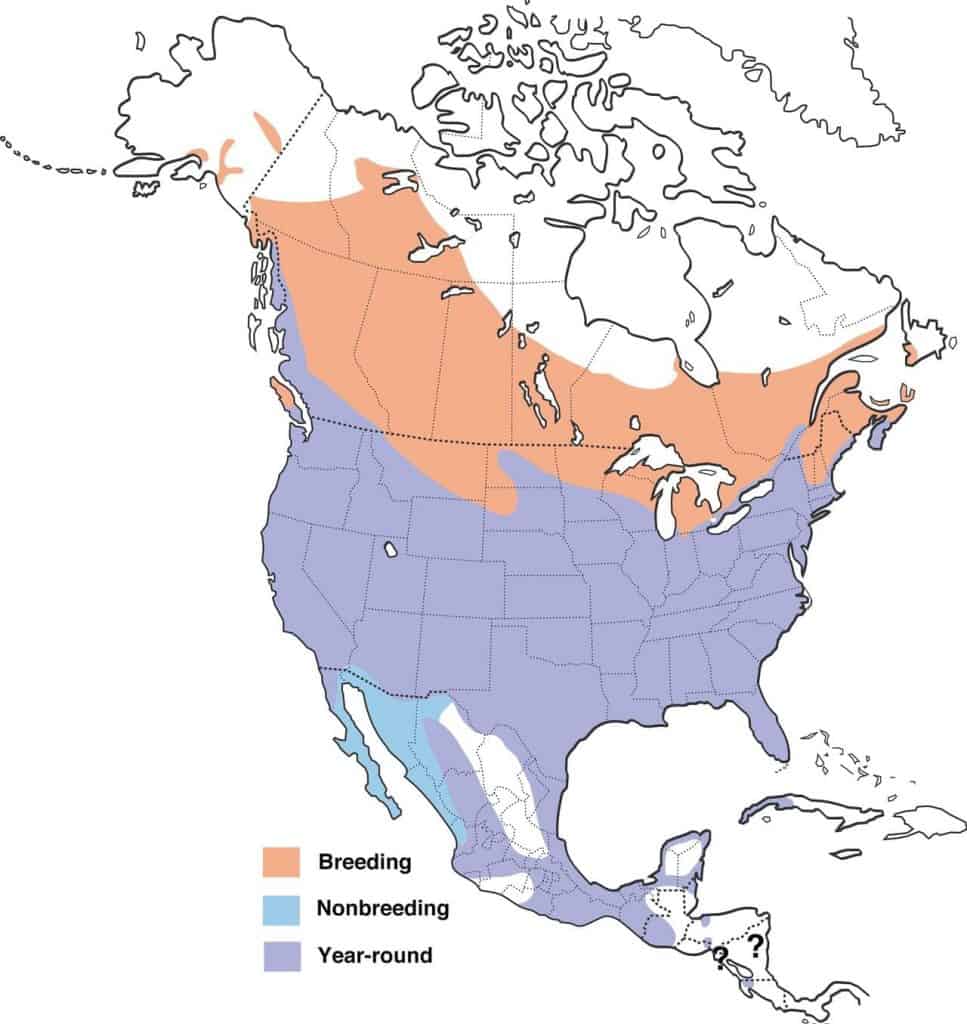
Ring-Billed Gull

| Appearance | Ring-billed gulls are about 17 1/2″ long. They’re light gray above and white below. The bill is yellow with a black ring. Their legs and eyes are yellow. |
| Diet | Scavenges along water edges for garbage refuse, fish, insects, earthworms, and grains. |
| Feeder Food | They don’t visit feeders. |
| Habitat | In and around water. |
| Nesting | Ring-billed gulls are ground nesters. They have 1 brood/season and 2-4 eggs/brood. Incubation lasts 20-31 days and fledglings leave the nest after 4-5 days. |
Range Map
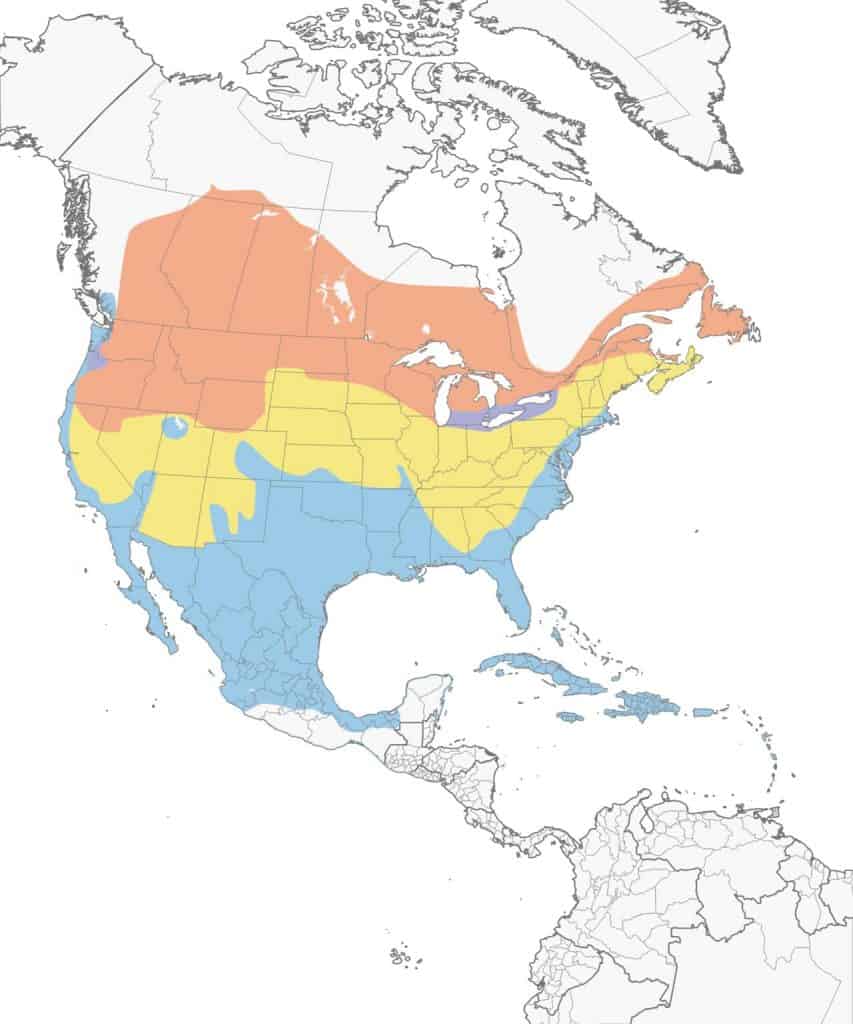
Rock Pigeon
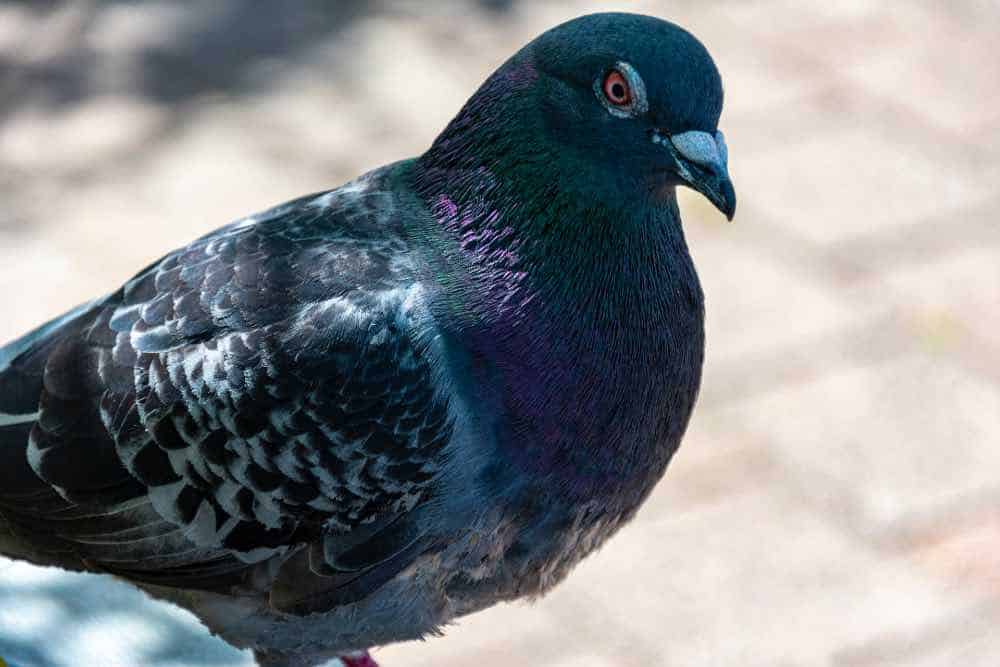
Appearance: Large bird 12-14″ long, chubby with blue/gray wings with black pointy tips, short red legs, black, round wide tail, and iridescent neck.
Diet: Grains, seeds, and fruit. Commonly seen scavenging trash cans for food.
Feeder food: Millet, cracked corn, black-oil sunflower seed, safflower, peanut hearts.
Habitat: Common around cities and towns as well as farmlands
Nesting: Rock pigeons build a large nest of sticks and grass wherever there’s a ledge (e.g. highway overpass, barns, bridges, tall buildings). 1-6 broods/year, 1-3 eggs/brood, eggs are white, incubation about 18 days and the young fledge at about 25-32 days.
Migration: Rock pigeons are not migrators. They remain in their year-round range all seasons of the year.
Year-round range: Every US state, the southernmost edges of Canada, and Mexico.
Range Map
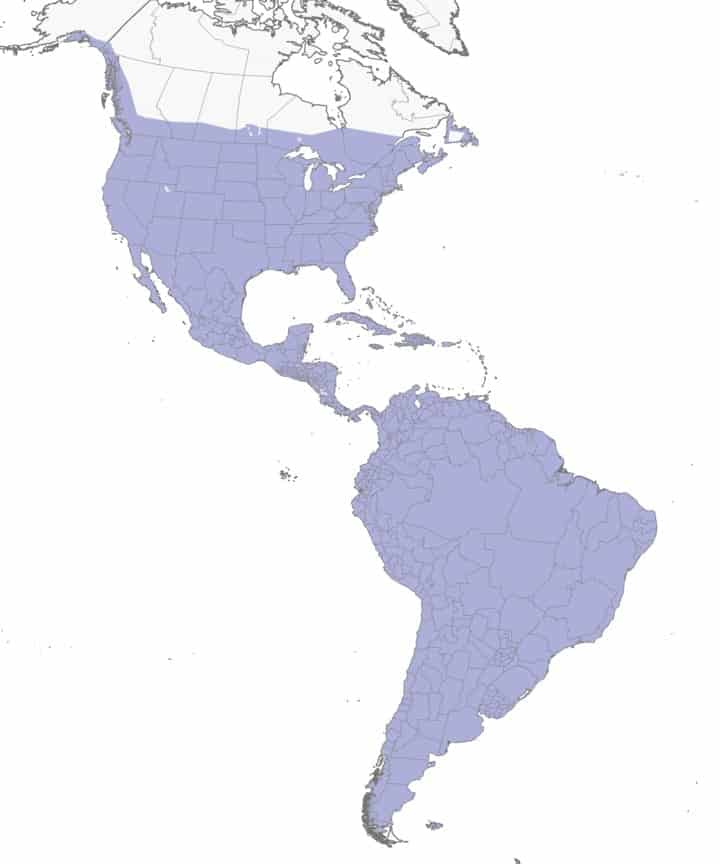
Rose-Breasted Grosbeak

| Appearance | A small bird about 7-8″ long. They’re black-and-white with a large red rose patch on the center of the chest. The wings are lined with rosy red. Large ivory bill. The females are streaked brown and white. Wings are lined with orange-yellow and they have a large white eyebrow line. |
| Diet | Insects, seeds, and fruit. |
| Feeder Food | Sunflower seeds, safflower seeds, and hulled peanuts. |
| Habitat | Mixed forests (deciduous-coniferous), partially open areas, suburban areas, parks, orchards, and gardens. |
| Nesting | The cup-shaped nest is placed on the fork of a tree branch. They have 102 broods/year, 1-5 eggs/brood, and the eggs are blue-green with brown markings. Incubation is 13-14 days. |
Range Map
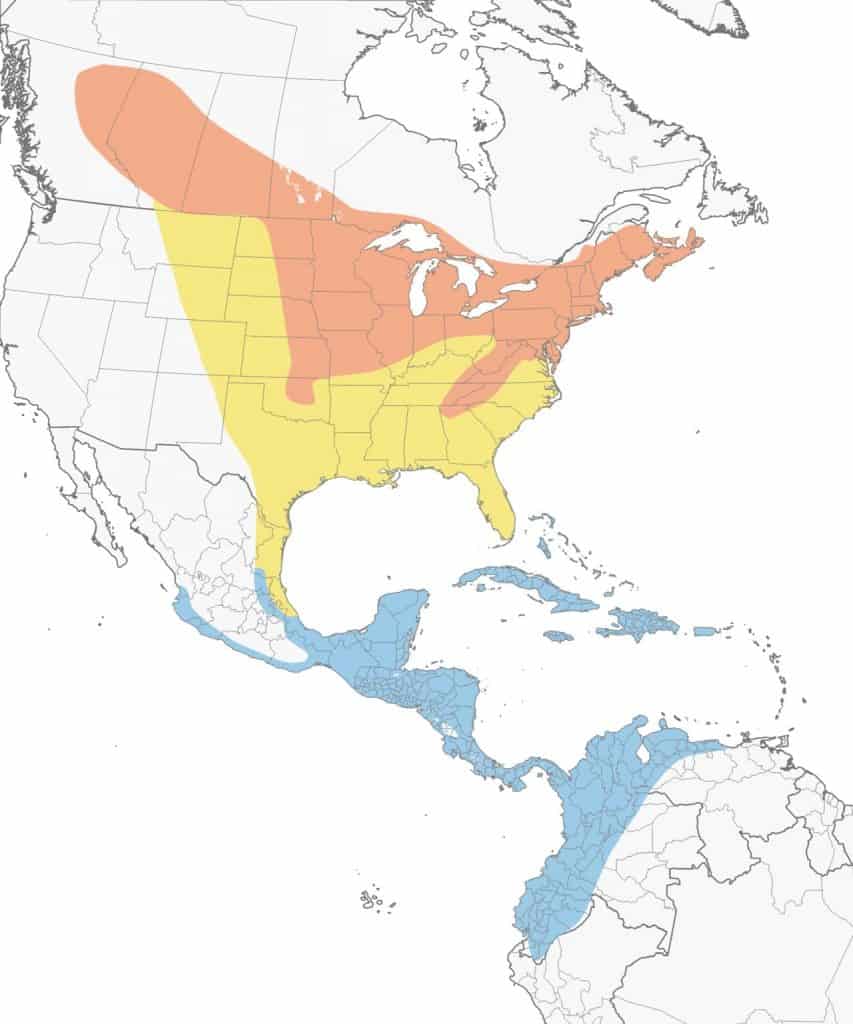
Royal Tern
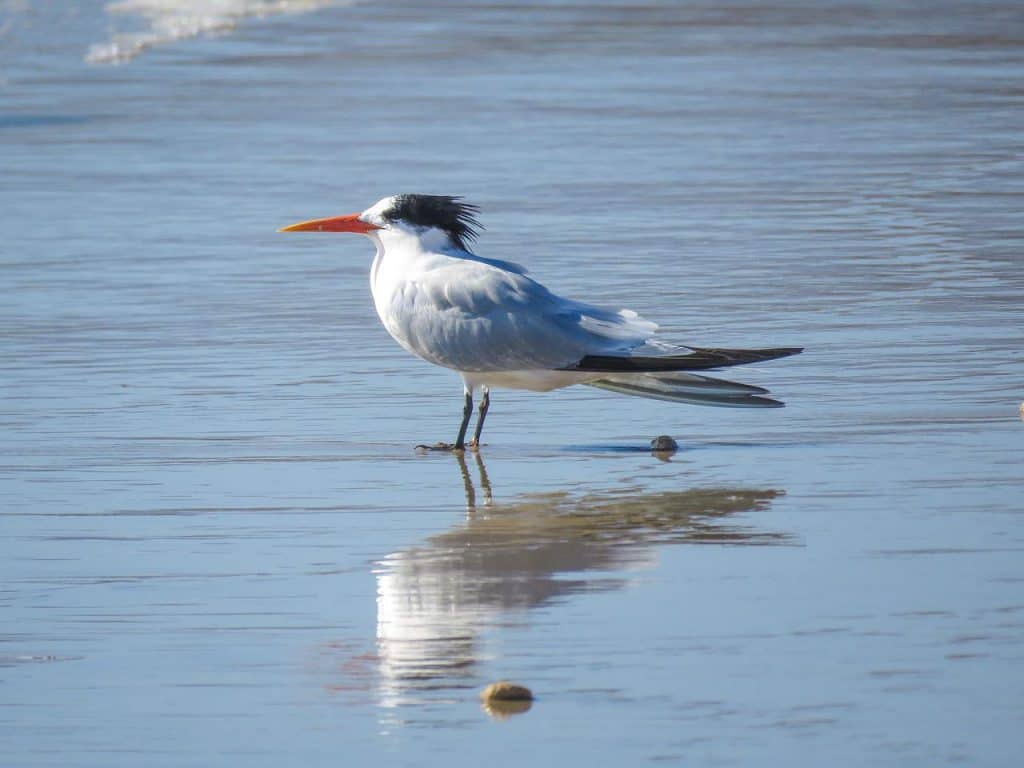
| Appearance | The royal tern is a squatty waterbird about 18″ long with a black crest, bright orange bill, gray above, and white underparts. |
| Diet | Fish, crustaceans, and fish. |
| Feeder Food | N/A |
| Habitat | Shallow, coastal waters and rivers near shore. |
| Nesting | Royal terns are ground nesters. They dig a shallow hole in the sand. Broods: 1 brood/season Clutch: 1-2 eggs/brood Egg color: White/brown with reddish/brown spots Incubation: Incubation is for about 28-35 days. Within 2-3 days after hatching the young leaves the nest. After about 4-5 weeks they’ve taken their first flight. |
Range Map
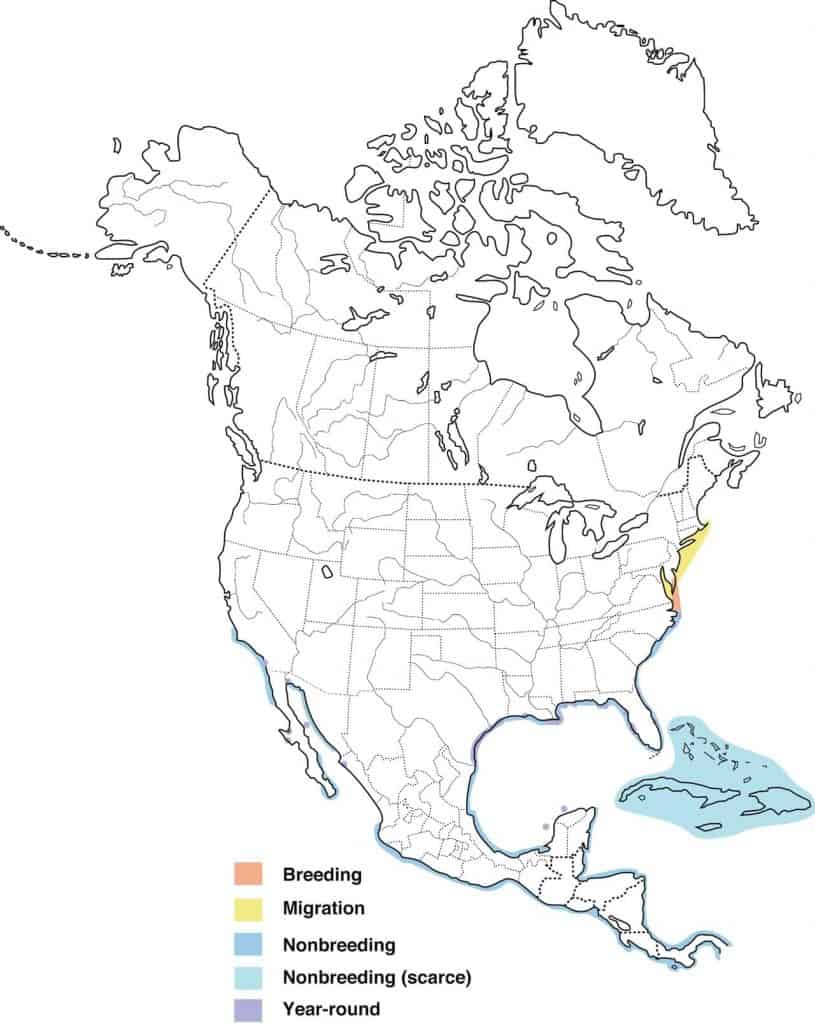
Ruby-Crowned Kinglet
| Appearance | Tiny bird about 4″ long a yellow-green color with two white wing bars and a hidden ruby-colored crown. Dark eyes with white eye-ring. Females look the same but lack the ruby crown |
| Diet | Insects, berries. |
| Feeder Food | Hulled sunflower seeds, suet, peanut hearts, and mealworms. |
| Habitat | Woodlands and forests. |
| Nesting | Nests are placed in trees near the trunk and as high as 100′. They have 1 brood/year, 4-5 white and brown spotted eggs/brood and incubate for 11-12 days. |
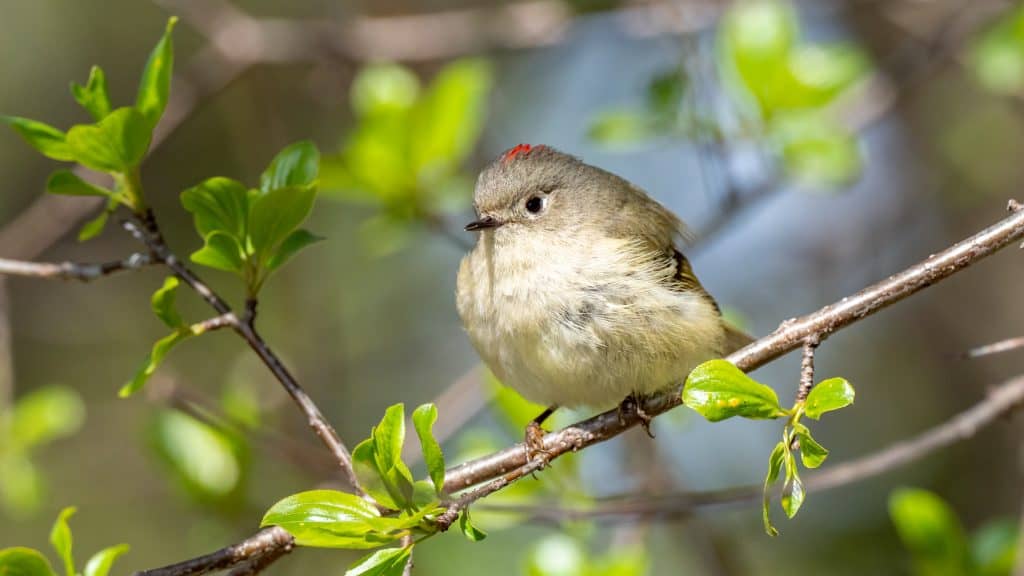
Range Map
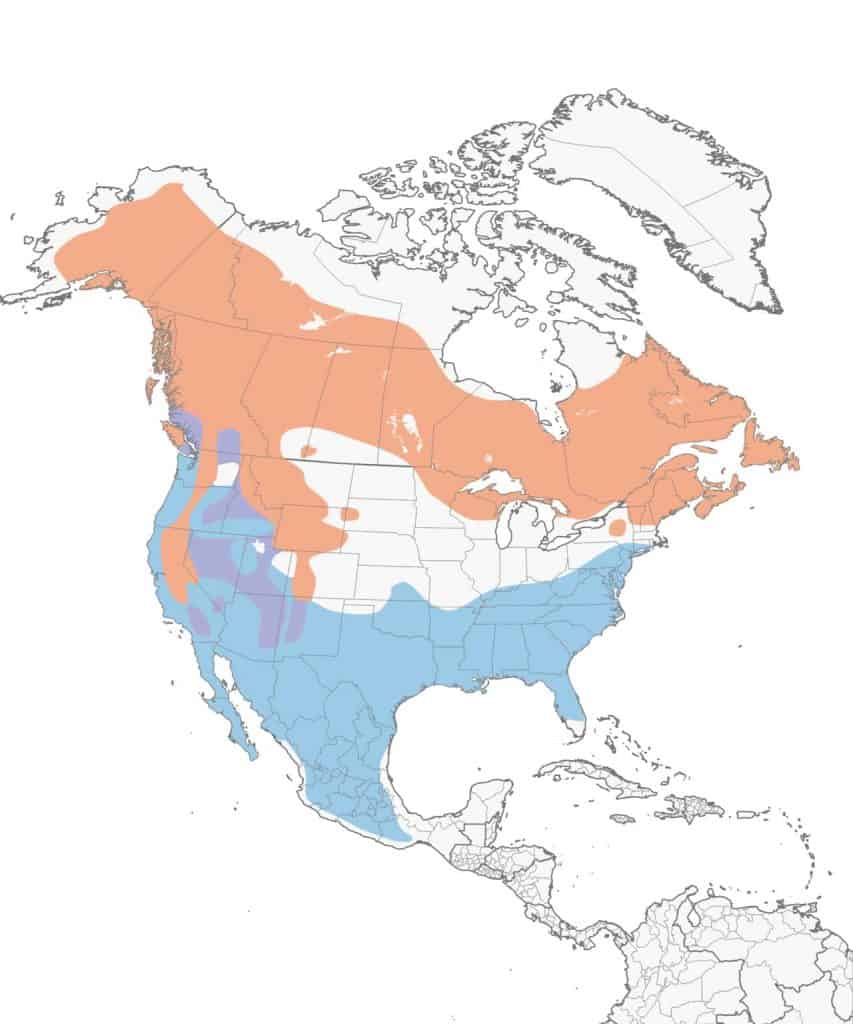
Ruby-Throated Hummingbird
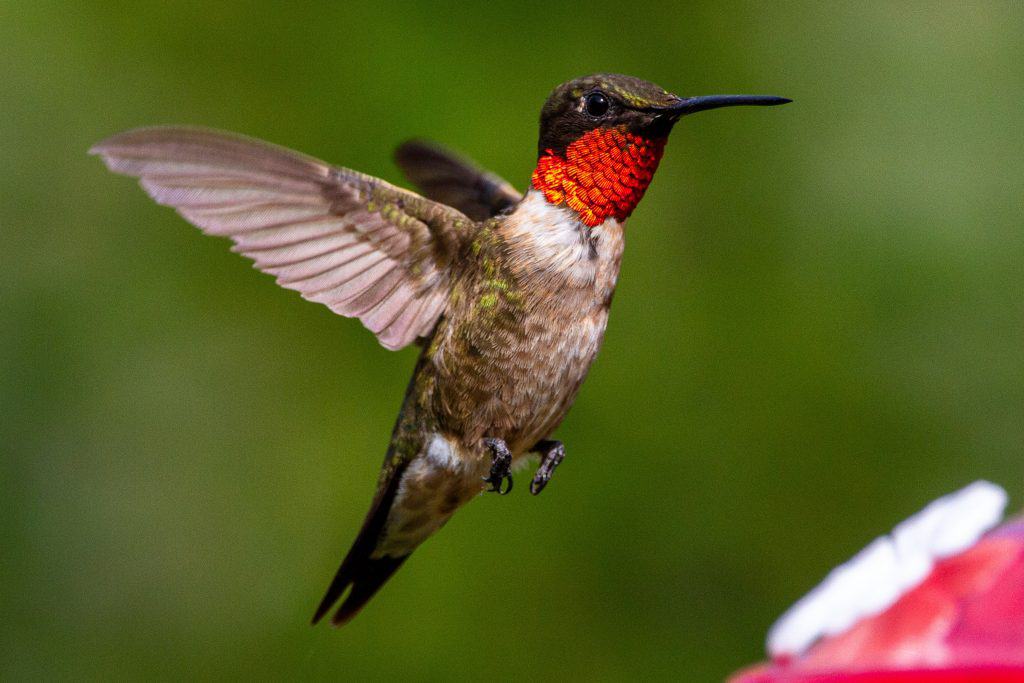
| Appearance | Tiny bird about 3″ long with iridescent green and a black throat patch that reflects bright ruby red in the sunlight. Females are the same but don’t have the throat patch. |
| Diet | Nectar, insects. |
| Feeder Food | Nectar. |
| Habitat | Deciduous woodlands and prairies. |
| Nesting | Thimble-shaped nests are built high on the branch of a deciduous tree. They have 1-2 broods/year and 1-3 eggs/brood. Eggs are very tiny and white. Incubation is for 12-14 days. |
Range Map
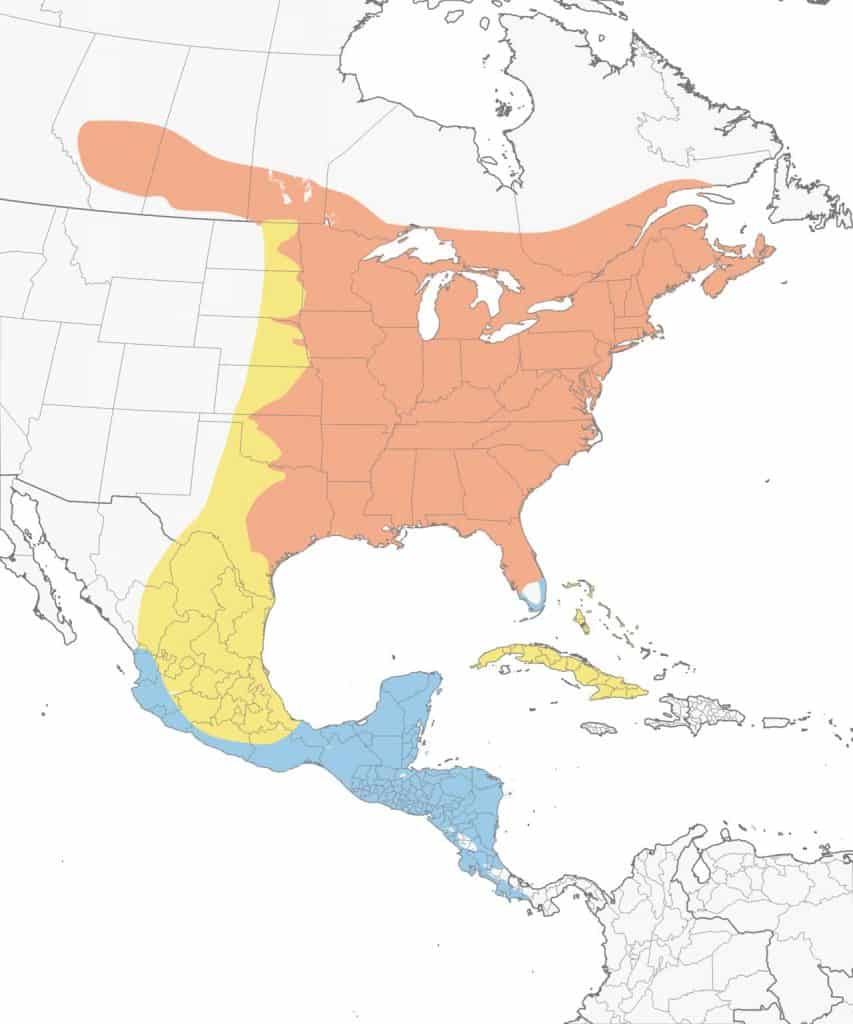
Scarlet Tanager
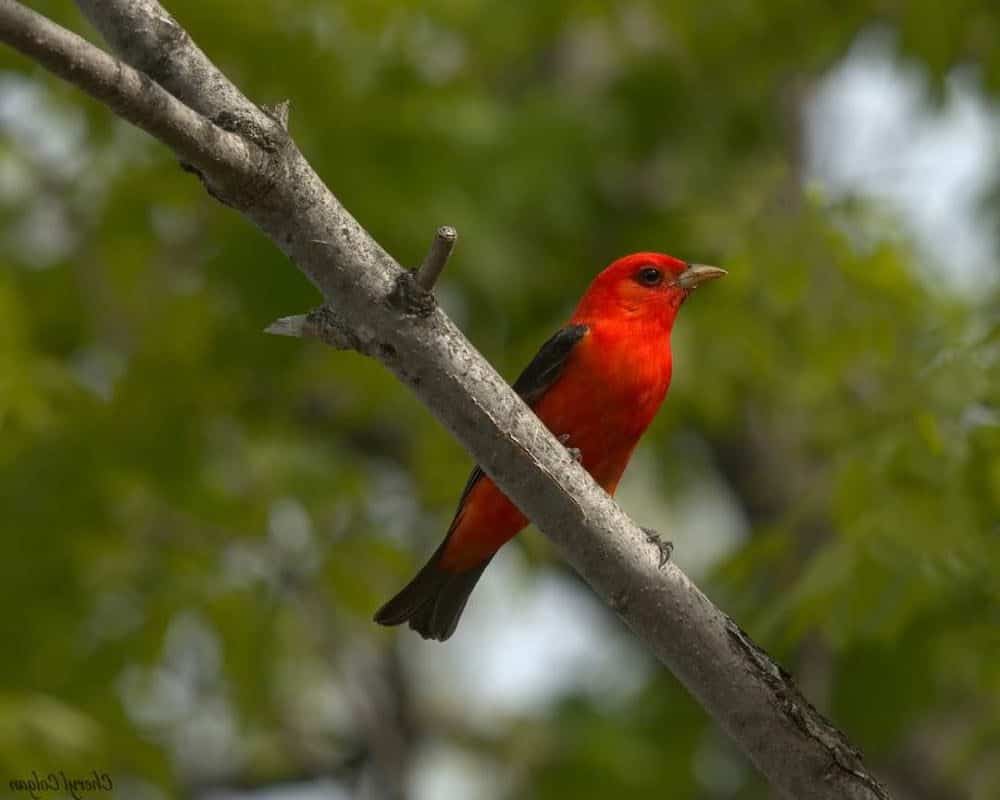
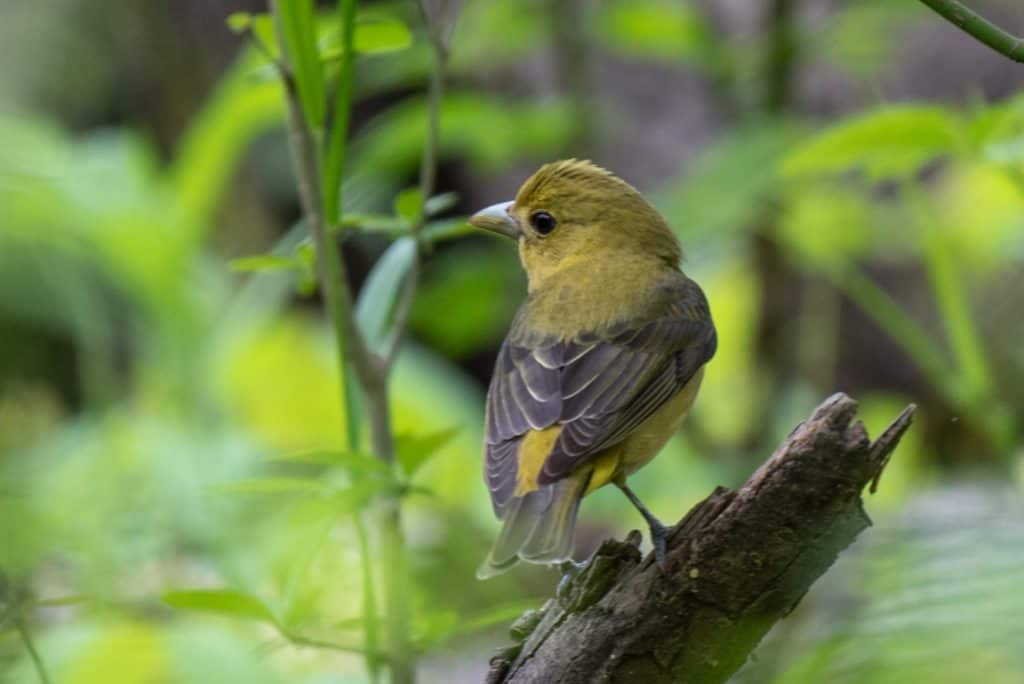
Appearance: Scarlet tanagers are small birds about 6.5″ long, with vibrant red faces and bodies (although many consider them to be a deep shade of orange), tan beaks, black wings, and short black tails. No crown. The female scarlet tanager (and juveniles) are the same except yellow instead of red.
Diet: Insects in summer; fruit in fall/winter.
Feeder food: Scarlet tanagers are unlikely to visit feeders. However, you can attract them by planting berry-producing plants such as blackberries, raspberries, huckleberries, juneberries, serviceberries, mulberries, and strawberries.
Habitat: Thickly forested regions in the eastern US. Often spotted high in the treetops.
Nesting: A loosely constructed nest of grass, twigs, bark strips, pine needs, and other plant materials. The nest rests high in a deciduous tree out in the middle of a horizontal branch about 50′ up. 1 brood/season, 3-5 eggs/brood, eggs are green/blue with multicolored and shaded marks of brown, purple/red. Incubation is 12-14 days and the young fledge is between 9-15 days.
Migration: Scarlet tanagers are migrators. In the spring, they migrate north to breed and raise their young. In the fall, they migrate south for the winter.
Breeding range: Primarily the eastern half of the US (except Florida and Louisiana), as well as the southern part of Canada’s Manitoba, Saskatchewan, and Ontario.
Winter range: South America.
Range Map

Short-Eared Owl
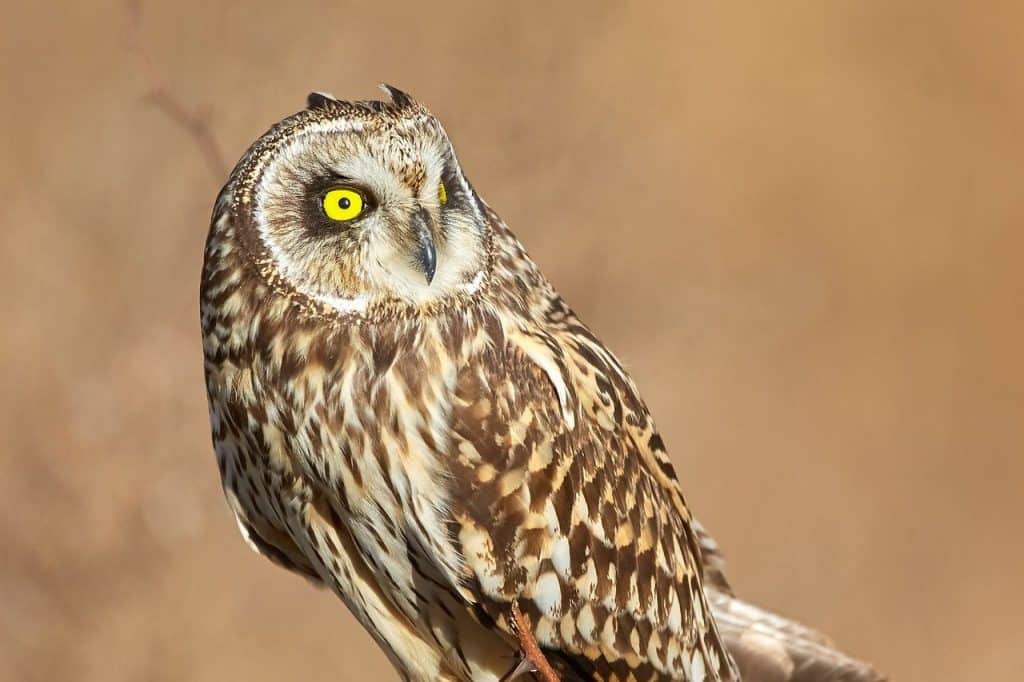
Appearance: Short-eared owls are medium-sized owls at about 14-17″ long. They’re brown spotted birds with tan, white, and ivory on the upper parts. The face is lighter and the eyes are yellow surrounded by black. As you would expect, their ears are so short they appear to be missing. Females are the same.
Diet: Small mammals such as shrews, moles, rabbits, gophers, bats, and rodents in which they first decapitate and then swallow the prey whole.
Feeder food: Short-eared owls do not visit feeders.
Habitat: Open grassland areas as they prefer to perch on the ground or low in trees.
Nesting: Short-eared owls nest on the ground in the grass with surrounding vegetation to hide it. They have 1-2 broods/season and 1-11 eggs/brood that are creamy white in color. Incubation lasts about 21-37 days and they fledge the nest after about 12-18 days.
Range Map
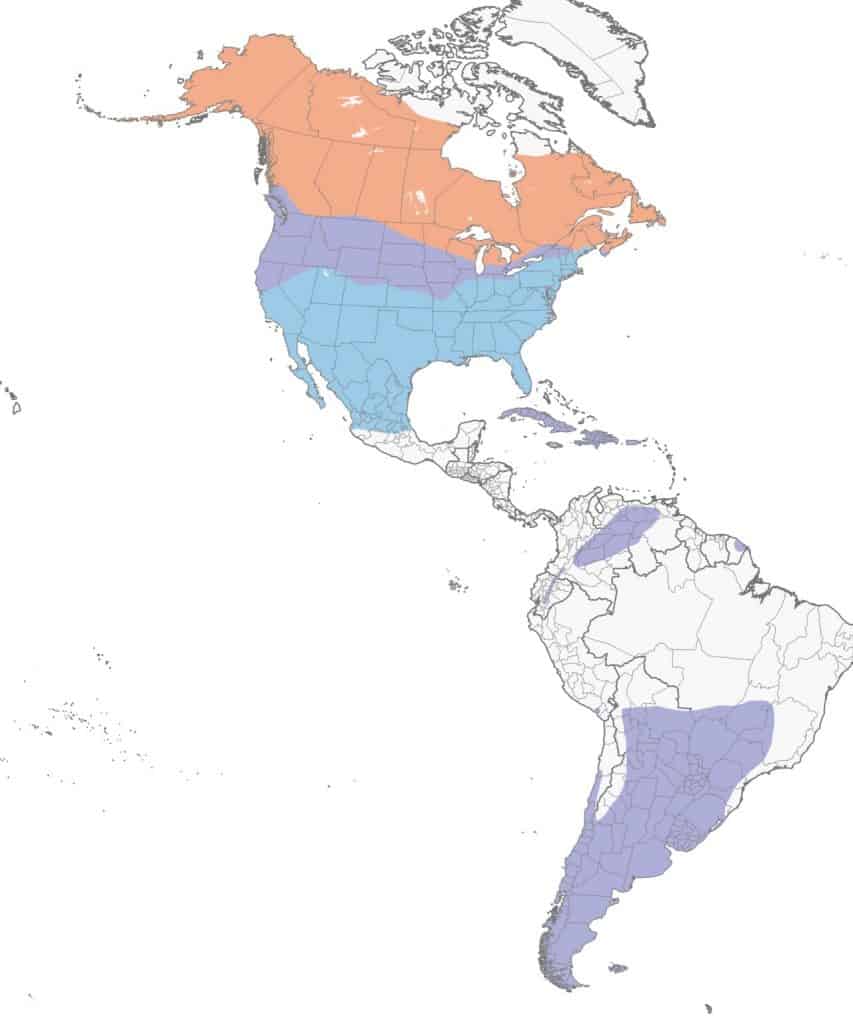
Song Sparrow
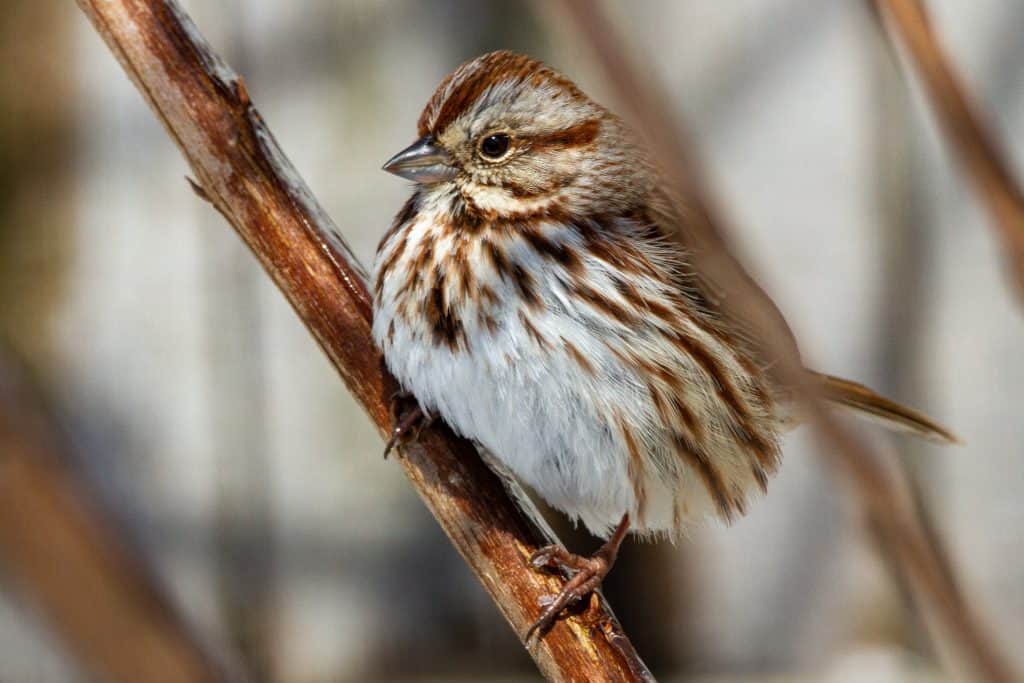
| Appearance | Small bird between 5-6″ in length with a round head and varying shades of brown streaks on the chest that converge into a central dark spot. Dark brown eyes, a short stubby beak, and a long, round tail. Females appear the same. |
| Diet | Insects and seeds. |
| Feeder Food | Unlikely to visit a feeder. |
| Habitat | Open areas and edges of woodlands. |
| Nesting | Cup-shaped nest. They have 2 broods/year, and 3-4 eggs/broods, eggs are blue to green with reddish-brown marks. Incubation is 12-14 days. |
Range Map
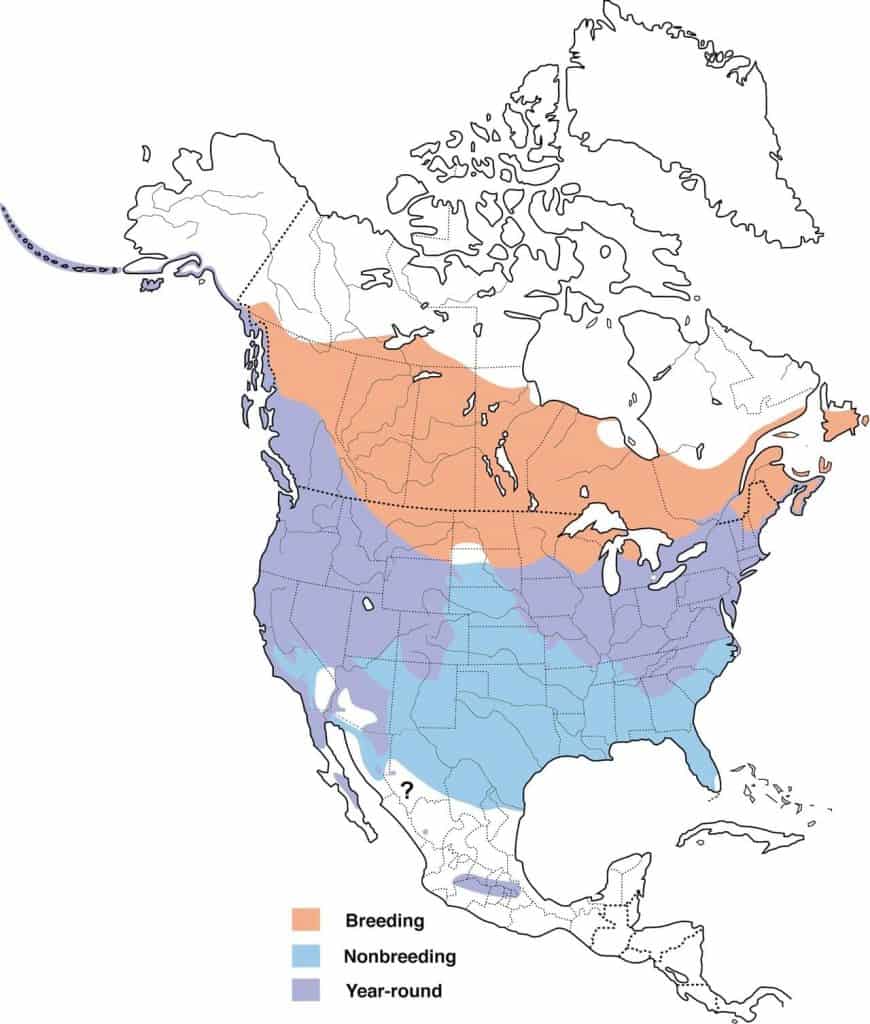
Summer Tanager
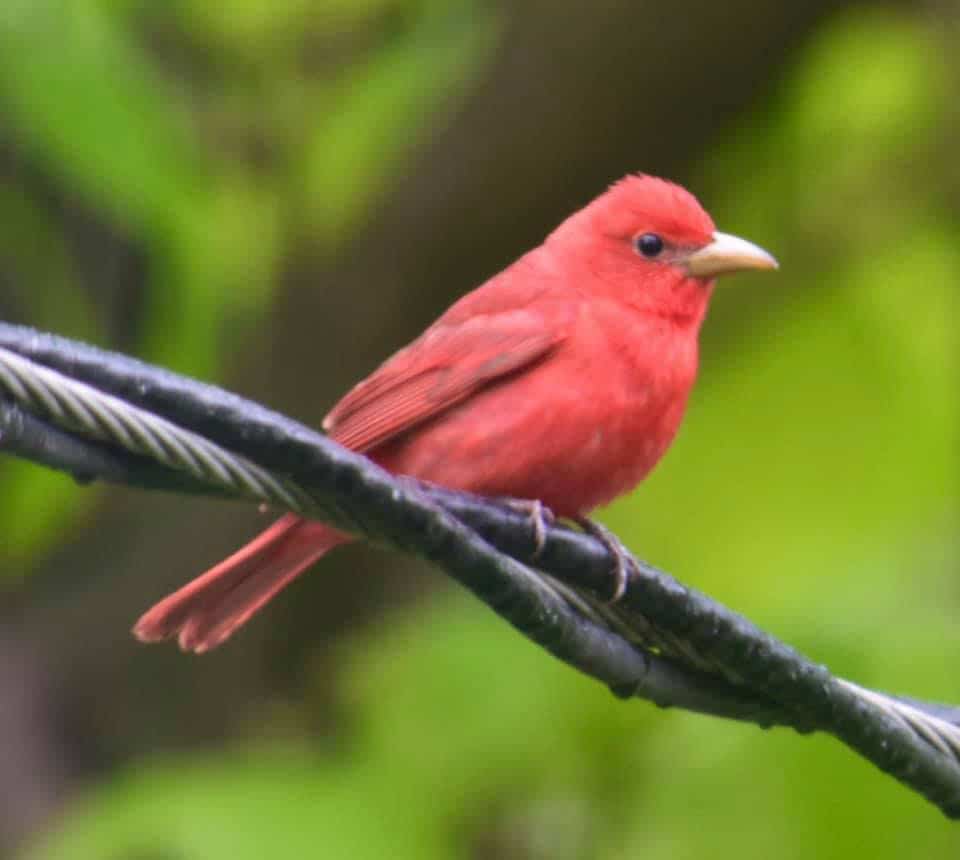
Appearance: The summer tanager is a small bird about 6.5-7″ long, with bright red all over, a long tan beak, a medium-length tail, and no crown. Female and juvenile are yellow.
Diet: Insects, especially bees and wasps. Also dine on spiders, cicadas, beetles, ants, and termites. Fruit including mulberries, pokeweed, citrus, and bananas.
Feeder food: Unlikely to visit a feeder. However, they can be enticed by planting berry trees and shrubs – especially near a forested area.
Habitat: Open forested areas that contain deciduous & pine trees throughout much of south-central and southeastern US.
Nesting: The nest is constructed primarily from dried grasses and herbs into a small cavity and often placed at the fork of tree branches. 1-2 broods/season, 3-4 eggs/brood, incubation is 11-12 days and the young fledge after about 8-12 days. Eggs are pale blue/green with brown spots.
Migration: Summer tanagers are migrators. In the spring they migrate north to breed and raise their young. Then in the fall, they migrate back south for the winter.
Breeding range: Midwest and southern US states including California, Nevada, Arizona, New Mexico, Texas, Oklahoma, Kansas, Iowa, Missouri, Nebraska, Louisiana, Illinois, Indiana, Ohio, Kentucky, Tennessee, Mississippi, Georgia, Alabama, Florida, South Carolina, North Carolina, Virginia, and Pennsylvania.
Winter range: Mexico, the Caribbean islands, Central America, and South America.
Range Map
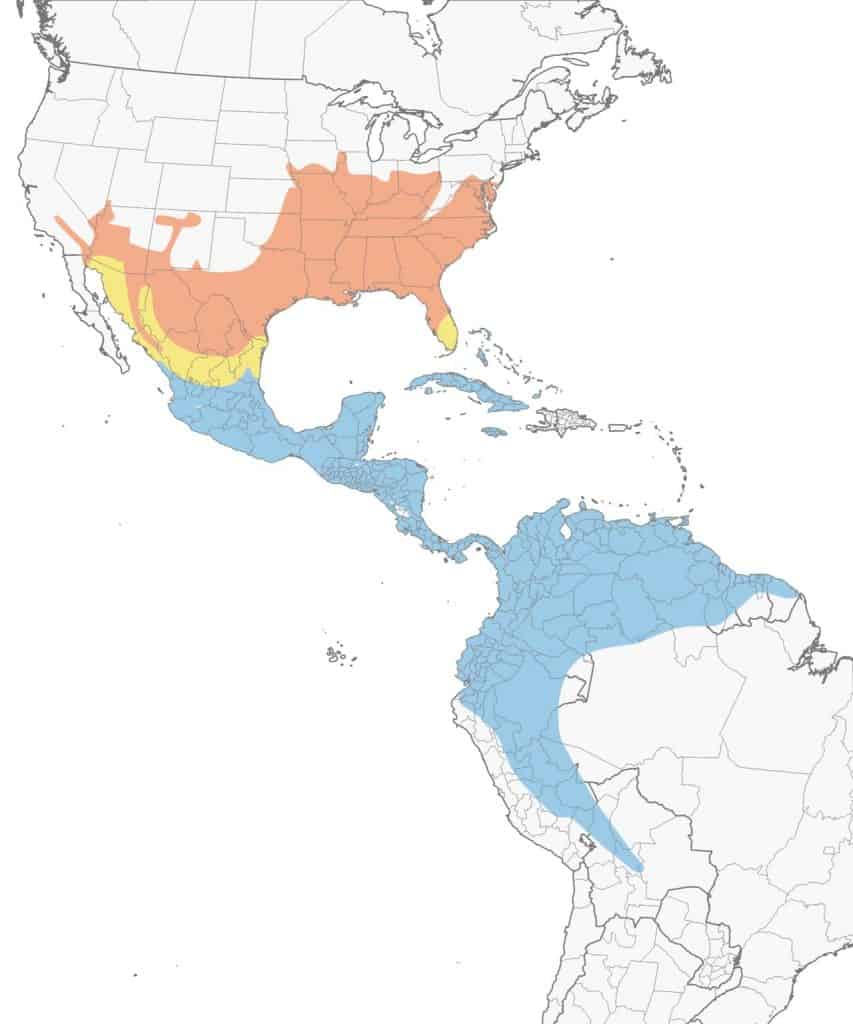
Surf Scoter
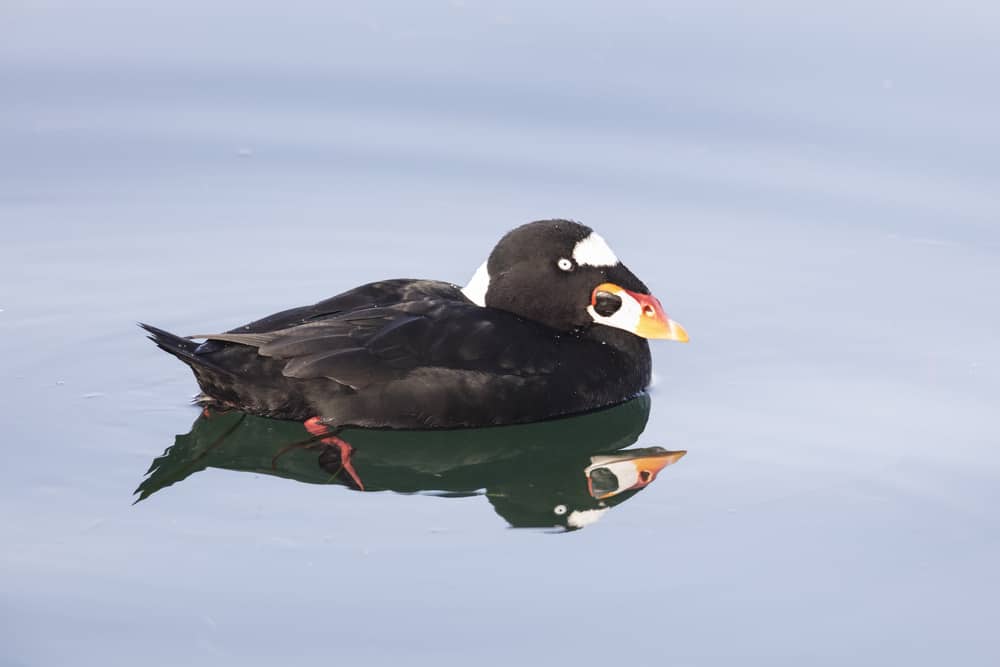
| Appearance | Surf scoters are medium-sized ducks about 19″ – 24″ in length. The male is black and has a large, sloping forehead with patches of white (on the back of the neck, forehead, and either side of the upper bill), and an orange bill. The female is brown with subtle white patches on her face. |
| Diet | Marine life including mollusks, snails, crabs, hydrozoans, worms, herring spawn, echinoderms, and aquatic plants. |
| Feeder Food | N/A |
| Habitat | Surf scoters are commonly found along the ocean surf, salt bays, wetlands, lakes, tundra, forests, shrublands, and even meadows. |
| Nesting | Surf scoters are ground nesters. They construct the nest under low tree branches over 100′ from the shores. She builds a shallow depression and lines with her own down and other grasses. Clutch: 5-9 eggs/brood Egg color: pale buff Incubation: The female incubates the eggs for an unknown period of time. After hatching, the young follow their mother to the water. |
Range Map
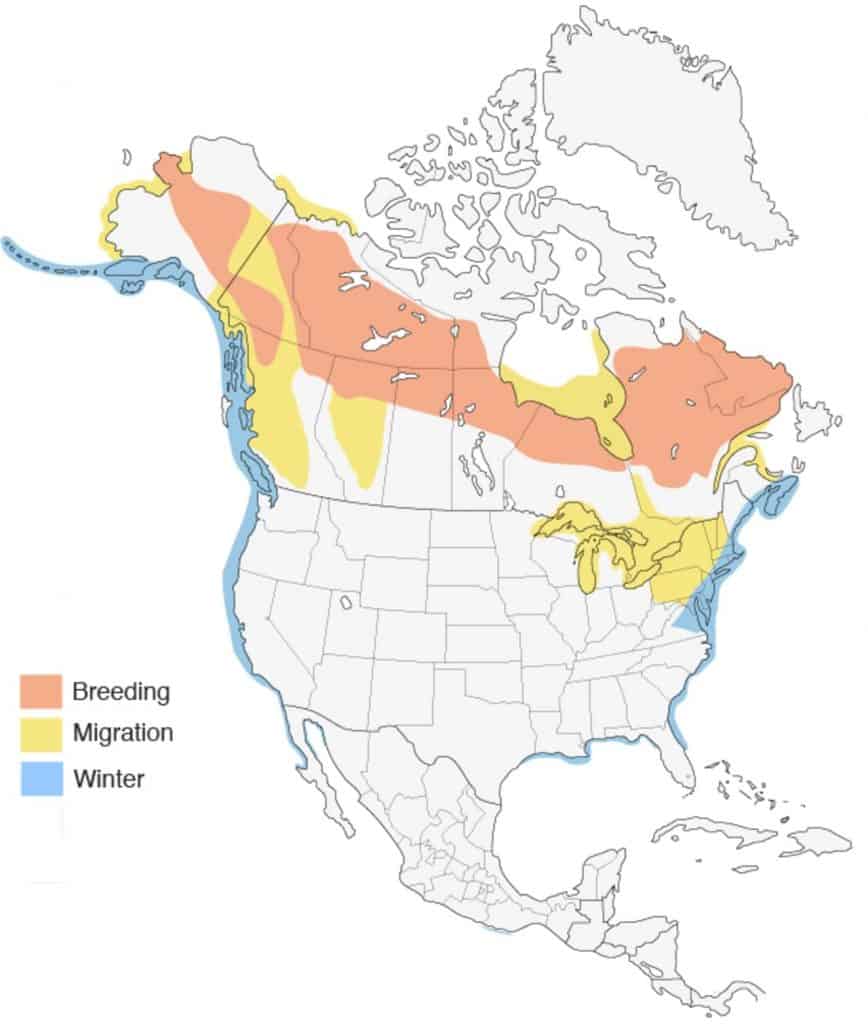
Swainson’s Thrush
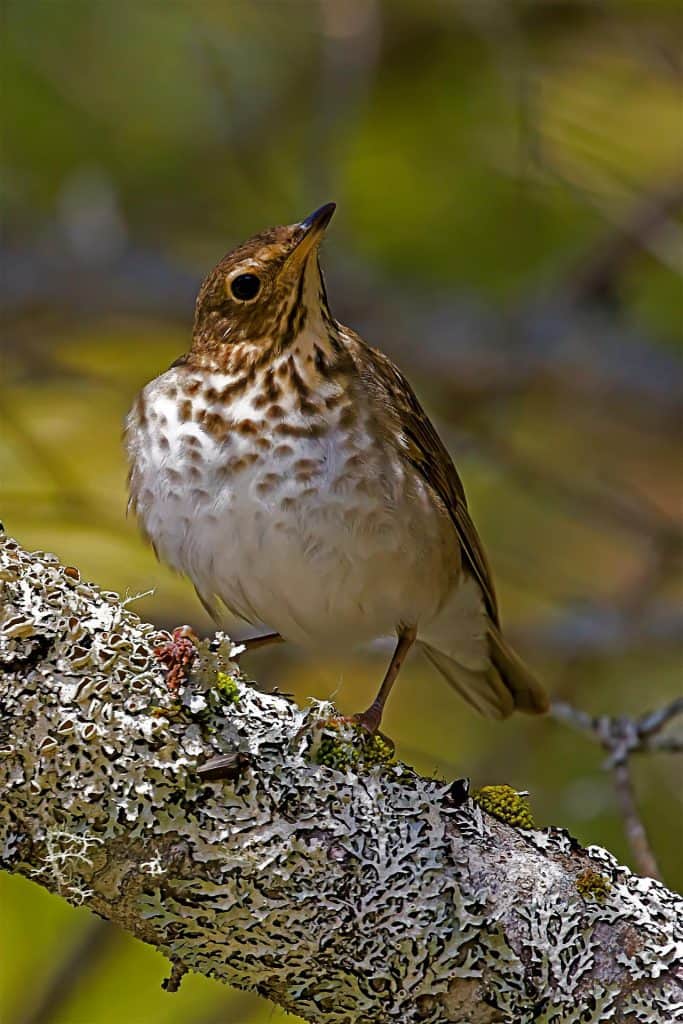
Appearance: Swainson’s thrush is about 7″ long. Their upper parts are brown and their underparts are white with spots. Their dark eyes have a buffy eye ring as well as flanks.
Diet: Insects and fruit.
Feeder food: Unlikely to visit a feeder.
Habitat: Forests.
Nesting:
- Nest: Swanson’s thrush builds a deep, compact cup-style nest and is placed in a small tree about 2-7′ up.
- Broods: They have 1 brood/season
- Clutch: 1-5 eggs/brood
- Egg color: Eggs are blue or greenish-blue with reddish-brown speckles
- Egg size: 0.8 – 1 inches by 0.6 – 0.7 inches
- Incubation: 10-14 days and fledglings leave the nest at about 14 days.
Migration: Swainson’s thrushes are migrators. They migrate north in the springtime to breed and raise their young. In the fall, they migrate far south into southern Mexico, Central America, and South America for the winter.
Breeding range: Alaska, west coasts of Washington, Oregon & California, Idaho, western Montana & Wyoming, northeast Nevada, central Utah, central Colorado, New England, and all Canadian provinces except Nunavut.
Winter range: Southern Mexico, Central America, and South America.
Range Map
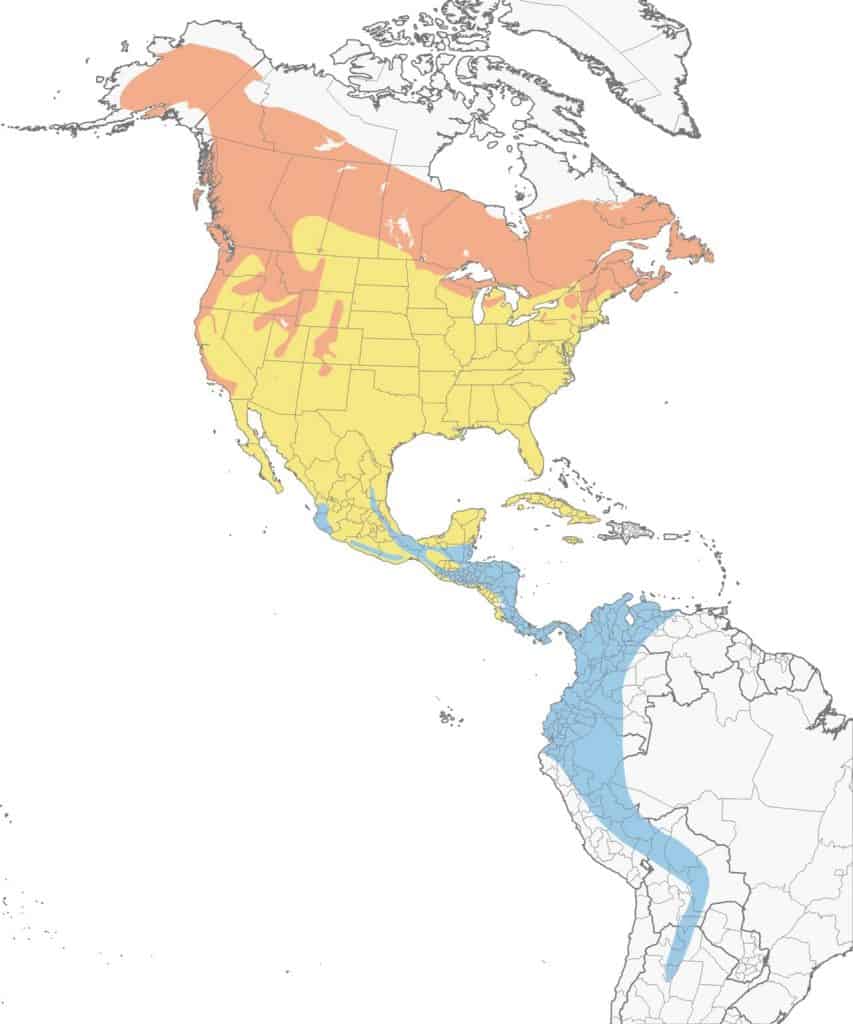
Swamp Sparrow
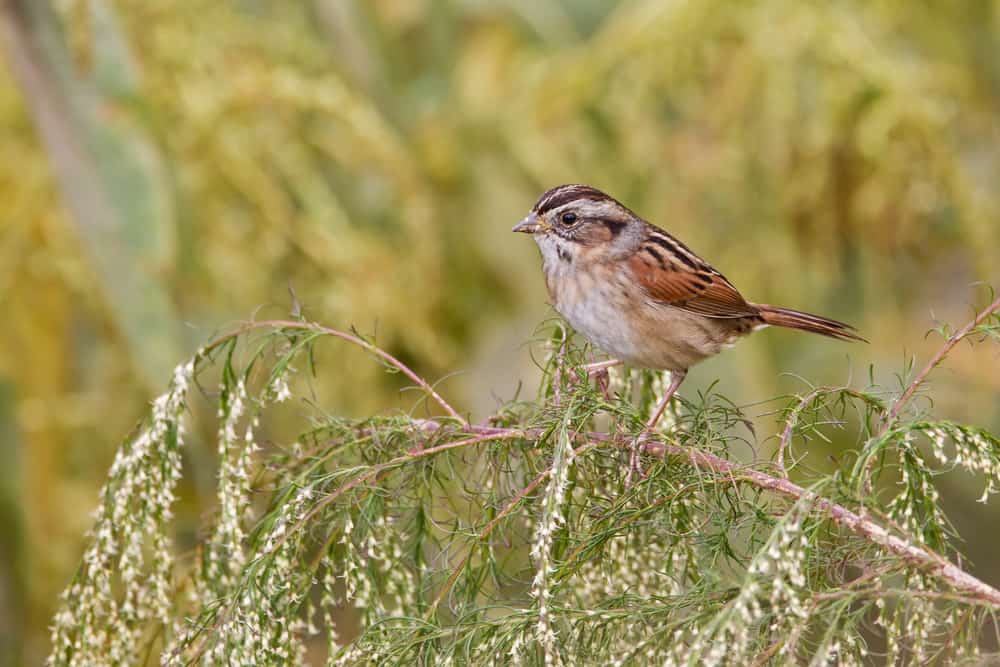
Appearance: Swamp sparrows are small birds about 5-6″ long. They sport an array of colors including blue/gray on its head with a rust-colored crown and a black stripe that connects to the cone-shaped bill. The tail is brown and points up – legs are relatively long for a sparrow. The female looks the same.
Diet: Seeds, fruits & invertebrates.
Feeder food: They don’t usually visit feeders.
Habitat: As their name implies they prefer to be near water as well as vegetation near water.
Nesting: Nest is built in a patch of grass or reeds less than 3′ off the ground. Using plant fibers, rootlets, grasses, sedges and plant down, the female constructs the cup-shaped nest which will end up being about 3″ tall x 4″ wide and 1.5″ deep. They have 1-2 broods/season, 1-6 eggs/brood, eggs are bluish/green with spots. Incubation lasts 12-14 days and fledglings leave the nest after 7-14 days.
Range Map
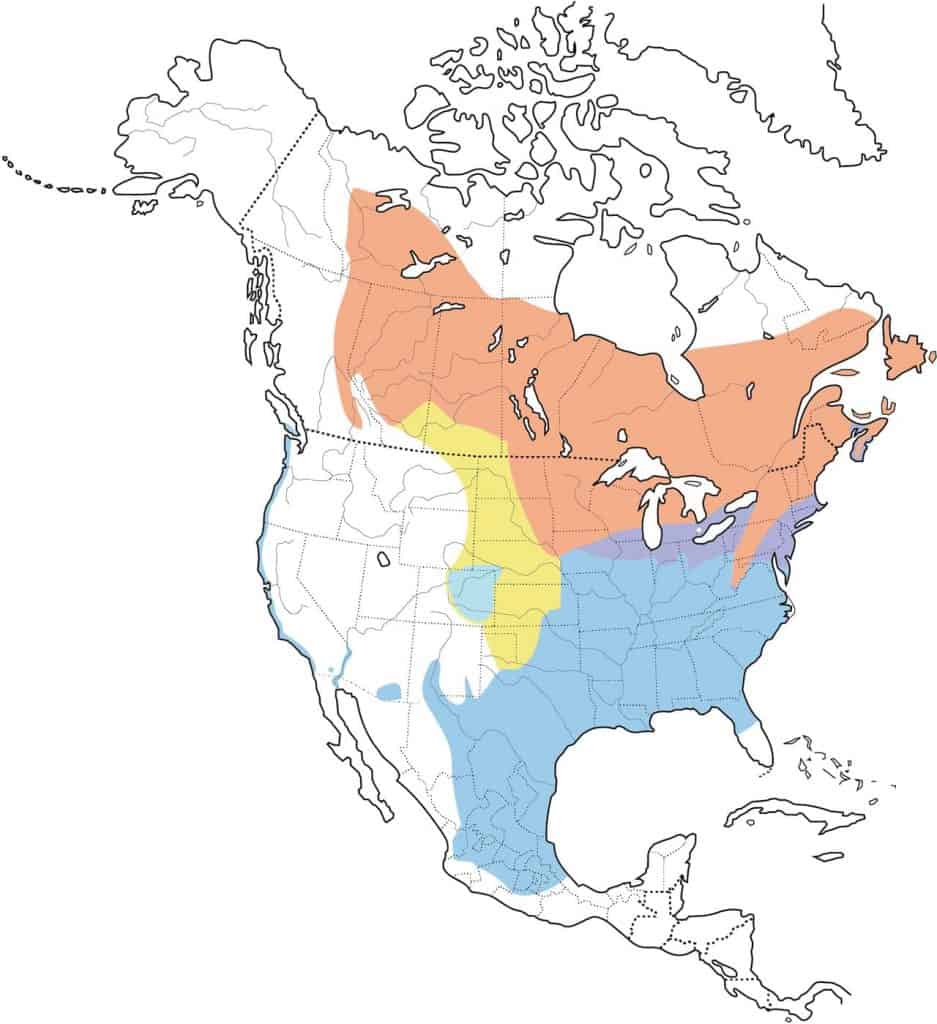
Tree Swallow
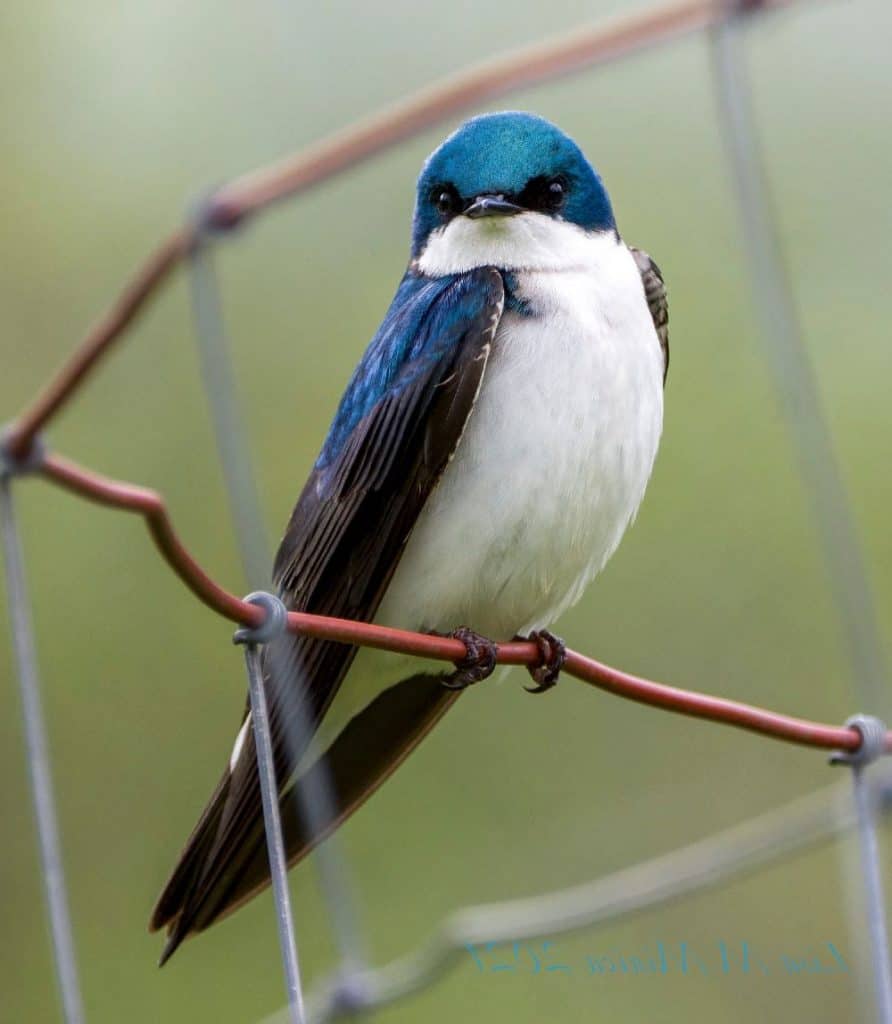
Appearance: 5-6″ long, dark metallic blue to blue/green with a white belly, notched tail, and pointed wing tips. Females have the same coloring but are a bit duller.
Diet: Insects and small fruits.
Feeder Food: Unlikely to visit a feeder.
Habitat: Open areas such as fields, large lawns, and marshes.
Nesting: Tree swallows are cavity nesters. They often take up residence in an old dead tree or existing hole left behind by other cavity nesters. They have 2-8 eggs, eggs are light pink then slowly fade to white. Incubation is 14-15 days and young fledge at about 18-22 days.
Range Map
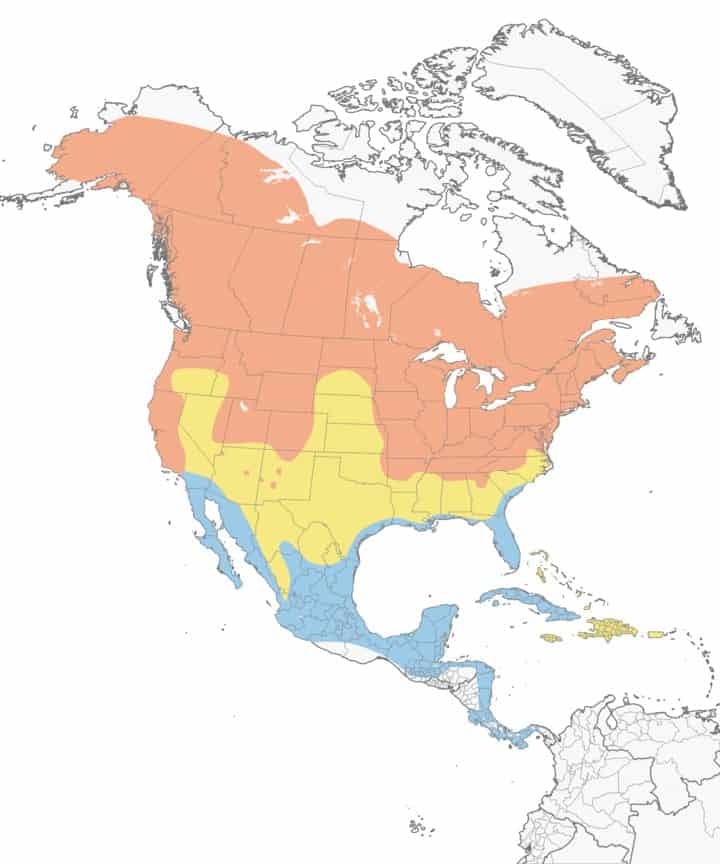
Tufted Titmouse
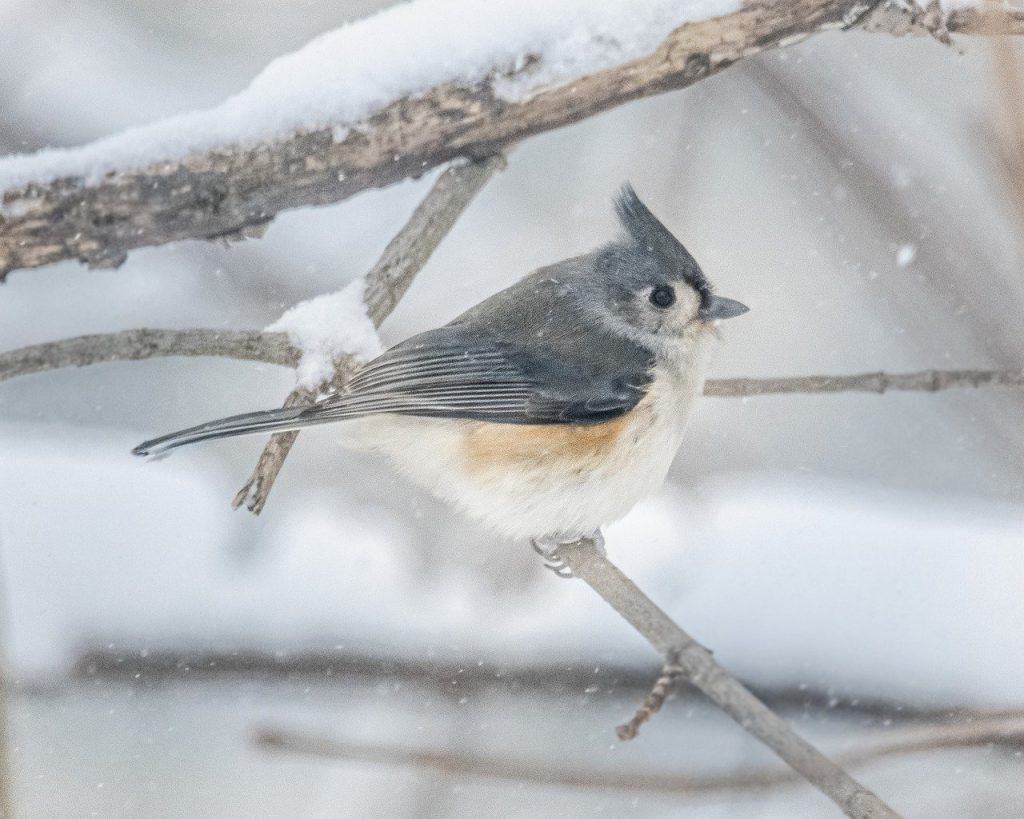
| Appearance | Small bird about 6″ long with slate gray above and white chest, belly & around the eyes. Rusty brown is below the wings, legs are gray and eyes are dark. Has a pointed “tuft” crest. |
| Diet | Insects, seeds, fruit. |
| Feeder Food | Suet. |
| Habitat | Orchards are a draw for them as they consume fruit. They also live in deciduous wooded areas or mixed woods. |
| Nesting | They build a nest within a cavity – usually an old woodpecker hole. They have 2 broods/year and 5-7 eggs/brood that are white with brown markings. Incubation lasts 13-14 days. |
Range Map

Turkey Vulture
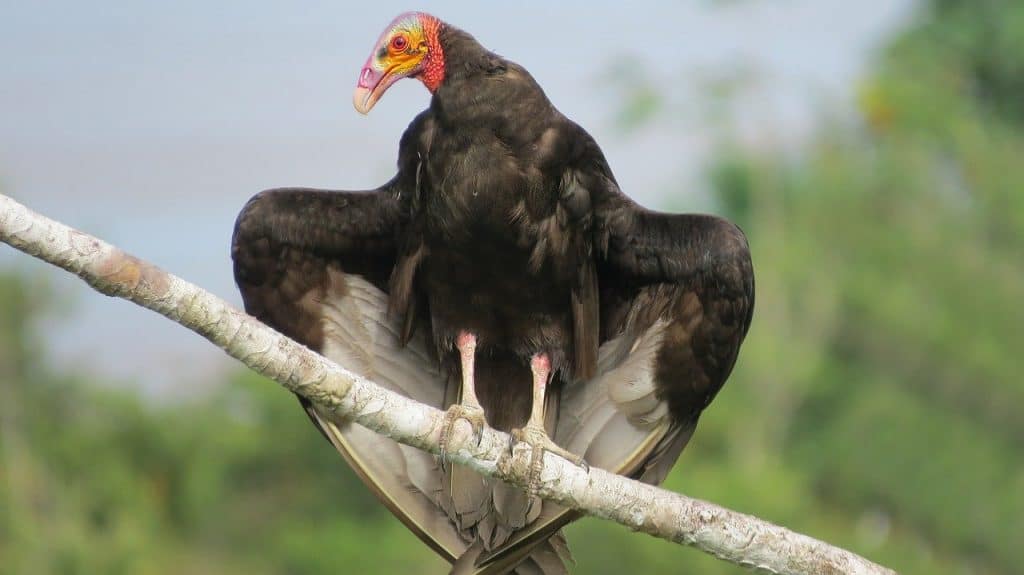
Appearance: The turkey vulture is a large bird about 27″ long, black/brown, with a red head of bare skin and pink legs.
Diet: Animal carcasses.
Feeder food: They don’t visit feeders.
Habitat: Wooded areas with open areas for foraging.
Nesting: They nest on the ground in a rocky crevice, cliff, or hollowed-out log. They have 1 brood/season, 1-3 eggs/brood that are creamy-white with gray/blue or green spots, and incubate for 38-41 days. Fledglings leave the nest 75-80 days after hatching.
Migration: While most turkey vultures migrate north in spring for breeding and raise young, many remain in their year-round range.
Year-round range: Western California, southern Arizona, southern Texas, southern Missouri, US states east and south of Missouri, as well as Mexico, Central American, and South America.
Breeding range: US states outside of the year-round range (above) as well as southern Canadian provinces of British Columbia, Alberta, Saskatchewan, Manitoba, and Ontario.
Range Map
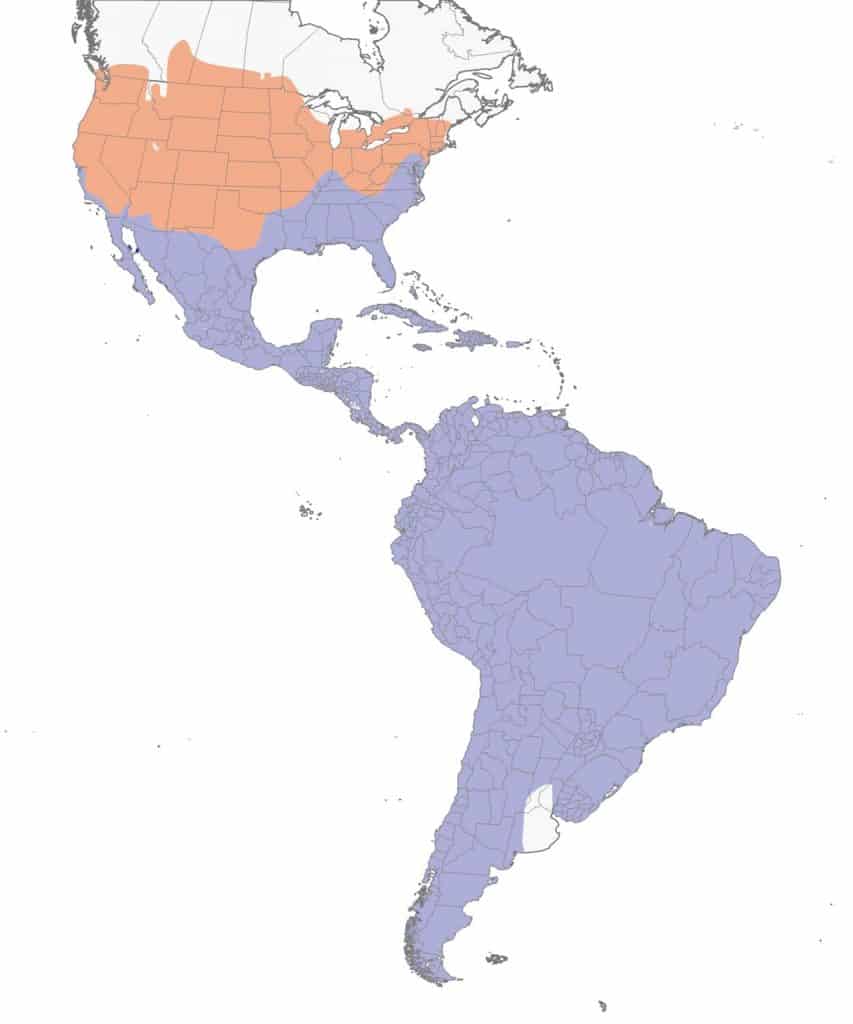
Veery
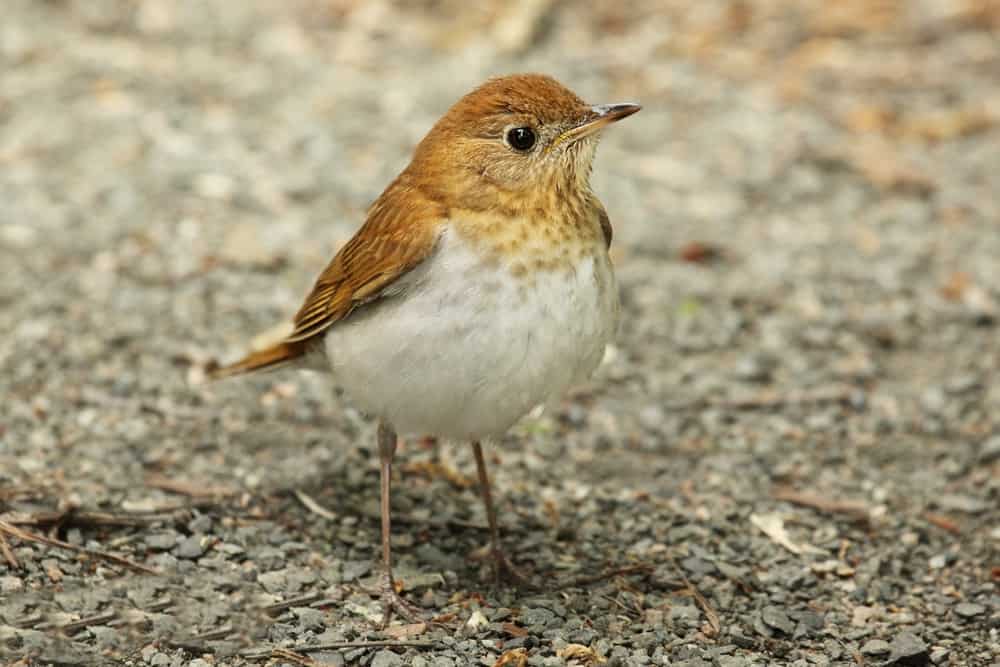
| Appearance | Small cinnamon-brown bird about 7″ long with pale yellow spotted throat, and white on chest and belly. Females appear the same. |
| Diet | Insects and fruit. |
| Feeder Food | Unlikely to visit a feeder. |
| Habitat | Thick forest and woodlands. |
| Nesting | Nests are located close to the ground (less than 5′ high if placed in shrub), 1-2 broods/year, 1-5 eggs/broods, greenish/blue eggs are incubated for 10-14 days. |
Range Map
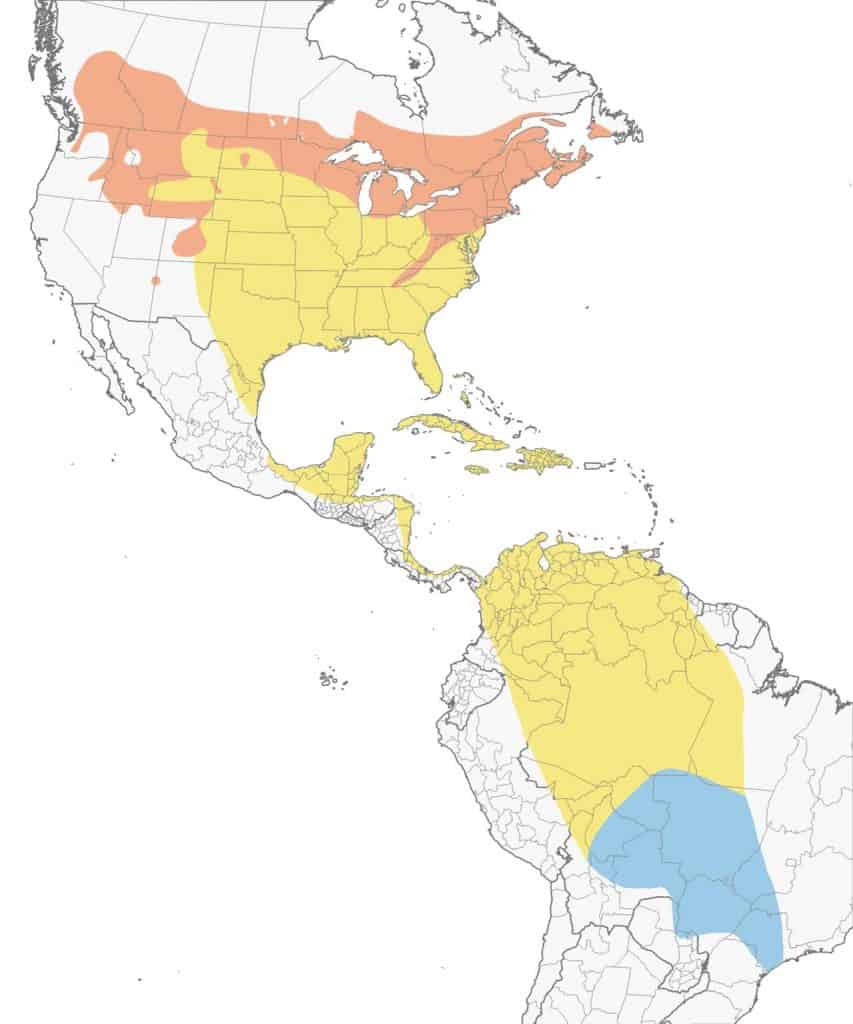
Western Spindalis
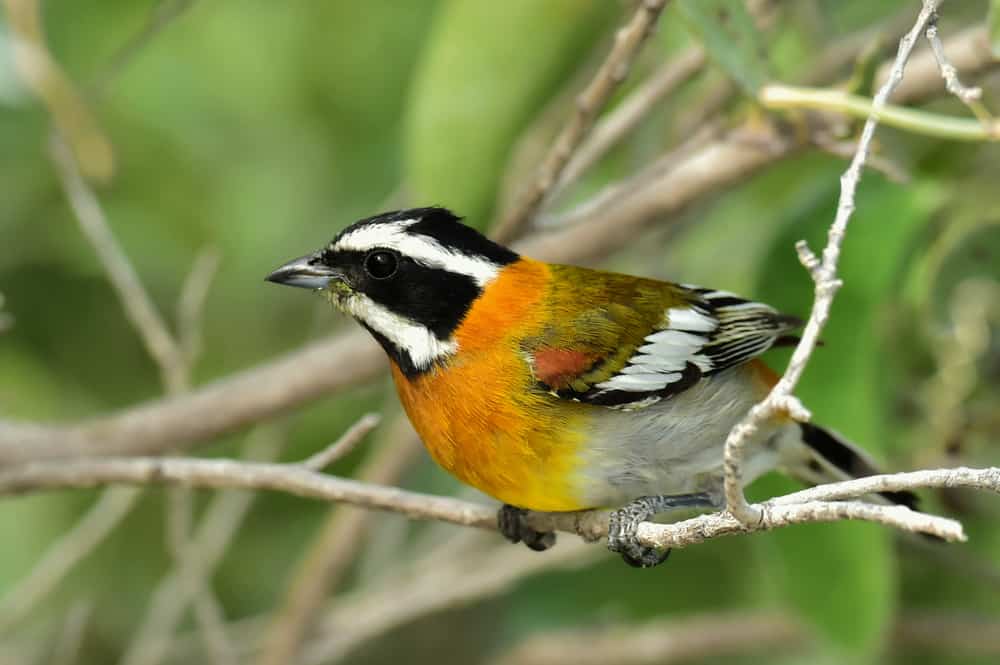
| Appearance | The western spindalis has a burnt orange chest, stripe from the bill to the chest, upper back, and as well as under lower wings. The head and wings are black-and-white striped, and the belly is bright white. The female is similar but a drab olive green instead of orange. |
| Diet | Although not confirmed, they likely consume fruit as they’re frequently found in fruiting trees. |
| Feeder Food | Unknown |
| Habitat | The western spindalis are typically found in the Caribbean and South America. However, they’ve also been sighted in southern Florida. |
| Nesting | Unknown |
Range Map
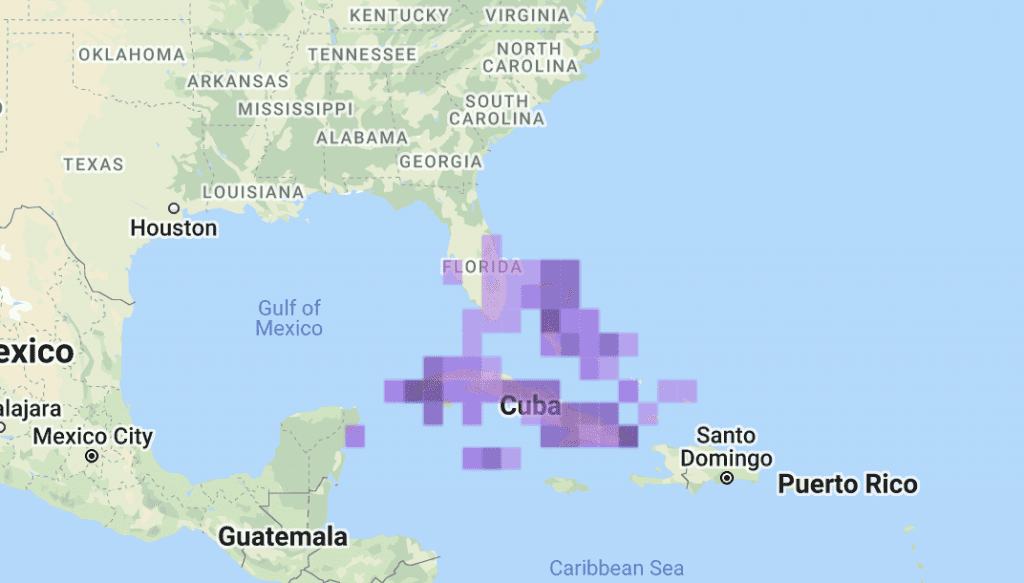
White-Breasted Nuthatch
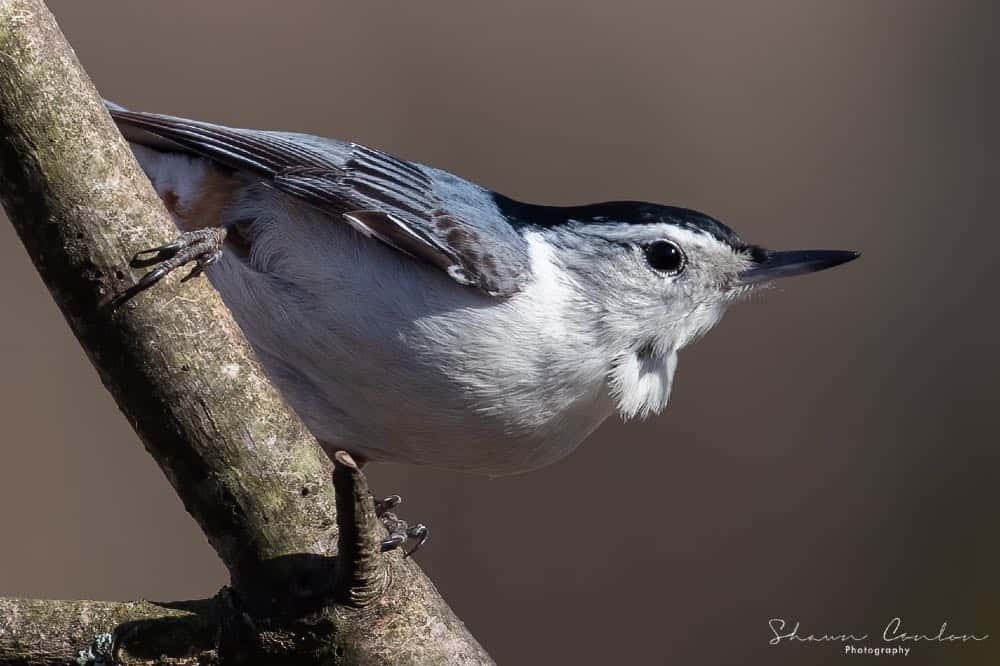
Appearance: 5-6″ long, gray/blue back, white head with a black cap, chestnut under the tail, and a long thin pick-like beak. Females look similar except their cap and neck are gray. Usually spotted climbing upside-down on a deciduous tree foraging for insects beneath the bark.
Diet: Insects & seeds.
Feeder food: Suet, sunflower seed, shelled peanuts.
Habitat: Near mature deciduous and mixed forests; wooded suburban areas such as orchards, parks, and backyards.
Nesting: White-breasted nuthatches are cavity nesters. They have 1 brood/season, 5-9 eggs/brood, eggs are white with brown markings, incubation is 11-12 days and young fledge at about 13-14 days.
Migration: White-breasted nuthatches are not migrators. They remain in their year-round range all seasons of the year. That said, a small part of the population may migrate to a strip in the southcentral US for the winter.
Year-round range: Every US state, Canada’s southern provinces, and Mexico.
Range Map
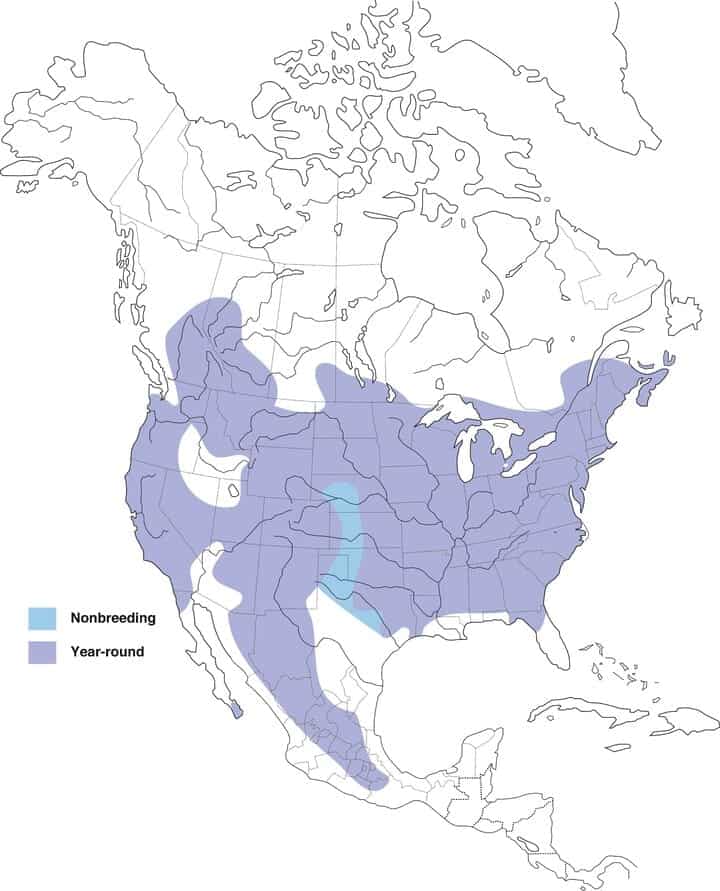
White-Crowned Sparrow
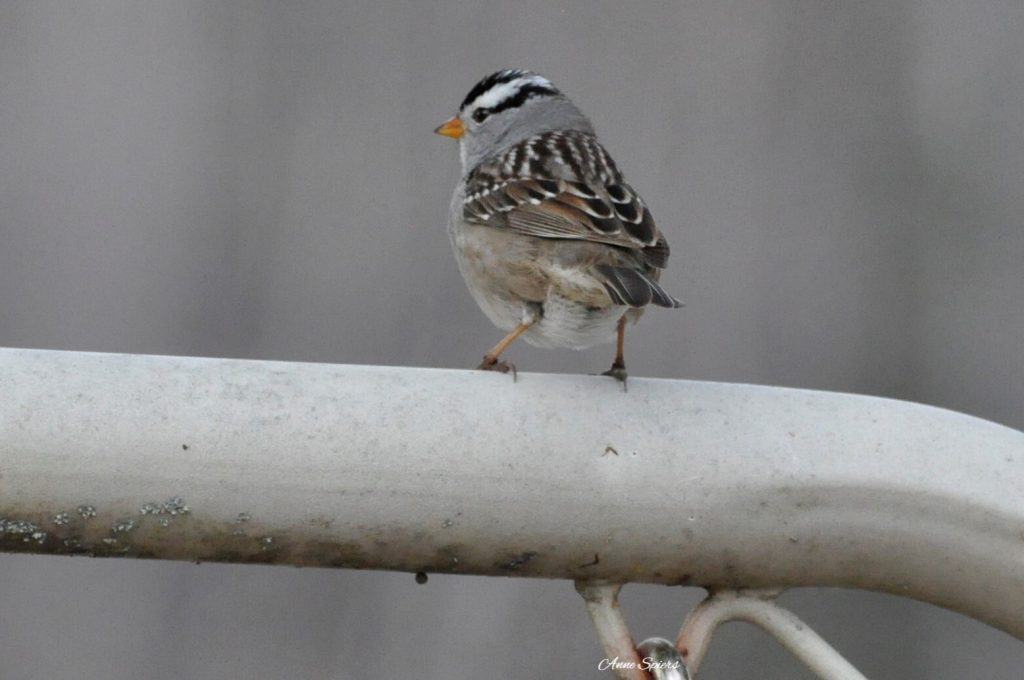
| Appearance | Small bird about 7″ long. Mostly brown with a gray throat & chest, black & white striped crown, and a small thin pink bill. The female is the same. |
| Diet | Insects, seeds, berries. |
| Feeder Food | Black-oil sunflower seeds, hulled sunflower, cracked corn, millet, and milo. |
| Habitat | Open areas with shrubby thickets, open meadows, and forest edges. |
| Nesting | They have 2 broods/year, 3-7 eggs/brood that are green/blue/white with dark brown markings. Incubation lasts 11-14 days. |
Range Map
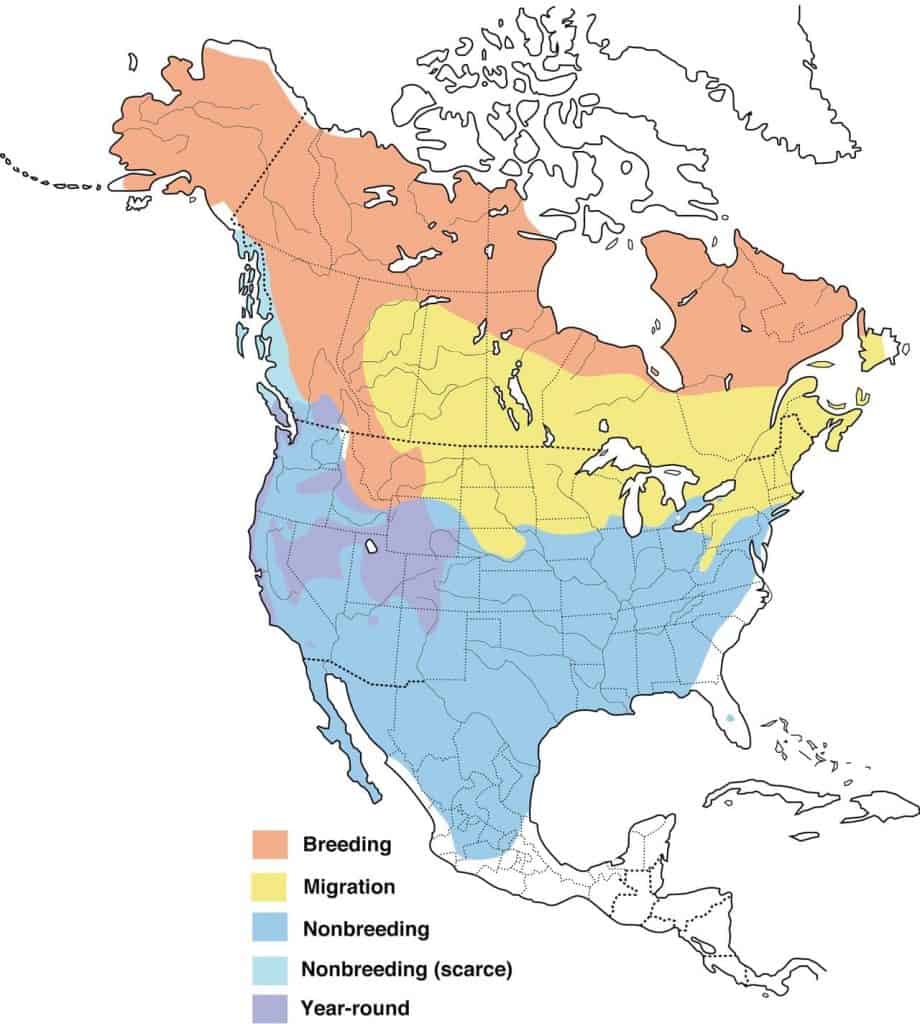
White-Throated Sparrow
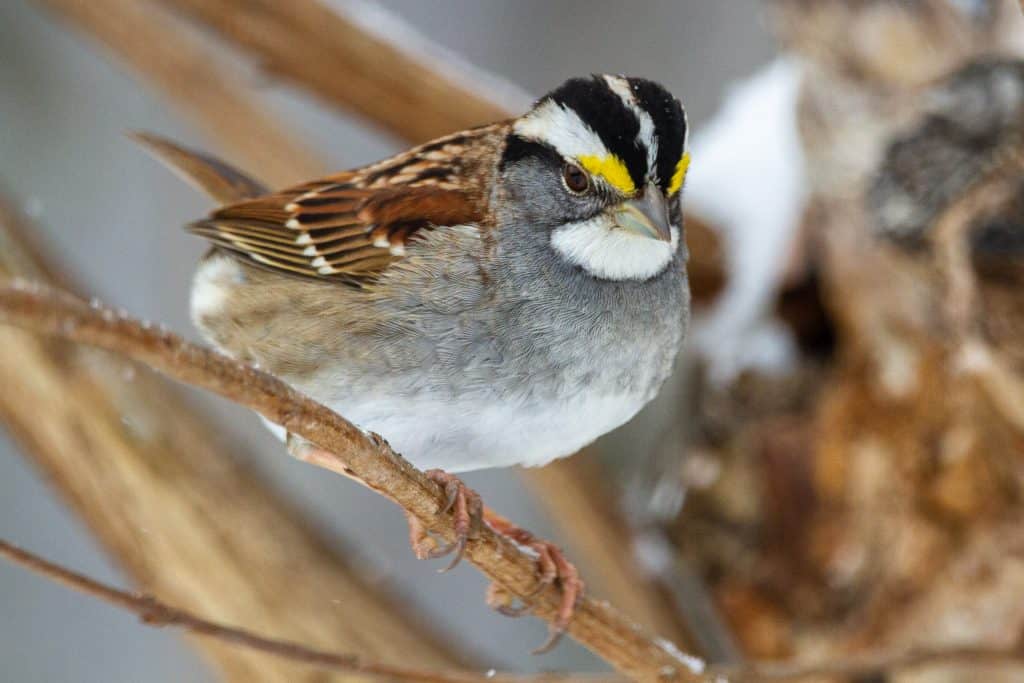
| Appearance | Small bird about 6-7″ long. Brown with gray chest and belly. Has a small yellow spot between its eyes (lore). A white patch on its throat and crown. They have white or tan stripes alternating with black stripes. Females and males are the same. |
| Diet | Insects, fruit, seeds. |
| Feeder Food | Millet and sunflower seeds. |
| Habitat | Forested areas of coniferous and deciduous trees. |
| Nesting | They have 1 brood/year and 4-6 eggs/brood in a cup-shaped nest. Incubation lasts 11-14 days. |
Range Map
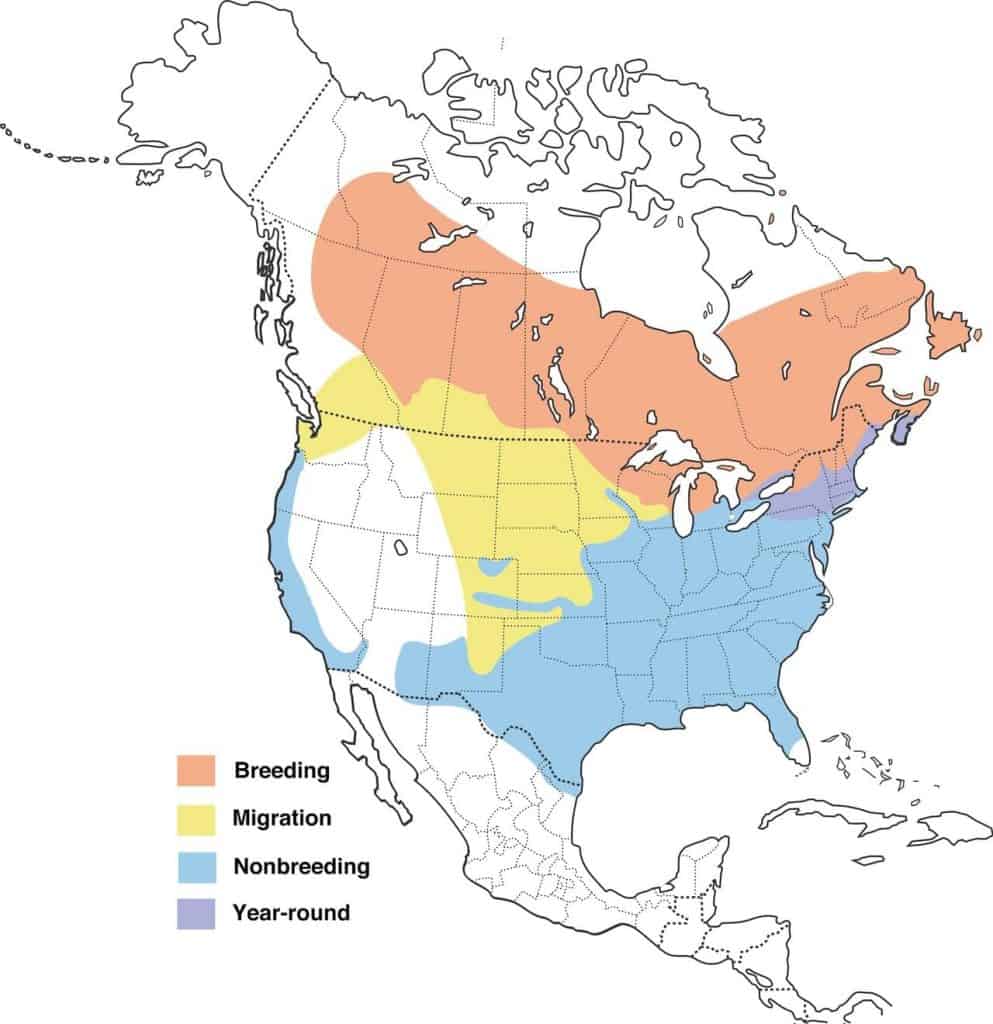
White-winged Dove
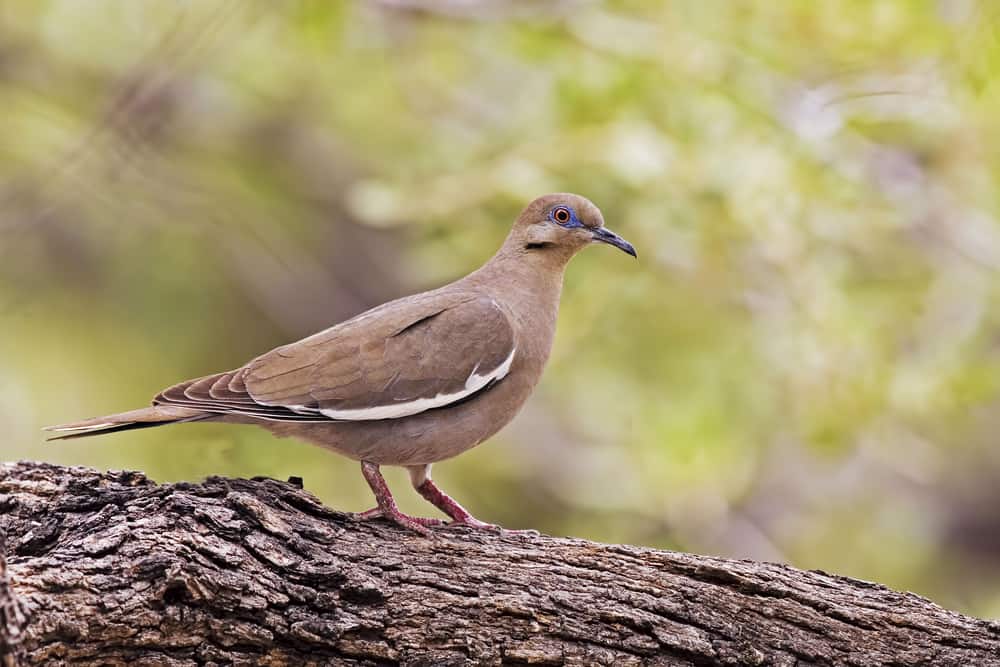
| Appearance | White-winged doves are 11 1/2″ long, brown/gray with gray below. They have blue skin around their orange-red eyes, a black stripe on their cheeks, and a downcurved bill. The wings and tail have white edges. |
| Diet | Seeds, nuts, and fruits. |
| Feeder Food | Sunflower, seeds, milo, corn, and safflower seed. |
| Habitat | Wooded areas with waterways, mesquite woodlands, deserts, and wooded residential areas. |
| Nesting | White-winged doves nest in trees. They have 2-3 broods and 2 eggs/brood. Incubation is for 14-20 days and fledglings leave the nest at 13-18 days. |
Range Map
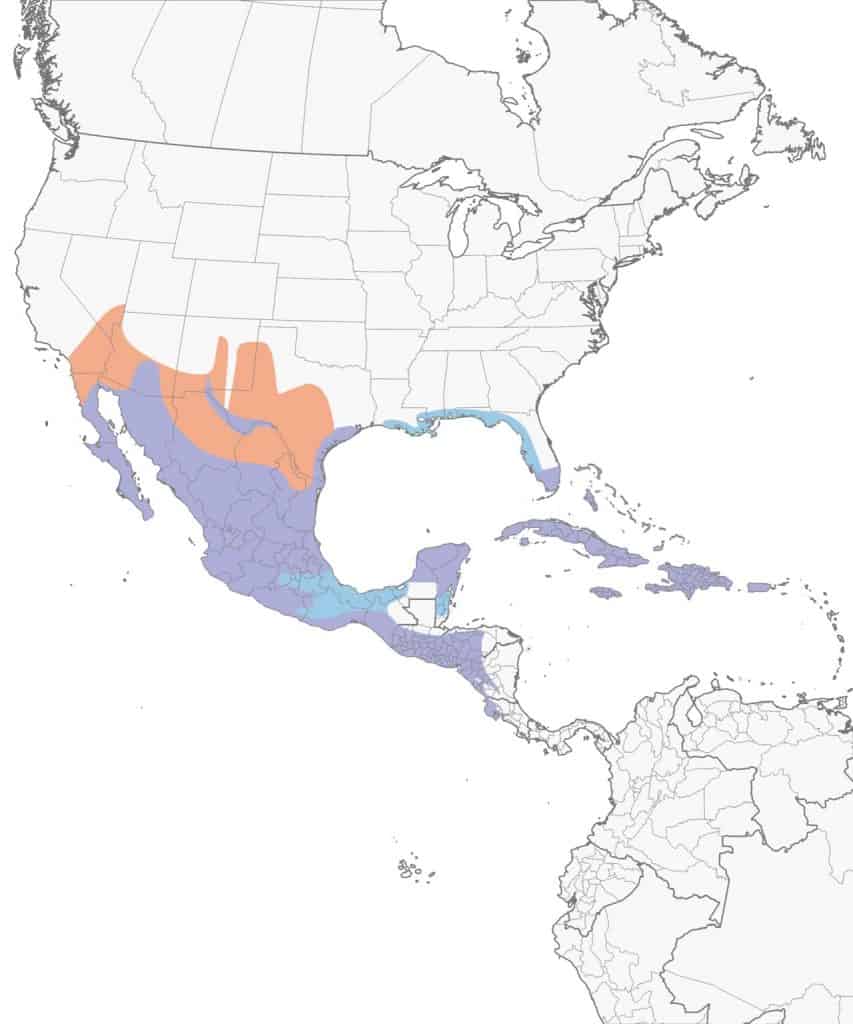
Wild Turkey
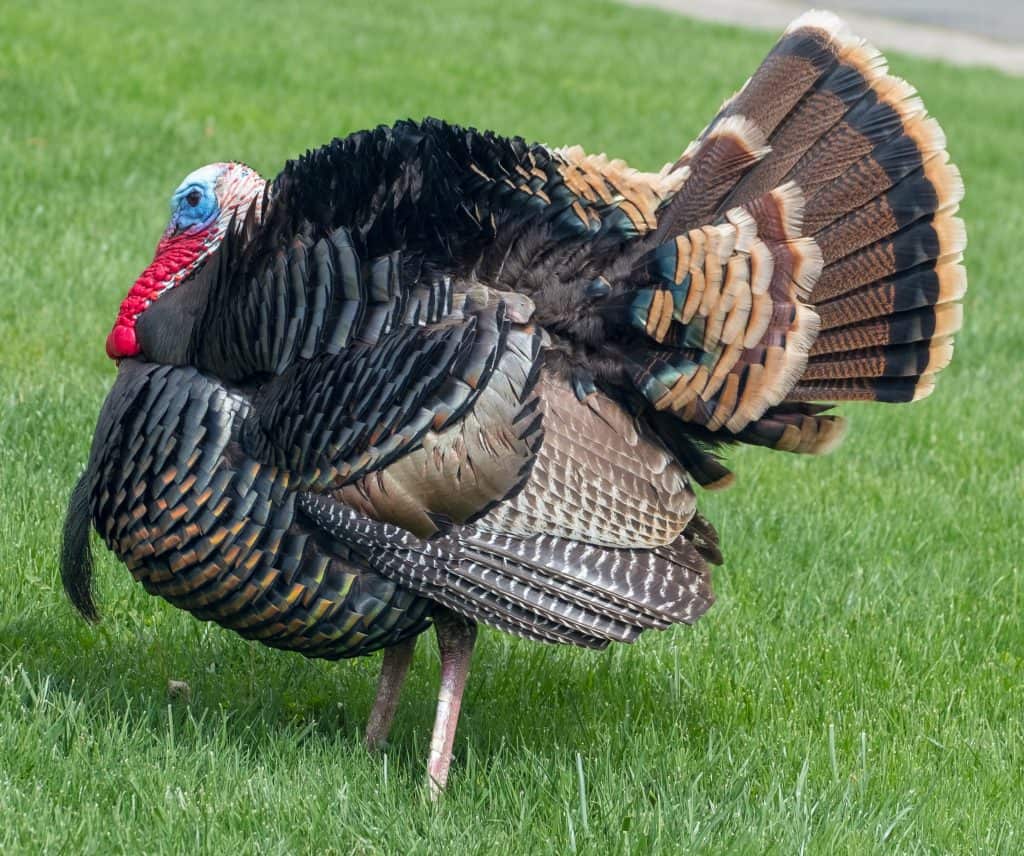
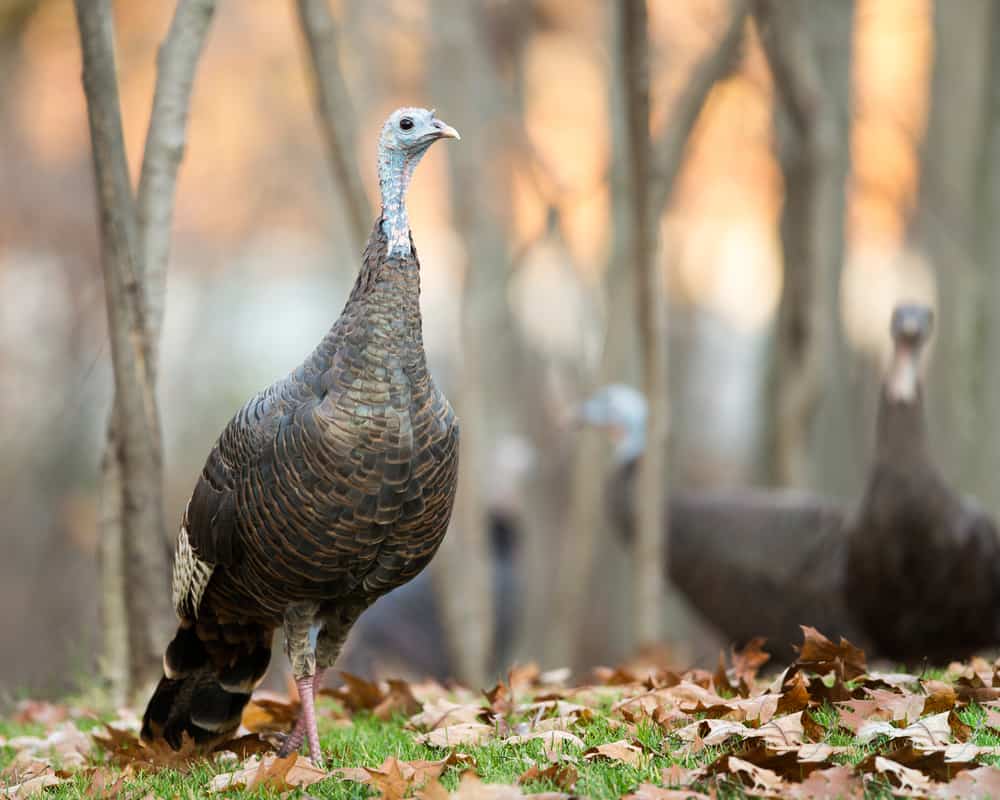
Appearance: Wild turkeys are enormous birds about 45″ long with long necks, large prominent red wattles, snoods (hanging skin from the neck), and a bronze-greenish iridescence to most of their feathers. The feathers also give the appearance of a variety of textures. Their wings are dark, with white bars and a fanned-out tail with rusty or white tips. Their head and neck show their skin with colors of red, blue, and gray. The red neck is unmistakable. The females are similar but lighter in color, they don’t fan their tail feathers, have subtle-looking wattle and snood, and don’t strut like the males.
Diet: Wild turkeys are ground foragers consuming seeds, nuts (acorns, beech nuts, pecans, hickory nuts), and berries.
Feeder food: Wild turkeys do not come to feeders.
Habitat: Wild turkeys are widespread throughout the US, southernmost parts of Canada, and Mexico. They prefer open forested areas, especially those with nut-producing trees. In the southwest, they can be found in open grassy savannahs.
Nesting: Wild turkeys are ground nesters. The female creates a shallow depression in the ground and fills it with leaves. The completed nest can be as large as 10″ x 12″. They have 1 brood/season, 4-17 eggs, eggs are 2-3″ long x 1.5-2″ wide. They’re a light yellow/tan color with red/brown or pink speckles and incubation lasts about 25-31 days.
Migration: Wild turkeys are not migrators. They remain in their year-round range every season of the year.
Year-round range: Every US state, Mexico, the southern portions of Canada’s British Columbia, Manitoba, Ontario, and Quebec.
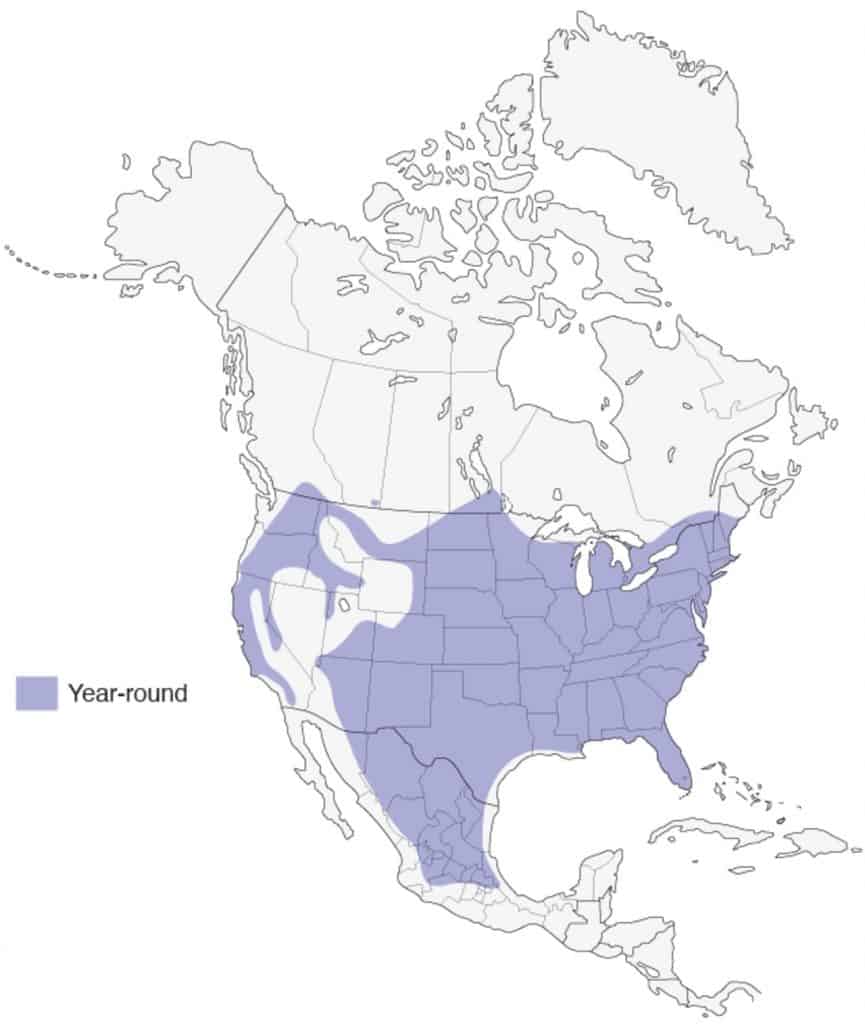
Wilson’s Warbler
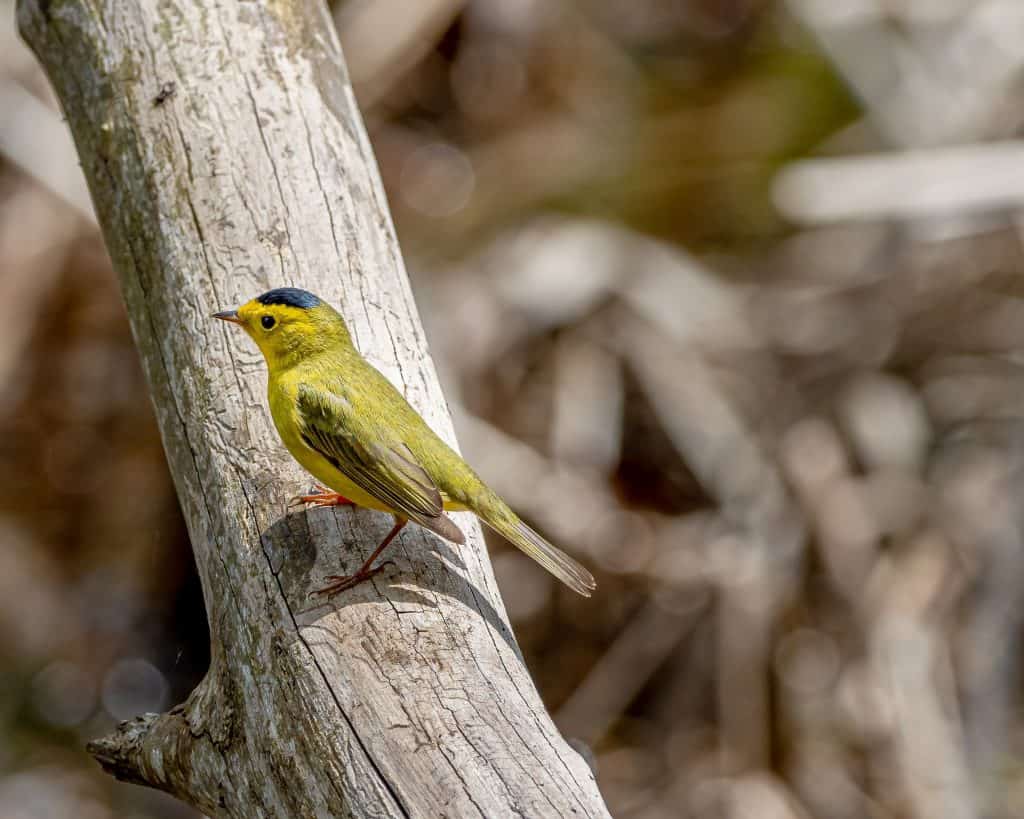
Appearance: Wilson’s warbler is a very small bird about 4-5″ long. They’re bright yellow with subdued tones of the olive-yellow outside of the face, a black cap (looks a bit like a toupe), and black wings with white stripes. Their bills are short and pointy, eyes dark black.
The female is the same except the cap is light charcoal.
Diet: Insects, especially larval insects, spiders, and the sugary liquid from scale insects (tiny insects that feed on plants).
Feeder food: Unlikely to visit a feeder.
Habitat: Forested edges, shrubby thickets, and often young conifer trees.
Nesting: Wilson’s warblers place their 3-4″ nest on the ground. Sometimes nests are in shrubs in which case they are a bit bigger. They have 1-2 broods/season and 2-7 eggs/brood that are white/ivory with reddish/brown specks. Incubation is for 10-13 days and juveniles leave the nest at about 9-11 days.
Migration: Wilson’s warblers are migrators. In the spring they migrate north to breed and raise their young. Then in the fall, they migrate back south for the winter.
Breeding range: Alaska, Washington, Oregon, Idaho, western Montana, northern and the coast of California, as well as irregular patches in Wyoming, Utah, Colorado, New England, and Canada’s provinces (except Nunavut).
Winter range: Southeast Texas, southern Louisiana, and Mexico.
Range Map
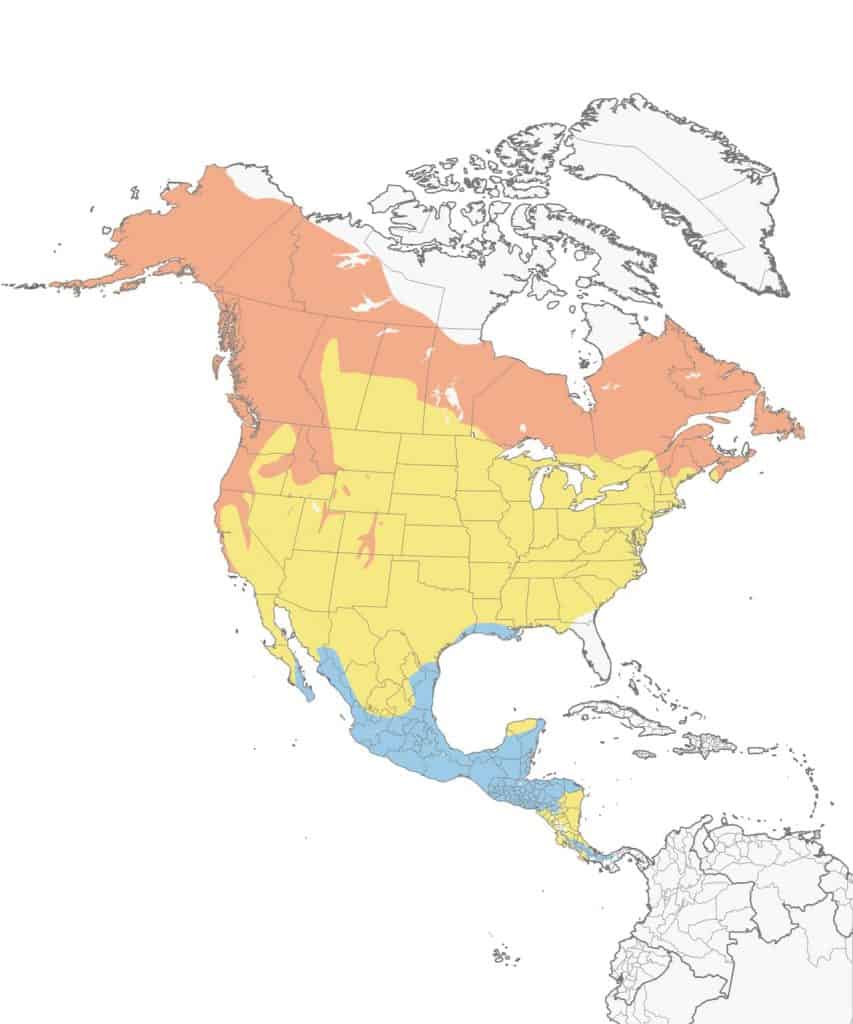
Winter Wren
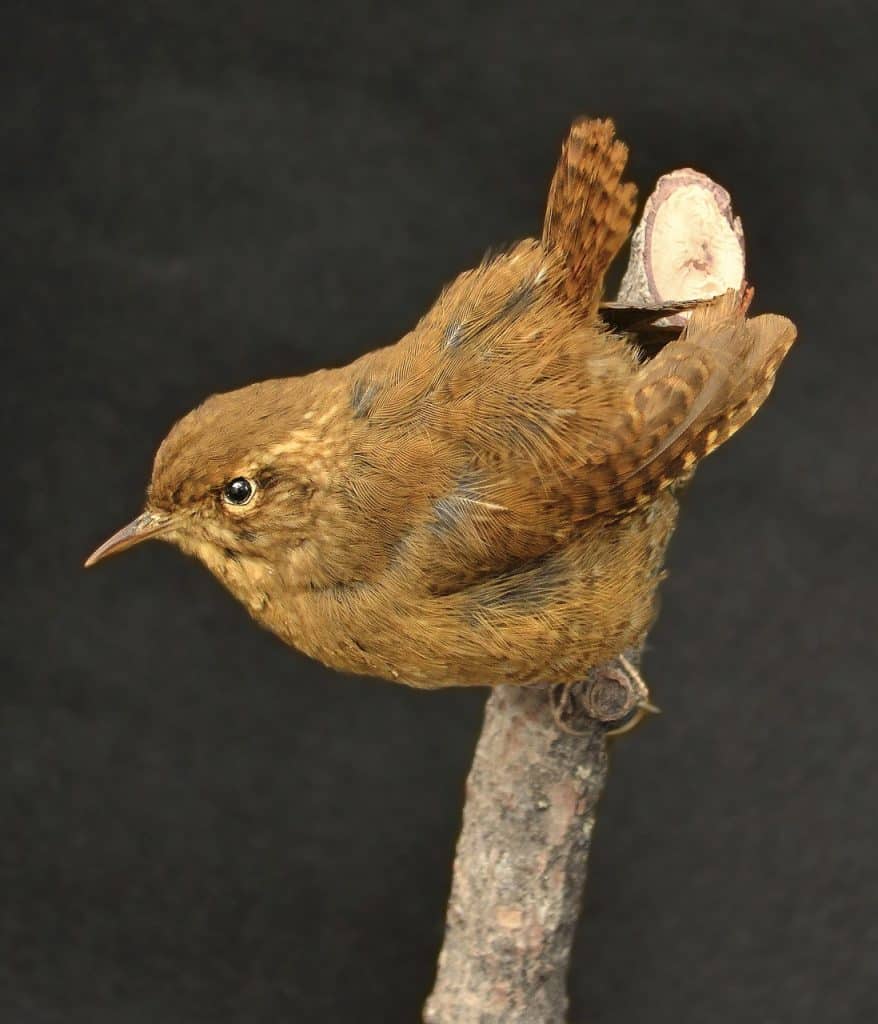
Appearance: Winter wrens are tiny birds about 3-5″ long, round, with short stubby bills, dark eyes, and a tail that sticks upward. They’re primarily brown with white and dark brown feather edges as well as a white stripe behind either eye. Females look the same.
Diet: Insects and berries.
Feeder food: They don’t usually visit feeders.
Habitat: Deciduous and evergreen forests especially those with snags and dead trees. They prefer to be near streams.
Nesting: Nests are built inside natural cavities (old woodpecker holes) or near creeks or streams in a decaying log or upturned tree root. The height of the nest varies widely from ground level to as high as 20+ feet in a tree. They have 1-2 broods/season, and 1-9 eggs/brood, the tiny eggs are white with faint red spots. Incubation lasts for 14-17 days and fledglings leave the nest about 15-17 days later.
Range Map
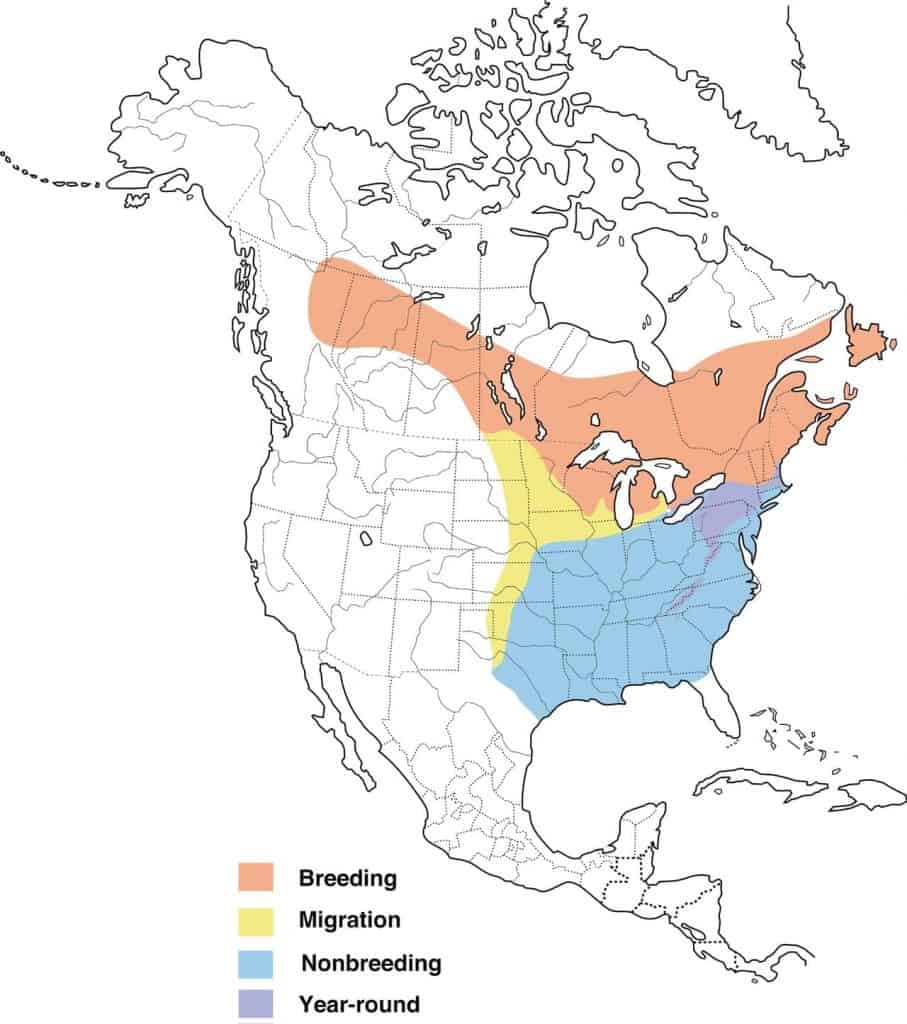
Wood Duck
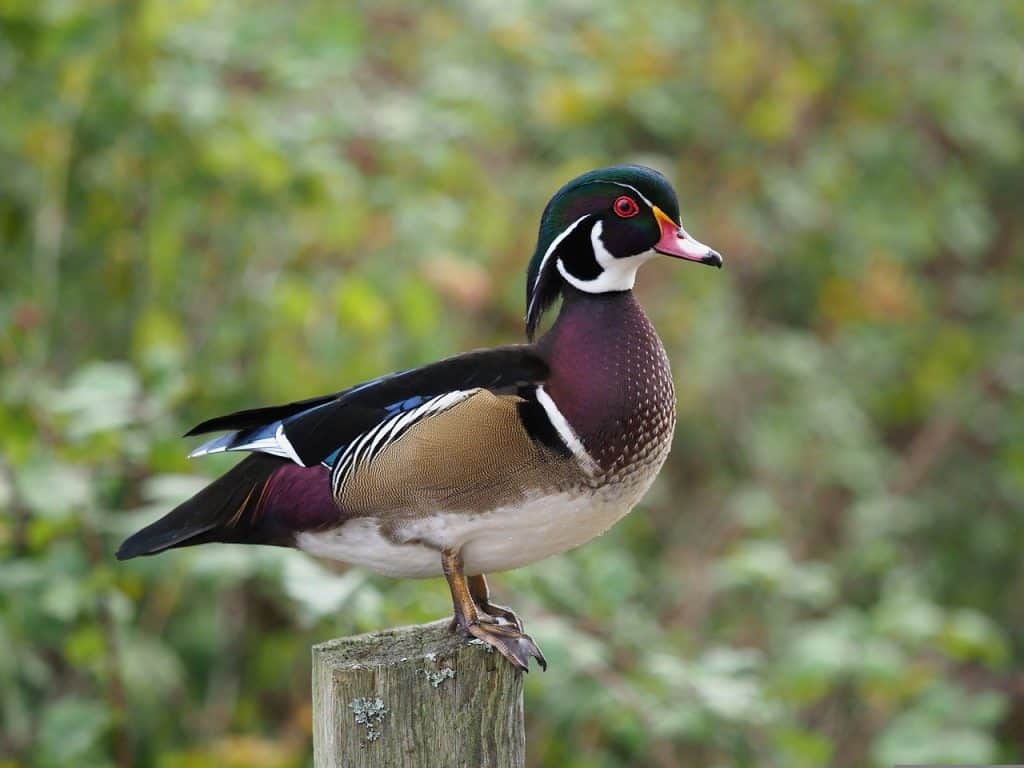
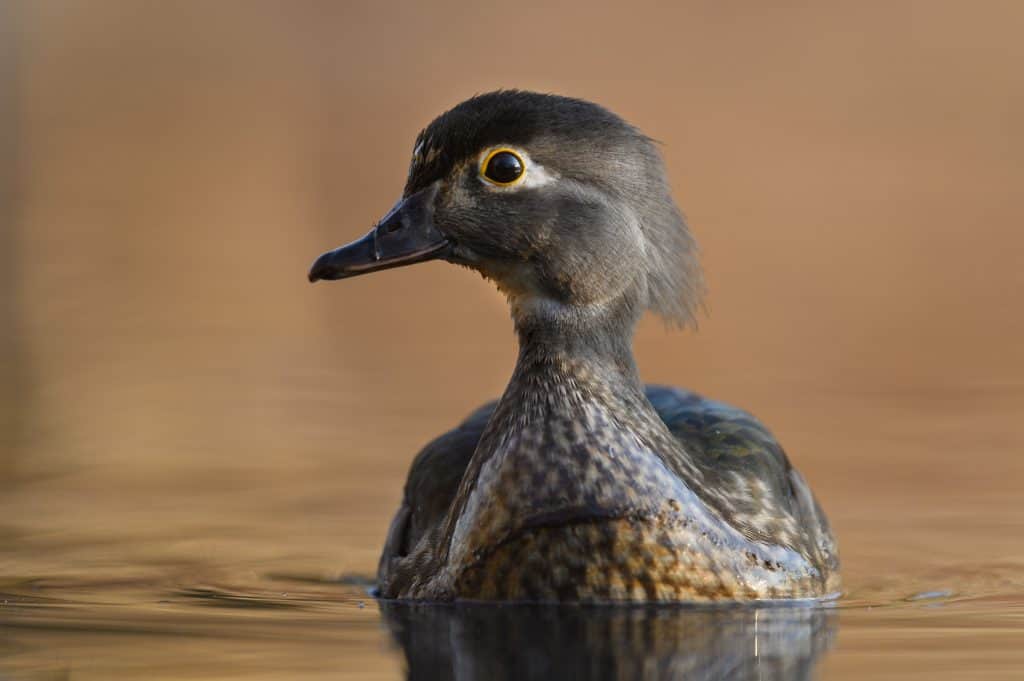
Appearance: The wood duck is a large bird about 19-22″ long and the male sports an array of colors. The male’s head and crest are metallic purplish-green, the sides of the face are black, a white stripe runs along the neck and a smaller one goes up each cheek. Their chest and the rump are dark red, and the sides are olive-yellow with black & white stripes on the edges, the belly is white, tail and back are black. The eyes are red, bill white with red on each side. The top of the bird’s head and crest are metallic purplish-green. The sides of the face are black, and a white stripe runs along the neck. A small white stripe also extends up each cheek. The chest and the rump are dark red, and the sides are a drab yellow with black and white stripes at the edges. The wood duck’s belly is white, its tail and back are black, and its wings are black and blue. The female looks vastly different. She is gray-brown with a white-speckled breast
Diet: The wood duck’s diet varies widely. They prefer water plants, seeds, fruits, and insects but will also eat nuts and grains.
Feeder food: They don’t visit feeders.
Habitat: Wet areas including swamps, marshes, streams & creeks as well as small lakes.
Nesting: Wood ducks are cavity nesters and will gladly move into your manmade nesting box is you put one up. When using a tree cavity, they opt for very large trees – 1-2′ in diameter. The cavity is anywhere from 2-60 feet in the air. They have 1-2 broods/season and 6-16 eggs/brood. Eggs are shiny cream white to light tan. Incubation is from 28-37 days and fledglings leave the nest at about 56-70 days.
Range Map
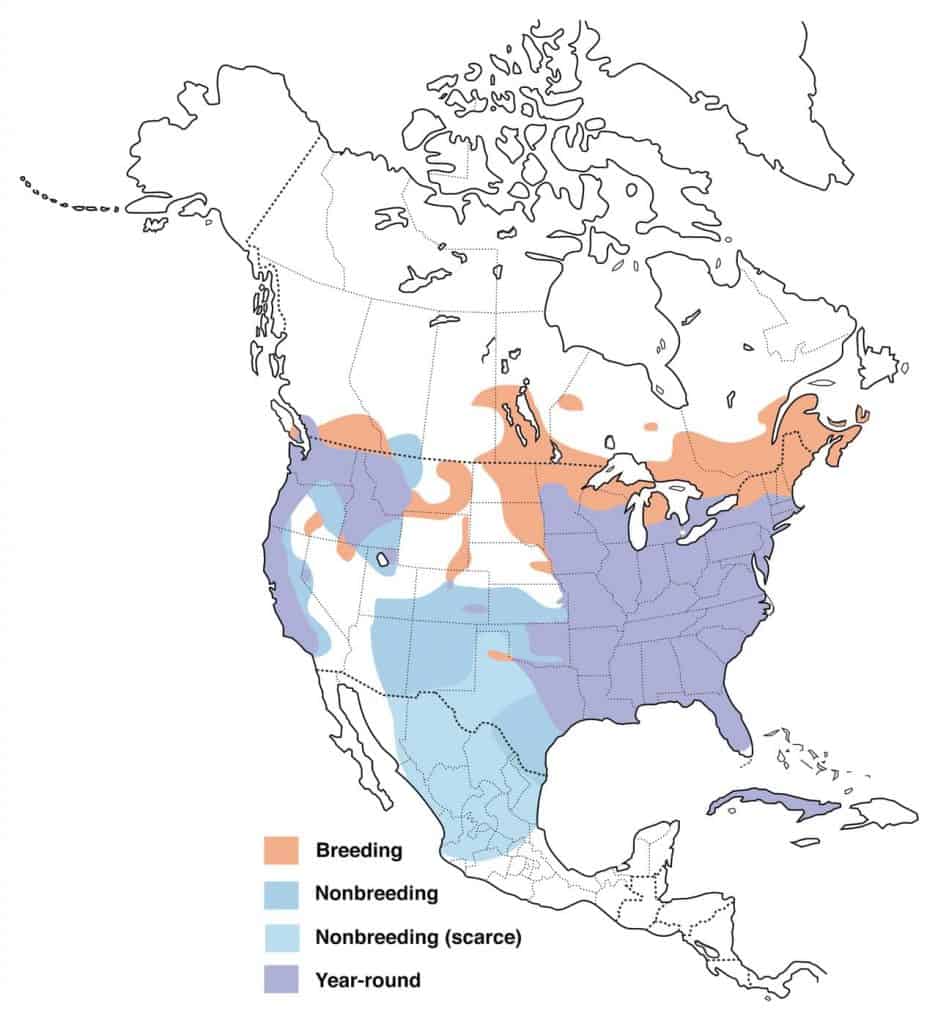
Wood Thrush
Appearance: The wood thrush is a medium-sized bird about 7″ long. They’re primarily cinnamon brown with bold black spots on a pure white background from the throat to the chest and belly. They have dark eyes and a white eye ring.
Diet: Insects and fruit.
Feeder food: Unlikely to visit a feeder.
Habitat: Moist wooded areas with hardwood and mixed trees.
Nesting:
- Nest: An open cup-shaped nest is located about 10 high in a sapling or large shrub.
- Broods: 1-2 broods/year
- Clutch: 3-4 eggs/brood
- Egg color: Turquoise blue-green without markings
- Egg size: 0.9 – 1.1 inches by 0.7 – 0.8 inches
- Incubation: 11-15 days
Migration: Wood thrushes are migrators. In the spring they migrate north to the eastern half of the US to breed and raise their young. Then in the fall, they migrate south for the winter.
Breeding range: An irregular area in South Dakota, eastern Minnesota, Iowa, Missouri, Arkansas, Louisiana, and all US states eastward.
Winter range: Southern Mexico and Central America.
Range Map
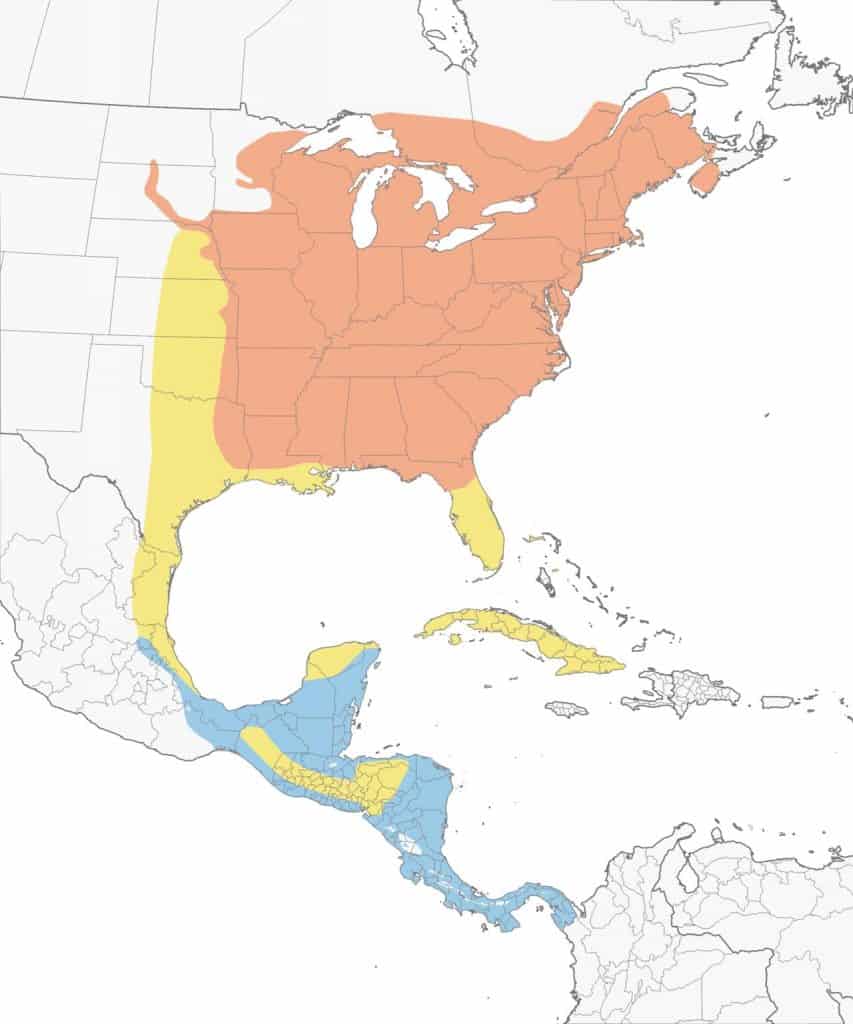
Yellow Warbler
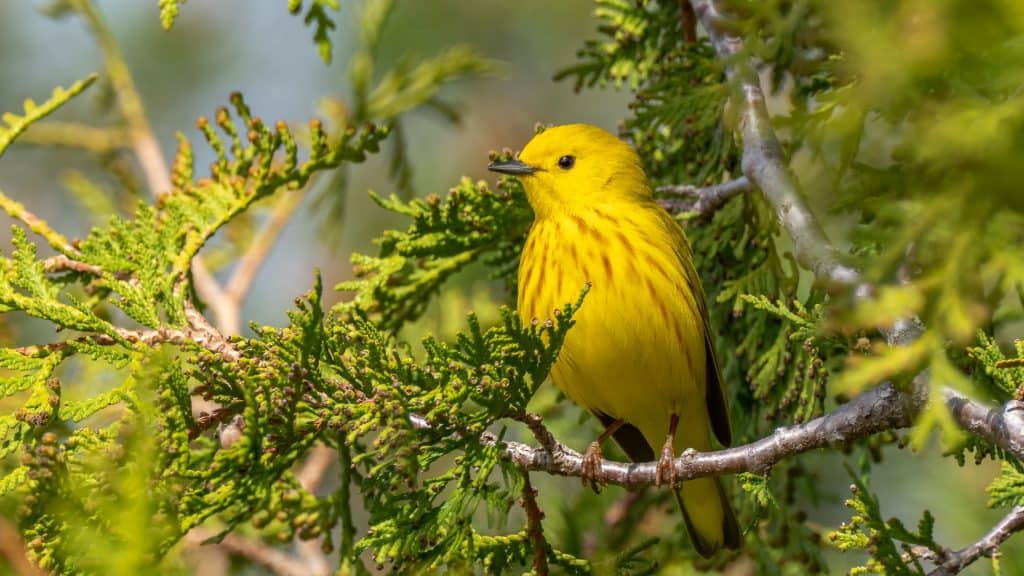
Appearance: The yellow warbler is a small bird about 5″ long primarily yellow with orange streaks on the chest and belly, and black-streaked wings. Bill is long, pointy, and gray. The Female is a muted olive-green version of the male without the orange chest.
Diet: Insects
Feeder food: Unlikely to visit a feeder.
Habitat: Shrubby areas and gardens, willows, wet thickets, and roadsides.
Nesting: Yellow warblers construct a cup-shaped nest to raise 1 brood/year. They have 4-5 eggs/brood that are white with brown markings. Incubation lasts 11-12 days.
Migration: Yellow warblers are migrators. In the spring, they migrate north to breed and raise their young. Then in the fall, they migrate back south for the winter.
Breeding range: All US states except Texas, Louisiana, Mississippi, and Florida. Also, all of Canada as well as central Mexico.
Winter range: Along the California and Arizona state lines, Pacific and Atlantic coasts of Mexico, Central America, and South America.
Range Map
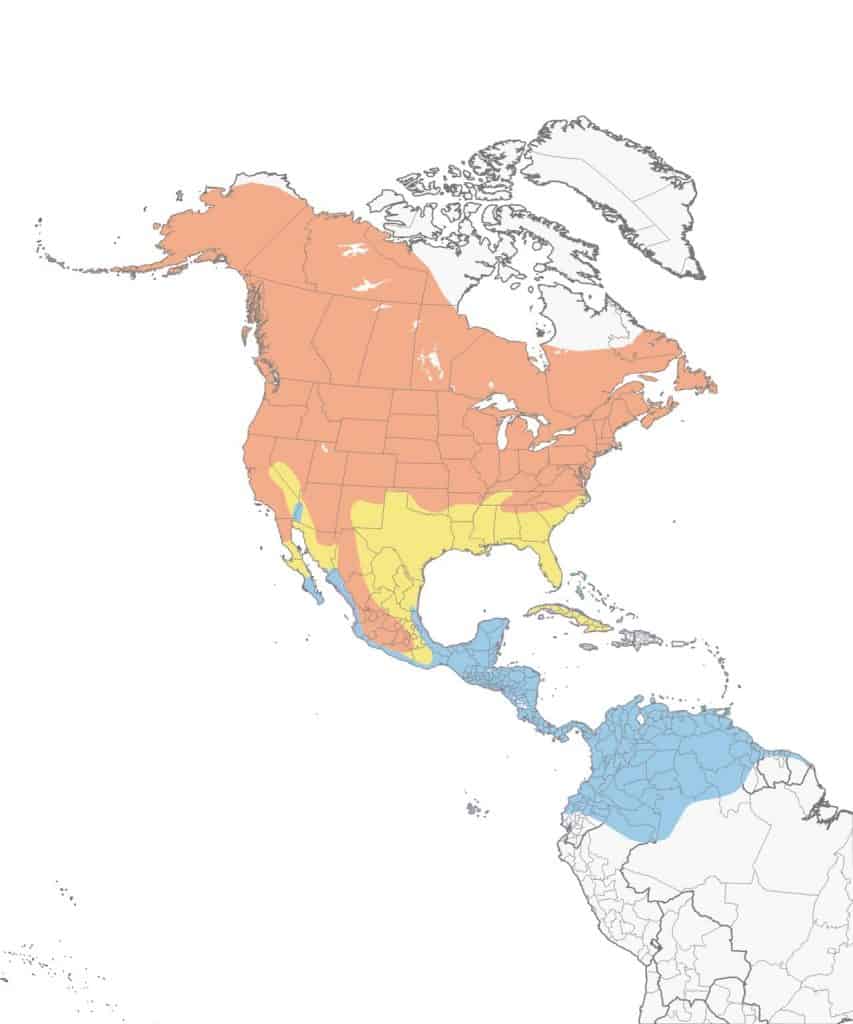
Yellow-Bellied Sapsucker

Appearance: Small bird about 8-9″ long with a checkered back. They have a red forehead, crown, and chin. The chest and belly are tan to yellow and have white wing patches. The Female is similar except she has a white marking on her chin.
Diet: Berries and fruit, bast (inner bark of a tree), few insects.
Feeder food: Suet.
Habitat: They prefer densely wooded areas with living trees (most woodpeckers prefer dead trees).
Nesting: They are cavity nesters and have 1 brood per year. 5-6 eggs/brood are all white. Incubation lasts 12-13 days.
Migration: Yellow-bellied sapsuckers are migrators. Right around mid-September through October, yellow-bellied sapsuckers migrate south for the winter. Then around the April-early May timeframe, they begin their migration north in search of ideal nesting conditions.
Breeding range: Eastern Alaska, North Dakota, Minnesota, Wisconsin, Michigan, Virginia, Pennsylvania, New York, New England, and all Canadian provinces (except Nunavut),
Winter range: Nebraska, Missouri, Illinois, Indiana, Ohio, Arkansas, Oklahoma, Texas, Louisiana, Mississippi, Alabama, Georgia, Florida, North Carolina, South Carolina, Virginia, Maryland, Delaware, and New Jersey.
Range Map

Yellow-Billed Cuckoo
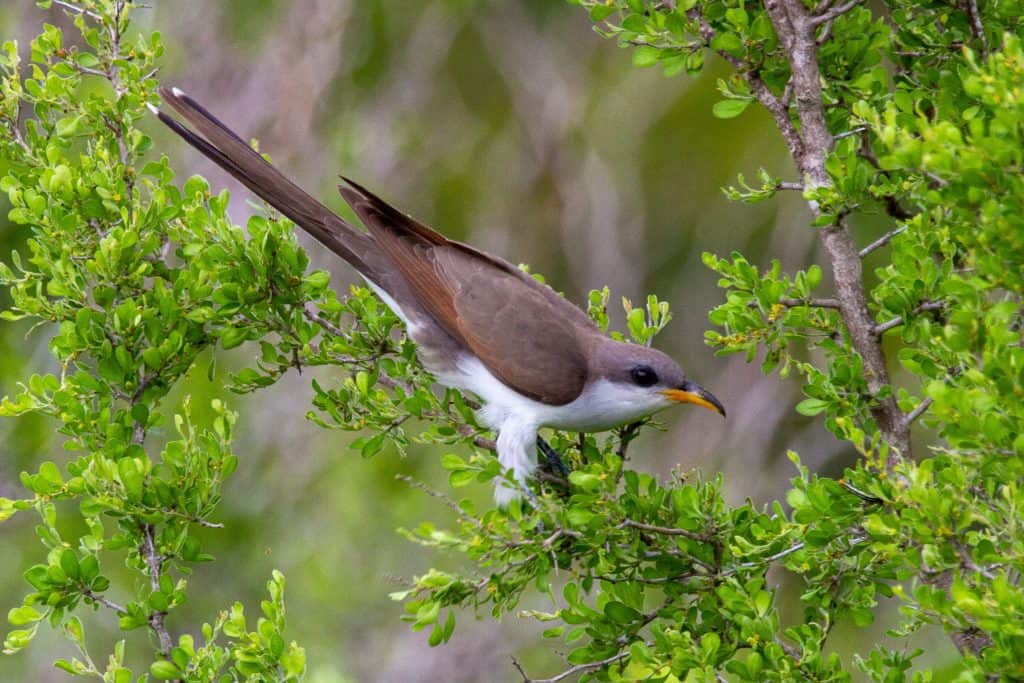
| Appearance | A medium-large bird about 12″ long. Reddish wings, white throat, and belly, a white tail pattern with spots underneath, yellow eye ring, thick yellow bill. |
| Diet | Large insects. |
| Feeder Food | Unlikely to visit a feeder. |
| Habitat | Deciduous woodland with clearings or bordering rivers. |
| Nesting | Loose platform-style nest located midway in a tree or shrub. Has 1-2 broods/year, 1-5 eggs/brood, eggs are light bluish-green and incubated for 9-11 days. |
Range Map
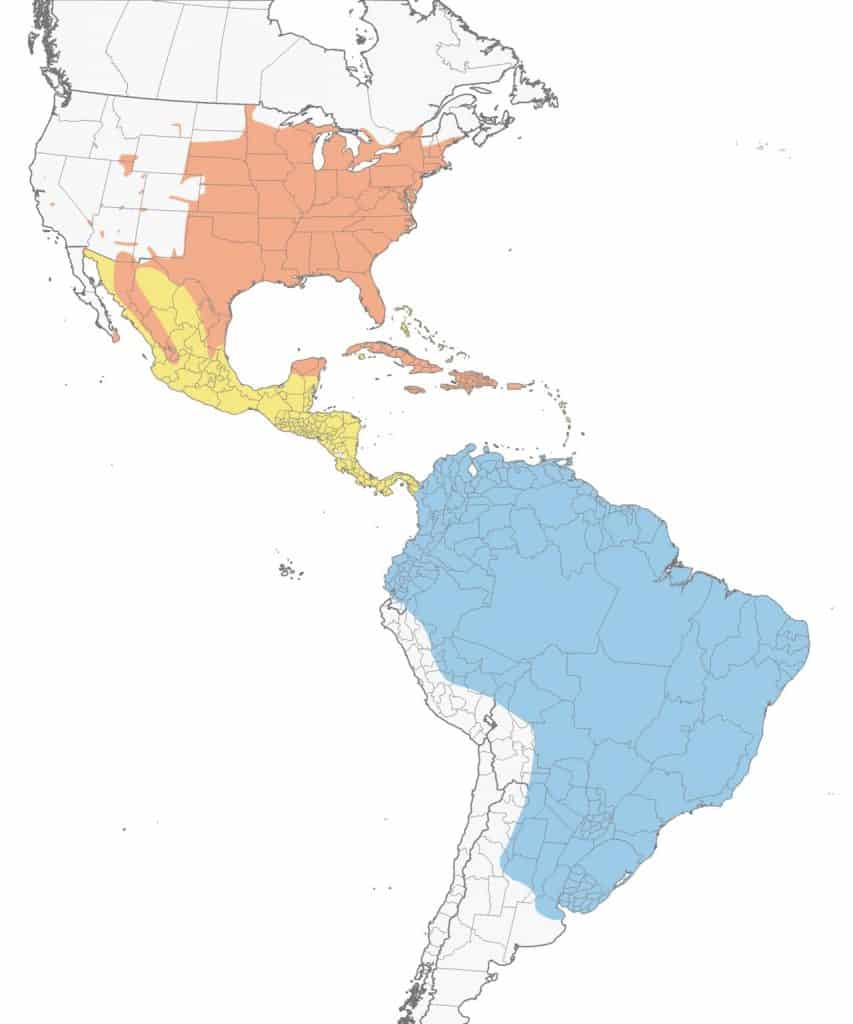
Yellow-Rumped Warbler
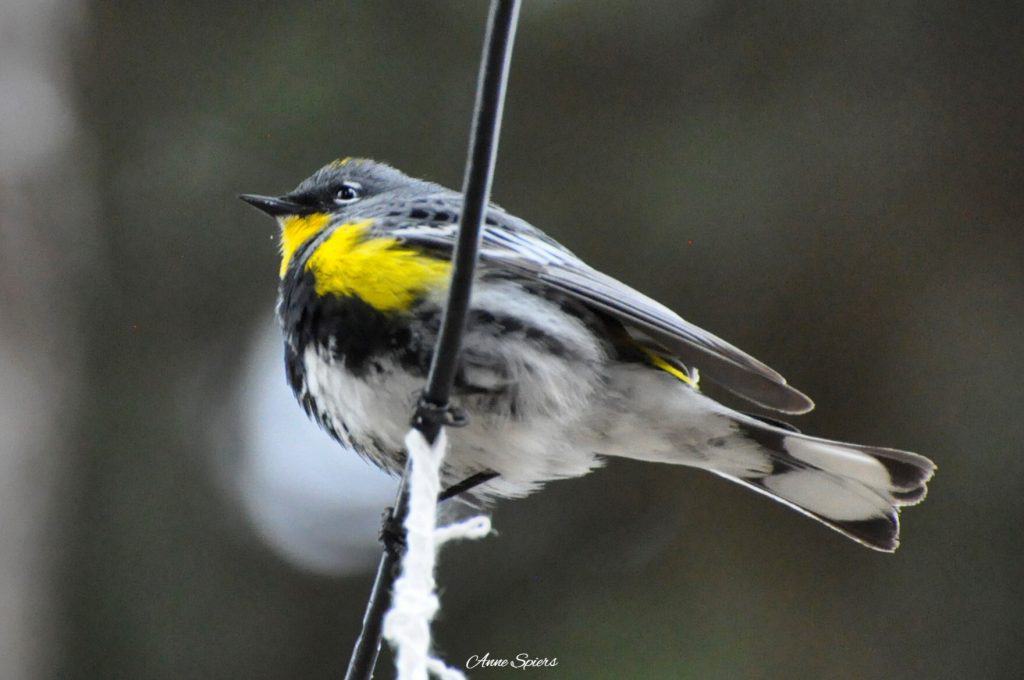
Appearance: The male yellow-rumped warbler is slate gray with a black mask and beak. Yellow patches on the sides of its lower belly, head, and rump. White and gray striped throughout chest and belly. The female is similar but duller in color and browner than she is slate gray.
Diet: Insects, berries.
Feeder food: Peanuts, mealworms, nectar, fruit, suet with peanut butter.
Habitat: Just about anywhere as they are very adaptable. Found in woods, bogs, forest and wooded edges, coniferous and deciduous trees, and wide-open areas.
Nesting: The female builds a cup-shaped nest in a tree, has 2 broods per year, 4-5 eggs per brood, and eggs are white with brown spots and incubated between 12-13 days.
Migration: Yellow-rumped warblers are migrators. In the spring, they migrate north and west to breed and raise their young. Then in the fall, they migrate south and east for the winter. A small population of yellow-rumped warblers remains in their tiny year-round range every season of the year.
Breeding range:
Winter range: Southeast corner of Washington & Oregon, southern California, western Arizona, eastern New Mexico, Texas, Oklahoma, Missouri, Illinois, and the remaining southeast US states. Also, Mexico and Central America.
Year-round range: Western Washington, eastern Oregon, western California, southeast Nevada, southeast Arizona, and southern New Mexico.
Range Map
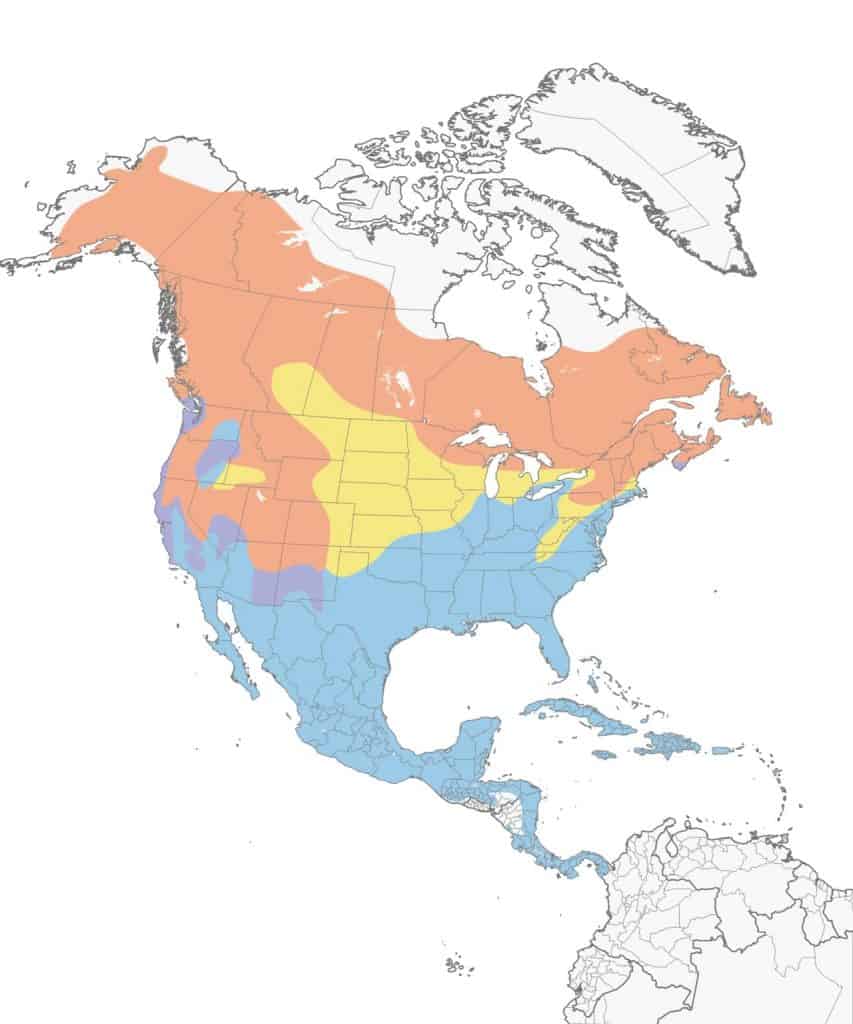
Yellow-Throated Vireo
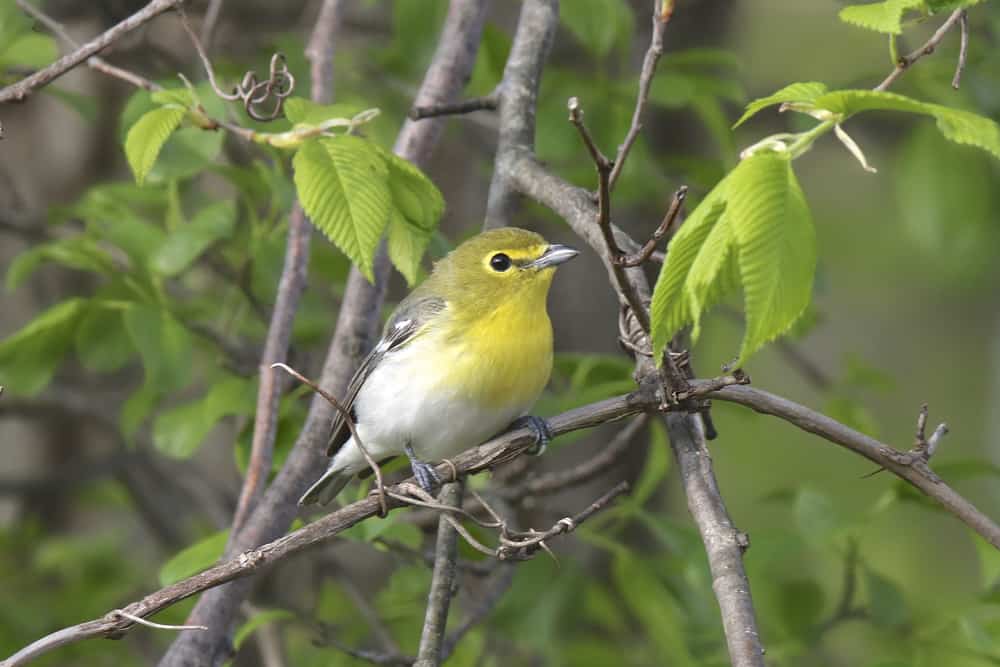
| Appearance | The yellow-throated vireo is a small bird about 5 1/2″ long. They have a yellow head, throat, and chest. The belly is white and the rump is gray. Wings are brown with white edges, |
| Diet | Insects and small fruit. |
| Feeder Food | Unknown. |
| Habitat | Forest edges and open woodlands. |
| Nesting | Yellow-throated vireos nest in trees as high as 60′ up. Their deep, round nest is woven into the intersection of forked twigs. They have 1 brood/season and 4 eggs/brood. eggs are cream white with spots. Incubation is for 13 days and fledglings leave the nest after 13 days. |
Range Map
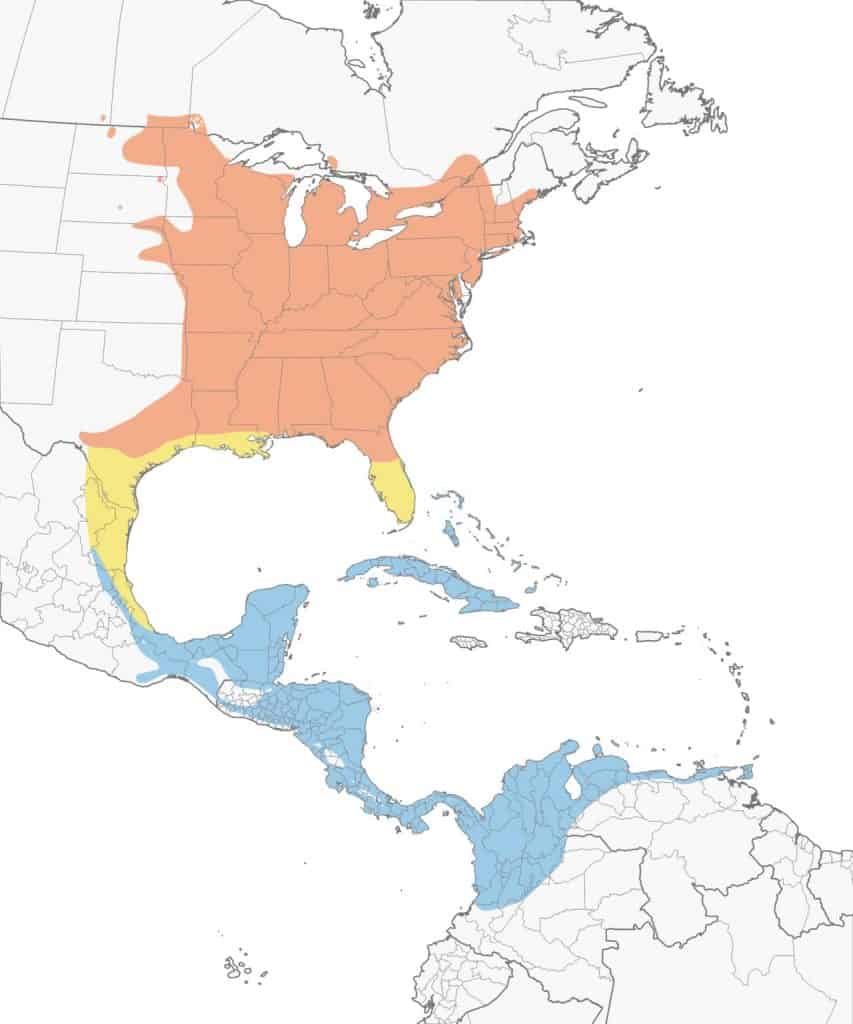
Keep this article handy. When you see an amazing bird in Florida – I guarantee you’ll want to know the species and details about it. Trust me!
Happy Birding!
Sources
All About Birds. The Cornell Lab of Ornithology. 2021
eBird. The Cornell Lab of Ornithology. 2021
Noah, Strycker, and Alderfer Jonathan. National Geographic Backyard Guide to the Birds of North America. 2nd ed., National Geographic, 2019.
